Social Health Security Scheme in Nepal
VerifiedAdded on 2023/01/11
|70
|20739
|87
AI Summary
This research paper provides a descriptive and analytical account of the social health security scheme in Nepal. It discusses the prospects and challenges faced by the government in implementing the scheme and provides recommendations for enhancing the health service delivery. The paper also explores the conditions of social health security schemes in the global context and the specific context of Nepal.
Contribute Materials
Your contribution can guide someone’s learning journey. Share your
documents today.
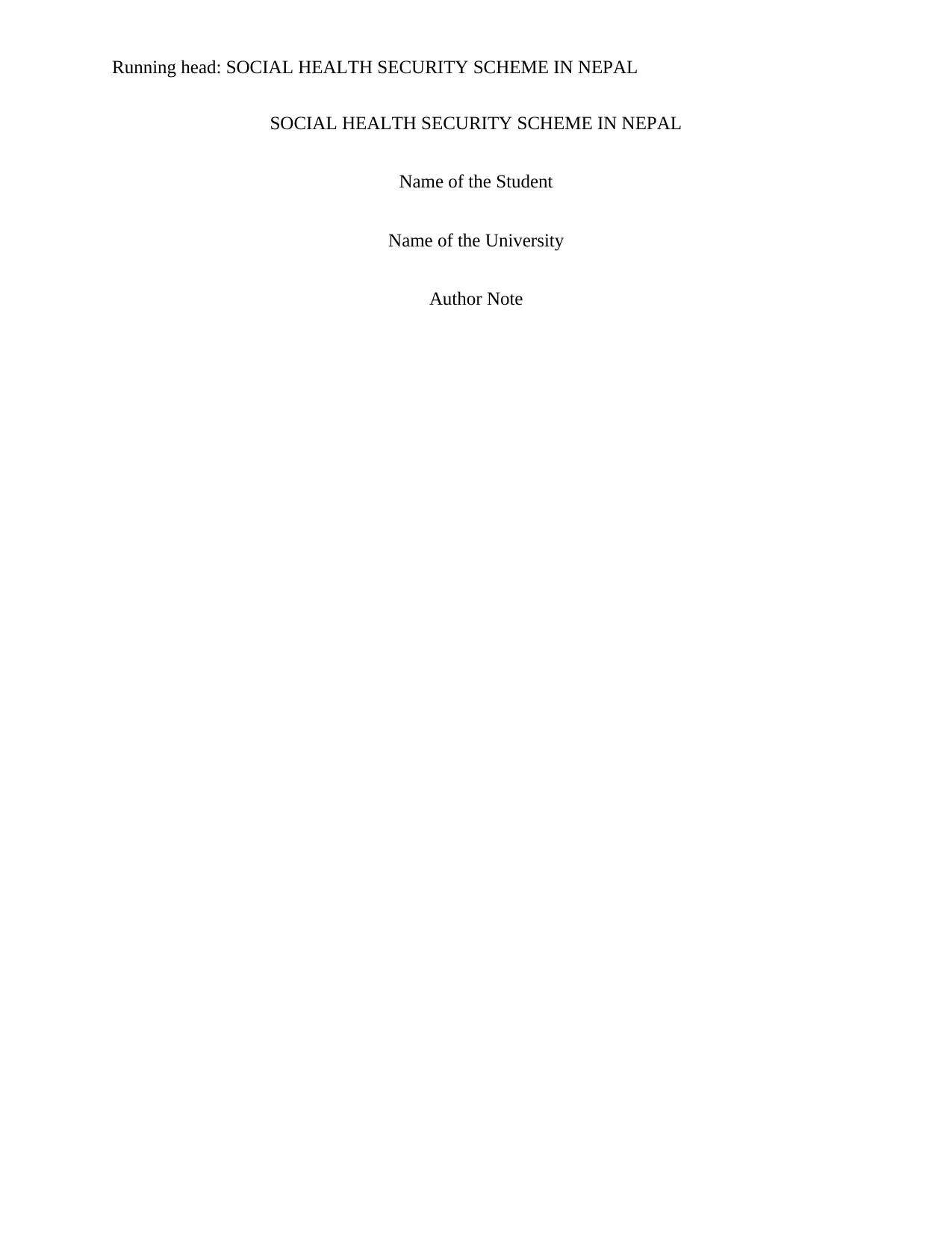
Running head: SOCIAL HEALTH SECURITY SCHEME IN NEPAL
SOCIAL HEALTH SECURITY SCHEME IN NEPAL
Name of the Student
Name of the University
Author Note
SOCIAL HEALTH SECURITY SCHEME IN NEPAL
Name of the Student
Name of the University
Author Note
Secure Best Marks with AI Grader
Need help grading? Try our AI Grader for instant feedback on your assignments.
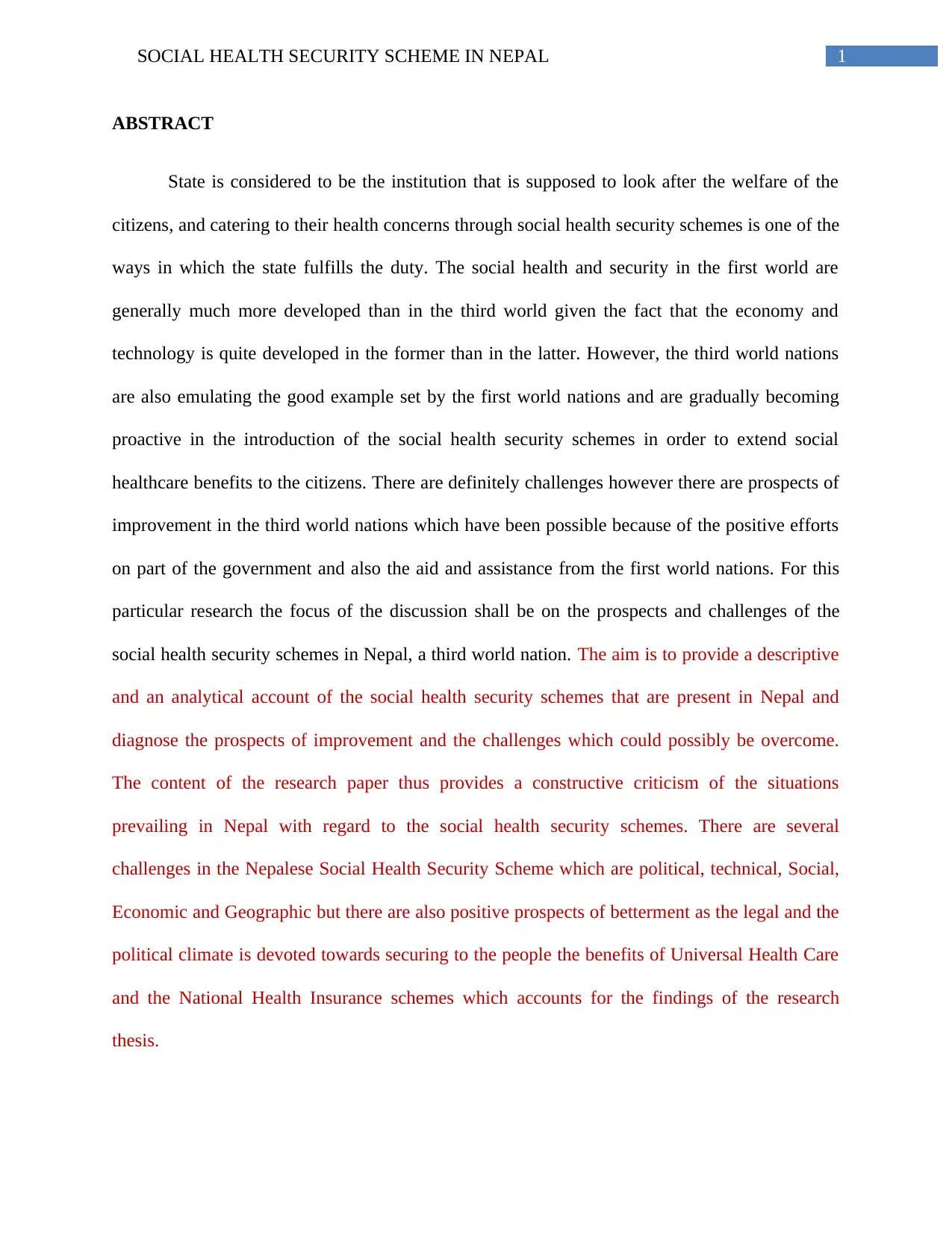
1SOCIAL HEALTH SECURITY SCHEME IN NEPAL
ABSTRACT
State is considered to be the institution that is supposed to look after the welfare of the
citizens, and catering to their health concerns through social health security schemes is one of the
ways in which the state fulfills the duty. The social health and security in the first world are
generally much more developed than in the third world given the fact that the economy and
technology is quite developed in the former than in the latter. However, the third world nations
are also emulating the good example set by the first world nations and are gradually becoming
proactive in the introduction of the social health security schemes in order to extend social
healthcare benefits to the citizens. There are definitely challenges however there are prospects of
improvement in the third world nations which have been possible because of the positive efforts
on part of the government and also the aid and assistance from the first world nations. For this
particular research the focus of the discussion shall be on the prospects and challenges of the
social health security schemes in Nepal, a third world nation. The aim is to provide a descriptive
and an analytical account of the social health security schemes that are present in Nepal and
diagnose the prospects of improvement and the challenges which could possibly be overcome.
The content of the research paper thus provides a constructive criticism of the situations
prevailing in Nepal with regard to the social health security schemes. There are several
challenges in the Nepalese Social Health Security Scheme which are political, technical, Social,
Economic and Geographic but there are also positive prospects of betterment as the legal and the
political climate is devoted towards securing to the people the benefits of Universal Health Care
and the National Health Insurance schemes which accounts for the findings of the research
thesis.
ABSTRACT
State is considered to be the institution that is supposed to look after the welfare of the
citizens, and catering to their health concerns through social health security schemes is one of the
ways in which the state fulfills the duty. The social health and security in the first world are
generally much more developed than in the third world given the fact that the economy and
technology is quite developed in the former than in the latter. However, the third world nations
are also emulating the good example set by the first world nations and are gradually becoming
proactive in the introduction of the social health security schemes in order to extend social
healthcare benefits to the citizens. There are definitely challenges however there are prospects of
improvement in the third world nations which have been possible because of the positive efforts
on part of the government and also the aid and assistance from the first world nations. For this
particular research the focus of the discussion shall be on the prospects and challenges of the
social health security schemes in Nepal, a third world nation. The aim is to provide a descriptive
and an analytical account of the social health security schemes that are present in Nepal and
diagnose the prospects of improvement and the challenges which could possibly be overcome.
The content of the research paper thus provides a constructive criticism of the situations
prevailing in Nepal with regard to the social health security schemes. There are several
challenges in the Nepalese Social Health Security Scheme which are political, technical, Social,
Economic and Geographic but there are also positive prospects of betterment as the legal and the
political climate is devoted towards securing to the people the benefits of Universal Health Care
and the National Health Insurance schemes which accounts for the findings of the research
thesis.
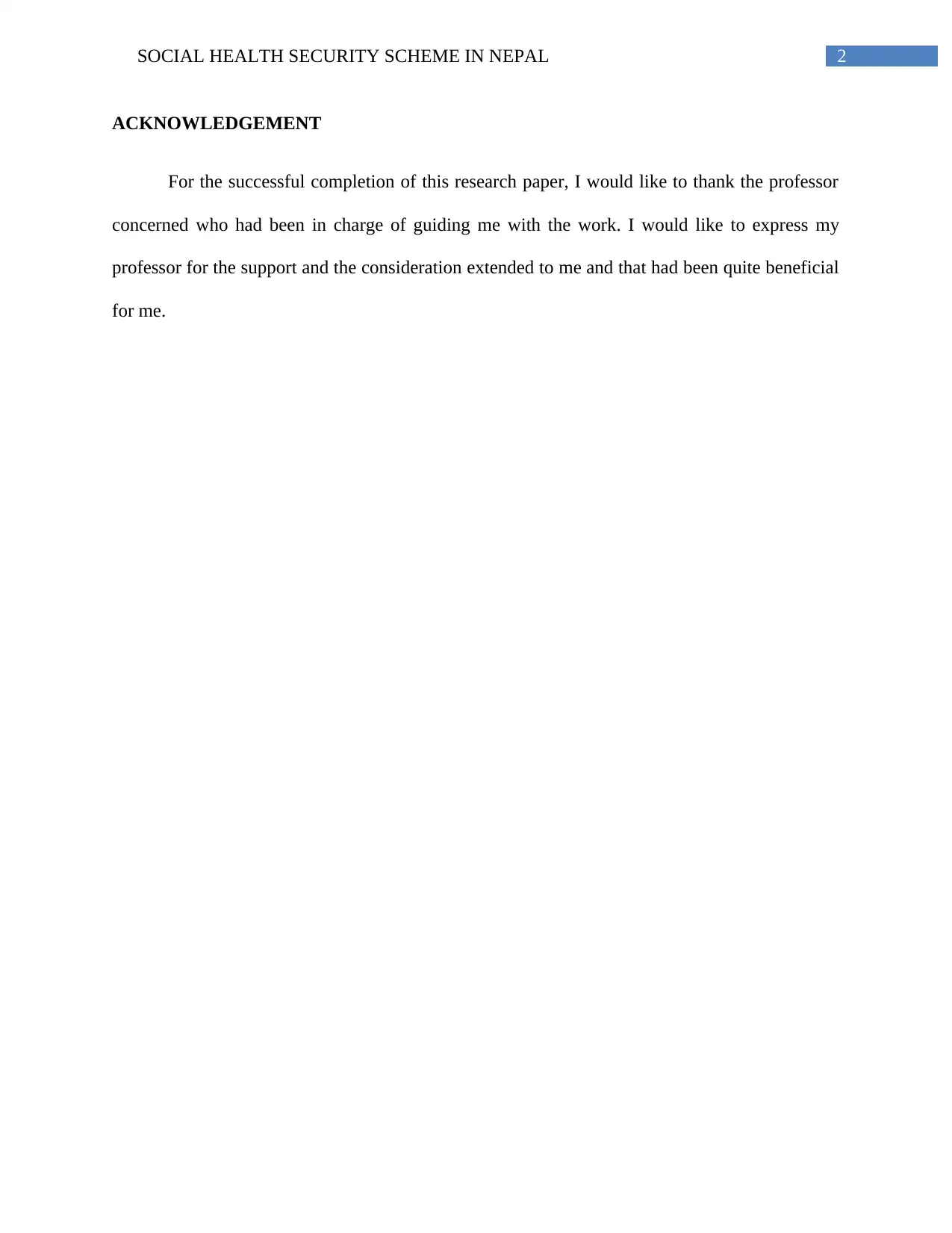
2SOCIAL HEALTH SECURITY SCHEME IN NEPAL
ACKNOWLEDGEMENT
For the successful completion of this research paper, I would like to thank the professor
concerned who had been in charge of guiding me with the work. I would like to express my
professor for the support and the consideration extended to me and that had been quite beneficial
for me.
ACKNOWLEDGEMENT
For the successful completion of this research paper, I would like to thank the professor
concerned who had been in charge of guiding me with the work. I would like to express my
professor for the support and the consideration extended to me and that had been quite beneficial
for me.
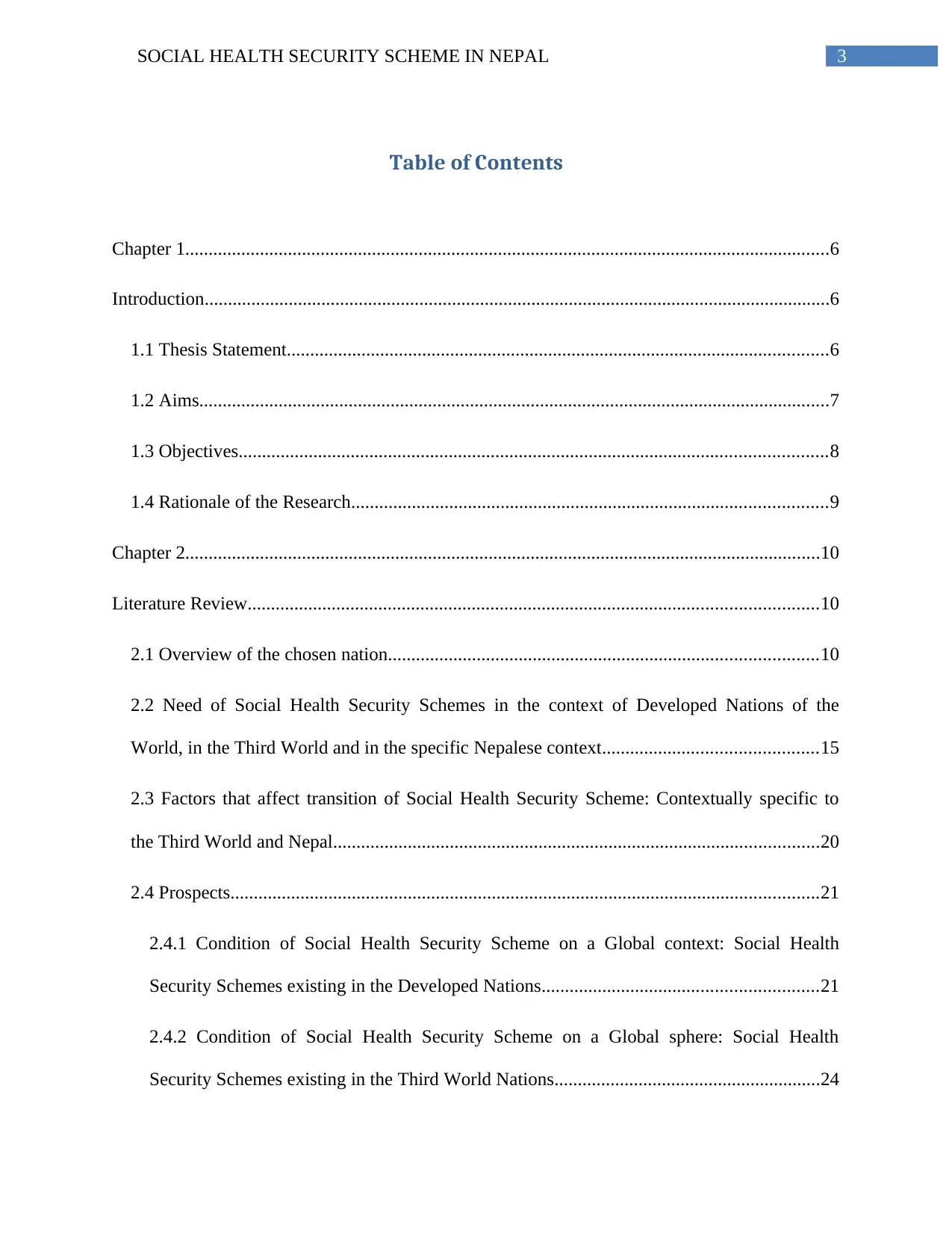
3SOCIAL HEALTH SECURITY SCHEME IN NEPAL
Table of Contents
Chapter 1..........................................................................................................................................6
Introduction......................................................................................................................................6
1.1 Thesis Statement....................................................................................................................6
1.2 Aims.......................................................................................................................................7
1.3 Objectives..............................................................................................................................8
1.4 Rationale of the Research......................................................................................................9
Chapter 2........................................................................................................................................10
Literature Review..........................................................................................................................10
2.1 Overview of the chosen nation............................................................................................10
2.2 Need of Social Health Security Schemes in the context of Developed Nations of the
World, in the Third World and in the specific Nepalese context..............................................15
2.3 Factors that affect transition of Social Health Security Scheme: Contextually specific to
the Third World and Nepal........................................................................................................20
2.4 Prospects..............................................................................................................................21
2.4.1 Condition of Social Health Security Scheme on a Global context: Social Health
Security Schemes existing in the Developed Nations...........................................................21
2.4.2 Condition of Social Health Security Scheme on a Global sphere: Social Health
Security Schemes existing in the Third World Nations.........................................................24
Table of Contents
Chapter 1..........................................................................................................................................6
Introduction......................................................................................................................................6
1.1 Thesis Statement....................................................................................................................6
1.2 Aims.......................................................................................................................................7
1.3 Objectives..............................................................................................................................8
1.4 Rationale of the Research......................................................................................................9
Chapter 2........................................................................................................................................10
Literature Review..........................................................................................................................10
2.1 Overview of the chosen nation............................................................................................10
2.2 Need of Social Health Security Schemes in the context of Developed Nations of the
World, in the Third World and in the specific Nepalese context..............................................15
2.3 Factors that affect transition of Social Health Security Scheme: Contextually specific to
the Third World and Nepal........................................................................................................20
2.4 Prospects..............................................................................................................................21
2.4.1 Condition of Social Health Security Scheme on a Global context: Social Health
Security Schemes existing in the Developed Nations...........................................................21
2.4.2 Condition of Social Health Security Scheme on a Global sphere: Social Health
Security Schemes existing in the Third World Nations.........................................................24
Secure Best Marks with AI Grader
Need help grading? Try our AI Grader for instant feedback on your assignments.
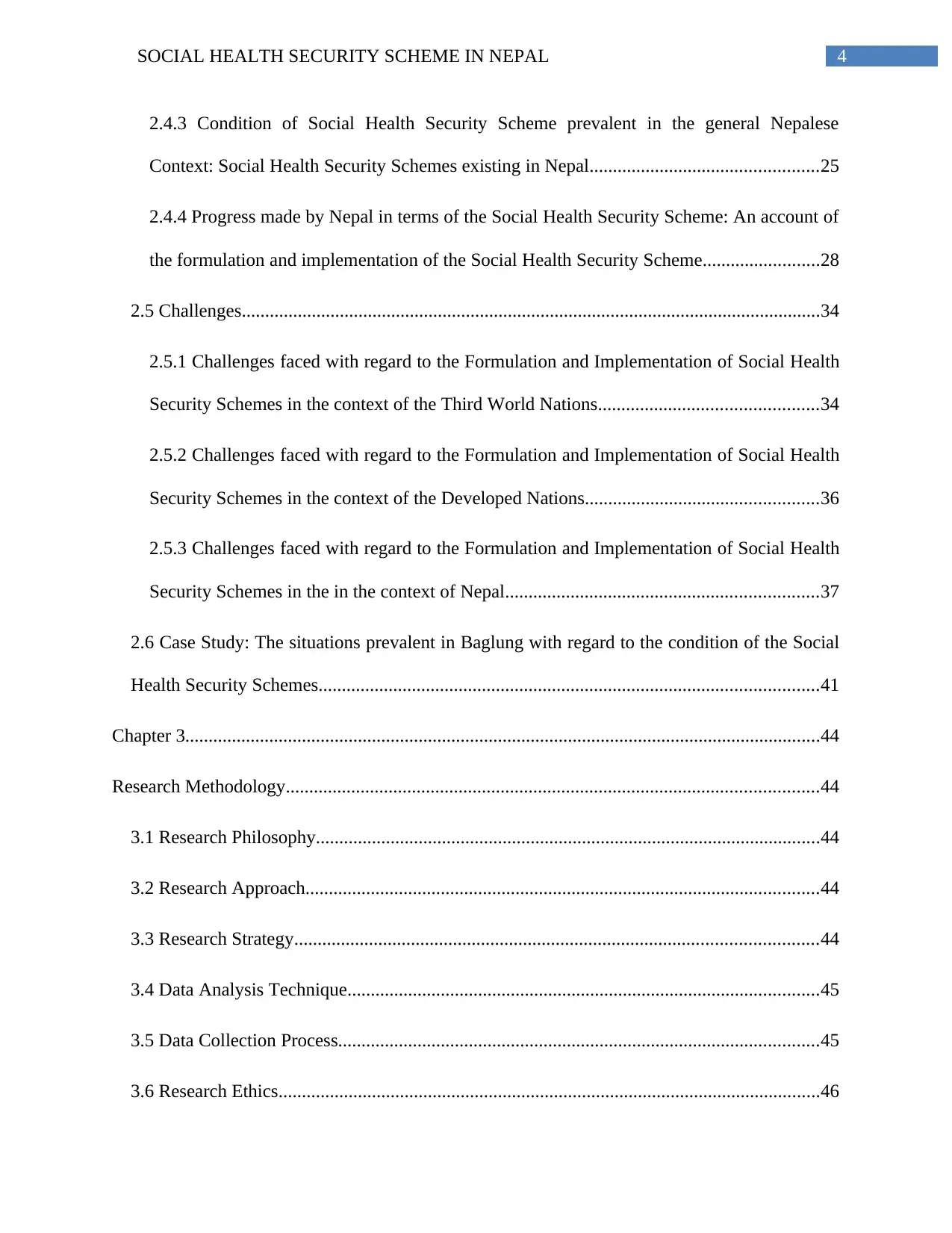
4SOCIAL HEALTH SECURITY SCHEME IN NEPAL
2.4.3 Condition of Social Health Security Scheme prevalent in the general Nepalese
Context: Social Health Security Schemes existing in Nepal.................................................25
2.4.4 Progress made by Nepal in terms of the Social Health Security Scheme: An account of
the formulation and implementation of the Social Health Security Scheme.........................28
2.5 Challenges............................................................................................................................34
2.5.1 Challenges faced with regard to the Formulation and Implementation of Social Health
Security Schemes in the context of the Third World Nations...............................................34
2.5.2 Challenges faced with regard to the Formulation and Implementation of Social Health
Security Schemes in the context of the Developed Nations..................................................36
2.5.3 Challenges faced with regard to the Formulation and Implementation of Social Health
Security Schemes in the in the context of Nepal...................................................................37
2.6 Case Study: The situations prevalent in Baglung with regard to the condition of the Social
Health Security Schemes...........................................................................................................41
Chapter 3........................................................................................................................................44
Research Methodology..................................................................................................................44
3.1 Research Philosophy............................................................................................................44
3.2 Research Approach..............................................................................................................44
3.3 Research Strategy................................................................................................................44
3.4 Data Analysis Technique.....................................................................................................45
3.5 Data Collection Process.......................................................................................................45
3.6 Research Ethics....................................................................................................................46
2.4.3 Condition of Social Health Security Scheme prevalent in the general Nepalese
Context: Social Health Security Schemes existing in Nepal.................................................25
2.4.4 Progress made by Nepal in terms of the Social Health Security Scheme: An account of
the formulation and implementation of the Social Health Security Scheme.........................28
2.5 Challenges............................................................................................................................34
2.5.1 Challenges faced with regard to the Formulation and Implementation of Social Health
Security Schemes in the context of the Third World Nations...............................................34
2.5.2 Challenges faced with regard to the Formulation and Implementation of Social Health
Security Schemes in the context of the Developed Nations..................................................36
2.5.3 Challenges faced with regard to the Formulation and Implementation of Social Health
Security Schemes in the in the context of Nepal...................................................................37
2.6 Case Study: The situations prevalent in Baglung with regard to the condition of the Social
Health Security Schemes...........................................................................................................41
Chapter 3........................................................................................................................................44
Research Methodology..................................................................................................................44
3.1 Research Philosophy............................................................................................................44
3.2 Research Approach..............................................................................................................44
3.3 Research Strategy................................................................................................................44
3.4 Data Analysis Technique.....................................................................................................45
3.5 Data Collection Process.......................................................................................................45
3.6 Research Ethics....................................................................................................................46
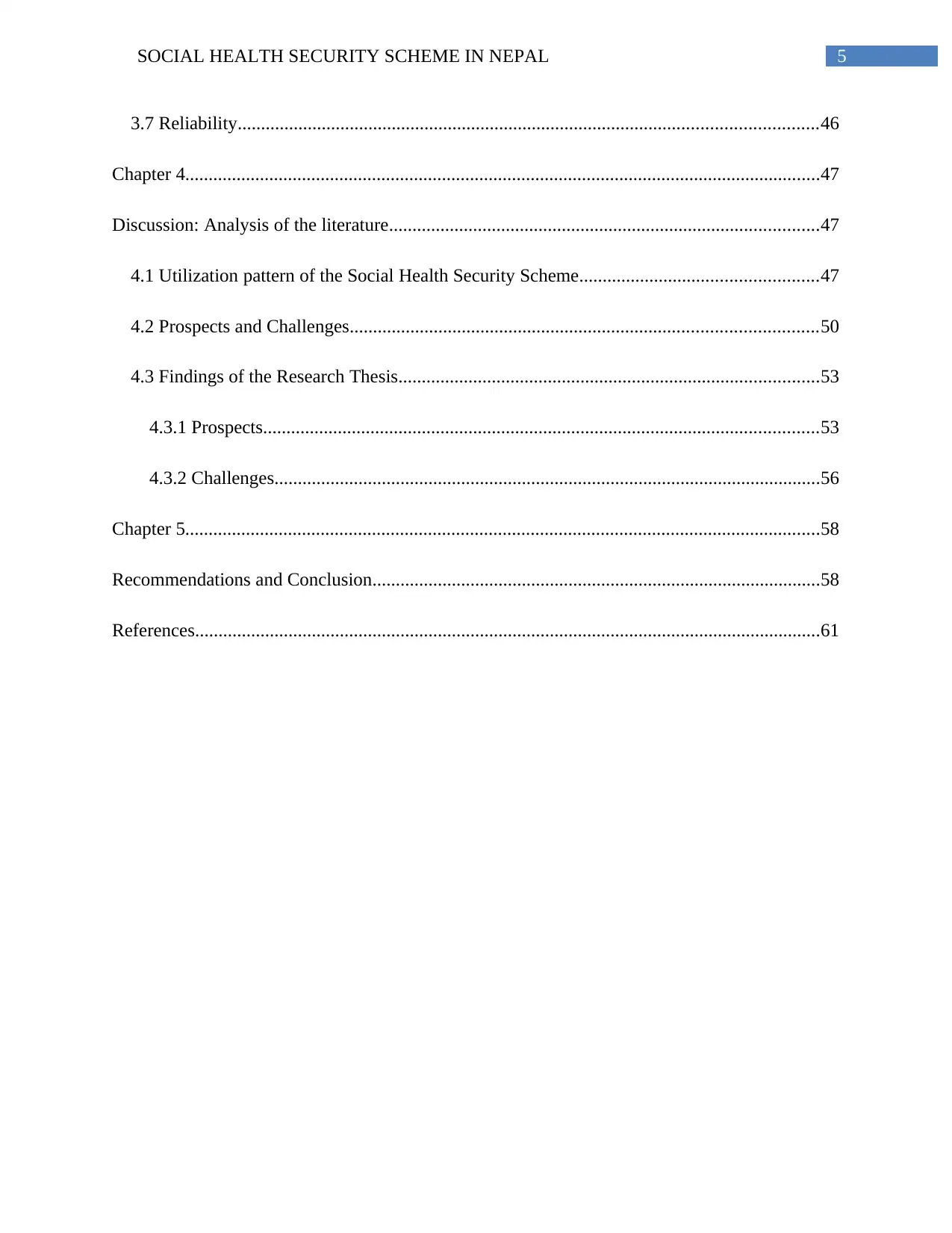
5SOCIAL HEALTH SECURITY SCHEME IN NEPAL
3.7 Reliability............................................................................................................................46
Chapter 4........................................................................................................................................47
Discussion: Analysis of the literature............................................................................................47
4.1 Utilization pattern of the Social Health Security Scheme...................................................47
4.2 Prospects and Challenges....................................................................................................50
4.3 Findings of the Research Thesis..........................................................................................53
4.3.1 Prospects.......................................................................................................................53
4.3.2 Challenges.....................................................................................................................56
Chapter 5........................................................................................................................................58
Recommendations and Conclusion................................................................................................58
References......................................................................................................................................61
3.7 Reliability............................................................................................................................46
Chapter 4........................................................................................................................................47
Discussion: Analysis of the literature............................................................................................47
4.1 Utilization pattern of the Social Health Security Scheme...................................................47
4.2 Prospects and Challenges....................................................................................................50
4.3 Findings of the Research Thesis..........................................................................................53
4.3.1 Prospects.......................................................................................................................53
4.3.2 Challenges.....................................................................................................................56
Chapter 5........................................................................................................................................58
Recommendations and Conclusion................................................................................................58
References......................................................................................................................................61
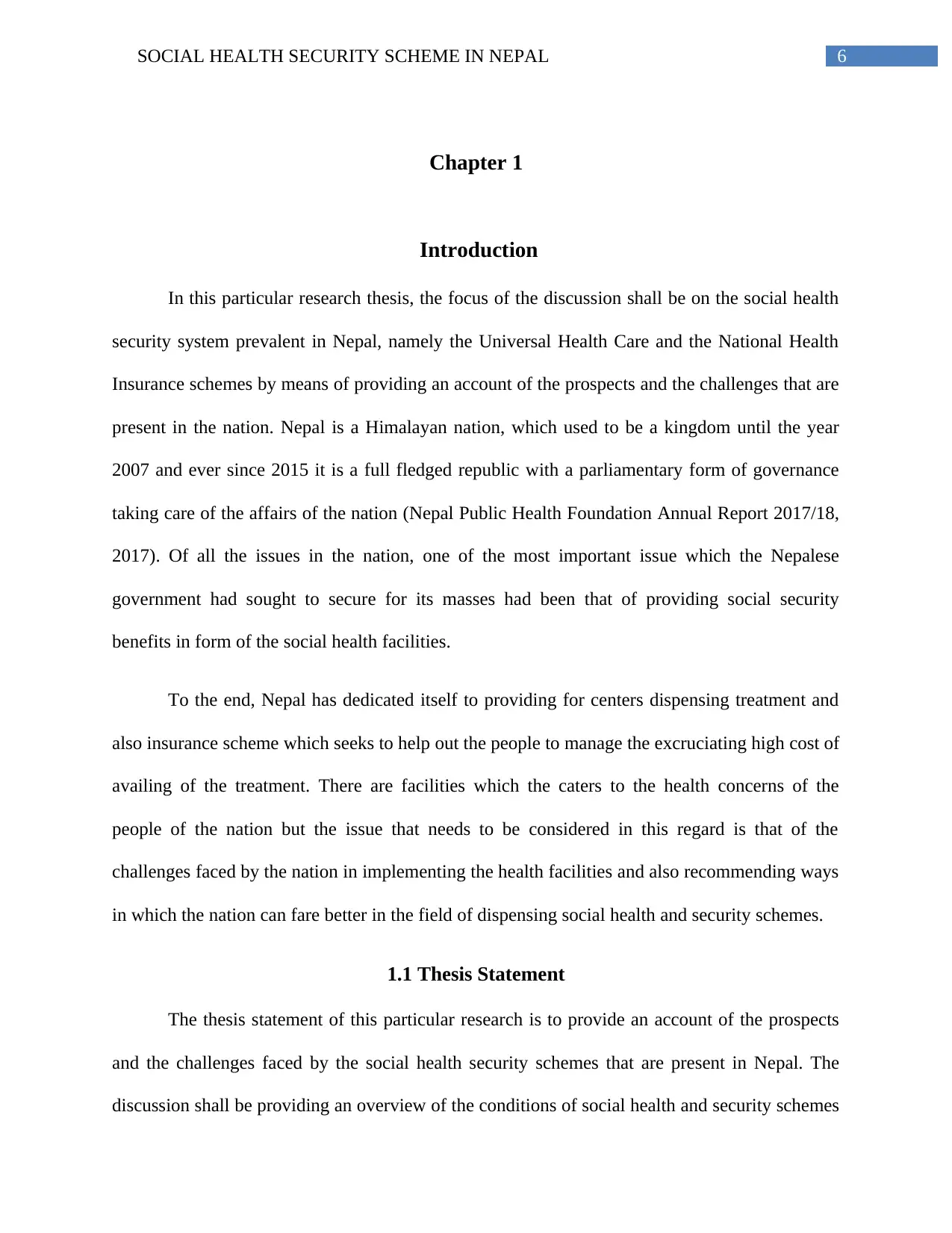
6SOCIAL HEALTH SECURITY SCHEME IN NEPAL
Chapter 1
Introduction
In this particular research thesis, the focus of the discussion shall be on the social health
security system prevalent in Nepal, namely the Universal Health Care and the National Health
Insurance schemes by means of providing an account of the prospects and the challenges that are
present in the nation. Nepal is a Himalayan nation, which used to be a kingdom until the year
2007 and ever since 2015 it is a full fledged republic with a parliamentary form of governance
taking care of the affairs of the nation (Nepal Public Health Foundation Annual Report 2017/18,
2017). Of all the issues in the nation, one of the most important issue which the Nepalese
government had sought to secure for its masses had been that of providing social security
benefits in form of the social health facilities.
To the end, Nepal has dedicated itself to providing for centers dispensing treatment and
also insurance scheme which seeks to help out the people to manage the excruciating high cost of
availing of the treatment. There are facilities which the caters to the health concerns of the
people of the nation but the issue that needs to be considered in this regard is that of the
challenges faced by the nation in implementing the health facilities and also recommending ways
in which the nation can fare better in the field of dispensing social health and security schemes.
1.1 Thesis Statement
The thesis statement of this particular research is to provide an account of the prospects
and the challenges faced by the social health security schemes that are present in Nepal. The
discussion shall be providing an overview of the conditions of social health and security schemes
Chapter 1
Introduction
In this particular research thesis, the focus of the discussion shall be on the social health
security system prevalent in Nepal, namely the Universal Health Care and the National Health
Insurance schemes by means of providing an account of the prospects and the challenges that are
present in the nation. Nepal is a Himalayan nation, which used to be a kingdom until the year
2007 and ever since 2015 it is a full fledged republic with a parliamentary form of governance
taking care of the affairs of the nation (Nepal Public Health Foundation Annual Report 2017/18,
2017). Of all the issues in the nation, one of the most important issue which the Nepalese
government had sought to secure for its masses had been that of providing social security
benefits in form of the social health facilities.
To the end, Nepal has dedicated itself to providing for centers dispensing treatment and
also insurance scheme which seeks to help out the people to manage the excruciating high cost of
availing of the treatment. There are facilities which the caters to the health concerns of the
people of the nation but the issue that needs to be considered in this regard is that of the
challenges faced by the nation in implementing the health facilities and also recommending ways
in which the nation can fare better in the field of dispensing social health and security schemes.
1.1 Thesis Statement
The thesis statement of this particular research is to provide an account of the prospects
and the challenges faced by the social health security schemes that are present in Nepal. The
discussion shall be providing an overview of the conditions of social health and security schemes
Paraphrase This Document
Need a fresh take? Get an instant paraphrase of this document with our AI Paraphraser
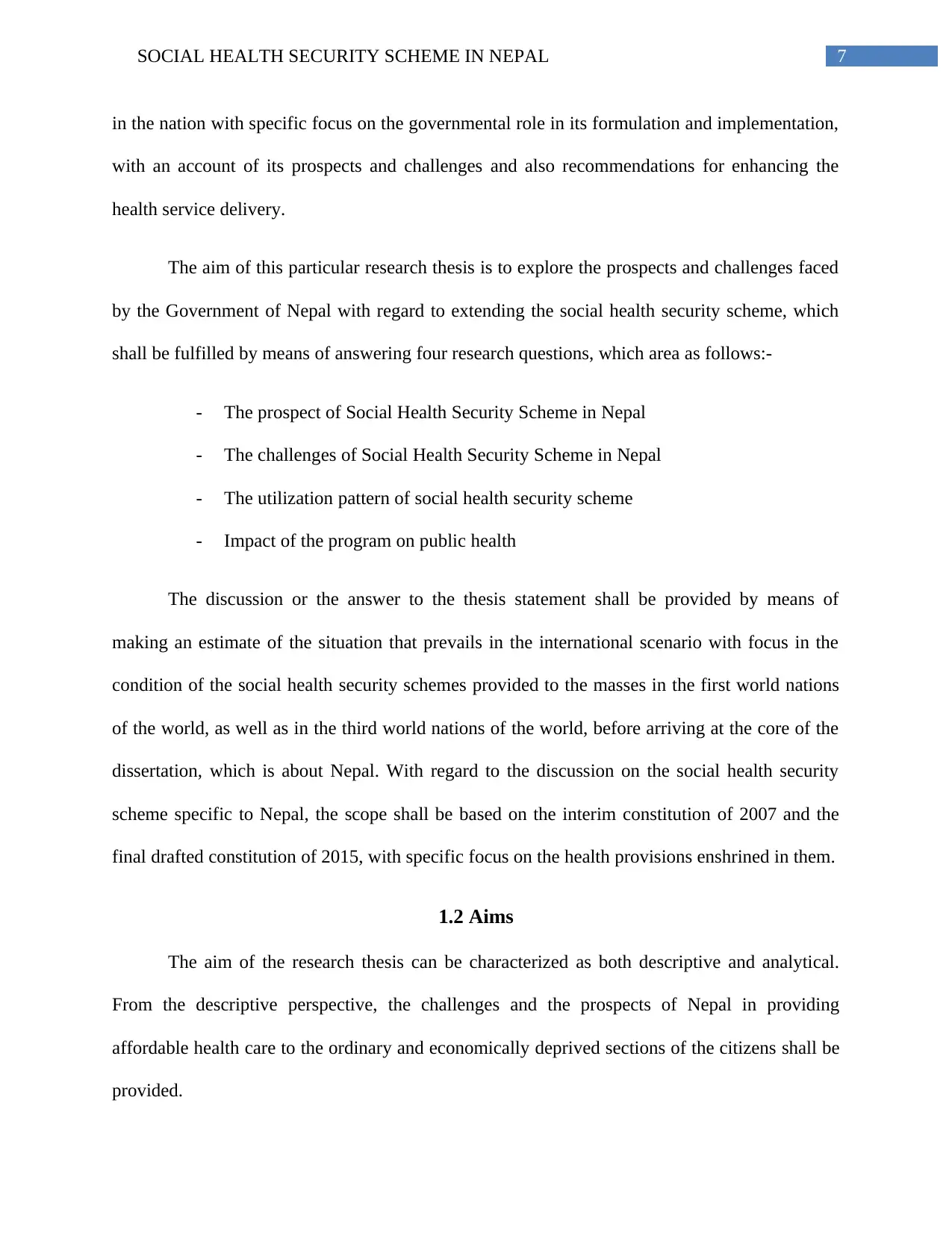
7SOCIAL HEALTH SECURITY SCHEME IN NEPAL
in the nation with specific focus on the governmental role in its formulation and implementation,
with an account of its prospects and challenges and also recommendations for enhancing the
health service delivery.
The aim of this particular research thesis is to explore the prospects and challenges faced
by the Government of Nepal with regard to extending the social health security scheme, which
shall be fulfilled by means of answering four research questions, which area as follows:-
- The prospect of Social Health Security Scheme in Nepal
- The challenges of Social Health Security Scheme in Nepal
- The utilization pattern of social health security scheme
- Impact of the program on public health
The discussion or the answer to the thesis statement shall be provided by means of
making an estimate of the situation that prevails in the international scenario with focus in the
condition of the social health security schemes provided to the masses in the first world nations
of the world, as well as in the third world nations of the world, before arriving at the core of the
dissertation, which is about Nepal. With regard to the discussion on the social health security
scheme specific to Nepal, the scope shall be based on the interim constitution of 2007 and the
final drafted constitution of 2015, with specific focus on the health provisions enshrined in them.
1.2 Aims
The aim of the research thesis can be characterized as both descriptive and analytical.
From the descriptive perspective, the challenges and the prospects of Nepal in providing
affordable health care to the ordinary and economically deprived sections of the citizens shall be
provided.
in the nation with specific focus on the governmental role in its formulation and implementation,
with an account of its prospects and challenges and also recommendations for enhancing the
health service delivery.
The aim of this particular research thesis is to explore the prospects and challenges faced
by the Government of Nepal with regard to extending the social health security scheme, which
shall be fulfilled by means of answering four research questions, which area as follows:-
- The prospect of Social Health Security Scheme in Nepal
- The challenges of Social Health Security Scheme in Nepal
- The utilization pattern of social health security scheme
- Impact of the program on public health
The discussion or the answer to the thesis statement shall be provided by means of
making an estimate of the situation that prevails in the international scenario with focus in the
condition of the social health security schemes provided to the masses in the first world nations
of the world, as well as in the third world nations of the world, before arriving at the core of the
dissertation, which is about Nepal. With regard to the discussion on the social health security
scheme specific to Nepal, the scope shall be based on the interim constitution of 2007 and the
final drafted constitution of 2015, with specific focus on the health provisions enshrined in them.
1.2 Aims
The aim of the research thesis can be characterized as both descriptive and analytical.
From the descriptive perspective, the challenges and the prospects of Nepal in providing
affordable health care to the ordinary and economically deprived sections of the citizens shall be
provided.
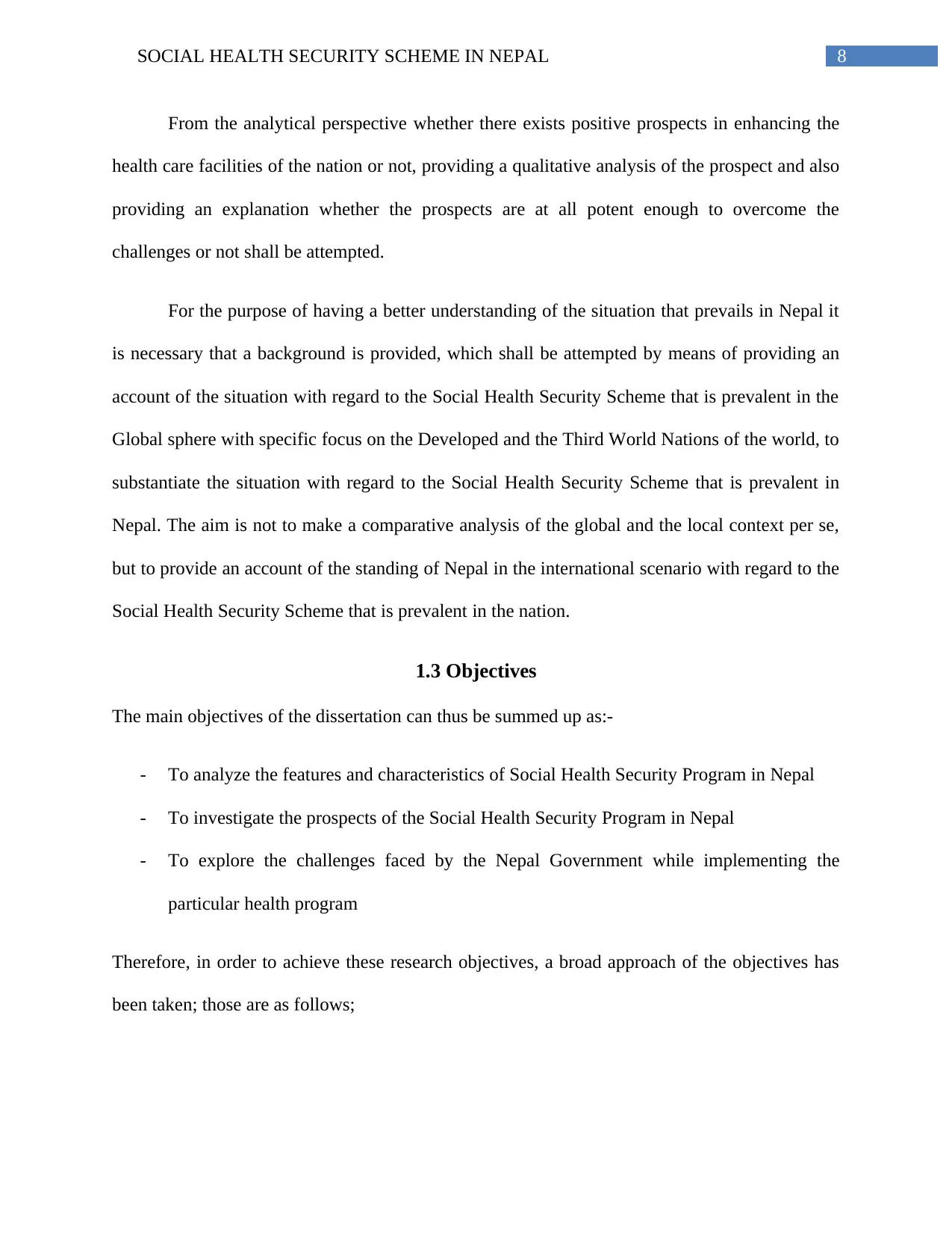
8SOCIAL HEALTH SECURITY SCHEME IN NEPAL
From the analytical perspective whether there exists positive prospects in enhancing the
health care facilities of the nation or not, providing a qualitative analysis of the prospect and also
providing an explanation whether the prospects are at all potent enough to overcome the
challenges or not shall be attempted.
For the purpose of having a better understanding of the situation that prevails in Nepal it
is necessary that a background is provided, which shall be attempted by means of providing an
account of the situation with regard to the Social Health Security Scheme that is prevalent in the
Global sphere with specific focus on the Developed and the Third World Nations of the world, to
substantiate the situation with regard to the Social Health Security Scheme that is prevalent in
Nepal. The aim is not to make a comparative analysis of the global and the local context per se,
but to provide an account of the standing of Nepal in the international scenario with regard to the
Social Health Security Scheme that is prevalent in the nation.
1.3 Objectives
The main objectives of the dissertation can thus be summed up as:-
- To analyze the features and characteristics of Social Health Security Program in Nepal
- To investigate the prospects of the Social Health Security Program in Nepal
- To explore the challenges faced by the Nepal Government while implementing the
particular health program
Therefore, in order to achieve these research objectives, a broad approach of the objectives has
been taken; those are as follows;
From the analytical perspective whether there exists positive prospects in enhancing the
health care facilities of the nation or not, providing a qualitative analysis of the prospect and also
providing an explanation whether the prospects are at all potent enough to overcome the
challenges or not shall be attempted.
For the purpose of having a better understanding of the situation that prevails in Nepal it
is necessary that a background is provided, which shall be attempted by means of providing an
account of the situation with regard to the Social Health Security Scheme that is prevalent in the
Global sphere with specific focus on the Developed and the Third World Nations of the world, to
substantiate the situation with regard to the Social Health Security Scheme that is prevalent in
Nepal. The aim is not to make a comparative analysis of the global and the local context per se,
but to provide an account of the standing of Nepal in the international scenario with regard to the
Social Health Security Scheme that is prevalent in the nation.
1.3 Objectives
The main objectives of the dissertation can thus be summed up as:-
- To analyze the features and characteristics of Social Health Security Program in Nepal
- To investigate the prospects of the Social Health Security Program in Nepal
- To explore the challenges faced by the Nepal Government while implementing the
particular health program
Therefore, in order to achieve these research objectives, a broad approach of the objectives has
been taken; those are as follows;
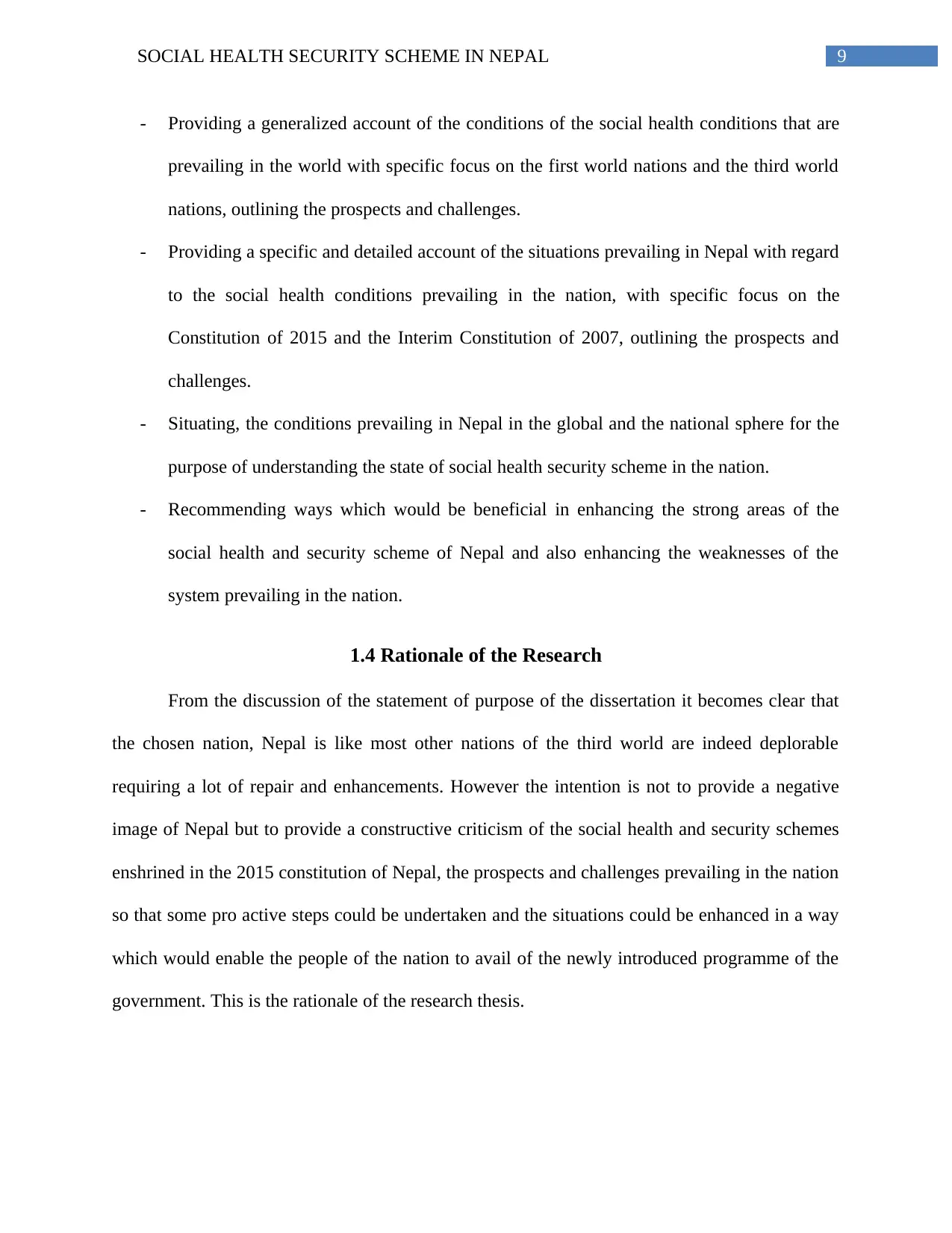
9SOCIAL HEALTH SECURITY SCHEME IN NEPAL
- Providing a generalized account of the conditions of the social health conditions that are
prevailing in the world with specific focus on the first world nations and the third world
nations, outlining the prospects and challenges.
- Providing a specific and detailed account of the situations prevailing in Nepal with regard
to the social health conditions prevailing in the nation, with specific focus on the
Constitution of 2015 and the Interim Constitution of 2007, outlining the prospects and
challenges.
- Situating, the conditions prevailing in Nepal in the global and the national sphere for the
purpose of understanding the state of social health security scheme in the nation.
- Recommending ways which would be beneficial in enhancing the strong areas of the
social health and security scheme of Nepal and also enhancing the weaknesses of the
system prevailing in the nation.
1.4 Rationale of the Research
From the discussion of the statement of purpose of the dissertation it becomes clear that
the chosen nation, Nepal is like most other nations of the third world are indeed deplorable
requiring a lot of repair and enhancements. However the intention is not to provide a negative
image of Nepal but to provide a constructive criticism of the social health and security schemes
enshrined in the 2015 constitution of Nepal, the prospects and challenges prevailing in the nation
so that some pro active steps could be undertaken and the situations could be enhanced in a way
which would enable the people of the nation to avail of the newly introduced programme of the
government. This is the rationale of the research thesis.
- Providing a generalized account of the conditions of the social health conditions that are
prevailing in the world with specific focus on the first world nations and the third world
nations, outlining the prospects and challenges.
- Providing a specific and detailed account of the situations prevailing in Nepal with regard
to the social health conditions prevailing in the nation, with specific focus on the
Constitution of 2015 and the Interim Constitution of 2007, outlining the prospects and
challenges.
- Situating, the conditions prevailing in Nepal in the global and the national sphere for the
purpose of understanding the state of social health security scheme in the nation.
- Recommending ways which would be beneficial in enhancing the strong areas of the
social health and security scheme of Nepal and also enhancing the weaknesses of the
system prevailing in the nation.
1.4 Rationale of the Research
From the discussion of the statement of purpose of the dissertation it becomes clear that
the chosen nation, Nepal is like most other nations of the third world are indeed deplorable
requiring a lot of repair and enhancements. However the intention is not to provide a negative
image of Nepal but to provide a constructive criticism of the social health and security schemes
enshrined in the 2015 constitution of Nepal, the prospects and challenges prevailing in the nation
so that some pro active steps could be undertaken and the situations could be enhanced in a way
which would enable the people of the nation to avail of the newly introduced programme of the
government. This is the rationale of the research thesis.
Secure Best Marks with AI Grader
Need help grading? Try our AI Grader for instant feedback on your assignments.
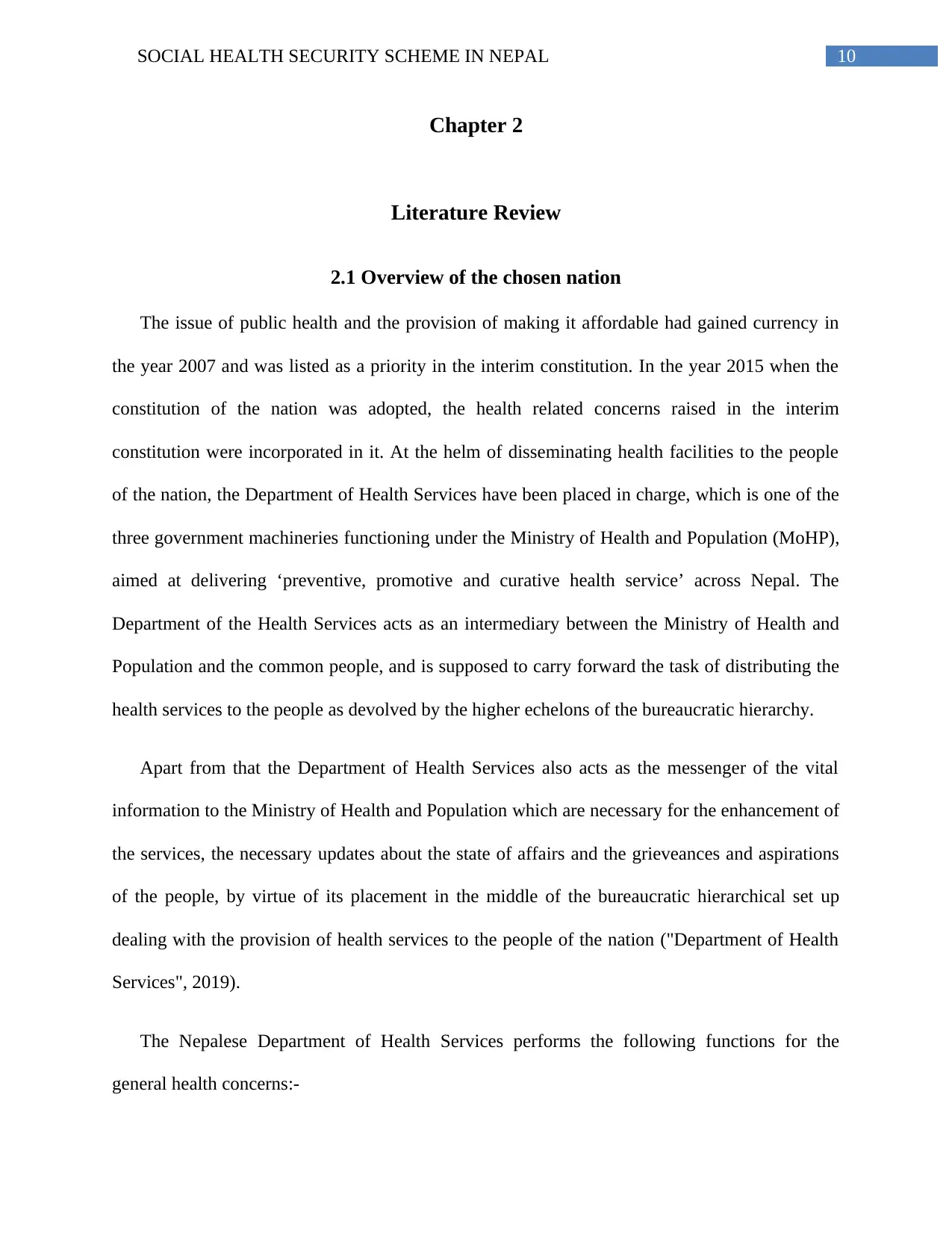
10SOCIAL HEALTH SECURITY SCHEME IN NEPAL
Chapter 2
Literature Review
2.1 Overview of the chosen nation
The issue of public health and the provision of making it affordable had gained currency in
the year 2007 and was listed as a priority in the interim constitution. In the year 2015 when the
constitution of the nation was adopted, the health related concerns raised in the interim
constitution were incorporated in it. At the helm of disseminating health facilities to the people
of the nation, the Department of Health Services have been placed in charge, which is one of the
three government machineries functioning under the Ministry of Health and Population (MoHP),
aimed at delivering ‘preventive, promotive and curative health service’ across Nepal. The
Department of the Health Services acts as an intermediary between the Ministry of Health and
Population and the common people, and is supposed to carry forward the task of distributing the
health services to the people as devolved by the higher echelons of the bureaucratic hierarchy.
Apart from that the Department of Health Services also acts as the messenger of the vital
information to the Ministry of Health and Population which are necessary for the enhancement of
the services, the necessary updates about the state of affairs and the grieveances and aspirations
of the people, by virtue of its placement in the middle of the bureaucratic hierarchical set up
dealing with the provision of health services to the people of the nation ("Department of Health
Services", 2019).
The Nepalese Department of Health Services performs the following functions for the
general health concerns:-
Chapter 2
Literature Review
2.1 Overview of the chosen nation
The issue of public health and the provision of making it affordable had gained currency in
the year 2007 and was listed as a priority in the interim constitution. In the year 2015 when the
constitution of the nation was adopted, the health related concerns raised in the interim
constitution were incorporated in it. At the helm of disseminating health facilities to the people
of the nation, the Department of Health Services have been placed in charge, which is one of the
three government machineries functioning under the Ministry of Health and Population (MoHP),
aimed at delivering ‘preventive, promotive and curative health service’ across Nepal. The
Department of the Health Services acts as an intermediary between the Ministry of Health and
Population and the common people, and is supposed to carry forward the task of distributing the
health services to the people as devolved by the higher echelons of the bureaucratic hierarchy.
Apart from that the Department of Health Services also acts as the messenger of the vital
information to the Ministry of Health and Population which are necessary for the enhancement of
the services, the necessary updates about the state of affairs and the grieveances and aspirations
of the people, by virtue of its placement in the middle of the bureaucratic hierarchical set up
dealing with the provision of health services to the people of the nation ("Department of Health
Services", 2019).
The Nepalese Department of Health Services performs the following functions for the
general health concerns:-
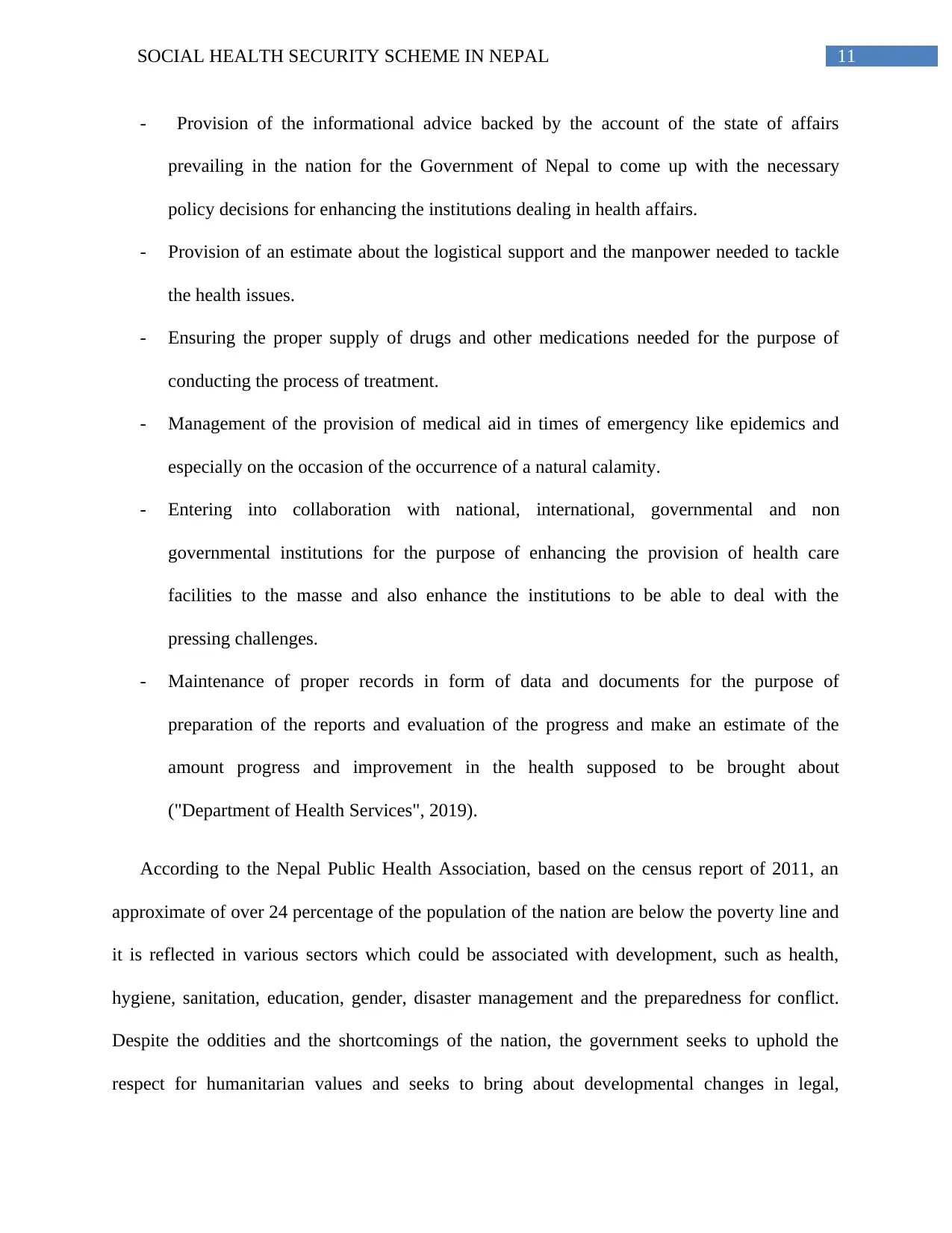
11SOCIAL HEALTH SECURITY SCHEME IN NEPAL
- Provision of the informational advice backed by the account of the state of affairs
prevailing in the nation for the Government of Nepal to come up with the necessary
policy decisions for enhancing the institutions dealing in health affairs.
- Provision of an estimate about the logistical support and the manpower needed to tackle
the health issues.
- Ensuring the proper supply of drugs and other medications needed for the purpose of
conducting the process of treatment.
- Management of the provision of medical aid in times of emergency like epidemics and
especially on the occasion of the occurrence of a natural calamity.
- Entering into collaboration with national, international, governmental and non
governmental institutions for the purpose of enhancing the provision of health care
facilities to the masse and also enhance the institutions to be able to deal with the
pressing challenges.
- Maintenance of proper records in form of data and documents for the purpose of
preparation of the reports and evaluation of the progress and make an estimate of the
amount progress and improvement in the health supposed to be brought about
("Department of Health Services", 2019).
According to the Nepal Public Health Association, based on the census report of 2011, an
approximate of over 24 percentage of the population of the nation are below the poverty line and
it is reflected in various sectors which could be associated with development, such as health,
hygiene, sanitation, education, gender, disaster management and the preparedness for conflict.
Despite the oddities and the shortcomings of the nation, the government seeks to uphold the
respect for humanitarian values and seeks to bring about developmental changes in legal,
- Provision of the informational advice backed by the account of the state of affairs
prevailing in the nation for the Government of Nepal to come up with the necessary
policy decisions for enhancing the institutions dealing in health affairs.
- Provision of an estimate about the logistical support and the manpower needed to tackle
the health issues.
- Ensuring the proper supply of drugs and other medications needed for the purpose of
conducting the process of treatment.
- Management of the provision of medical aid in times of emergency like epidemics and
especially on the occasion of the occurrence of a natural calamity.
- Entering into collaboration with national, international, governmental and non
governmental institutions for the purpose of enhancing the provision of health care
facilities to the masse and also enhance the institutions to be able to deal with the
pressing challenges.
- Maintenance of proper records in form of data and documents for the purpose of
preparation of the reports and evaluation of the progress and make an estimate of the
amount progress and improvement in the health supposed to be brought about
("Department of Health Services", 2019).
According to the Nepal Public Health Association, based on the census report of 2011, an
approximate of over 24 percentage of the population of the nation are below the poverty line and
it is reflected in various sectors which could be associated with development, such as health,
hygiene, sanitation, education, gender, disaster management and the preparedness for conflict.
Despite the oddities and the shortcomings of the nation, the government seeks to uphold the
respect for humanitarian values and seeks to bring about developmental changes in legal,
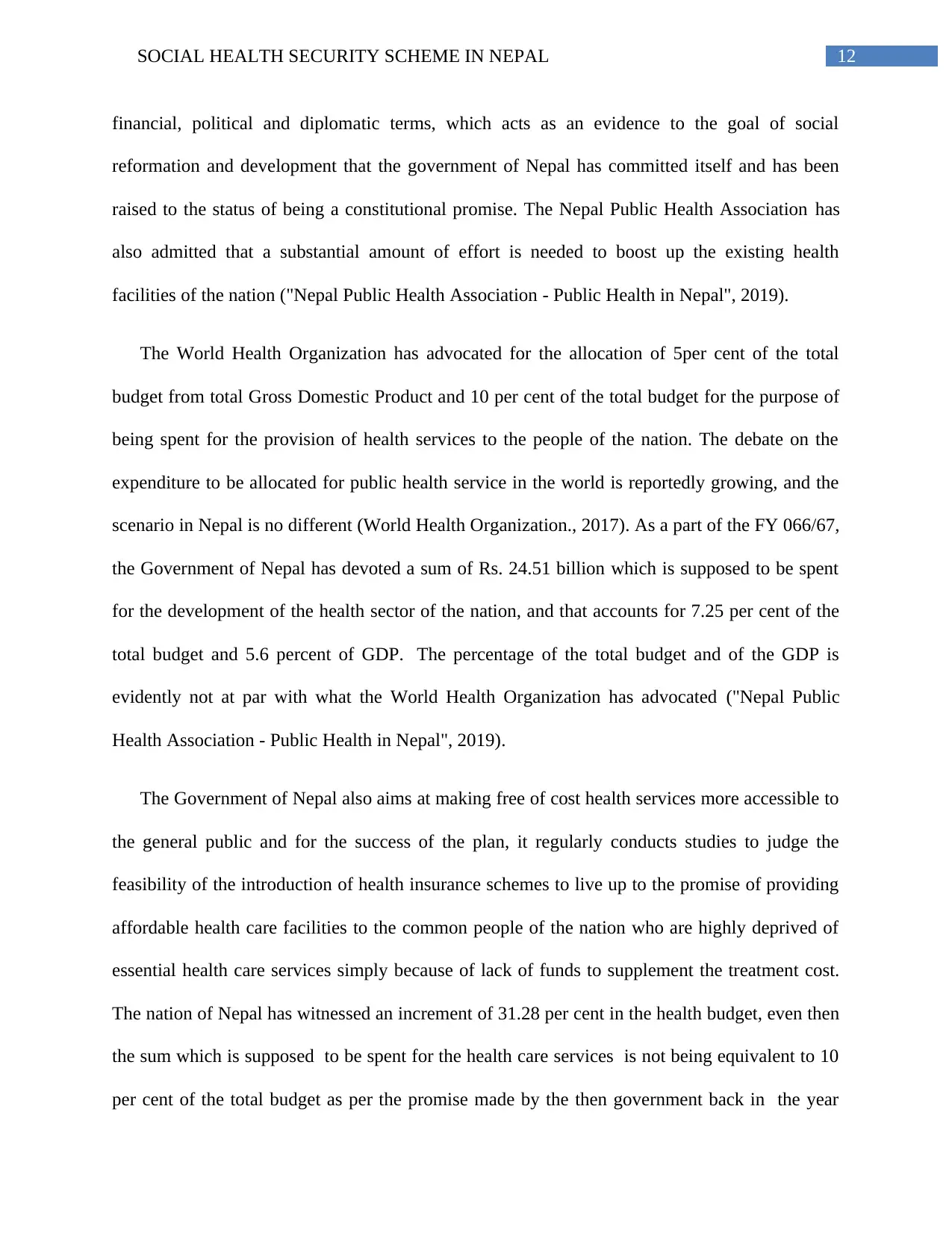
12SOCIAL HEALTH SECURITY SCHEME IN NEPAL
financial, political and diplomatic terms, which acts as an evidence to the goal of social
reformation and development that the government of Nepal has committed itself and has been
raised to the status of being a constitutional promise. The Nepal Public Health Association has
also admitted that a substantial amount of effort is needed to boost up the existing health
facilities of the nation ("Nepal Public Health Association - Public Health in Nepal", 2019).
The World Health Organization has advocated for the allocation of 5per cent of the total
budget from total Gross Domestic Product and 10 per cent of the total budget for the purpose of
being spent for the provision of health services to the people of the nation. The debate on the
expenditure to be allocated for public health service in the world is reportedly growing, and the
scenario in Nepal is no different (World Health Organization., 2017). As a part of the FY 066/67,
the Government of Nepal has devoted a sum of Rs. 24.51 billion which is supposed to be spent
for the development of the health sector of the nation, and that accounts for 7.25 per cent of the
total budget and 5.6 percent of GDP. The percentage of the total budget and of the GDP is
evidently not at par with what the World Health Organization has advocated ("Nepal Public
Health Association - Public Health in Nepal", 2019).
The Government of Nepal also aims at making free of cost health services more accessible to
the general public and for the success of the plan, it regularly conducts studies to judge the
feasibility of the introduction of health insurance schemes to live up to the promise of providing
affordable health care facilities to the common people of the nation who are highly deprived of
essential health care services simply because of lack of funds to supplement the treatment cost.
The nation of Nepal has witnessed an increment of 31.28 per cent in the health budget, even then
the sum which is supposed to be spent for the health care services is not being equivalent to 10
per cent of the total budget as per the promise made by the then government back in the year
financial, political and diplomatic terms, which acts as an evidence to the goal of social
reformation and development that the government of Nepal has committed itself and has been
raised to the status of being a constitutional promise. The Nepal Public Health Association has
also admitted that a substantial amount of effort is needed to boost up the existing health
facilities of the nation ("Nepal Public Health Association - Public Health in Nepal", 2019).
The World Health Organization has advocated for the allocation of 5per cent of the total
budget from total Gross Domestic Product and 10 per cent of the total budget for the purpose of
being spent for the provision of health services to the people of the nation. The debate on the
expenditure to be allocated for public health service in the world is reportedly growing, and the
scenario in Nepal is no different (World Health Organization., 2017). As a part of the FY 066/67,
the Government of Nepal has devoted a sum of Rs. 24.51 billion which is supposed to be spent
for the development of the health sector of the nation, and that accounts for 7.25 per cent of the
total budget and 5.6 percent of GDP. The percentage of the total budget and of the GDP is
evidently not at par with what the World Health Organization has advocated ("Nepal Public
Health Association - Public Health in Nepal", 2019).
The Government of Nepal also aims at making free of cost health services more accessible to
the general public and for the success of the plan, it regularly conducts studies to judge the
feasibility of the introduction of health insurance schemes to live up to the promise of providing
affordable health care facilities to the common people of the nation who are highly deprived of
essential health care services simply because of lack of funds to supplement the treatment cost.
The nation of Nepal has witnessed an increment of 31.28 per cent in the health budget, even then
the sum which is supposed to be spent for the health care services is not being equivalent to 10
per cent of the total budget as per the promise made by the then government back in the year
Paraphrase This Document
Need a fresh take? Get an instant paraphrase of this document with our AI Paraphraser
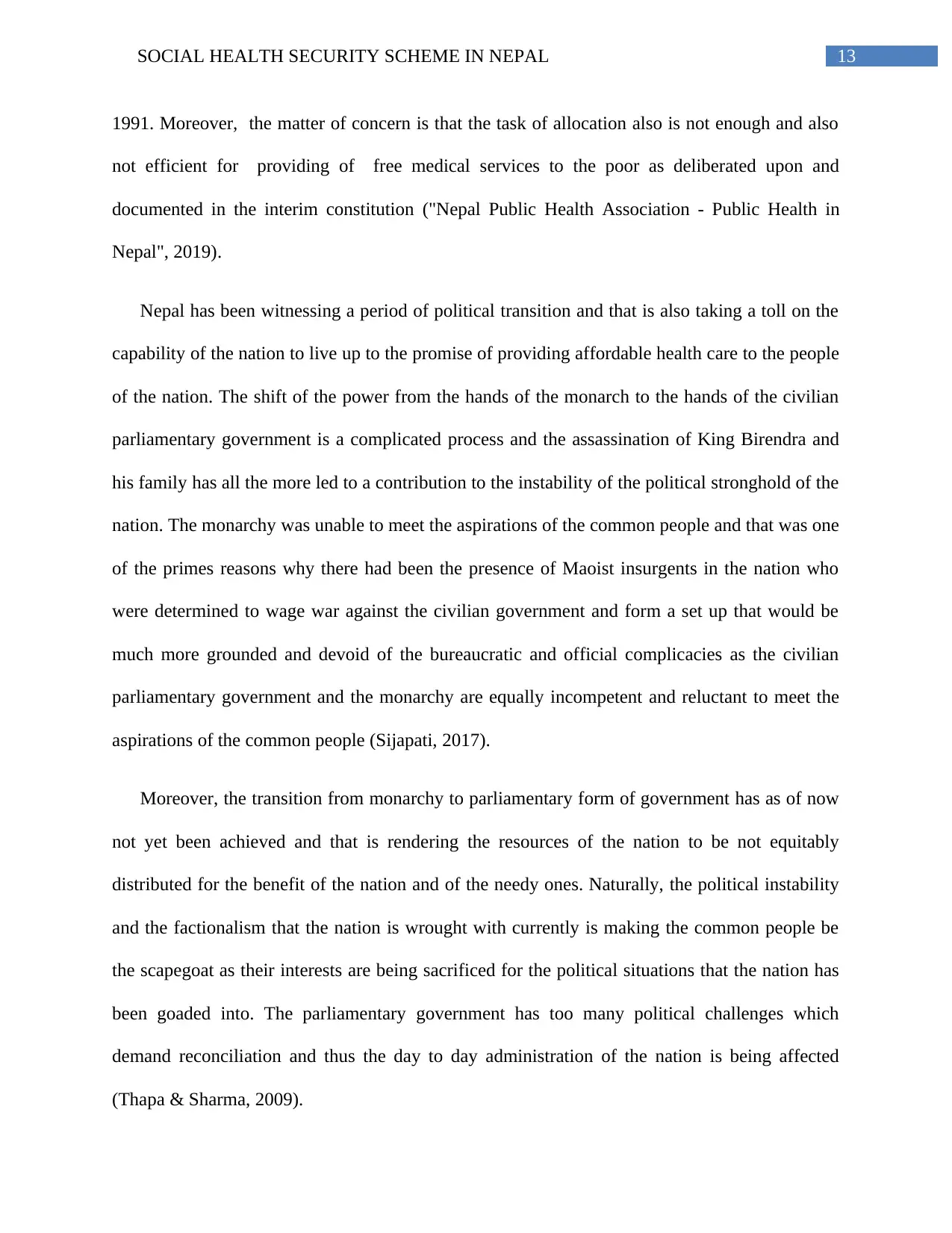
13SOCIAL HEALTH SECURITY SCHEME IN NEPAL
1991. Moreover, the matter of concern is that the task of allocation also is not enough and also
not efficient for providing of free medical services to the poor as deliberated upon and
documented in the interim constitution ("Nepal Public Health Association - Public Health in
Nepal", 2019).
Nepal has been witnessing a period of political transition and that is also taking a toll on the
capability of the nation to live up to the promise of providing affordable health care to the people
of the nation. The shift of the power from the hands of the monarch to the hands of the civilian
parliamentary government is a complicated process and the assassination of King Birendra and
his family has all the more led to a contribution to the instability of the political stronghold of the
nation. The monarchy was unable to meet the aspirations of the common people and that was one
of the primes reasons why there had been the presence of Maoist insurgents in the nation who
were determined to wage war against the civilian government and form a set up that would be
much more grounded and devoid of the bureaucratic and official complicacies as the civilian
parliamentary government and the monarchy are equally incompetent and reluctant to meet the
aspirations of the common people (Sijapati, 2017).
Moreover, the transition from monarchy to parliamentary form of government has as of now
not yet been achieved and that is rendering the resources of the nation to be not equitably
distributed for the benefit of the nation and of the needy ones. Naturally, the political instability
and the factionalism that the nation is wrought with currently is making the common people be
the scapegoat as their interests are being sacrificed for the political situations that the nation has
been goaded into. The parliamentary government has too many political challenges which
demand reconciliation and thus the day to day administration of the nation is being affected
(Thapa & Sharma, 2009).
1991. Moreover, the matter of concern is that the task of allocation also is not enough and also
not efficient for providing of free medical services to the poor as deliberated upon and
documented in the interim constitution ("Nepal Public Health Association - Public Health in
Nepal", 2019).
Nepal has been witnessing a period of political transition and that is also taking a toll on the
capability of the nation to live up to the promise of providing affordable health care to the people
of the nation. The shift of the power from the hands of the monarch to the hands of the civilian
parliamentary government is a complicated process and the assassination of King Birendra and
his family has all the more led to a contribution to the instability of the political stronghold of the
nation. The monarchy was unable to meet the aspirations of the common people and that was one
of the primes reasons why there had been the presence of Maoist insurgents in the nation who
were determined to wage war against the civilian government and form a set up that would be
much more grounded and devoid of the bureaucratic and official complicacies as the civilian
parliamentary government and the monarchy are equally incompetent and reluctant to meet the
aspirations of the common people (Sijapati, 2017).
Moreover, the transition from monarchy to parliamentary form of government has as of now
not yet been achieved and that is rendering the resources of the nation to be not equitably
distributed for the benefit of the nation and of the needy ones. Naturally, the political instability
and the factionalism that the nation is wrought with currently is making the common people be
the scapegoat as their interests are being sacrificed for the political situations that the nation has
been goaded into. The parliamentary government has too many political challenges which
demand reconciliation and thus the day to day administration of the nation is being affected
(Thapa & Sharma, 2009).
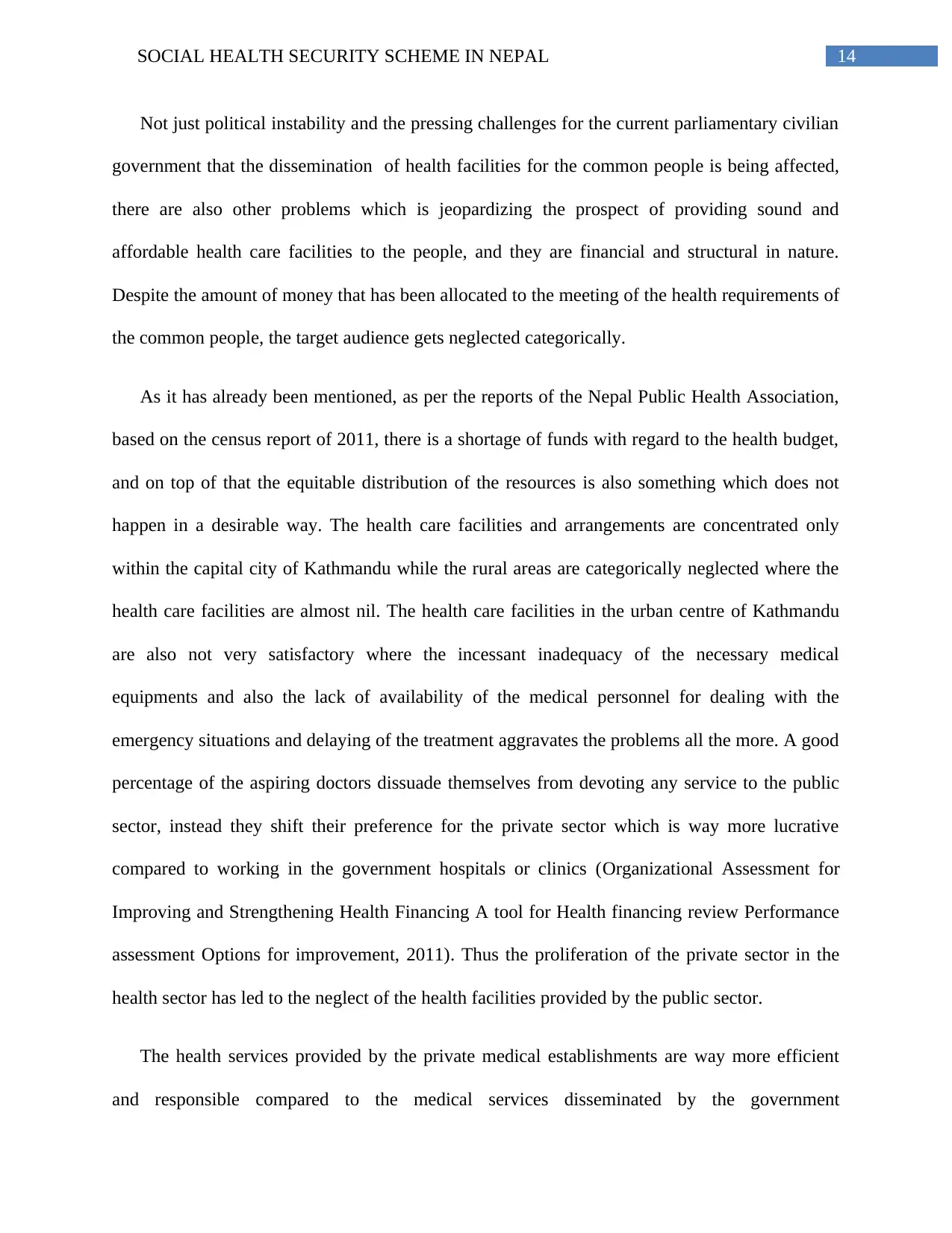
14SOCIAL HEALTH SECURITY SCHEME IN NEPAL
Not just political instability and the pressing challenges for the current parliamentary civilian
government that the dissemination of health facilities for the common people is being affected,
there are also other problems which is jeopardizing the prospect of providing sound and
affordable health care facilities to the people, and they are financial and structural in nature.
Despite the amount of money that has been allocated to the meeting of the health requirements of
the common people, the target audience gets neglected categorically.
As it has already been mentioned, as per the reports of the Nepal Public Health Association,
based on the census report of 2011, there is a shortage of funds with regard to the health budget,
and on top of that the equitable distribution of the resources is also something which does not
happen in a desirable way. The health care facilities and arrangements are concentrated only
within the capital city of Kathmandu while the rural areas are categorically neglected where the
health care facilities are almost nil. The health care facilities in the urban centre of Kathmandu
are also not very satisfactory where the incessant inadequacy of the necessary medical
equipments and also the lack of availability of the medical personnel for dealing with the
emergency situations and delaying of the treatment aggravates the problems all the more. A good
percentage of the aspiring doctors dissuade themselves from devoting any service to the public
sector, instead they shift their preference for the private sector which is way more lucrative
compared to working in the government hospitals or clinics (Organizational Assessment for
Improving and Strengthening Health Financing A tool for Health financing review Performance
assessment Options for improvement, 2011). Thus the proliferation of the private sector in the
health sector has led to the neglect of the health facilities provided by the public sector.
The health services provided by the private medical establishments are way more efficient
and responsible compared to the medical services disseminated by the government
Not just political instability and the pressing challenges for the current parliamentary civilian
government that the dissemination of health facilities for the common people is being affected,
there are also other problems which is jeopardizing the prospect of providing sound and
affordable health care facilities to the people, and they are financial and structural in nature.
Despite the amount of money that has been allocated to the meeting of the health requirements of
the common people, the target audience gets neglected categorically.
As it has already been mentioned, as per the reports of the Nepal Public Health Association,
based on the census report of 2011, there is a shortage of funds with regard to the health budget,
and on top of that the equitable distribution of the resources is also something which does not
happen in a desirable way. The health care facilities and arrangements are concentrated only
within the capital city of Kathmandu while the rural areas are categorically neglected where the
health care facilities are almost nil. The health care facilities in the urban centre of Kathmandu
are also not very satisfactory where the incessant inadequacy of the necessary medical
equipments and also the lack of availability of the medical personnel for dealing with the
emergency situations and delaying of the treatment aggravates the problems all the more. A good
percentage of the aspiring doctors dissuade themselves from devoting any service to the public
sector, instead they shift their preference for the private sector which is way more lucrative
compared to working in the government hospitals or clinics (Organizational Assessment for
Improving and Strengthening Health Financing A tool for Health financing review Performance
assessment Options for improvement, 2011). Thus the proliferation of the private sector in the
health sector has led to the neglect of the health facilities provided by the public sector.
The health services provided by the private medical establishments are way more efficient
and responsible compared to the medical services disseminated by the government
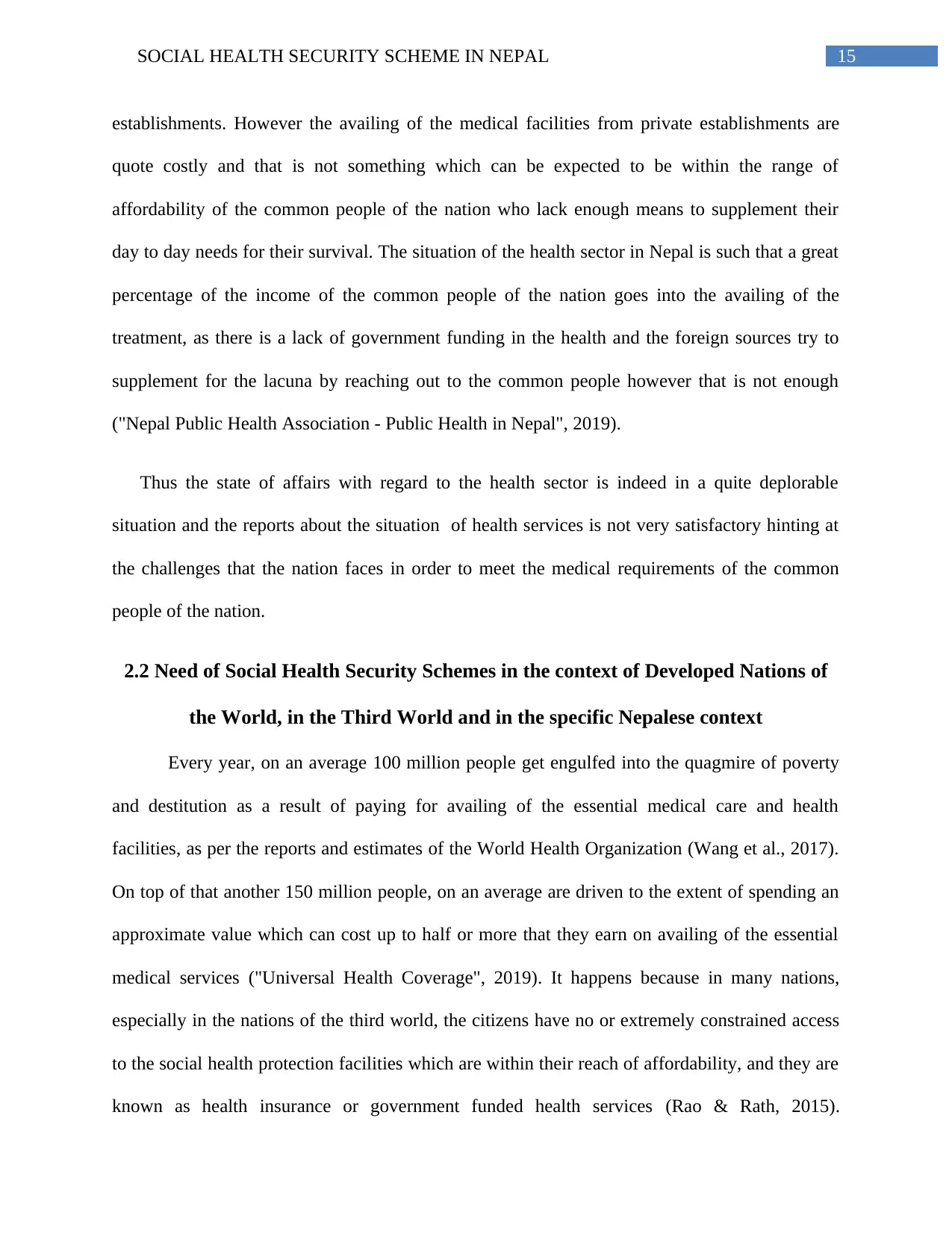
15SOCIAL HEALTH SECURITY SCHEME IN NEPAL
establishments. However the availing of the medical facilities from private establishments are
quote costly and that is not something which can be expected to be within the range of
affordability of the common people of the nation who lack enough means to supplement their
day to day needs for their survival. The situation of the health sector in Nepal is such that a great
percentage of the income of the common people of the nation goes into the availing of the
treatment, as there is a lack of government funding in the health and the foreign sources try to
supplement for the lacuna by reaching out to the common people however that is not enough
("Nepal Public Health Association - Public Health in Nepal", 2019).
Thus the state of affairs with regard to the health sector is indeed in a quite deplorable
situation and the reports about the situation of health services is not very satisfactory hinting at
the challenges that the nation faces in order to meet the medical requirements of the common
people of the nation.
2.2 Need of Social Health Security Schemes in the context of Developed Nations of
the World, in the Third World and in the specific Nepalese context
Every year, on an average 100 million people get engulfed into the quagmire of poverty
and destitution as a result of paying for availing of the essential medical care and health
facilities, as per the reports and estimates of the World Health Organization (Wang et al., 2017).
On top of that another 150 million people, on an average are driven to the extent of spending an
approximate value which can cost up to half or more that they earn on availing of the essential
medical services ("Universal Health Coverage", 2019). It happens because in many nations,
especially in the nations of the third world, the citizens have no or extremely constrained access
to the social health protection facilities which are within their reach of affordability, and they are
known as health insurance or government funded health services (Rao & Rath, 2015).
establishments. However the availing of the medical facilities from private establishments are
quote costly and that is not something which can be expected to be within the range of
affordability of the common people of the nation who lack enough means to supplement their
day to day needs for their survival. The situation of the health sector in Nepal is such that a great
percentage of the income of the common people of the nation goes into the availing of the
treatment, as there is a lack of government funding in the health and the foreign sources try to
supplement for the lacuna by reaching out to the common people however that is not enough
("Nepal Public Health Association - Public Health in Nepal", 2019).
Thus the state of affairs with regard to the health sector is indeed in a quite deplorable
situation and the reports about the situation of health services is not very satisfactory hinting at
the challenges that the nation faces in order to meet the medical requirements of the common
people of the nation.
2.2 Need of Social Health Security Schemes in the context of Developed Nations of
the World, in the Third World and in the specific Nepalese context
Every year, on an average 100 million people get engulfed into the quagmire of poverty
and destitution as a result of paying for availing of the essential medical care and health
facilities, as per the reports and estimates of the World Health Organization (Wang et al., 2017).
On top of that another 150 million people, on an average are driven to the extent of spending an
approximate value which can cost up to half or more that they earn on availing of the essential
medical services ("Universal Health Coverage", 2019). It happens because in many nations,
especially in the nations of the third world, the citizens have no or extremely constrained access
to the social health protection facilities which are within their reach of affordability, and they are
known as health insurance or government funded health services (Rao & Rath, 2015).
Secure Best Marks with AI Grader
Need help grading? Try our AI Grader for instant feedback on your assignments.
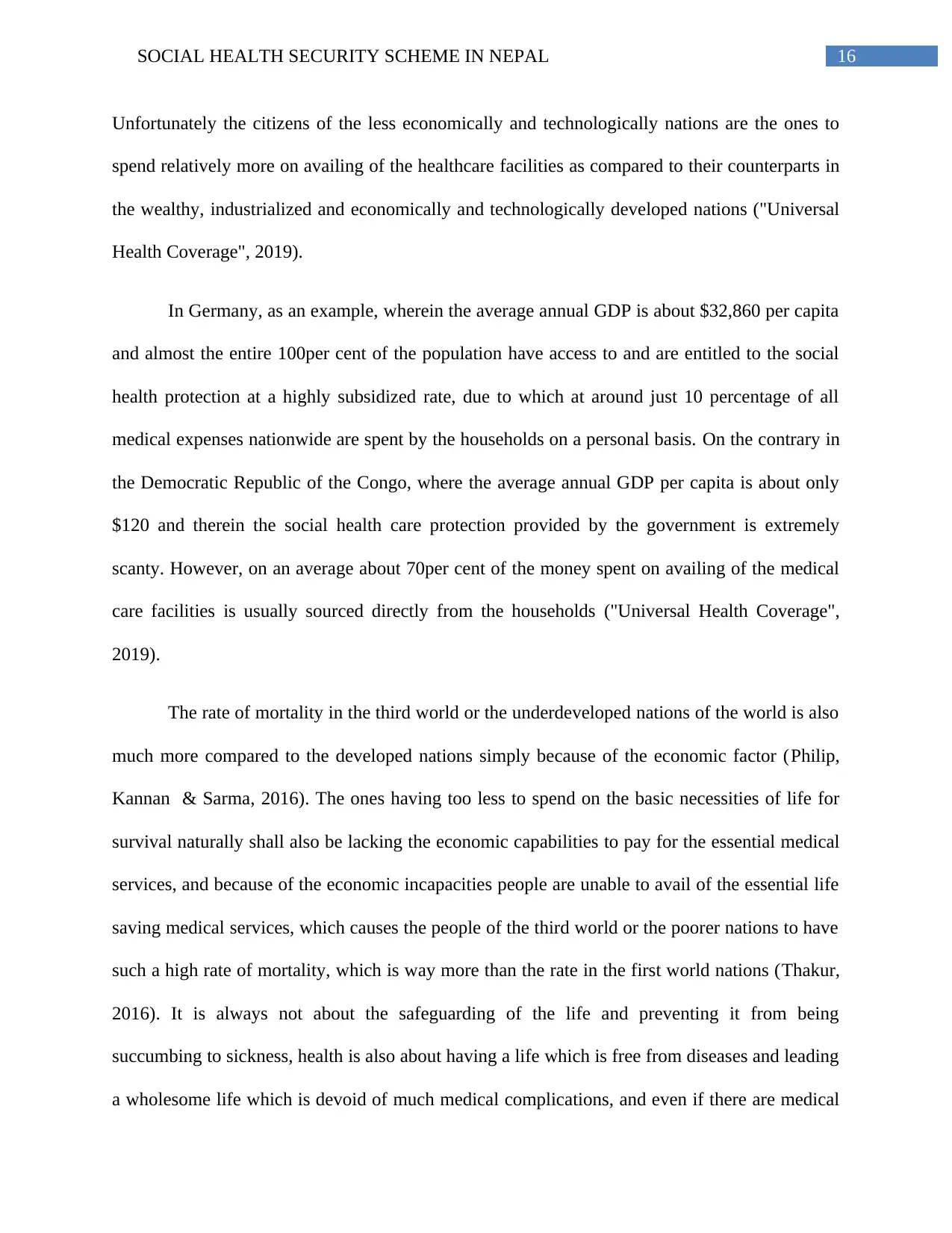
16SOCIAL HEALTH SECURITY SCHEME IN NEPAL
Unfortunately the citizens of the less economically and technologically nations are the ones to
spend relatively more on availing of the healthcare facilities as compared to their counterparts in
the wealthy, industrialized and economically and technologically developed nations ("Universal
Health Coverage", 2019).
In Germany, as an example, wherein the average annual GDP is about $32,860 per capita
and almost the entire 100per cent of the population have access to and are entitled to the social
health protection at a highly subsidized rate, due to which at around just 10 percentage of all
medical expenses nationwide are spent by the households on a personal basis. On the contrary in
the Democratic Republic of the Congo, where the average annual GDP per capita is about only
$120 and therein the social health care protection provided by the government is extremely
scanty. However, on an average about 70per cent of the money spent on availing of the medical
care facilities is usually sourced directly from the households ("Universal Health Coverage",
2019).
The rate of mortality in the third world or the underdeveloped nations of the world is also
much more compared to the developed nations simply because of the economic factor (Philip,
Kannan & Sarma, 2016). The ones having too less to spend on the basic necessities of life for
survival naturally shall also be lacking the economic capabilities to pay for the essential medical
services, and because of the economic incapacities people are unable to avail of the essential life
saving medical services, which causes the people of the third world or the poorer nations to have
such a high rate of mortality, which is way more than the rate in the first world nations (Thakur,
2016). It is always not about the safeguarding of the life and preventing it from being
succumbing to sickness, health is also about having a life which is free from diseases and leading
a wholesome life which is devoid of much medical complications, and even if there are medical
Unfortunately the citizens of the less economically and technologically nations are the ones to
spend relatively more on availing of the healthcare facilities as compared to their counterparts in
the wealthy, industrialized and economically and technologically developed nations ("Universal
Health Coverage", 2019).
In Germany, as an example, wherein the average annual GDP is about $32,860 per capita
and almost the entire 100per cent of the population have access to and are entitled to the social
health protection at a highly subsidized rate, due to which at around just 10 percentage of all
medical expenses nationwide are spent by the households on a personal basis. On the contrary in
the Democratic Republic of the Congo, where the average annual GDP per capita is about only
$120 and therein the social health care protection provided by the government is extremely
scanty. However, on an average about 70per cent of the money spent on availing of the medical
care facilities is usually sourced directly from the households ("Universal Health Coverage",
2019).
The rate of mortality in the third world or the underdeveloped nations of the world is also
much more compared to the developed nations simply because of the economic factor (Philip,
Kannan & Sarma, 2016). The ones having too less to spend on the basic necessities of life for
survival naturally shall also be lacking the economic capabilities to pay for the essential medical
services, and because of the economic incapacities people are unable to avail of the essential life
saving medical services, which causes the people of the third world or the poorer nations to have
such a high rate of mortality, which is way more than the rate in the first world nations (Thakur,
2016). It is always not about the safeguarding of the life and preventing it from being
succumbing to sickness, health is also about having a life which is free from diseases and leading
a wholesome life which is devoid of much medical complications, and even if there are medical
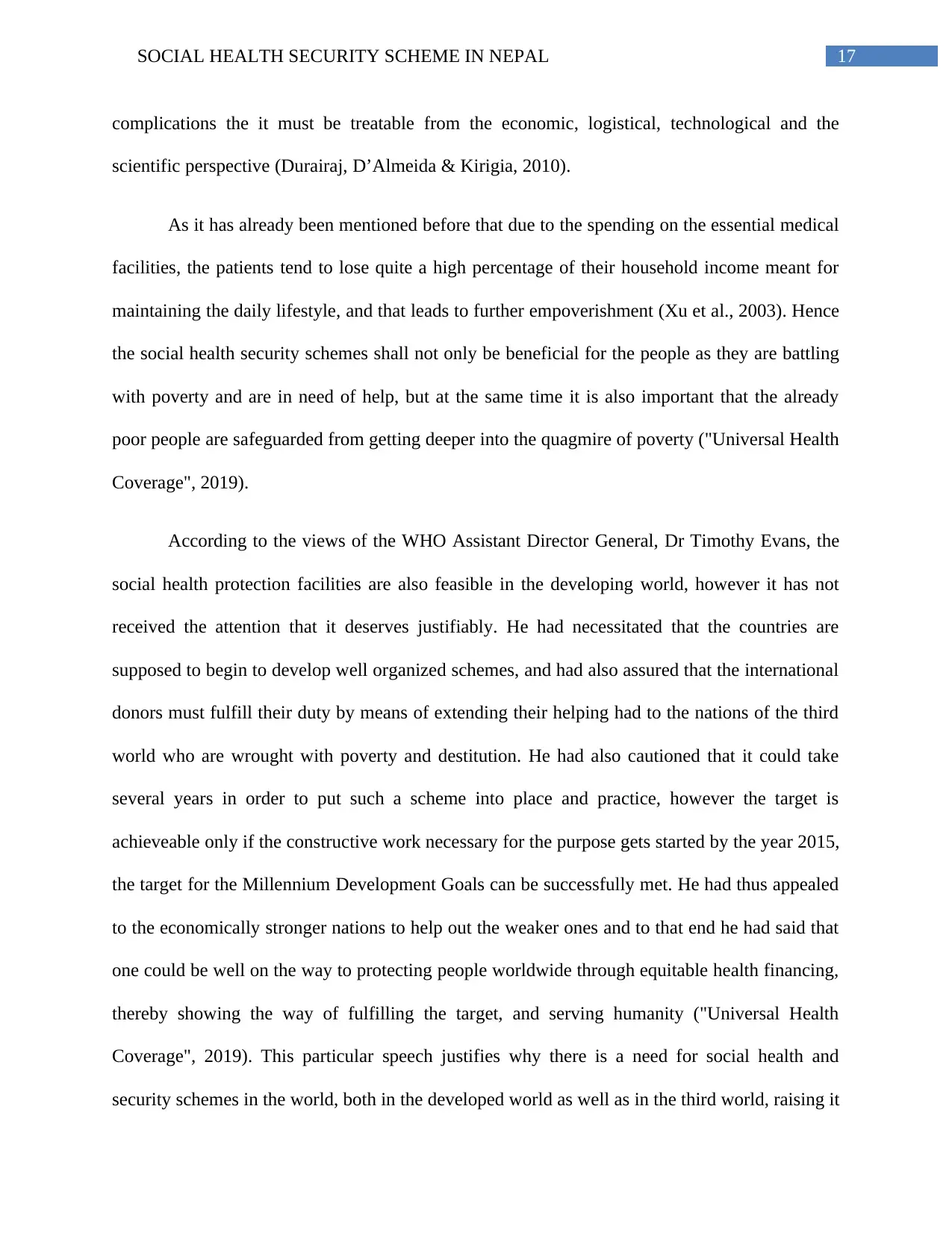
17SOCIAL HEALTH SECURITY SCHEME IN NEPAL
complications the it must be treatable from the economic, logistical, technological and the
scientific perspective (Durairaj, D’Almeida & Kirigia, 2010).
As it has already been mentioned before that due to the spending on the essential medical
facilities, the patients tend to lose quite a high percentage of their household income meant for
maintaining the daily lifestyle, and that leads to further empoverishment (Xu et al., 2003). Hence
the social health security schemes shall not only be beneficial for the people as they are battling
with poverty and are in need of help, but at the same time it is also important that the already
poor people are safeguarded from getting deeper into the quagmire of poverty ("Universal Health
Coverage", 2019).
According to the views of the WHO Assistant Director General, Dr Timothy Evans, the
social health protection facilities are also feasible in the developing world, however it has not
received the attention that it deserves justifiably. He had necessitated that the countries are
supposed to begin to develop well organized schemes, and had also assured that the international
donors must fulfill their duty by means of extending their helping had to the nations of the third
world who are wrought with poverty and destitution. He had also cautioned that it could take
several years in order to put such a scheme into place and practice, however the target is
achieveable only if the constructive work necessary for the purpose gets started by the year 2015,
the target for the Millennium Development Goals can be successfully met. He had thus appealed
to the economically stronger nations to help out the weaker ones and to that end he had said that
one could be well on the way to protecting people worldwide through equitable health financing,
thereby showing the way of fulfilling the target, and serving humanity ("Universal Health
Coverage", 2019). This particular speech justifies why there is a need for social health and
security schemes in the world, both in the developed world as well as in the third world, raising it
complications the it must be treatable from the economic, logistical, technological and the
scientific perspective (Durairaj, D’Almeida & Kirigia, 2010).
As it has already been mentioned before that due to the spending on the essential medical
facilities, the patients tend to lose quite a high percentage of their household income meant for
maintaining the daily lifestyle, and that leads to further empoverishment (Xu et al., 2003). Hence
the social health security schemes shall not only be beneficial for the people as they are battling
with poverty and are in need of help, but at the same time it is also important that the already
poor people are safeguarded from getting deeper into the quagmire of poverty ("Universal Health
Coverage", 2019).
According to the views of the WHO Assistant Director General, Dr Timothy Evans, the
social health protection facilities are also feasible in the developing world, however it has not
received the attention that it deserves justifiably. He had necessitated that the countries are
supposed to begin to develop well organized schemes, and had also assured that the international
donors must fulfill their duty by means of extending their helping had to the nations of the third
world who are wrought with poverty and destitution. He had also cautioned that it could take
several years in order to put such a scheme into place and practice, however the target is
achieveable only if the constructive work necessary for the purpose gets started by the year 2015,
the target for the Millennium Development Goals can be successfully met. He had thus appealed
to the economically stronger nations to help out the weaker ones and to that end he had said that
one could be well on the way to protecting people worldwide through equitable health financing,
thereby showing the way of fulfilling the target, and serving humanity ("Universal Health
Coverage", 2019). This particular speech justifies why there is a need for social health and
security schemes in the world, both in the developed world as well as in the third world, raising it
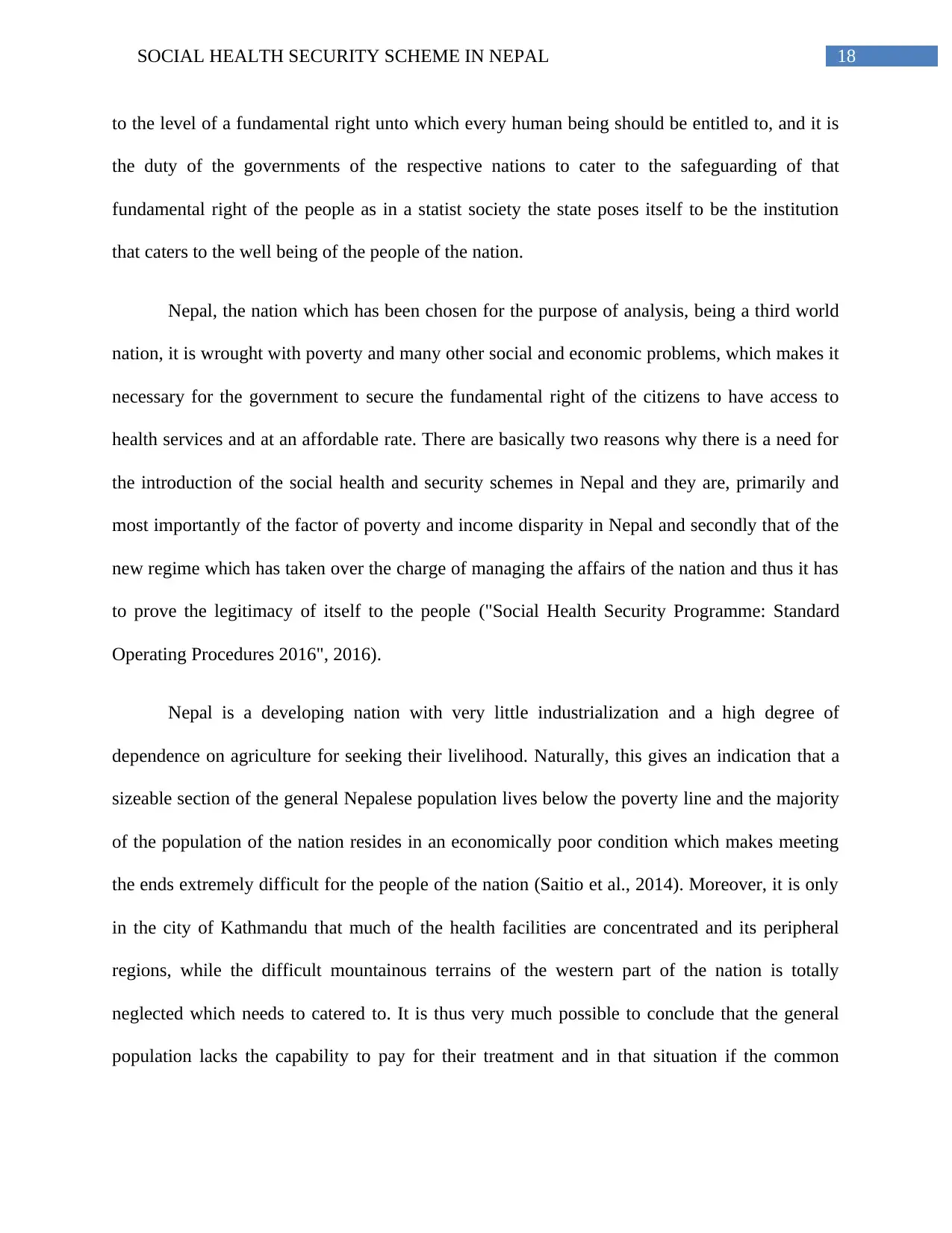
18SOCIAL HEALTH SECURITY SCHEME IN NEPAL
to the level of a fundamental right unto which every human being should be entitled to, and it is
the duty of the governments of the respective nations to cater to the safeguarding of that
fundamental right of the people as in a statist society the state poses itself to be the institution
that caters to the well being of the people of the nation.
Nepal, the nation which has been chosen for the purpose of analysis, being a third world
nation, it is wrought with poverty and many other social and economic problems, which makes it
necessary for the government to secure the fundamental right of the citizens to have access to
health services and at an affordable rate. There are basically two reasons why there is a need for
the introduction of the social health and security schemes in Nepal and they are, primarily and
most importantly of the factor of poverty and income disparity in Nepal and secondly that of the
new regime which has taken over the charge of managing the affairs of the nation and thus it has
to prove the legitimacy of itself to the people ("Social Health Security Programme: Standard
Operating Procedures 2016", 2016).
Nepal is a developing nation with very little industrialization and a high degree of
dependence on agriculture for seeking their livelihood. Naturally, this gives an indication that a
sizeable section of the general Nepalese population lives below the poverty line and the majority
of the population of the nation resides in an economically poor condition which makes meeting
the ends extremely difficult for the people of the nation (Saitio et al., 2014). Moreover, it is only
in the city of Kathmandu that much of the health facilities are concentrated and its peripheral
regions, while the difficult mountainous terrains of the western part of the nation is totally
neglected which needs to catered to. It is thus very much possible to conclude that the general
population lacks the capability to pay for their treatment and in that situation if the common
to the level of a fundamental right unto which every human being should be entitled to, and it is
the duty of the governments of the respective nations to cater to the safeguarding of that
fundamental right of the people as in a statist society the state poses itself to be the institution
that caters to the well being of the people of the nation.
Nepal, the nation which has been chosen for the purpose of analysis, being a third world
nation, it is wrought with poverty and many other social and economic problems, which makes it
necessary for the government to secure the fundamental right of the citizens to have access to
health services and at an affordable rate. There are basically two reasons why there is a need for
the introduction of the social health and security schemes in Nepal and they are, primarily and
most importantly of the factor of poverty and income disparity in Nepal and secondly that of the
new regime which has taken over the charge of managing the affairs of the nation and thus it has
to prove the legitimacy of itself to the people ("Social Health Security Programme: Standard
Operating Procedures 2016", 2016).
Nepal is a developing nation with very little industrialization and a high degree of
dependence on agriculture for seeking their livelihood. Naturally, this gives an indication that a
sizeable section of the general Nepalese population lives below the poverty line and the majority
of the population of the nation resides in an economically poor condition which makes meeting
the ends extremely difficult for the people of the nation (Saitio et al., 2014). Moreover, it is only
in the city of Kathmandu that much of the health facilities are concentrated and its peripheral
regions, while the difficult mountainous terrains of the western part of the nation is totally
neglected which needs to catered to. It is thus very much possible to conclude that the general
population lacks the capability to pay for their treatment and in that situation if the common
Paraphrase This Document
Need a fresh take? Get an instant paraphrase of this document with our AI Paraphraser
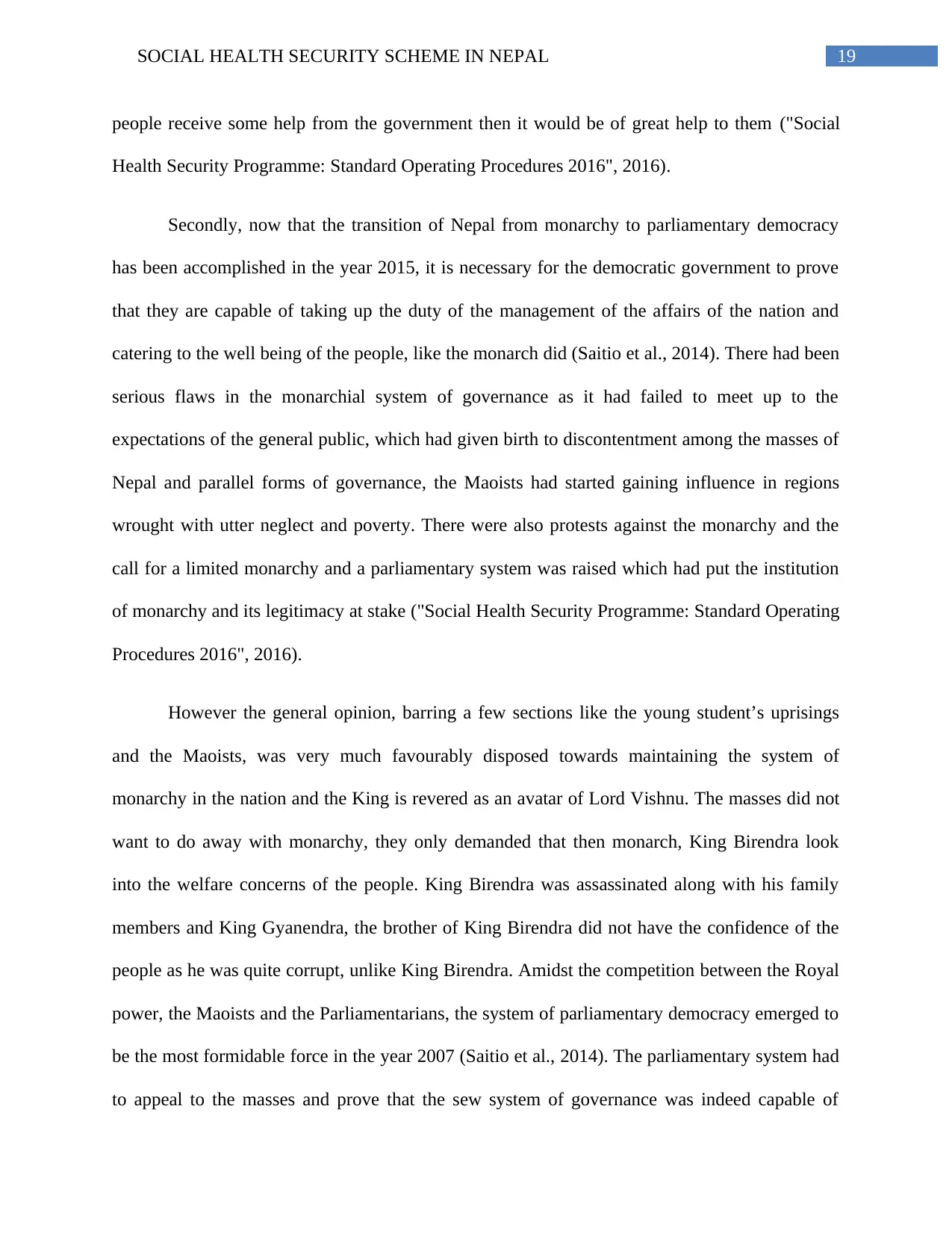
19SOCIAL HEALTH SECURITY SCHEME IN NEPAL
people receive some help from the government then it would be of great help to them ("Social
Health Security Programme: Standard Operating Procedures 2016", 2016).
Secondly, now that the transition of Nepal from monarchy to parliamentary democracy
has been accomplished in the year 2015, it is necessary for the democratic government to prove
that they are capable of taking up the duty of the management of the affairs of the nation and
catering to the well being of the people, like the monarch did (Saitio et al., 2014). There had been
serious flaws in the monarchial system of governance as it had failed to meet up to the
expectations of the general public, which had given birth to discontentment among the masses of
Nepal and parallel forms of governance, the Maoists had started gaining influence in regions
wrought with utter neglect and poverty. There were also protests against the monarchy and the
call for a limited monarchy and a parliamentary system was raised which had put the institution
of monarchy and its legitimacy at stake ("Social Health Security Programme: Standard Operating
Procedures 2016", 2016).
However the general opinion, barring a few sections like the young student’s uprisings
and the Maoists, was very much favourably disposed towards maintaining the system of
monarchy in the nation and the King is revered as an avatar of Lord Vishnu. The masses did not
want to do away with monarchy, they only demanded that then monarch, King Birendra look
into the welfare concerns of the people. King Birendra was assassinated along with his family
members and King Gyanendra, the brother of King Birendra did not have the confidence of the
people as he was quite corrupt, unlike King Birendra. Amidst the competition between the Royal
power, the Maoists and the Parliamentarians, the system of parliamentary democracy emerged to
be the most formidable force in the year 2007 (Saitio et al., 2014). The parliamentary system had
to appeal to the masses and prove that the sew system of governance was indeed capable of
people receive some help from the government then it would be of great help to them ("Social
Health Security Programme: Standard Operating Procedures 2016", 2016).
Secondly, now that the transition of Nepal from monarchy to parliamentary democracy
has been accomplished in the year 2015, it is necessary for the democratic government to prove
that they are capable of taking up the duty of the management of the affairs of the nation and
catering to the well being of the people, like the monarch did (Saitio et al., 2014). There had been
serious flaws in the monarchial system of governance as it had failed to meet up to the
expectations of the general public, which had given birth to discontentment among the masses of
Nepal and parallel forms of governance, the Maoists had started gaining influence in regions
wrought with utter neglect and poverty. There were also protests against the monarchy and the
call for a limited monarchy and a parliamentary system was raised which had put the institution
of monarchy and its legitimacy at stake ("Social Health Security Programme: Standard Operating
Procedures 2016", 2016).
However the general opinion, barring a few sections like the young student’s uprisings
and the Maoists, was very much favourably disposed towards maintaining the system of
monarchy in the nation and the King is revered as an avatar of Lord Vishnu. The masses did not
want to do away with monarchy, they only demanded that then monarch, King Birendra look
into the welfare concerns of the people. King Birendra was assassinated along with his family
members and King Gyanendra, the brother of King Birendra did not have the confidence of the
people as he was quite corrupt, unlike King Birendra. Amidst the competition between the Royal
power, the Maoists and the Parliamentarians, the system of parliamentary democracy emerged to
be the most formidable force in the year 2007 (Saitio et al., 2014). The parliamentary system had
to appeal to the masses and prove that the sew system of governance was indeed capable of
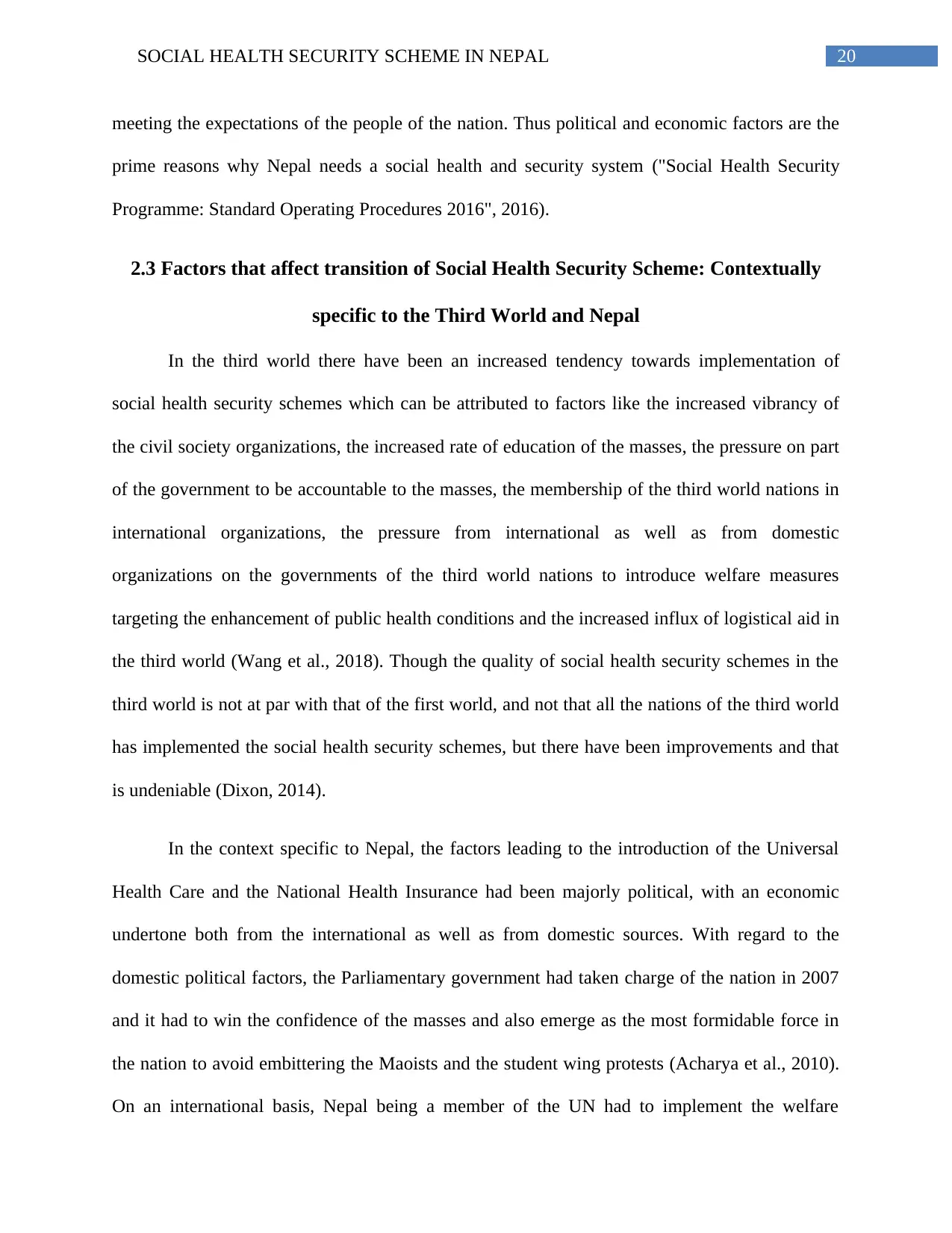
20SOCIAL HEALTH SECURITY SCHEME IN NEPAL
meeting the expectations of the people of the nation. Thus political and economic factors are the
prime reasons why Nepal needs a social health and security system ("Social Health Security
Programme: Standard Operating Procedures 2016", 2016).
2.3 Factors that affect transition of Social Health Security Scheme: Contextually
specific to the Third World and Nepal
In the third world there have been an increased tendency towards implementation of
social health security schemes which can be attributed to factors like the increased vibrancy of
the civil society organizations, the increased rate of education of the masses, the pressure on part
of the government to be accountable to the masses, the membership of the third world nations in
international organizations, the pressure from international as well as from domestic
organizations on the governments of the third world nations to introduce welfare measures
targeting the enhancement of public health conditions and the increased influx of logistical aid in
the third world (Wang et al., 2018). Though the quality of social health security schemes in the
third world is not at par with that of the first world, and not that all the nations of the third world
has implemented the social health security schemes, but there have been improvements and that
is undeniable (Dixon, 2014).
In the context specific to Nepal, the factors leading to the introduction of the Universal
Health Care and the National Health Insurance had been majorly political, with an economic
undertone both from the international as well as from domestic sources. With regard to the
domestic political factors, the Parliamentary government had taken charge of the nation in 2007
and it had to win the confidence of the masses and also emerge as the most formidable force in
the nation to avoid embittering the Maoists and the student wing protests (Acharya et al., 2010).
On an international basis, Nepal being a member of the UN had to implement the welfare
meeting the expectations of the people of the nation. Thus political and economic factors are the
prime reasons why Nepal needs a social health and security system ("Social Health Security
Programme: Standard Operating Procedures 2016", 2016).
2.3 Factors that affect transition of Social Health Security Scheme: Contextually
specific to the Third World and Nepal
In the third world there have been an increased tendency towards implementation of
social health security schemes which can be attributed to factors like the increased vibrancy of
the civil society organizations, the increased rate of education of the masses, the pressure on part
of the government to be accountable to the masses, the membership of the third world nations in
international organizations, the pressure from international as well as from domestic
organizations on the governments of the third world nations to introduce welfare measures
targeting the enhancement of public health conditions and the increased influx of logistical aid in
the third world (Wang et al., 2018). Though the quality of social health security schemes in the
third world is not at par with that of the first world, and not that all the nations of the third world
has implemented the social health security schemes, but there have been improvements and that
is undeniable (Dixon, 2014).
In the context specific to Nepal, the factors leading to the introduction of the Universal
Health Care and the National Health Insurance had been majorly political, with an economic
undertone both from the international as well as from domestic sources. With regard to the
domestic political factors, the Parliamentary government had taken charge of the nation in 2007
and it had to win the confidence of the masses and also emerge as the most formidable force in
the nation to avoid embittering the Maoists and the student wing protests (Acharya et al., 2010).
On an international basis, Nepal being a member of the UN had to implement the welfare
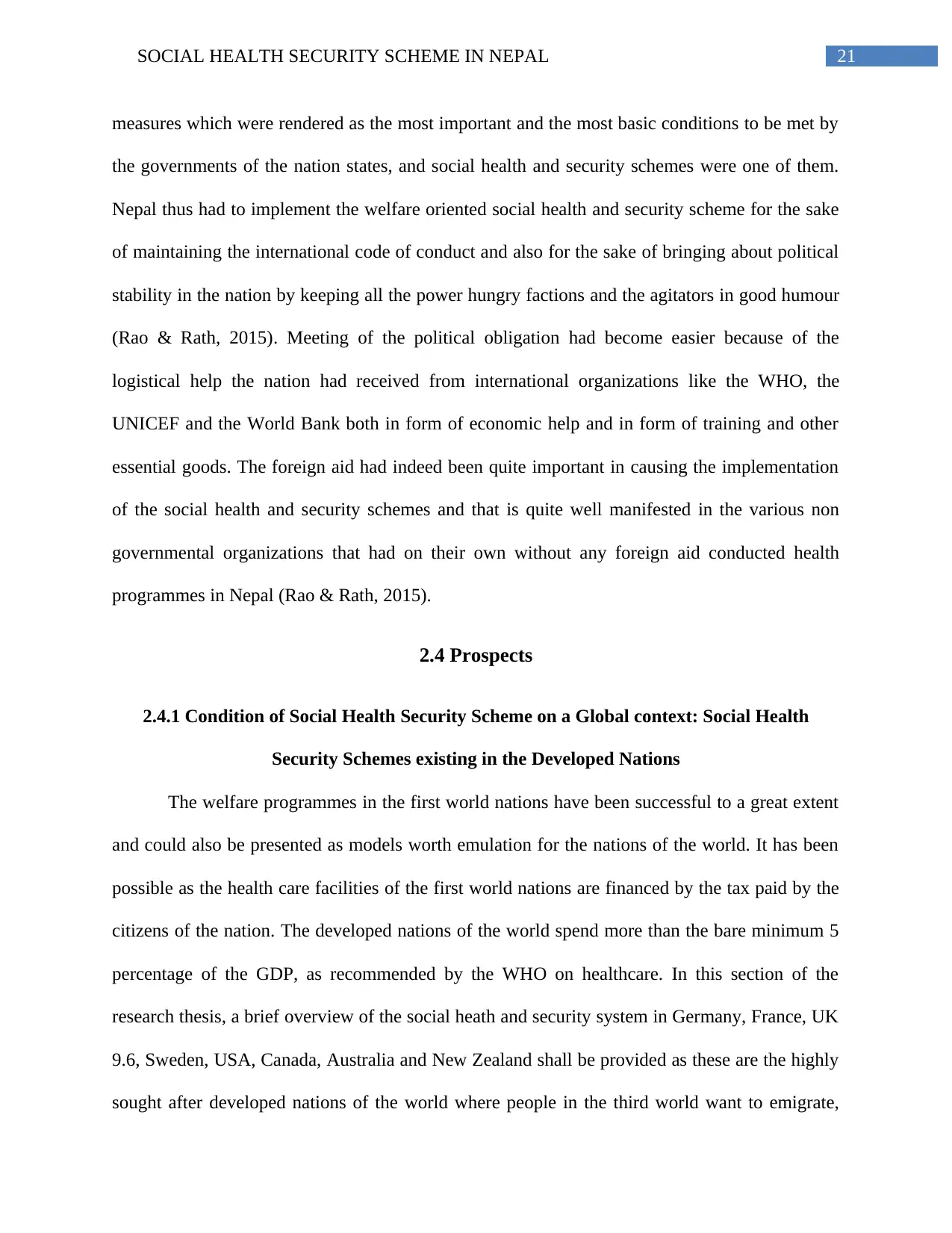
21SOCIAL HEALTH SECURITY SCHEME IN NEPAL
measures which were rendered as the most important and the most basic conditions to be met by
the governments of the nation states, and social health and security schemes were one of them.
Nepal thus had to implement the welfare oriented social health and security scheme for the sake
of maintaining the international code of conduct and also for the sake of bringing about political
stability in the nation by keeping all the power hungry factions and the agitators in good humour
(Rao & Rath, 2015). Meeting of the political obligation had become easier because of the
logistical help the nation had received from international organizations like the WHO, the
UNICEF and the World Bank both in form of economic help and in form of training and other
essential goods. The foreign aid had indeed been quite important in causing the implementation
of the social health and security schemes and that is quite well manifested in the various non
governmental organizations that had on their own without any foreign aid conducted health
programmes in Nepal (Rao & Rath, 2015).
2.4 Prospects
2.4.1 Condition of Social Health Security Scheme on a Global context: Social Health
Security Schemes existing in the Developed Nations
The welfare programmes in the first world nations have been successful to a great extent
and could also be presented as models worth emulation for the nations of the world. It has been
possible as the health care facilities of the first world nations are financed by the tax paid by the
citizens of the nation. The developed nations of the world spend more than the bare minimum 5
percentage of the GDP, as recommended by the WHO on healthcare. In this section of the
research thesis, a brief overview of the social heath and security system in Germany, France, UK
9.6, Sweden, USA, Canada, Australia and New Zealand shall be provided as these are the highly
sought after developed nations of the world where people in the third world want to emigrate,
measures which were rendered as the most important and the most basic conditions to be met by
the governments of the nation states, and social health and security schemes were one of them.
Nepal thus had to implement the welfare oriented social health and security scheme for the sake
of maintaining the international code of conduct and also for the sake of bringing about political
stability in the nation by keeping all the power hungry factions and the agitators in good humour
(Rao & Rath, 2015). Meeting of the political obligation had become easier because of the
logistical help the nation had received from international organizations like the WHO, the
UNICEF and the World Bank both in form of economic help and in form of training and other
essential goods. The foreign aid had indeed been quite important in causing the implementation
of the social health and security schemes and that is quite well manifested in the various non
governmental organizations that had on their own without any foreign aid conducted health
programmes in Nepal (Rao & Rath, 2015).
2.4 Prospects
2.4.1 Condition of Social Health Security Scheme on a Global context: Social Health
Security Schemes existing in the Developed Nations
The welfare programmes in the first world nations have been successful to a great extent
and could also be presented as models worth emulation for the nations of the world. It has been
possible as the health care facilities of the first world nations are financed by the tax paid by the
citizens of the nation. The developed nations of the world spend more than the bare minimum 5
percentage of the GDP, as recommended by the WHO on healthcare. In this section of the
research thesis, a brief overview of the social heath and security system in Germany, France, UK
9.6, Sweden, USA, Canada, Australia and New Zealand shall be provided as these are the highly
sought after developed nations of the world where people in the third world want to emigrate,
Secure Best Marks with AI Grader
Need help grading? Try our AI Grader for instant feedback on your assignments.
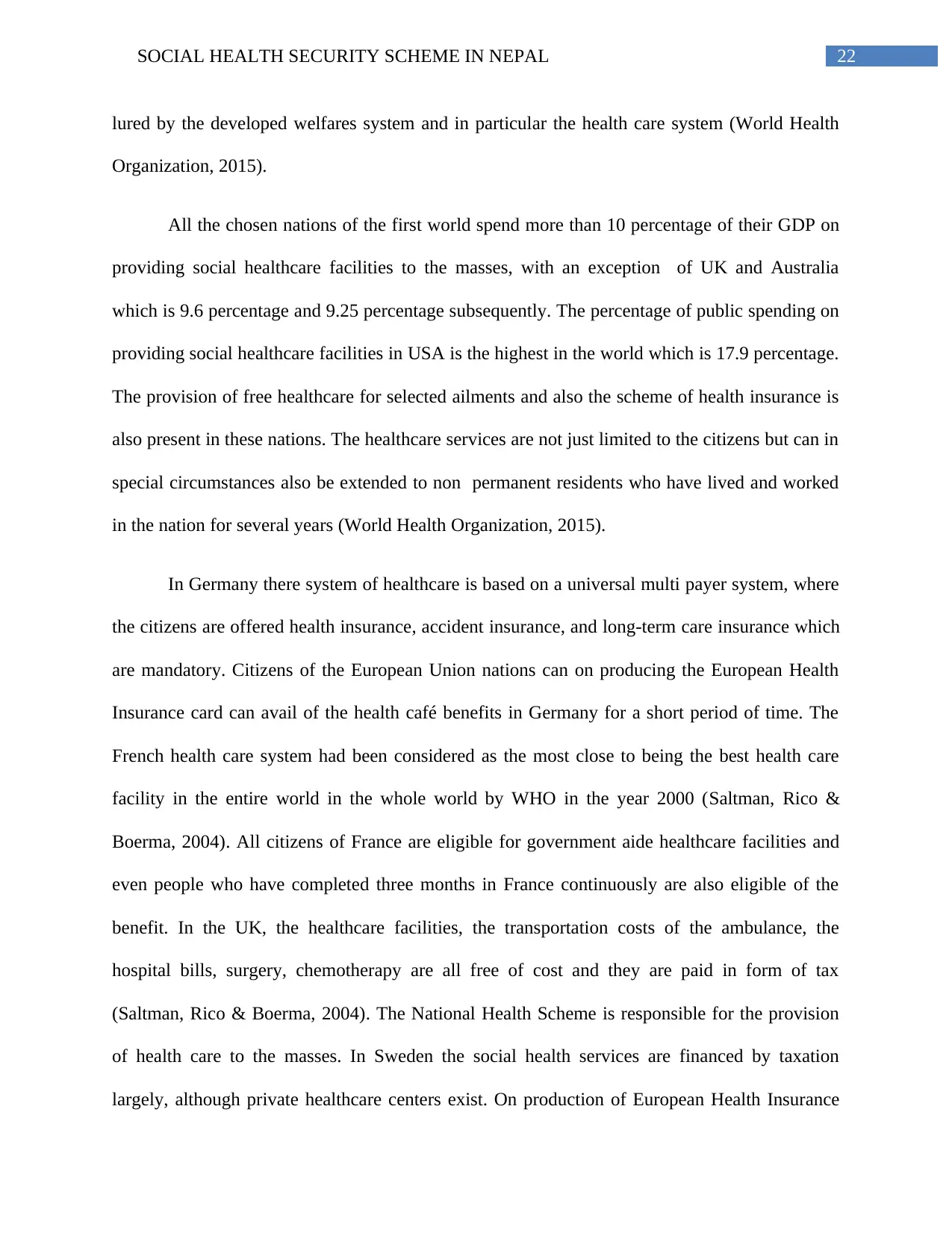
22SOCIAL HEALTH SECURITY SCHEME IN NEPAL
lured by the developed welfares system and in particular the health care system (World Health
Organization, 2015).
All the chosen nations of the first world spend more than 10 percentage of their GDP on
providing social healthcare facilities to the masses, with an exception of UK and Australia
which is 9.6 percentage and 9.25 percentage subsequently. The percentage of public spending on
providing social healthcare facilities in USA is the highest in the world which is 17.9 percentage.
The provision of free healthcare for selected ailments and also the scheme of health insurance is
also present in these nations. The healthcare services are not just limited to the citizens but can in
special circumstances also be extended to non permanent residents who have lived and worked
in the nation for several years (World Health Organization, 2015).
In Germany there system of healthcare is based on a universal multi payer system, where
the citizens are offered health insurance, accident insurance, and long-term care insurance which
are mandatory. Citizens of the European Union nations can on producing the European Health
Insurance card can avail of the health café benefits in Germany for a short period of time. The
French health care system had been considered as the most close to being the best health care
facility in the entire world in the whole world by WHO in the year 2000 (Saltman, Rico &
Boerma, 2004). All citizens of France are eligible for government aide healthcare facilities and
even people who have completed three months in France continuously are also eligible of the
benefit. In the UK, the healthcare facilities, the transportation costs of the ambulance, the
hospital bills, surgery, chemotherapy are all free of cost and they are paid in form of tax
(Saltman, Rico & Boerma, 2004). The National Health Scheme is responsible for the provision
of health care to the masses. In Sweden the social health services are financed by taxation
largely, although private healthcare centers exist. On production of European Health Insurance
lured by the developed welfares system and in particular the health care system (World Health
Organization, 2015).
All the chosen nations of the first world spend more than 10 percentage of their GDP on
providing social healthcare facilities to the masses, with an exception of UK and Australia
which is 9.6 percentage and 9.25 percentage subsequently. The percentage of public spending on
providing social healthcare facilities in USA is the highest in the world which is 17.9 percentage.
The provision of free healthcare for selected ailments and also the scheme of health insurance is
also present in these nations. The healthcare services are not just limited to the citizens but can in
special circumstances also be extended to non permanent residents who have lived and worked
in the nation for several years (World Health Organization, 2015).
In Germany there system of healthcare is based on a universal multi payer system, where
the citizens are offered health insurance, accident insurance, and long-term care insurance which
are mandatory. Citizens of the European Union nations can on producing the European Health
Insurance card can avail of the health café benefits in Germany for a short period of time. The
French health care system had been considered as the most close to being the best health care
facility in the entire world in the whole world by WHO in the year 2000 (Saltman, Rico &
Boerma, 2004). All citizens of France are eligible for government aide healthcare facilities and
even people who have completed three months in France continuously are also eligible of the
benefit. In the UK, the healthcare facilities, the transportation costs of the ambulance, the
hospital bills, surgery, chemotherapy are all free of cost and they are paid in form of tax
(Saltman, Rico & Boerma, 2004). The National Health Scheme is responsible for the provision
of health care to the masses. In Sweden the social health services are financed by taxation
largely, although private healthcare centers exist. On production of European Health Insurance
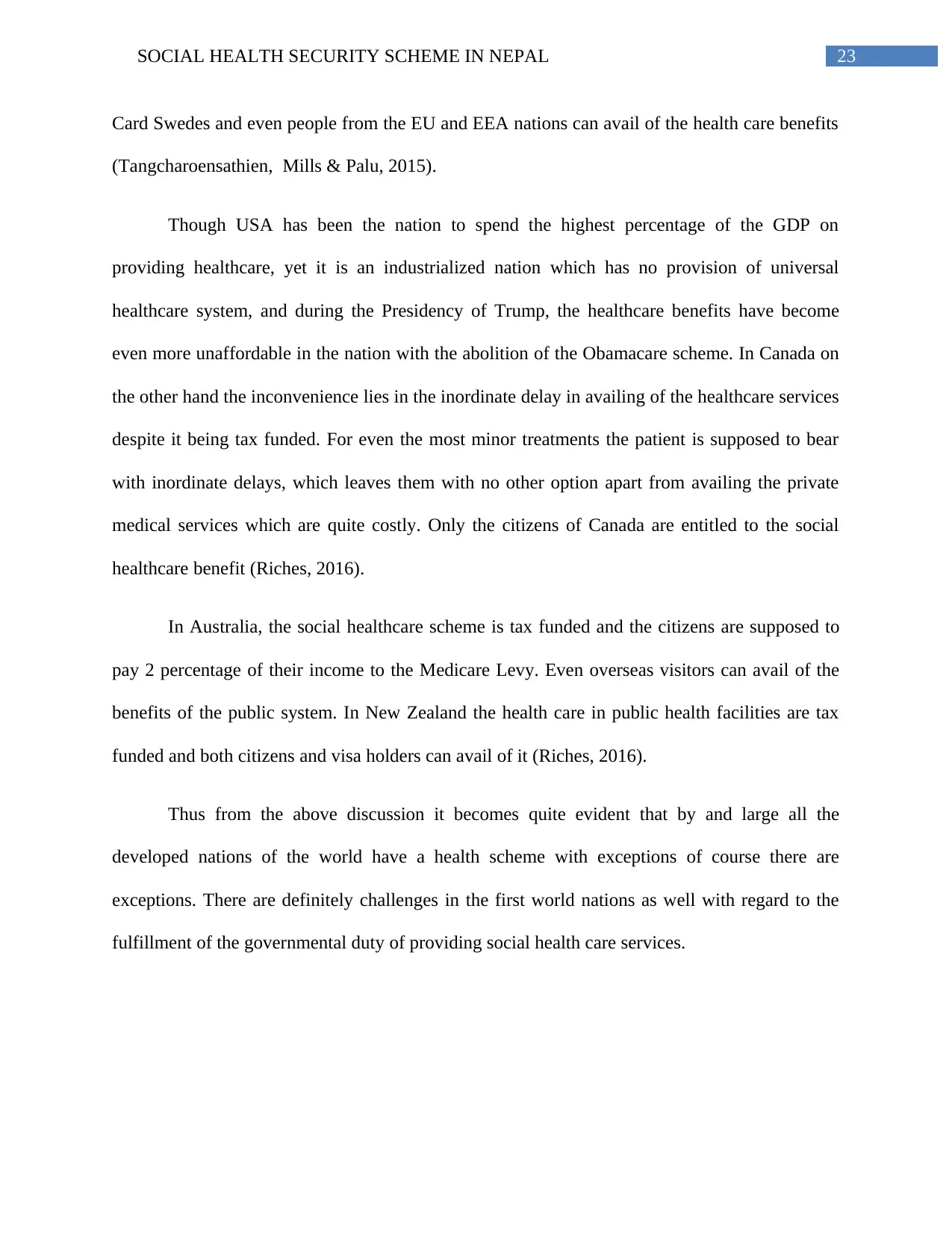
23SOCIAL HEALTH SECURITY SCHEME IN NEPAL
Card Swedes and even people from the EU and EEA nations can avail of the health care benefits
(Tangcharoensathien, Mills & Palu, 2015).
Though USA has been the nation to spend the highest percentage of the GDP on
providing healthcare, yet it is an industrialized nation which has no provision of universal
healthcare system, and during the Presidency of Trump, the healthcare benefits have become
even more unaffordable in the nation with the abolition of the Obamacare scheme. In Canada on
the other hand the inconvenience lies in the inordinate delay in availing of the healthcare services
despite it being tax funded. For even the most minor treatments the patient is supposed to bear
with inordinate delays, which leaves them with no other option apart from availing the private
medical services which are quite costly. Only the citizens of Canada are entitled to the social
healthcare benefit (Riches, 2016).
In Australia, the social healthcare scheme is tax funded and the citizens are supposed to
pay 2 percentage of their income to the Medicare Levy. Even overseas visitors can avail of the
benefits of the public system. In New Zealand the health care in public health facilities are tax
funded and both citizens and visa holders can avail of it (Riches, 2016).
Thus from the above discussion it becomes quite evident that by and large all the
developed nations of the world have a health scheme with exceptions of course there are
exceptions. There are definitely challenges in the first world nations as well with regard to the
fulfillment of the governmental duty of providing social health care services.
Card Swedes and even people from the EU and EEA nations can avail of the health care benefits
(Tangcharoensathien, Mills & Palu, 2015).
Though USA has been the nation to spend the highest percentage of the GDP on
providing healthcare, yet it is an industrialized nation which has no provision of universal
healthcare system, and during the Presidency of Trump, the healthcare benefits have become
even more unaffordable in the nation with the abolition of the Obamacare scheme. In Canada on
the other hand the inconvenience lies in the inordinate delay in availing of the healthcare services
despite it being tax funded. For even the most minor treatments the patient is supposed to bear
with inordinate delays, which leaves them with no other option apart from availing the private
medical services which are quite costly. Only the citizens of Canada are entitled to the social
healthcare benefit (Riches, 2016).
In Australia, the social healthcare scheme is tax funded and the citizens are supposed to
pay 2 percentage of their income to the Medicare Levy. Even overseas visitors can avail of the
benefits of the public system. In New Zealand the health care in public health facilities are tax
funded and both citizens and visa holders can avail of it (Riches, 2016).
Thus from the above discussion it becomes quite evident that by and large all the
developed nations of the world have a health scheme with exceptions of course there are
exceptions. There are definitely challenges in the first world nations as well with regard to the
fulfillment of the governmental duty of providing social health care services.
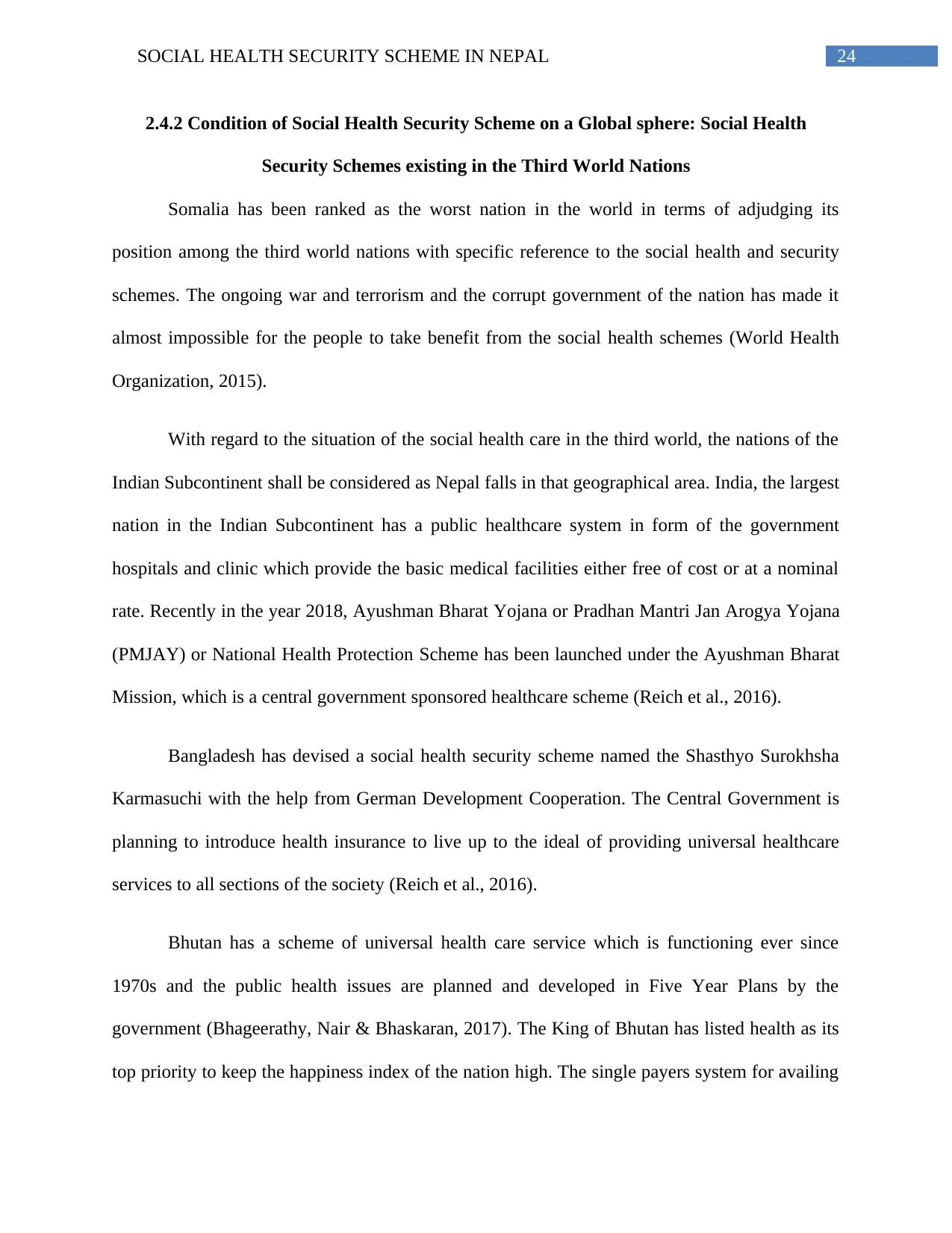
24SOCIAL HEALTH SECURITY SCHEME IN NEPAL
2.4.2 Condition of Social Health Security Scheme on a Global sphere: Social Health
Security Schemes existing in the Third World Nations
Somalia has been ranked as the worst nation in the world in terms of adjudging its
position among the third world nations with specific reference to the social health and security
schemes. The ongoing war and terrorism and the corrupt government of the nation has made it
almost impossible for the people to take benefit from the social health schemes (World Health
Organization, 2015).
With regard to the situation of the social health care in the third world, the nations of the
Indian Subcontinent shall be considered as Nepal falls in that geographical area. India, the largest
nation in the Indian Subcontinent has a public healthcare system in form of the government
hospitals and clinic which provide the basic medical facilities either free of cost or at a nominal
rate. Recently in the year 2018, Ayushman Bharat Yojana or Pradhan Mantri Jan Arogya Yojana
(PMJAY) or National Health Protection Scheme has been launched under the Ayushman Bharat
Mission, which is a central government sponsored healthcare scheme (Reich et al., 2016).
Bangladesh has devised a social health security scheme named the Shasthyo Surokhsha
Karmasuchi with the help from German Development Cooperation. The Central Government is
planning to introduce health insurance to live up to the ideal of providing universal healthcare
services to all sections of the society (Reich et al., 2016).
Bhutan has a scheme of universal health care service which is functioning ever since
1970s and the public health issues are planned and developed in Five Year Plans by the
government (Bhageerathy, Nair & Bhaskaran, 2017). The King of Bhutan has listed health as its
top priority to keep the happiness index of the nation high. The single payers system for availing
2.4.2 Condition of Social Health Security Scheme on a Global sphere: Social Health
Security Schemes existing in the Third World Nations
Somalia has been ranked as the worst nation in the world in terms of adjudging its
position among the third world nations with specific reference to the social health and security
schemes. The ongoing war and terrorism and the corrupt government of the nation has made it
almost impossible for the people to take benefit from the social health schemes (World Health
Organization, 2015).
With regard to the situation of the social health care in the third world, the nations of the
Indian Subcontinent shall be considered as Nepal falls in that geographical area. India, the largest
nation in the Indian Subcontinent has a public healthcare system in form of the government
hospitals and clinic which provide the basic medical facilities either free of cost or at a nominal
rate. Recently in the year 2018, Ayushman Bharat Yojana or Pradhan Mantri Jan Arogya Yojana
(PMJAY) or National Health Protection Scheme has been launched under the Ayushman Bharat
Mission, which is a central government sponsored healthcare scheme (Reich et al., 2016).
Bangladesh has devised a social health security scheme named the Shasthyo Surokhsha
Karmasuchi with the help from German Development Cooperation. The Central Government is
planning to introduce health insurance to live up to the ideal of providing universal healthcare
services to all sections of the society (Reich et al., 2016).
Bhutan has a scheme of universal health care service which is functioning ever since
1970s and the public health issues are planned and developed in Five Year Plans by the
government (Bhageerathy, Nair & Bhaskaran, 2017). The King of Bhutan has listed health as its
top priority to keep the happiness index of the nation high. The single payers system for availing
Paraphrase This Document
Need a fresh take? Get an instant paraphrase of this document with our AI Paraphraser
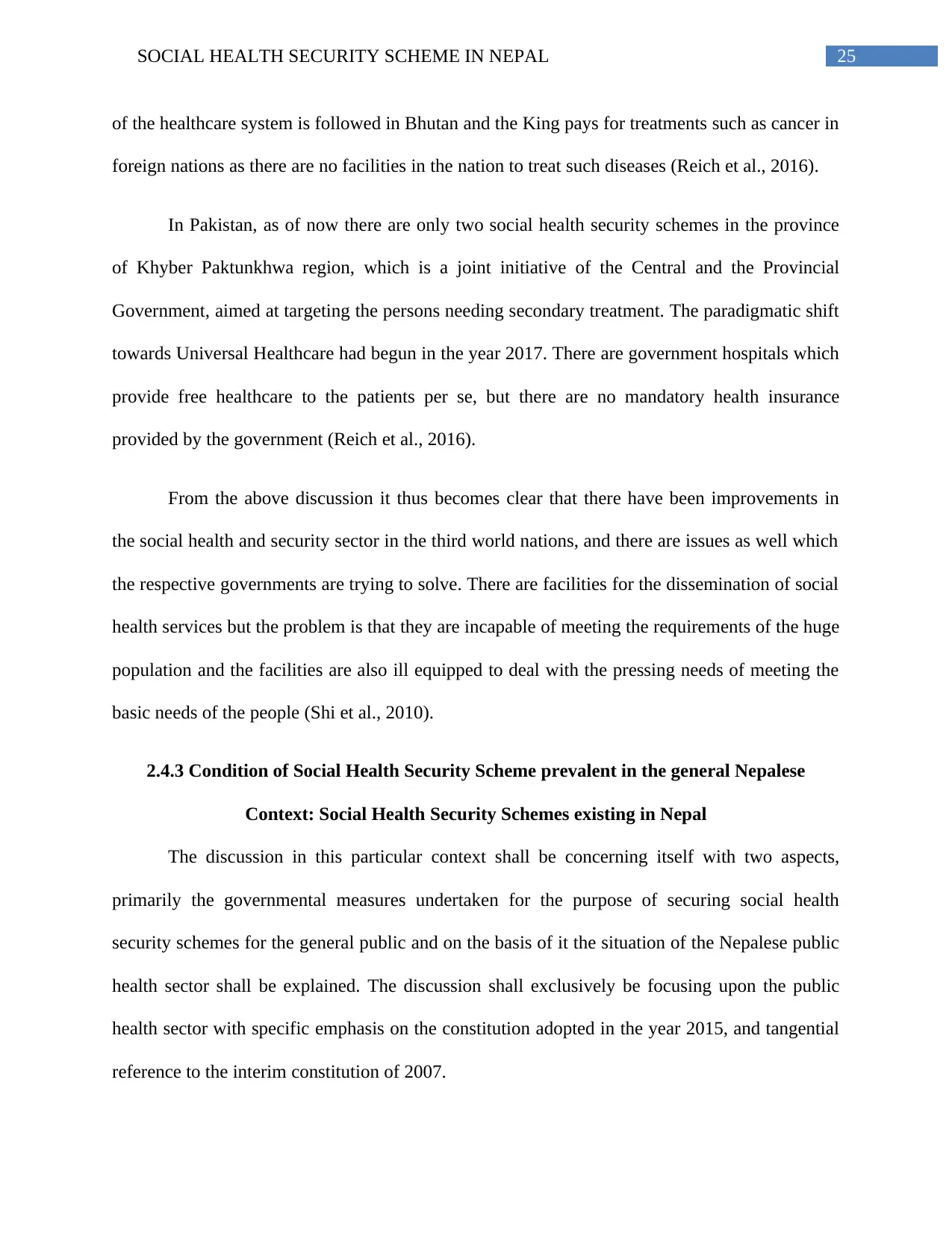
25SOCIAL HEALTH SECURITY SCHEME IN NEPAL
of the healthcare system is followed in Bhutan and the King pays for treatments such as cancer in
foreign nations as there are no facilities in the nation to treat such diseases (Reich et al., 2016).
In Pakistan, as of now there are only two social health security schemes in the province
of Khyber Paktunkhwa region, which is a joint initiative of the Central and the Provincial
Government, aimed at targeting the persons needing secondary treatment. The paradigmatic shift
towards Universal Healthcare had begun in the year 2017. There are government hospitals which
provide free healthcare to the patients per se, but there are no mandatory health insurance
provided by the government (Reich et al., 2016).
From the above discussion it thus becomes clear that there have been improvements in
the social health and security sector in the third world nations, and there are issues as well which
the respective governments are trying to solve. There are facilities for the dissemination of social
health services but the problem is that they are incapable of meeting the requirements of the huge
population and the facilities are also ill equipped to deal with the pressing needs of meeting the
basic needs of the people (Shi et al., 2010).
2.4.3 Condition of Social Health Security Scheme prevalent in the general Nepalese
Context: Social Health Security Schemes existing in Nepal
The discussion in this particular context shall be concerning itself with two aspects,
primarily the governmental measures undertaken for the purpose of securing social health
security schemes for the general public and on the basis of it the situation of the Nepalese public
health sector shall be explained. The discussion shall exclusively be focusing upon the public
health sector with specific emphasis on the constitution adopted in the year 2015, and tangential
reference to the interim constitution of 2007.
of the healthcare system is followed in Bhutan and the King pays for treatments such as cancer in
foreign nations as there are no facilities in the nation to treat such diseases (Reich et al., 2016).
In Pakistan, as of now there are only two social health security schemes in the province
of Khyber Paktunkhwa region, which is a joint initiative of the Central and the Provincial
Government, aimed at targeting the persons needing secondary treatment. The paradigmatic shift
towards Universal Healthcare had begun in the year 2017. There are government hospitals which
provide free healthcare to the patients per se, but there are no mandatory health insurance
provided by the government (Reich et al., 2016).
From the above discussion it thus becomes clear that there have been improvements in
the social health and security sector in the third world nations, and there are issues as well which
the respective governments are trying to solve. There are facilities for the dissemination of social
health services but the problem is that they are incapable of meeting the requirements of the huge
population and the facilities are also ill equipped to deal with the pressing needs of meeting the
basic needs of the people (Shi et al., 2010).
2.4.3 Condition of Social Health Security Scheme prevalent in the general Nepalese
Context: Social Health Security Schemes existing in Nepal
The discussion in this particular context shall be concerning itself with two aspects,
primarily the governmental measures undertaken for the purpose of securing social health
security schemes for the general public and on the basis of it the situation of the Nepalese public
health sector shall be explained. The discussion shall exclusively be focusing upon the public
health sector with specific emphasis on the constitution adopted in the year 2015, and tangential
reference to the interim constitution of 2007.
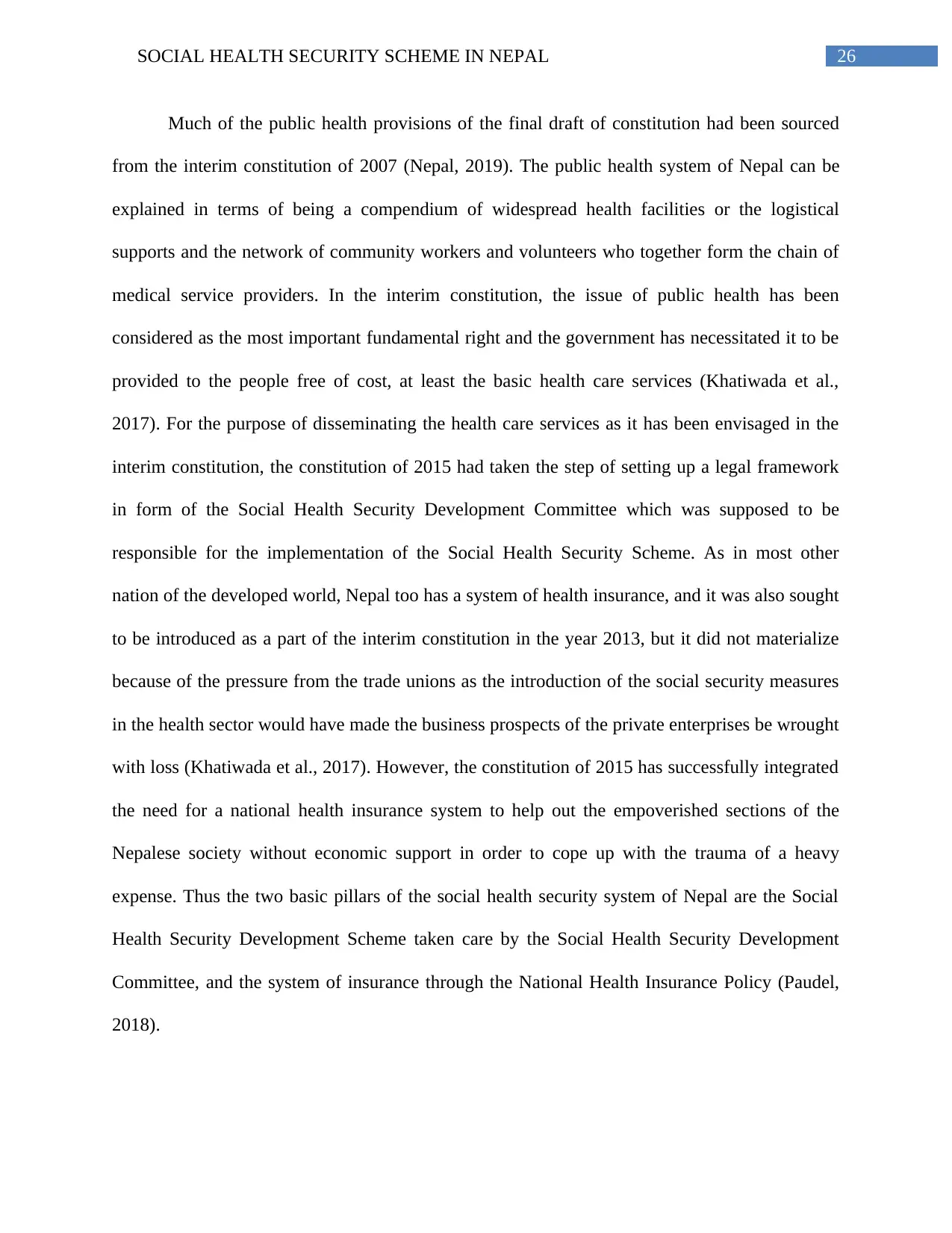
26SOCIAL HEALTH SECURITY SCHEME IN NEPAL
Much of the public health provisions of the final draft of constitution had been sourced
from the interim constitution of 2007 (Nepal, 2019). The public health system of Nepal can be
explained in terms of being a compendium of widespread health facilities or the logistical
supports and the network of community workers and volunteers who together form the chain of
medical service providers. In the interim constitution, the issue of public health has been
considered as the most important fundamental right and the government has necessitated it to be
provided to the people free of cost, at least the basic health care services (Khatiwada et al.,
2017). For the purpose of disseminating the health care services as it has been envisaged in the
interim constitution, the constitution of 2015 had taken the step of setting up a legal framework
in form of the Social Health Security Development Committee which was supposed to be
responsible for the implementation of the Social Health Security Scheme. As in most other
nation of the developed world, Nepal too has a system of health insurance, and it was also sought
to be introduced as a part of the interim constitution in the year 2013, but it did not materialize
because of the pressure from the trade unions as the introduction of the social security measures
in the health sector would have made the business prospects of the private enterprises be wrought
with loss (Khatiwada et al., 2017). However, the constitution of 2015 has successfully integrated
the need for a national health insurance system to help out the empoverished sections of the
Nepalese society without economic support in order to cope up with the trauma of a heavy
expense. Thus the two basic pillars of the social health security system of Nepal are the Social
Health Security Development Scheme taken care by the Social Health Security Development
Committee, and the system of insurance through the National Health Insurance Policy (Paudel,
2018).
Much of the public health provisions of the final draft of constitution had been sourced
from the interim constitution of 2007 (Nepal, 2019). The public health system of Nepal can be
explained in terms of being a compendium of widespread health facilities or the logistical
supports and the network of community workers and volunteers who together form the chain of
medical service providers. In the interim constitution, the issue of public health has been
considered as the most important fundamental right and the government has necessitated it to be
provided to the people free of cost, at least the basic health care services (Khatiwada et al.,
2017). For the purpose of disseminating the health care services as it has been envisaged in the
interim constitution, the constitution of 2015 had taken the step of setting up a legal framework
in form of the Social Health Security Development Committee which was supposed to be
responsible for the implementation of the Social Health Security Scheme. As in most other
nation of the developed world, Nepal too has a system of health insurance, and it was also sought
to be introduced as a part of the interim constitution in the year 2013, but it did not materialize
because of the pressure from the trade unions as the introduction of the social security measures
in the health sector would have made the business prospects of the private enterprises be wrought
with loss (Khatiwada et al., 2017). However, the constitution of 2015 has successfully integrated
the need for a national health insurance system to help out the empoverished sections of the
Nepalese society without economic support in order to cope up with the trauma of a heavy
expense. Thus the two basic pillars of the social health security system of Nepal are the Social
Health Security Development Scheme taken care by the Social Health Security Development
Committee, and the system of insurance through the National Health Insurance Policy (Paudel,
2018).
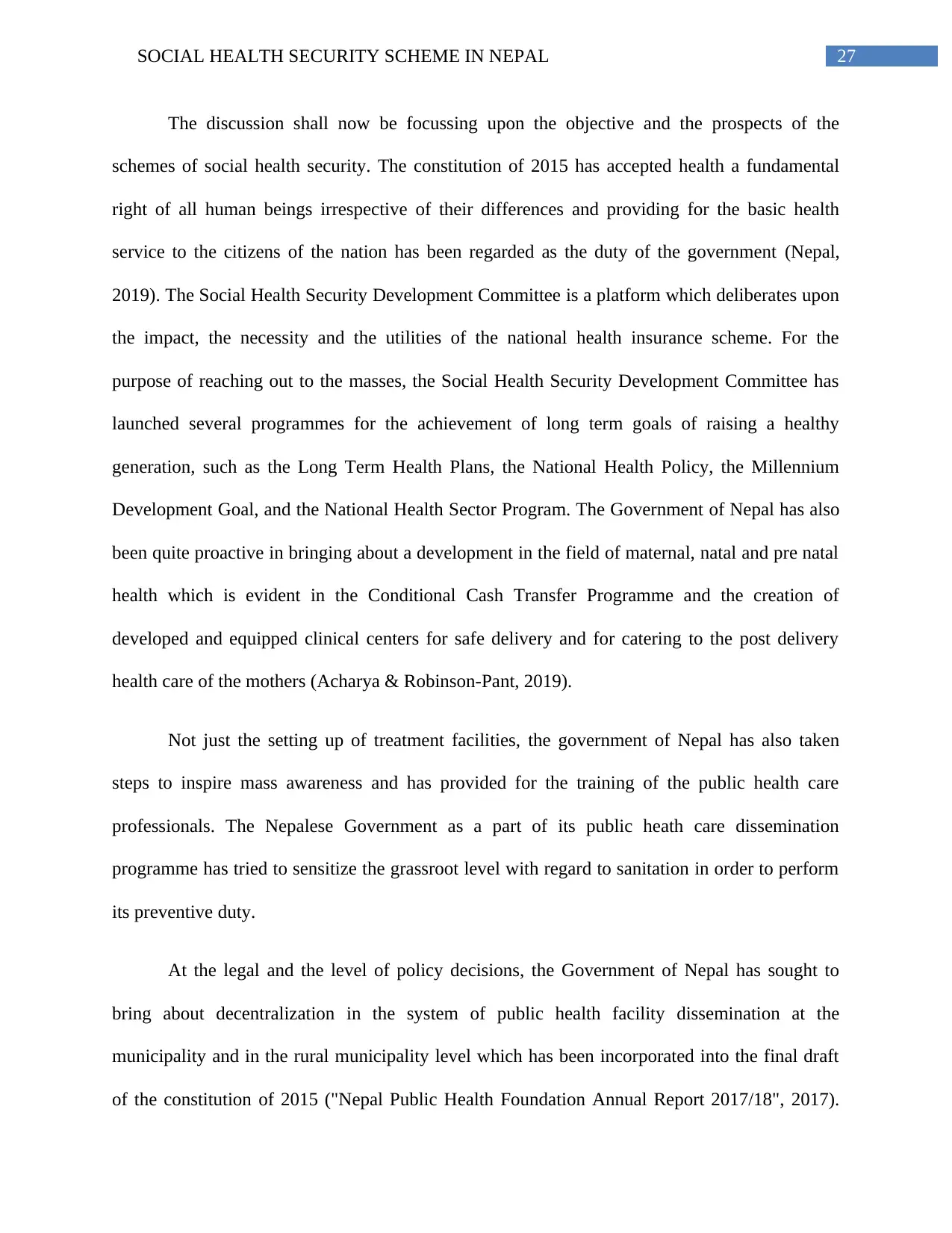
27SOCIAL HEALTH SECURITY SCHEME IN NEPAL
The discussion shall now be focussing upon the objective and the prospects of the
schemes of social health security. The constitution of 2015 has accepted health a fundamental
right of all human beings irrespective of their differences and providing for the basic health
service to the citizens of the nation has been regarded as the duty of the government (Nepal,
2019). The Social Health Security Development Committee is a platform which deliberates upon
the impact, the necessity and the utilities of the national health insurance scheme. For the
purpose of reaching out to the masses, the Social Health Security Development Committee has
launched several programmes for the achievement of long term goals of raising a healthy
generation, such as the Long Term Health Plans, the National Health Policy, the Millennium
Development Goal, and the National Health Sector Program. The Government of Nepal has also
been quite proactive in bringing about a development in the field of maternal, natal and pre natal
health which is evident in the Conditional Cash Transfer Programme and the creation of
developed and equipped clinical centers for safe delivery and for catering to the post delivery
health care of the mothers (Acharya & Robinson-Pant, 2019).
Not just the setting up of treatment facilities, the government of Nepal has also taken
steps to inspire mass awareness and has provided for the training of the public health care
professionals. The Nepalese Government as a part of its public heath care dissemination
programme has tried to sensitize the grassroot level with regard to sanitation in order to perform
its preventive duty.
At the legal and the level of policy decisions, the Government of Nepal has sought to
bring about decentralization in the system of public health facility dissemination at the
municipality and in the rural municipality level which has been incorporated into the final draft
of the constitution of 2015 ("Nepal Public Health Foundation Annual Report 2017/18", 2017).
The discussion shall now be focussing upon the objective and the prospects of the
schemes of social health security. The constitution of 2015 has accepted health a fundamental
right of all human beings irrespective of their differences and providing for the basic health
service to the citizens of the nation has been regarded as the duty of the government (Nepal,
2019). The Social Health Security Development Committee is a platform which deliberates upon
the impact, the necessity and the utilities of the national health insurance scheme. For the
purpose of reaching out to the masses, the Social Health Security Development Committee has
launched several programmes for the achievement of long term goals of raising a healthy
generation, such as the Long Term Health Plans, the National Health Policy, the Millennium
Development Goal, and the National Health Sector Program. The Government of Nepal has also
been quite proactive in bringing about a development in the field of maternal, natal and pre natal
health which is evident in the Conditional Cash Transfer Programme and the creation of
developed and equipped clinical centers for safe delivery and for catering to the post delivery
health care of the mothers (Acharya & Robinson-Pant, 2019).
Not just the setting up of treatment facilities, the government of Nepal has also taken
steps to inspire mass awareness and has provided for the training of the public health care
professionals. The Nepalese Government as a part of its public heath care dissemination
programme has tried to sensitize the grassroot level with regard to sanitation in order to perform
its preventive duty.
At the legal and the level of policy decisions, the Government of Nepal has sought to
bring about decentralization in the system of public health facility dissemination at the
municipality and in the rural municipality level which has been incorporated into the final draft
of the constitution of 2015 ("Nepal Public Health Foundation Annual Report 2017/18", 2017).
Secure Best Marks with AI Grader
Need help grading? Try our AI Grader for instant feedback on your assignments.
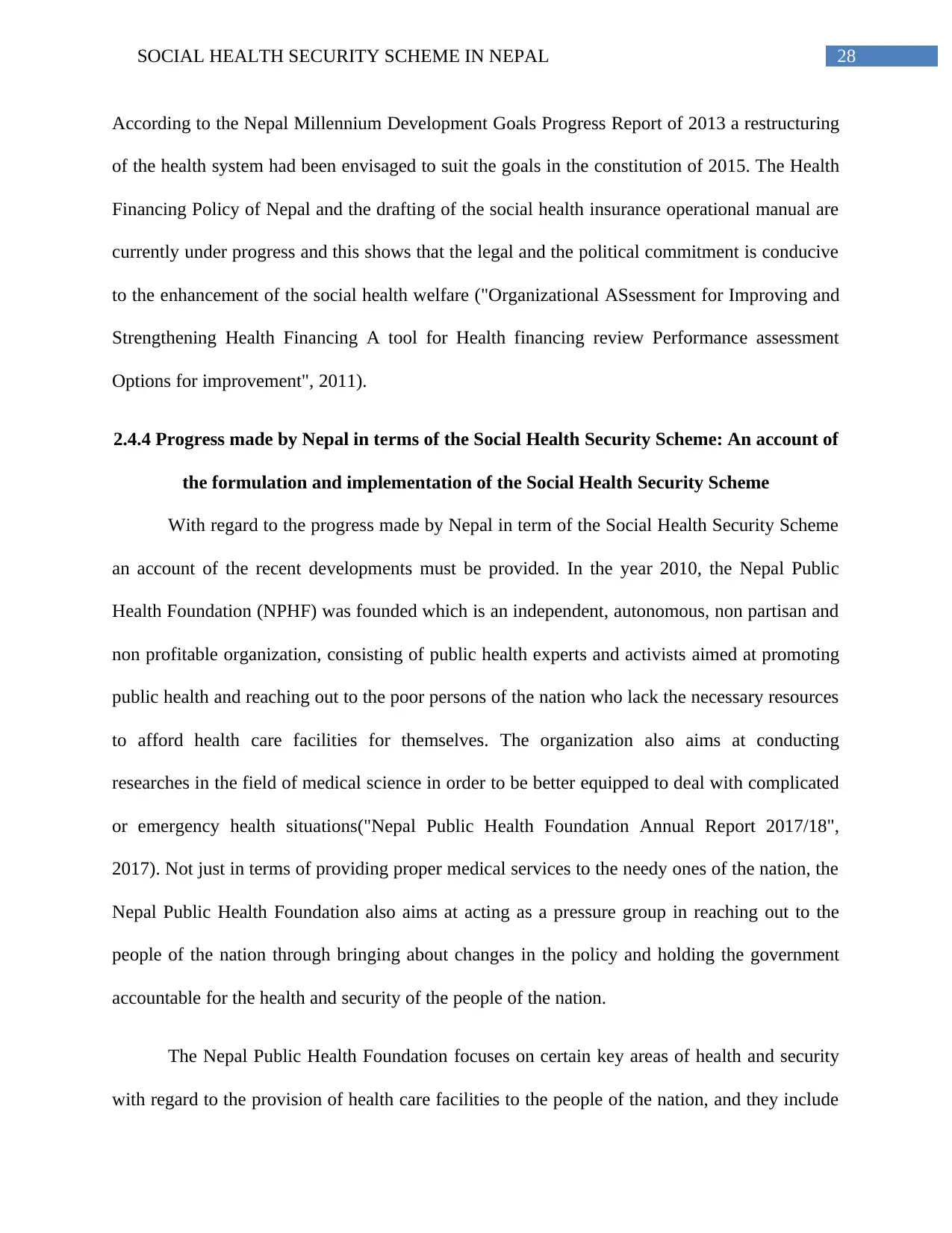
28SOCIAL HEALTH SECURITY SCHEME IN NEPAL
According to the Nepal Millennium Development Goals Progress Report of 2013 a restructuring
of the health system had been envisaged to suit the goals in the constitution of 2015. The Health
Financing Policy of Nepal and the drafting of the social health insurance operational manual are
currently under progress and this shows that the legal and the political commitment is conducive
to the enhancement of the social health welfare ("Organizational ASsessment for Improving and
Strengthening Health Financing A tool for Health financing review Performance assessment
Options for improvement", 2011).
2.4.4 Progress made by Nepal in terms of the Social Health Security Scheme: An account of
the formulation and implementation of the Social Health Security Scheme
With regard to the progress made by Nepal in term of the Social Health Security Scheme
an account of the recent developments must be provided. In the year 2010, the Nepal Public
Health Foundation (NPHF) was founded which is an independent, autonomous, non partisan and
non profitable organization, consisting of public health experts and activists aimed at promoting
public health and reaching out to the poor persons of the nation who lack the necessary resources
to afford health care facilities for themselves. The organization also aims at conducting
researches in the field of medical science in order to be better equipped to deal with complicated
or emergency health situations("Nepal Public Health Foundation Annual Report 2017/18",
2017). Not just in terms of providing proper medical services to the needy ones of the nation, the
Nepal Public Health Foundation also aims at acting as a pressure group in reaching out to the
people of the nation through bringing about changes in the policy and holding the government
accountable for the health and security of the people of the nation.
The Nepal Public Health Foundation focuses on certain key areas of health and security
with regard to the provision of health care facilities to the people of the nation, and they include
According to the Nepal Millennium Development Goals Progress Report of 2013 a restructuring
of the health system had been envisaged to suit the goals in the constitution of 2015. The Health
Financing Policy of Nepal and the drafting of the social health insurance operational manual are
currently under progress and this shows that the legal and the political commitment is conducive
to the enhancement of the social health welfare ("Organizational ASsessment for Improving and
Strengthening Health Financing A tool for Health financing review Performance assessment
Options for improvement", 2011).
2.4.4 Progress made by Nepal in terms of the Social Health Security Scheme: An account of
the formulation and implementation of the Social Health Security Scheme
With regard to the progress made by Nepal in term of the Social Health Security Scheme
an account of the recent developments must be provided. In the year 2010, the Nepal Public
Health Foundation (NPHF) was founded which is an independent, autonomous, non partisan and
non profitable organization, consisting of public health experts and activists aimed at promoting
public health and reaching out to the poor persons of the nation who lack the necessary resources
to afford health care facilities for themselves. The organization also aims at conducting
researches in the field of medical science in order to be better equipped to deal with complicated
or emergency health situations("Nepal Public Health Foundation Annual Report 2017/18",
2017). Not just in terms of providing proper medical services to the needy ones of the nation, the
Nepal Public Health Foundation also aims at acting as a pressure group in reaching out to the
people of the nation through bringing about changes in the policy and holding the government
accountable for the health and security of the people of the nation.
The Nepal Public Health Foundation focuses on certain key areas of health and security
with regard to the provision of health care facilities to the people of the nation, and they include
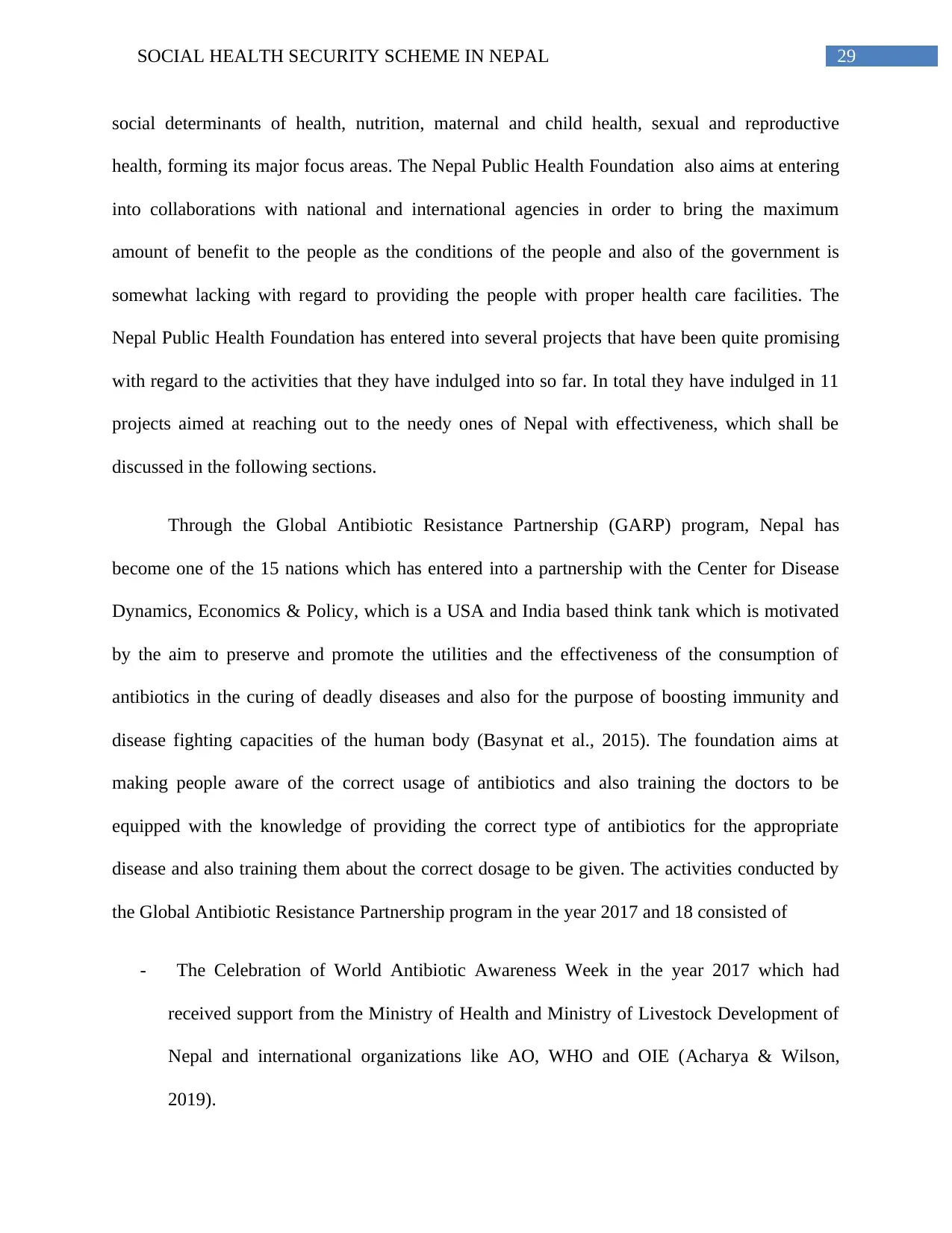
29SOCIAL HEALTH SECURITY SCHEME IN NEPAL
social determinants of health, nutrition, maternal and child health, sexual and reproductive
health, forming its major focus areas. The Nepal Public Health Foundation also aims at entering
into collaborations with national and international agencies in order to bring the maximum
amount of benefit to the people as the conditions of the people and also of the government is
somewhat lacking with regard to providing the people with proper health care facilities. The
Nepal Public Health Foundation has entered into several projects that have been quite promising
with regard to the activities that they have indulged into so far. In total they have indulged in 11
projects aimed at reaching out to the needy ones of Nepal with effectiveness, which shall be
discussed in the following sections.
Through the Global Antibiotic Resistance Partnership (GARP) program, Nepal has
become one of the 15 nations which has entered into a partnership with the Center for Disease
Dynamics, Economics & Policy, which is a USA and India based think tank which is motivated
by the aim to preserve and promote the utilities and the effectiveness of the consumption of
antibiotics in the curing of deadly diseases and also for the purpose of boosting immunity and
disease fighting capacities of the human body (Basynat et al., 2015). The foundation aims at
making people aware of the correct usage of antibiotics and also training the doctors to be
equipped with the knowledge of providing the correct type of antibiotics for the appropriate
disease and also training them about the correct dosage to be given. The activities conducted by
the Global Antibiotic Resistance Partnership program in the year 2017 and 18 consisted of
- The Celebration of World Antibiotic Awareness Week in the year 2017 which had
received support from the Ministry of Health and Ministry of Livestock Development of
Nepal and international organizations like AO, WHO and OIE (Acharya & Wilson,
2019).
social determinants of health, nutrition, maternal and child health, sexual and reproductive
health, forming its major focus areas. The Nepal Public Health Foundation also aims at entering
into collaborations with national and international agencies in order to bring the maximum
amount of benefit to the people as the conditions of the people and also of the government is
somewhat lacking with regard to providing the people with proper health care facilities. The
Nepal Public Health Foundation has entered into several projects that have been quite promising
with regard to the activities that they have indulged into so far. In total they have indulged in 11
projects aimed at reaching out to the needy ones of Nepal with effectiveness, which shall be
discussed in the following sections.
Through the Global Antibiotic Resistance Partnership (GARP) program, Nepal has
become one of the 15 nations which has entered into a partnership with the Center for Disease
Dynamics, Economics & Policy, which is a USA and India based think tank which is motivated
by the aim to preserve and promote the utilities and the effectiveness of the consumption of
antibiotics in the curing of deadly diseases and also for the purpose of boosting immunity and
disease fighting capacities of the human body (Basynat et al., 2015). The foundation aims at
making people aware of the correct usage of antibiotics and also training the doctors to be
equipped with the knowledge of providing the correct type of antibiotics for the appropriate
disease and also training them about the correct dosage to be given. The activities conducted by
the Global Antibiotic Resistance Partnership program in the year 2017 and 18 consisted of
- The Celebration of World Antibiotic Awareness Week in the year 2017 which had
received support from the Ministry of Health and Ministry of Livestock Development of
Nepal and international organizations like AO, WHO and OIE (Acharya & Wilson,
2019).
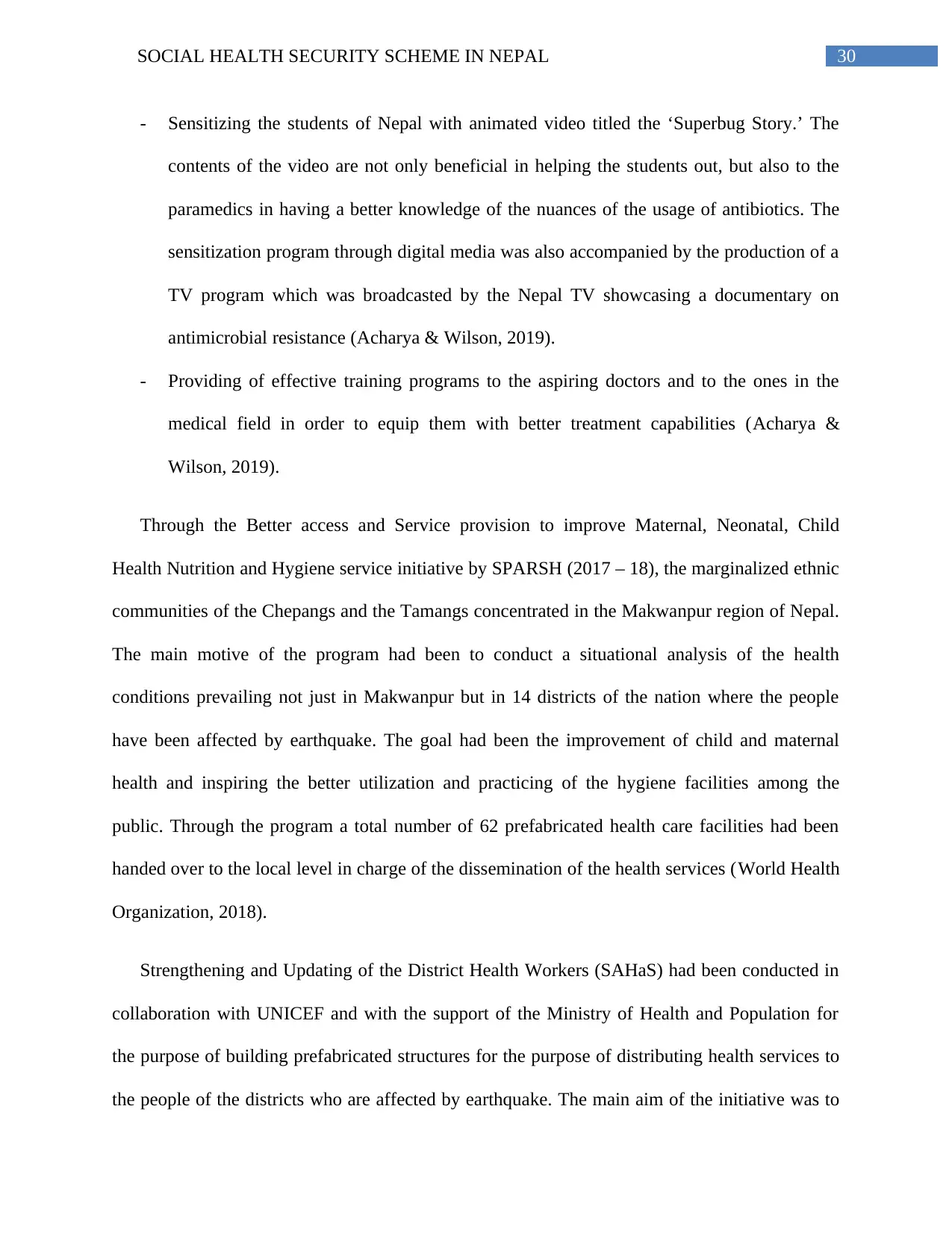
30SOCIAL HEALTH SECURITY SCHEME IN NEPAL
- Sensitizing the students of Nepal with animated video titled the ‘Superbug Story.’ The
contents of the video are not only beneficial in helping the students out, but also to the
paramedics in having a better knowledge of the nuances of the usage of antibiotics. The
sensitization program through digital media was also accompanied by the production of a
TV program which was broadcasted by the Nepal TV showcasing a documentary on
antimicrobial resistance (Acharya & Wilson, 2019).
- Providing of effective training programs to the aspiring doctors and to the ones in the
medical field in order to equip them with better treatment capabilities (Acharya &
Wilson, 2019).
Through the Better access and Service provision to improve Maternal, Neonatal, Child
Health Nutrition and Hygiene service initiative by SPARSH (2017 – 18), the marginalized ethnic
communities of the Chepangs and the Tamangs concentrated in the Makwanpur region of Nepal.
The main motive of the program had been to conduct a situational analysis of the health
conditions prevailing not just in Makwanpur but in 14 districts of the nation where the people
have been affected by earthquake. The goal had been the improvement of child and maternal
health and inspiring the better utilization and practicing of the hygiene facilities among the
public. Through the program a total number of 62 prefabricated health care facilities had been
handed over to the local level in charge of the dissemination of the health services (World Health
Organization, 2018).
Strengthening and Updating of the District Health Workers (SAHaS) had been conducted in
collaboration with UNICEF and with the support of the Ministry of Health and Population for
the purpose of building prefabricated structures for the purpose of distributing health services to
the people of the districts who are affected by earthquake. The main aim of the initiative was to
- Sensitizing the students of Nepal with animated video titled the ‘Superbug Story.’ The
contents of the video are not only beneficial in helping the students out, but also to the
paramedics in having a better knowledge of the nuances of the usage of antibiotics. The
sensitization program through digital media was also accompanied by the production of a
TV program which was broadcasted by the Nepal TV showcasing a documentary on
antimicrobial resistance (Acharya & Wilson, 2019).
- Providing of effective training programs to the aspiring doctors and to the ones in the
medical field in order to equip them with better treatment capabilities (Acharya &
Wilson, 2019).
Through the Better access and Service provision to improve Maternal, Neonatal, Child
Health Nutrition and Hygiene service initiative by SPARSH (2017 – 18), the marginalized ethnic
communities of the Chepangs and the Tamangs concentrated in the Makwanpur region of Nepal.
The main motive of the program had been to conduct a situational analysis of the health
conditions prevailing not just in Makwanpur but in 14 districts of the nation where the people
have been affected by earthquake. The goal had been the improvement of child and maternal
health and inspiring the better utilization and practicing of the hygiene facilities among the
public. Through the program a total number of 62 prefabricated health care facilities had been
handed over to the local level in charge of the dissemination of the health services (World Health
Organization, 2018).
Strengthening and Updating of the District Health Workers (SAHaS) had been conducted in
collaboration with UNICEF and with the support of the Ministry of Health and Population for
the purpose of building prefabricated structures for the purpose of distributing health services to
the people of the districts who are affected by earthquake. The main aim of the initiative was to
Paraphrase This Document
Need a fresh take? Get an instant paraphrase of this document with our AI Paraphraser
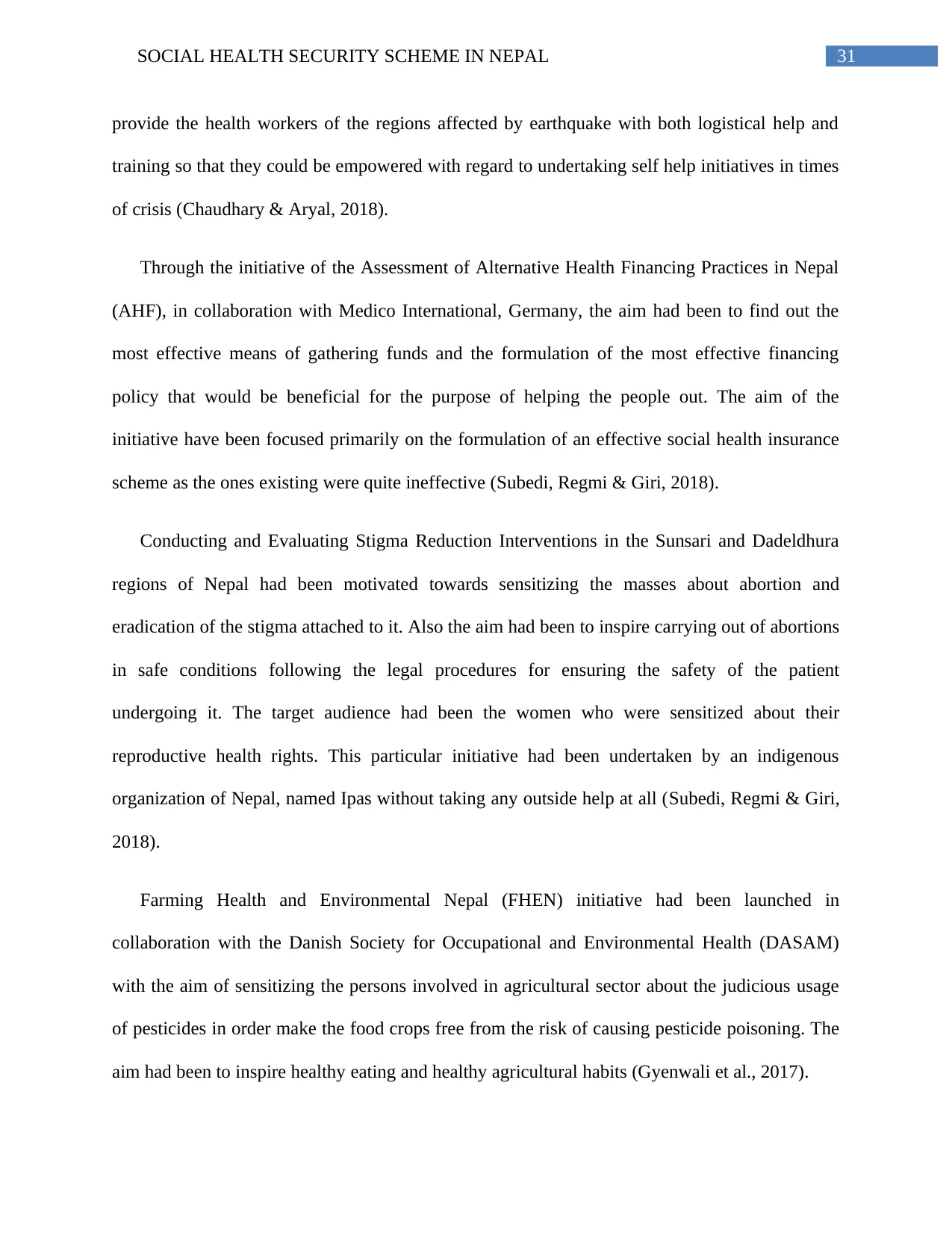
31SOCIAL HEALTH SECURITY SCHEME IN NEPAL
provide the health workers of the regions affected by earthquake with both logistical help and
training so that they could be empowered with regard to undertaking self help initiatives in times
of crisis (Chaudhary & Aryal, 2018).
Through the initiative of the Assessment of Alternative Health Financing Practices in Nepal
(AHF), in collaboration with Medico International, Germany, the aim had been to find out the
most effective means of gathering funds and the formulation of the most effective financing
policy that would be beneficial for the purpose of helping the people out. The aim of the
initiative have been focused primarily on the formulation of an effective social health insurance
scheme as the ones existing were quite ineffective (Subedi, Regmi & Giri, 2018).
Conducting and Evaluating Stigma Reduction Interventions in the Sunsari and Dadeldhura
regions of Nepal had been motivated towards sensitizing the masses about abortion and
eradication of the stigma attached to it. Also the aim had been to inspire carrying out of abortions
in safe conditions following the legal procedures for ensuring the safety of the patient
undergoing it. The target audience had been the women who were sensitized about their
reproductive health rights. This particular initiative had been undertaken by an indigenous
organization of Nepal, named Ipas without taking any outside help at all (Subedi, Regmi & Giri,
2018).
Farming Health and Environmental Nepal (FHEN) initiative had been launched in
collaboration with the Danish Society for Occupational and Environmental Health (DASAM)
with the aim of sensitizing the persons involved in agricultural sector about the judicious usage
of pesticides in order make the food crops free from the risk of causing pesticide poisoning. The
aim had been to inspire healthy eating and healthy agricultural habits (Gyenwali et al., 2017).
provide the health workers of the regions affected by earthquake with both logistical help and
training so that they could be empowered with regard to undertaking self help initiatives in times
of crisis (Chaudhary & Aryal, 2018).
Through the initiative of the Assessment of Alternative Health Financing Practices in Nepal
(AHF), in collaboration with Medico International, Germany, the aim had been to find out the
most effective means of gathering funds and the formulation of the most effective financing
policy that would be beneficial for the purpose of helping the people out. The aim of the
initiative have been focused primarily on the formulation of an effective social health insurance
scheme as the ones existing were quite ineffective (Subedi, Regmi & Giri, 2018).
Conducting and Evaluating Stigma Reduction Interventions in the Sunsari and Dadeldhura
regions of Nepal had been motivated towards sensitizing the masses about abortion and
eradication of the stigma attached to it. Also the aim had been to inspire carrying out of abortions
in safe conditions following the legal procedures for ensuring the safety of the patient
undergoing it. The target audience had been the women who were sensitized about their
reproductive health rights. This particular initiative had been undertaken by an indigenous
organization of Nepal, named Ipas without taking any outside help at all (Subedi, Regmi & Giri,
2018).
Farming Health and Environmental Nepal (FHEN) initiative had been launched in
collaboration with the Danish Society for Occupational and Environmental Health (DASAM)
with the aim of sensitizing the persons involved in agricultural sector about the judicious usage
of pesticides in order make the food crops free from the risk of causing pesticide poisoning. The
aim had been to inspire healthy eating and healthy agricultural habits (Gyenwali et al., 2017).
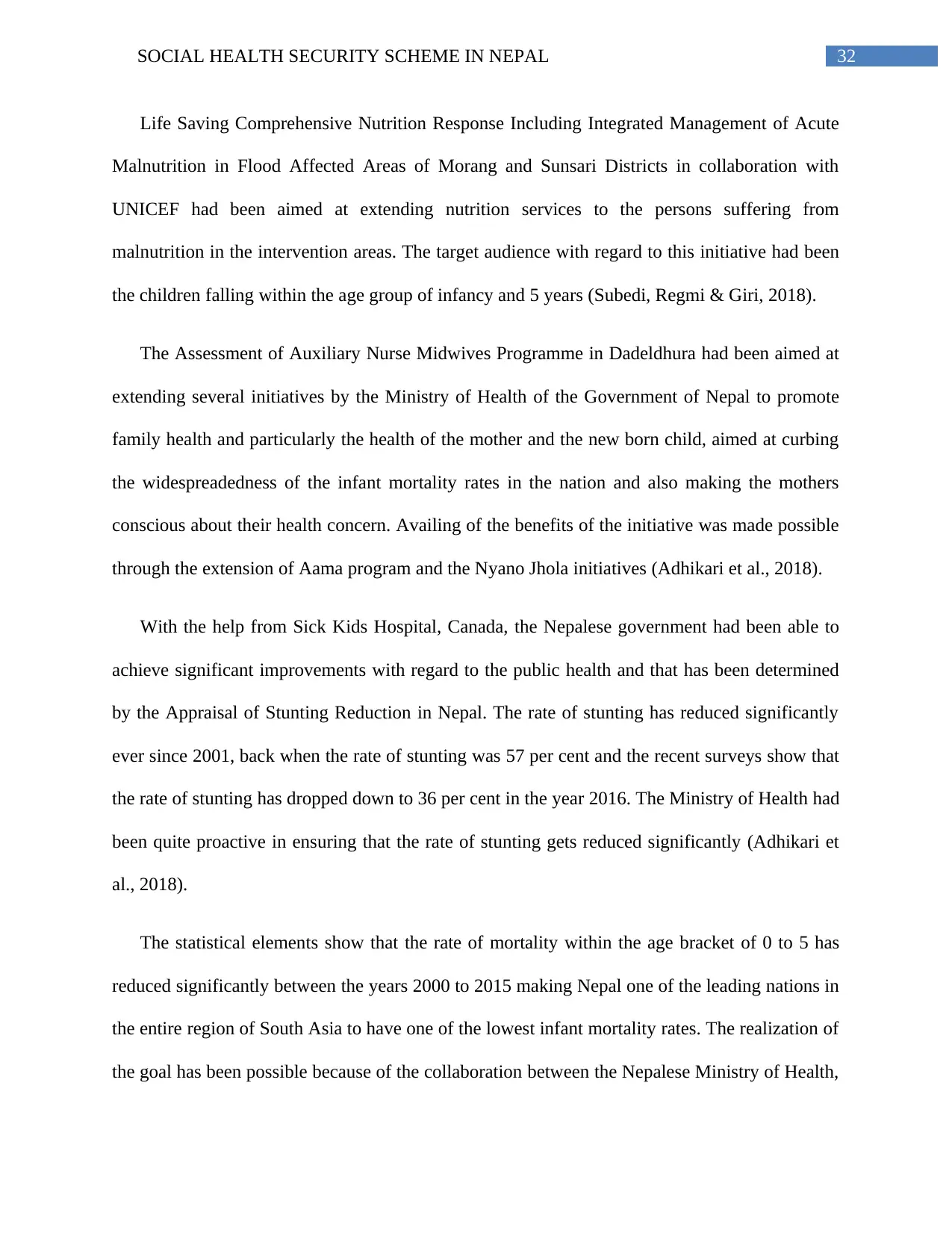
32SOCIAL HEALTH SECURITY SCHEME IN NEPAL
Life Saving Comprehensive Nutrition Response Including Integrated Management of Acute
Malnutrition in Flood Affected Areas of Morang and Sunsari Districts in collaboration with
UNICEF had been aimed at extending nutrition services to the persons suffering from
malnutrition in the intervention areas. The target audience with regard to this initiative had been
the children falling within the age group of infancy and 5 years (Subedi, Regmi & Giri, 2018).
The Assessment of Auxiliary Nurse Midwives Programme in Dadeldhura had been aimed at
extending several initiatives by the Ministry of Health of the Government of Nepal to promote
family health and particularly the health of the mother and the new born child, aimed at curbing
the widespreadedness of the infant mortality rates in the nation and also making the mothers
conscious about their health concern. Availing of the benefits of the initiative was made possible
through the extension of Aama program and the Nyano Jhola initiatives (Adhikari et al., 2018).
With the help from Sick Kids Hospital, Canada, the Nepalese government had been able to
achieve significant improvements with regard to the public health and that has been determined
by the Appraisal of Stunting Reduction in Nepal. The rate of stunting has reduced significantly
ever since 2001, back when the rate of stunting was 57 per cent and the recent surveys show that
the rate of stunting has dropped down to 36 per cent in the year 2016. The Ministry of Health had
been quite proactive in ensuring that the rate of stunting gets reduced significantly (Adhikari et
al., 2018).
The statistical elements show that the rate of mortality within the age bracket of 0 to 5 has
reduced significantly between the years 2000 to 2015 making Nepal one of the leading nations in
the entire region of South Asia to have one of the lowest infant mortality rates. The realization of
the goal has been possible because of the collaboration between the Nepalese Ministry of Health,
Life Saving Comprehensive Nutrition Response Including Integrated Management of Acute
Malnutrition in Flood Affected Areas of Morang and Sunsari Districts in collaboration with
UNICEF had been aimed at extending nutrition services to the persons suffering from
malnutrition in the intervention areas. The target audience with regard to this initiative had been
the children falling within the age group of infancy and 5 years (Subedi, Regmi & Giri, 2018).
The Assessment of Auxiliary Nurse Midwives Programme in Dadeldhura had been aimed at
extending several initiatives by the Ministry of Health of the Government of Nepal to promote
family health and particularly the health of the mother and the new born child, aimed at curbing
the widespreadedness of the infant mortality rates in the nation and also making the mothers
conscious about their health concern. Availing of the benefits of the initiative was made possible
through the extension of Aama program and the Nyano Jhola initiatives (Adhikari et al., 2018).
With the help from Sick Kids Hospital, Canada, the Nepalese government had been able to
achieve significant improvements with regard to the public health and that has been determined
by the Appraisal of Stunting Reduction in Nepal. The rate of stunting has reduced significantly
ever since 2001, back when the rate of stunting was 57 per cent and the recent surveys show that
the rate of stunting has dropped down to 36 per cent in the year 2016. The Ministry of Health had
been quite proactive in ensuring that the rate of stunting gets reduced significantly (Adhikari et
al., 2018).
The statistical elements show that the rate of mortality within the age bracket of 0 to 5 has
reduced significantly between the years 2000 to 2015 making Nepal one of the leading nations in
the entire region of South Asia to have one of the lowest infant mortality rates. The realization of
the goal has been possible because of the collaboration between the Nepalese Ministry of Health,
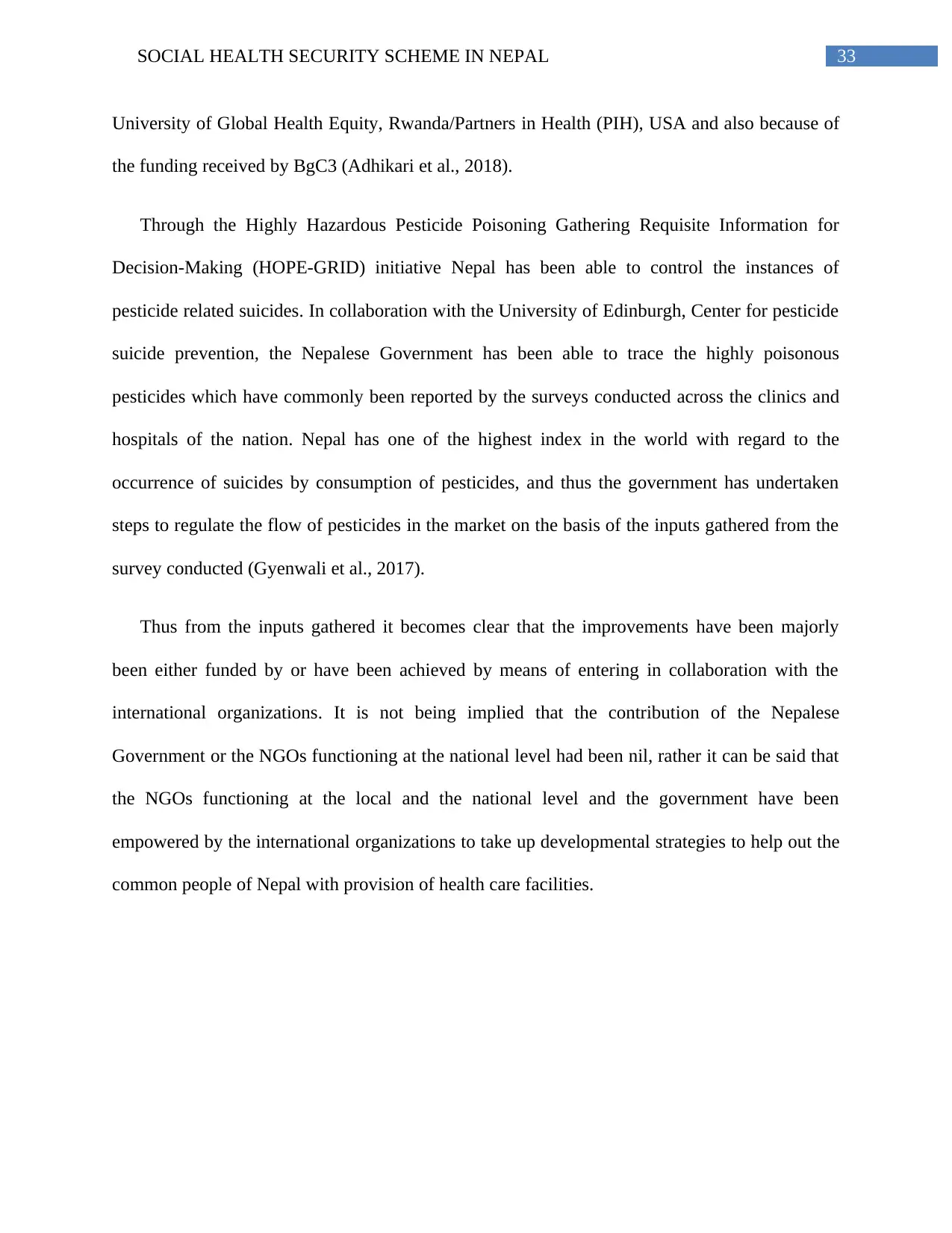
33SOCIAL HEALTH SECURITY SCHEME IN NEPAL
University of Global Health Equity, Rwanda/Partners in Health (PIH), USA and also because of
the funding received by BgC3 (Adhikari et al., 2018).
Through the Highly Hazardous Pesticide Poisoning Gathering Requisite Information for
Decision-Making (HOPE-GRID) initiative Nepal has been able to control the instances of
pesticide related suicides. In collaboration with the University of Edinburgh, Center for pesticide
suicide prevention, the Nepalese Government has been able to trace the highly poisonous
pesticides which have commonly been reported by the surveys conducted across the clinics and
hospitals of the nation. Nepal has one of the highest index in the world with regard to the
occurrence of suicides by consumption of pesticides, and thus the government has undertaken
steps to regulate the flow of pesticides in the market on the basis of the inputs gathered from the
survey conducted (Gyenwali et al., 2017).
Thus from the inputs gathered it becomes clear that the improvements have been majorly
been either funded by or have been achieved by means of entering in collaboration with the
international organizations. It is not being implied that the contribution of the Nepalese
Government or the NGOs functioning at the national level had been nil, rather it can be said that
the NGOs functioning at the local and the national level and the government have been
empowered by the international organizations to take up developmental strategies to help out the
common people of Nepal with provision of health care facilities.
University of Global Health Equity, Rwanda/Partners in Health (PIH), USA and also because of
the funding received by BgC3 (Adhikari et al., 2018).
Through the Highly Hazardous Pesticide Poisoning Gathering Requisite Information for
Decision-Making (HOPE-GRID) initiative Nepal has been able to control the instances of
pesticide related suicides. In collaboration with the University of Edinburgh, Center for pesticide
suicide prevention, the Nepalese Government has been able to trace the highly poisonous
pesticides which have commonly been reported by the surveys conducted across the clinics and
hospitals of the nation. Nepal has one of the highest index in the world with regard to the
occurrence of suicides by consumption of pesticides, and thus the government has undertaken
steps to regulate the flow of pesticides in the market on the basis of the inputs gathered from the
survey conducted (Gyenwali et al., 2017).
Thus from the inputs gathered it becomes clear that the improvements have been majorly
been either funded by or have been achieved by means of entering in collaboration with the
international organizations. It is not being implied that the contribution of the Nepalese
Government or the NGOs functioning at the national level had been nil, rather it can be said that
the NGOs functioning at the local and the national level and the government have been
empowered by the international organizations to take up developmental strategies to help out the
common people of Nepal with provision of health care facilities.
Secure Best Marks with AI Grader
Need help grading? Try our AI Grader for instant feedback on your assignments.
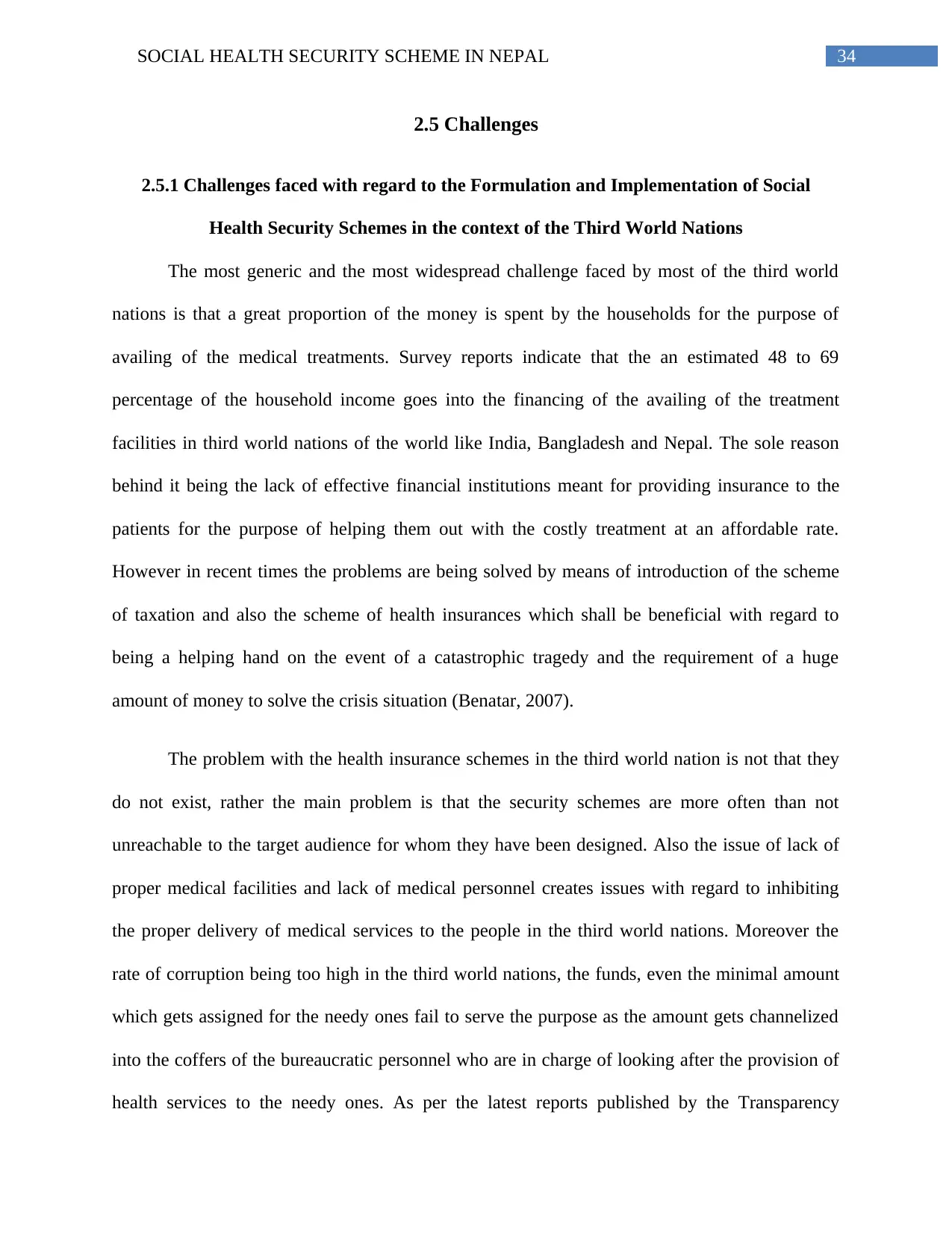
34SOCIAL HEALTH SECURITY SCHEME IN NEPAL
2.5 Challenges
2.5.1 Challenges faced with regard to the Formulation and Implementation of Social
Health Security Schemes in the context of the Third World Nations
The most generic and the most widespread challenge faced by most of the third world
nations is that a great proportion of the money is spent by the households for the purpose of
availing of the medical treatments. Survey reports indicate that the an estimated 48 to 69
percentage of the household income goes into the financing of the availing of the treatment
facilities in third world nations of the world like India, Bangladesh and Nepal. The sole reason
behind it being the lack of effective financial institutions meant for providing insurance to the
patients for the purpose of helping them out with the costly treatment at an affordable rate.
However in recent times the problems are being solved by means of introduction of the scheme
of taxation and also the scheme of health insurances which shall be beneficial with regard to
being a helping hand on the event of a catastrophic tragedy and the requirement of a huge
amount of money to solve the crisis situation (Benatar, 2007).
The problem with the health insurance schemes in the third world nation is not that they
do not exist, rather the main problem is that the security schemes are more often than not
unreachable to the target audience for whom they have been designed. Also the issue of lack of
proper medical facilities and lack of medical personnel creates issues with regard to inhibiting
the proper delivery of medical services to the people in the third world nations. Moreover the
rate of corruption being too high in the third world nations, the funds, even the minimal amount
which gets assigned for the needy ones fail to serve the purpose as the amount gets channelized
into the coffers of the bureaucratic personnel who are in charge of looking after the provision of
health services to the needy ones. As per the latest reports published by the Transparency
2.5 Challenges
2.5.1 Challenges faced with regard to the Formulation and Implementation of Social
Health Security Schemes in the context of the Third World Nations
The most generic and the most widespread challenge faced by most of the third world
nations is that a great proportion of the money is spent by the households for the purpose of
availing of the medical treatments. Survey reports indicate that the an estimated 48 to 69
percentage of the household income goes into the financing of the availing of the treatment
facilities in third world nations of the world like India, Bangladesh and Nepal. The sole reason
behind it being the lack of effective financial institutions meant for providing insurance to the
patients for the purpose of helping them out with the costly treatment at an affordable rate.
However in recent times the problems are being solved by means of introduction of the scheme
of taxation and also the scheme of health insurances which shall be beneficial with regard to
being a helping hand on the event of a catastrophic tragedy and the requirement of a huge
amount of money to solve the crisis situation (Benatar, 2007).
The problem with the health insurance schemes in the third world nation is not that they
do not exist, rather the main problem is that the security schemes are more often than not
unreachable to the target audience for whom they have been designed. Also the issue of lack of
proper medical facilities and lack of medical personnel creates issues with regard to inhibiting
the proper delivery of medical services to the people in the third world nations. Moreover the
rate of corruption being too high in the third world nations, the funds, even the minimal amount
which gets assigned for the needy ones fail to serve the purpose as the amount gets channelized
into the coffers of the bureaucratic personnel who are in charge of looking after the provision of
health services to the needy ones. As per the latest reports published by the Transparency
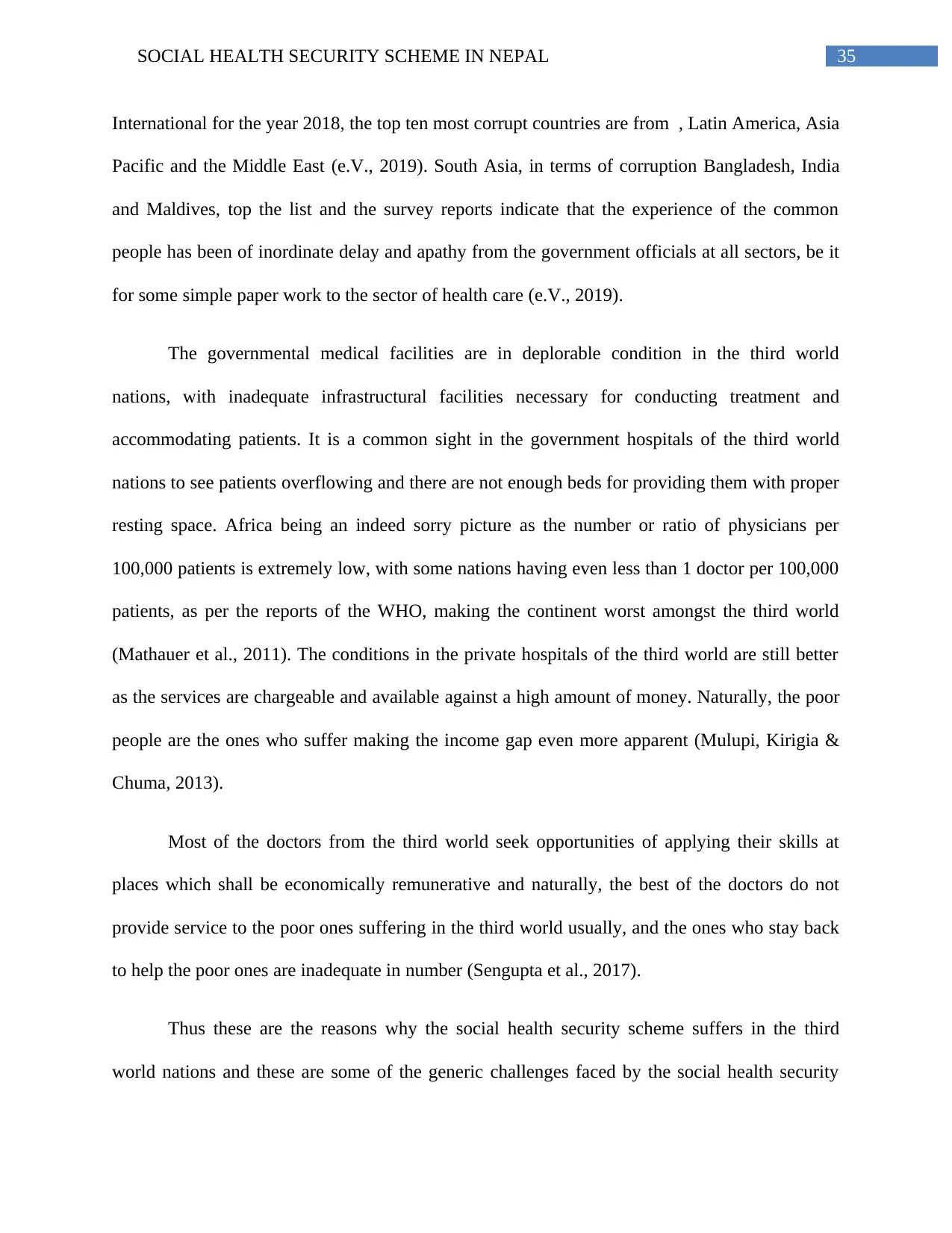
35SOCIAL HEALTH SECURITY SCHEME IN NEPAL
International for the year 2018, the top ten most corrupt countries are from , Latin America, Asia
Pacific and the Middle East (e.V., 2019). South Asia, in terms of corruption Bangladesh, India
and Maldives, top the list and the survey reports indicate that the experience of the common
people has been of inordinate delay and apathy from the government officials at all sectors, be it
for some simple paper work to the sector of health care (e.V., 2019).
The governmental medical facilities are in deplorable condition in the third world
nations, with inadequate infrastructural facilities necessary for conducting treatment and
accommodating patients. It is a common sight in the government hospitals of the third world
nations to see patients overflowing and there are not enough beds for providing them with proper
resting space. Africa being an indeed sorry picture as the number or ratio of physicians per
100,000 patients is extremely low, with some nations having even less than 1 doctor per 100,000
patients, as per the reports of the WHO, making the continent worst amongst the third world
(Mathauer et al., 2011). The conditions in the private hospitals of the third world are still better
as the services are chargeable and available against a high amount of money. Naturally, the poor
people are the ones who suffer making the income gap even more apparent (Mulupi, Kirigia &
Chuma, 2013).
Most of the doctors from the third world seek opportunities of applying their skills at
places which shall be economically remunerative and naturally, the best of the doctors do not
provide service to the poor ones suffering in the third world usually, and the ones who stay back
to help the poor ones are inadequate in number (Sengupta et al., 2017).
Thus these are the reasons why the social health security scheme suffers in the third
world nations and these are some of the generic challenges faced by the social health security
International for the year 2018, the top ten most corrupt countries are from , Latin America, Asia
Pacific and the Middle East (e.V., 2019). South Asia, in terms of corruption Bangladesh, India
and Maldives, top the list and the survey reports indicate that the experience of the common
people has been of inordinate delay and apathy from the government officials at all sectors, be it
for some simple paper work to the sector of health care (e.V., 2019).
The governmental medical facilities are in deplorable condition in the third world
nations, with inadequate infrastructural facilities necessary for conducting treatment and
accommodating patients. It is a common sight in the government hospitals of the third world
nations to see patients overflowing and there are not enough beds for providing them with proper
resting space. Africa being an indeed sorry picture as the number or ratio of physicians per
100,000 patients is extremely low, with some nations having even less than 1 doctor per 100,000
patients, as per the reports of the WHO, making the continent worst amongst the third world
(Mathauer et al., 2011). The conditions in the private hospitals of the third world are still better
as the services are chargeable and available against a high amount of money. Naturally, the poor
people are the ones who suffer making the income gap even more apparent (Mulupi, Kirigia &
Chuma, 2013).
Most of the doctors from the third world seek opportunities of applying their skills at
places which shall be economically remunerative and naturally, the best of the doctors do not
provide service to the poor ones suffering in the third world usually, and the ones who stay back
to help the poor ones are inadequate in number (Sengupta et al., 2017).
Thus these are the reasons why the social health security scheme suffers in the third
world nations and these are some of the generic challenges faced by the social health security
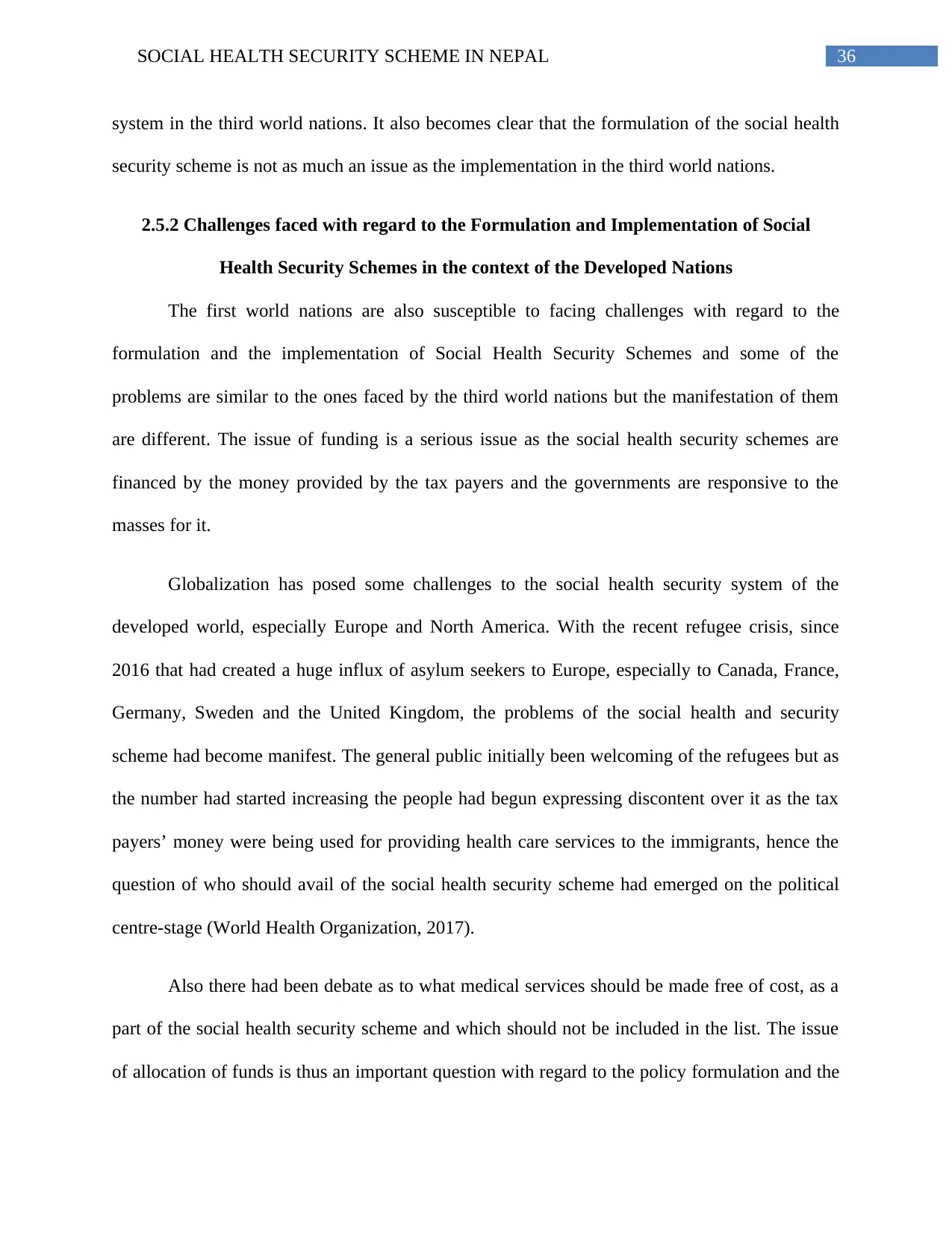
36SOCIAL HEALTH SECURITY SCHEME IN NEPAL
system in the third world nations. It also becomes clear that the formulation of the social health
security scheme is not as much an issue as the implementation in the third world nations.
2.5.2 Challenges faced with regard to the Formulation and Implementation of Social
Health Security Schemes in the context of the Developed Nations
The first world nations are also susceptible to facing challenges with regard to the
formulation and the implementation of Social Health Security Schemes and some of the
problems are similar to the ones faced by the third world nations but the manifestation of them
are different. The issue of funding is a serious issue as the social health security schemes are
financed by the money provided by the tax payers and the governments are responsive to the
masses for it.
Globalization has posed some challenges to the social health security system of the
developed world, especially Europe and North America. With the recent refugee crisis, since
2016 that had created a huge influx of asylum seekers to Europe, especially to Canada, France,
Germany, Sweden and the United Kingdom, the problems of the social health and security
scheme had become manifest. The general public initially been welcoming of the refugees but as
the number had started increasing the people had begun expressing discontent over it as the tax
payers’ money were being used for providing health care services to the immigrants, hence the
question of who should avail of the social health security scheme had emerged on the political
centre-stage (World Health Organization, 2017).
Also there had been debate as to what medical services should be made free of cost, as a
part of the social health security scheme and which should not be included in the list. The issue
of allocation of funds is thus an important question with regard to the policy formulation and the
system in the third world nations. It also becomes clear that the formulation of the social health
security scheme is not as much an issue as the implementation in the third world nations.
2.5.2 Challenges faced with regard to the Formulation and Implementation of Social
Health Security Schemes in the context of the Developed Nations
The first world nations are also susceptible to facing challenges with regard to the
formulation and the implementation of Social Health Security Schemes and some of the
problems are similar to the ones faced by the third world nations but the manifestation of them
are different. The issue of funding is a serious issue as the social health security schemes are
financed by the money provided by the tax payers and the governments are responsive to the
masses for it.
Globalization has posed some challenges to the social health security system of the
developed world, especially Europe and North America. With the recent refugee crisis, since
2016 that had created a huge influx of asylum seekers to Europe, especially to Canada, France,
Germany, Sweden and the United Kingdom, the problems of the social health and security
scheme had become manifest. The general public initially been welcoming of the refugees but as
the number had started increasing the people had begun expressing discontent over it as the tax
payers’ money were being used for providing health care services to the immigrants, hence the
question of who should avail of the social health security scheme had emerged on the political
centre-stage (World Health Organization, 2017).
Also there had been debate as to what medical services should be made free of cost, as a
part of the social health security scheme and which should not be included in the list. The issue
of allocation of funds is thus an important question with regard to the policy formulation and the
Paraphrase This Document
Need a fresh take? Get an instant paraphrase of this document with our AI Paraphraser
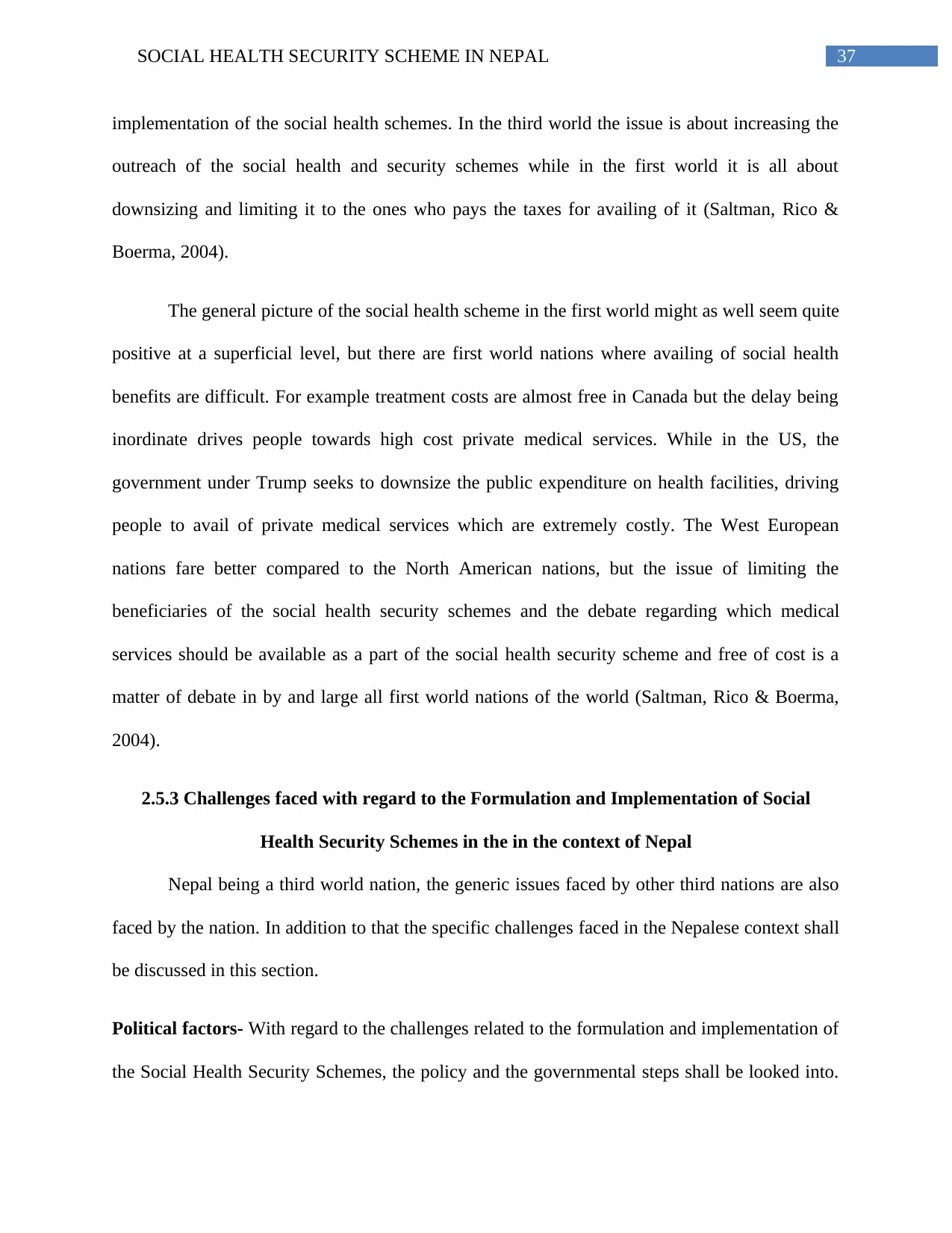
37SOCIAL HEALTH SECURITY SCHEME IN NEPAL
implementation of the social health schemes. In the third world the issue is about increasing the
outreach of the social health and security schemes while in the first world it is all about
downsizing and limiting it to the ones who pays the taxes for availing of it (Saltman, Rico &
Boerma, 2004).
The general picture of the social health scheme in the first world might as well seem quite
positive at a superficial level, but there are first world nations where availing of social health
benefits are difficult. For example treatment costs are almost free in Canada but the delay being
inordinate drives people towards high cost private medical services. While in the US, the
government under Trump seeks to downsize the public expenditure on health facilities, driving
people to avail of private medical services which are extremely costly. The West European
nations fare better compared to the North American nations, but the issue of limiting the
beneficiaries of the social health security schemes and the debate regarding which medical
services should be available as a part of the social health security scheme and free of cost is a
matter of debate in by and large all first world nations of the world (Saltman, Rico & Boerma,
2004).
2.5.3 Challenges faced with regard to the Formulation and Implementation of Social
Health Security Schemes in the in the context of Nepal
Nepal being a third world nation, the generic issues faced by other third nations are also
faced by the nation. In addition to that the specific challenges faced in the Nepalese context shall
be discussed in this section.
Political factors- With regard to the challenges related to the formulation and implementation of
the Social Health Security Schemes, the policy and the governmental steps shall be looked into.
implementation of the social health schemes. In the third world the issue is about increasing the
outreach of the social health and security schemes while in the first world it is all about
downsizing and limiting it to the ones who pays the taxes for availing of it (Saltman, Rico &
Boerma, 2004).
The general picture of the social health scheme in the first world might as well seem quite
positive at a superficial level, but there are first world nations where availing of social health
benefits are difficult. For example treatment costs are almost free in Canada but the delay being
inordinate drives people towards high cost private medical services. While in the US, the
government under Trump seeks to downsize the public expenditure on health facilities, driving
people to avail of private medical services which are extremely costly. The West European
nations fare better compared to the North American nations, but the issue of limiting the
beneficiaries of the social health security schemes and the debate regarding which medical
services should be available as a part of the social health security scheme and free of cost is a
matter of debate in by and large all first world nations of the world (Saltman, Rico & Boerma,
2004).
2.5.3 Challenges faced with regard to the Formulation and Implementation of Social
Health Security Schemes in the in the context of Nepal
Nepal being a third world nation, the generic issues faced by other third nations are also
faced by the nation. In addition to that the specific challenges faced in the Nepalese context shall
be discussed in this section.
Political factors- With regard to the challenges related to the formulation and implementation of
the Social Health Security Schemes, the policy and the governmental steps shall be looked into.
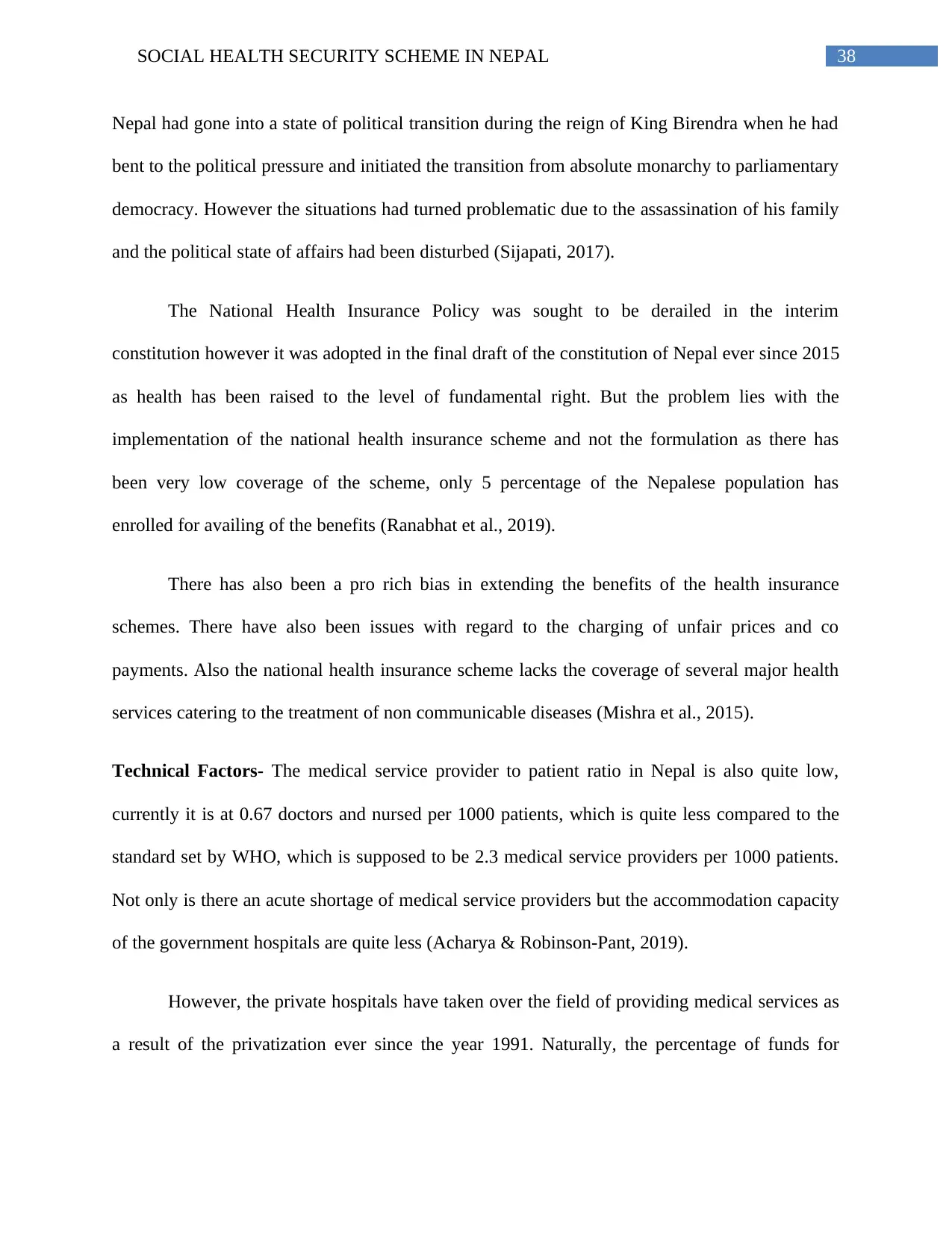
38SOCIAL HEALTH SECURITY SCHEME IN NEPAL
Nepal had gone into a state of political transition during the reign of King Birendra when he had
bent to the political pressure and initiated the transition from absolute monarchy to parliamentary
democracy. However the situations had turned problematic due to the assassination of his family
and the political state of affairs had been disturbed (Sijapati, 2017).
The National Health Insurance Policy was sought to be derailed in the interim
constitution however it was adopted in the final draft of the constitution of Nepal ever since 2015
as health has been raised to the level of fundamental right. But the problem lies with the
implementation of the national health insurance scheme and not the formulation as there has
been very low coverage of the scheme, only 5 percentage of the Nepalese population has
enrolled for availing of the benefits (Ranabhat et al., 2019).
There has also been a pro rich bias in extending the benefits of the health insurance
schemes. There have also been issues with regard to the charging of unfair prices and co
payments. Also the national health insurance scheme lacks the coverage of several major health
services catering to the treatment of non communicable diseases (Mishra et al., 2015).
Technical Factors- The medical service provider to patient ratio in Nepal is also quite low,
currently it is at 0.67 doctors and nursed per 1000 patients, which is quite less compared to the
standard set by WHO, which is supposed to be 2.3 medical service providers per 1000 patients.
Not only is there an acute shortage of medical service providers but the accommodation capacity
of the government hospitals are quite less (Acharya & Robinson-Pant, 2019).
However, the private hospitals have taken over the field of providing medical services as
a result of the privatization ever since the year 1991. Naturally, the percentage of funds for
Nepal had gone into a state of political transition during the reign of King Birendra when he had
bent to the political pressure and initiated the transition from absolute monarchy to parliamentary
democracy. However the situations had turned problematic due to the assassination of his family
and the political state of affairs had been disturbed (Sijapati, 2017).
The National Health Insurance Policy was sought to be derailed in the interim
constitution however it was adopted in the final draft of the constitution of Nepal ever since 2015
as health has been raised to the level of fundamental right. But the problem lies with the
implementation of the national health insurance scheme and not the formulation as there has
been very low coverage of the scheme, only 5 percentage of the Nepalese population has
enrolled for availing of the benefits (Ranabhat et al., 2019).
There has also been a pro rich bias in extending the benefits of the health insurance
schemes. There have also been issues with regard to the charging of unfair prices and co
payments. Also the national health insurance scheme lacks the coverage of several major health
services catering to the treatment of non communicable diseases (Mishra et al., 2015).
Technical Factors- The medical service provider to patient ratio in Nepal is also quite low,
currently it is at 0.67 doctors and nursed per 1000 patients, which is quite less compared to the
standard set by WHO, which is supposed to be 2.3 medical service providers per 1000 patients.
Not only is there an acute shortage of medical service providers but the accommodation capacity
of the government hospitals are quite less (Acharya & Robinson-Pant, 2019).
However, the private hospitals have taken over the field of providing medical services as
a result of the privatization ever since the year 1991. Naturally, the percentage of funds for
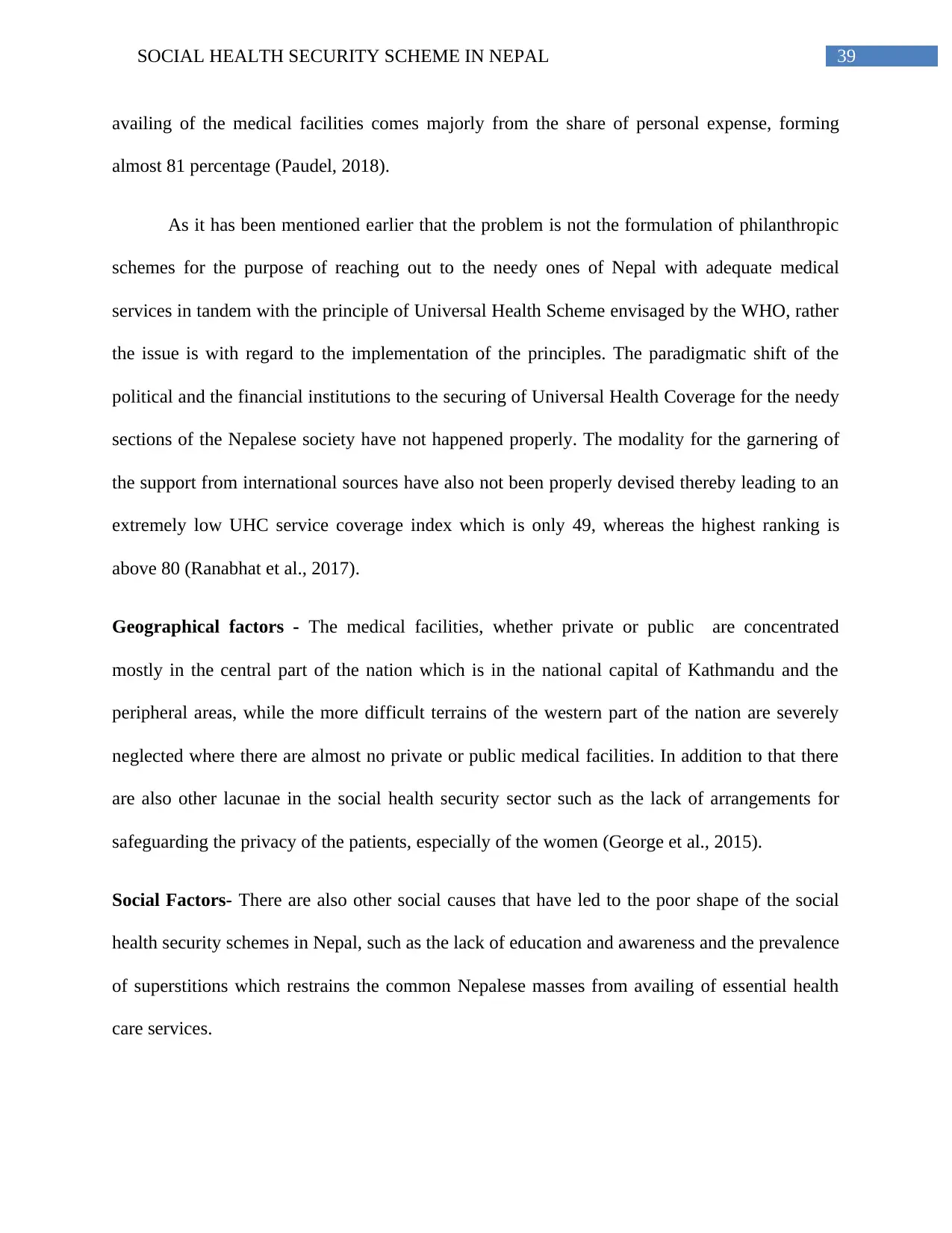
39SOCIAL HEALTH SECURITY SCHEME IN NEPAL
availing of the medical facilities comes majorly from the share of personal expense, forming
almost 81 percentage (Paudel, 2018).
As it has been mentioned earlier that the problem is not the formulation of philanthropic
schemes for the purpose of reaching out to the needy ones of Nepal with adequate medical
services in tandem with the principle of Universal Health Scheme envisaged by the WHO, rather
the issue is with regard to the implementation of the principles. The paradigmatic shift of the
political and the financial institutions to the securing of Universal Health Coverage for the needy
sections of the Nepalese society have not happened properly. The modality for the garnering of
the support from international sources have also not been properly devised thereby leading to an
extremely low UHC service coverage index which is only 49, whereas the highest ranking is
above 80 (Ranabhat et al., 2017).
Geographical factors - The medical facilities, whether private or public are concentrated
mostly in the central part of the nation which is in the national capital of Kathmandu and the
peripheral areas, while the more difficult terrains of the western part of the nation are severely
neglected where there are almost no private or public medical facilities. In addition to that there
are also other lacunae in the social health security sector such as the lack of arrangements for
safeguarding the privacy of the patients, especially of the women (George et al., 2015).
Social Factors- There are also other social causes that have led to the poor shape of the social
health security schemes in Nepal, such as the lack of education and awareness and the prevalence
of superstitions which restrains the common Nepalese masses from availing of essential health
care services.
availing of the medical facilities comes majorly from the share of personal expense, forming
almost 81 percentage (Paudel, 2018).
As it has been mentioned earlier that the problem is not the formulation of philanthropic
schemes for the purpose of reaching out to the needy ones of Nepal with adequate medical
services in tandem with the principle of Universal Health Scheme envisaged by the WHO, rather
the issue is with regard to the implementation of the principles. The paradigmatic shift of the
political and the financial institutions to the securing of Universal Health Coverage for the needy
sections of the Nepalese society have not happened properly. The modality for the garnering of
the support from international sources have also not been properly devised thereby leading to an
extremely low UHC service coverage index which is only 49, whereas the highest ranking is
above 80 (Ranabhat et al., 2017).
Geographical factors - The medical facilities, whether private or public are concentrated
mostly in the central part of the nation which is in the national capital of Kathmandu and the
peripheral areas, while the more difficult terrains of the western part of the nation are severely
neglected where there are almost no private or public medical facilities. In addition to that there
are also other lacunae in the social health security sector such as the lack of arrangements for
safeguarding the privacy of the patients, especially of the women (George et al., 2015).
Social Factors- There are also other social causes that have led to the poor shape of the social
health security schemes in Nepal, such as the lack of education and awareness and the prevalence
of superstitions which restrains the common Nepalese masses from availing of essential health
care services.
Secure Best Marks with AI Grader
Need help grading? Try our AI Grader for instant feedback on your assignments.
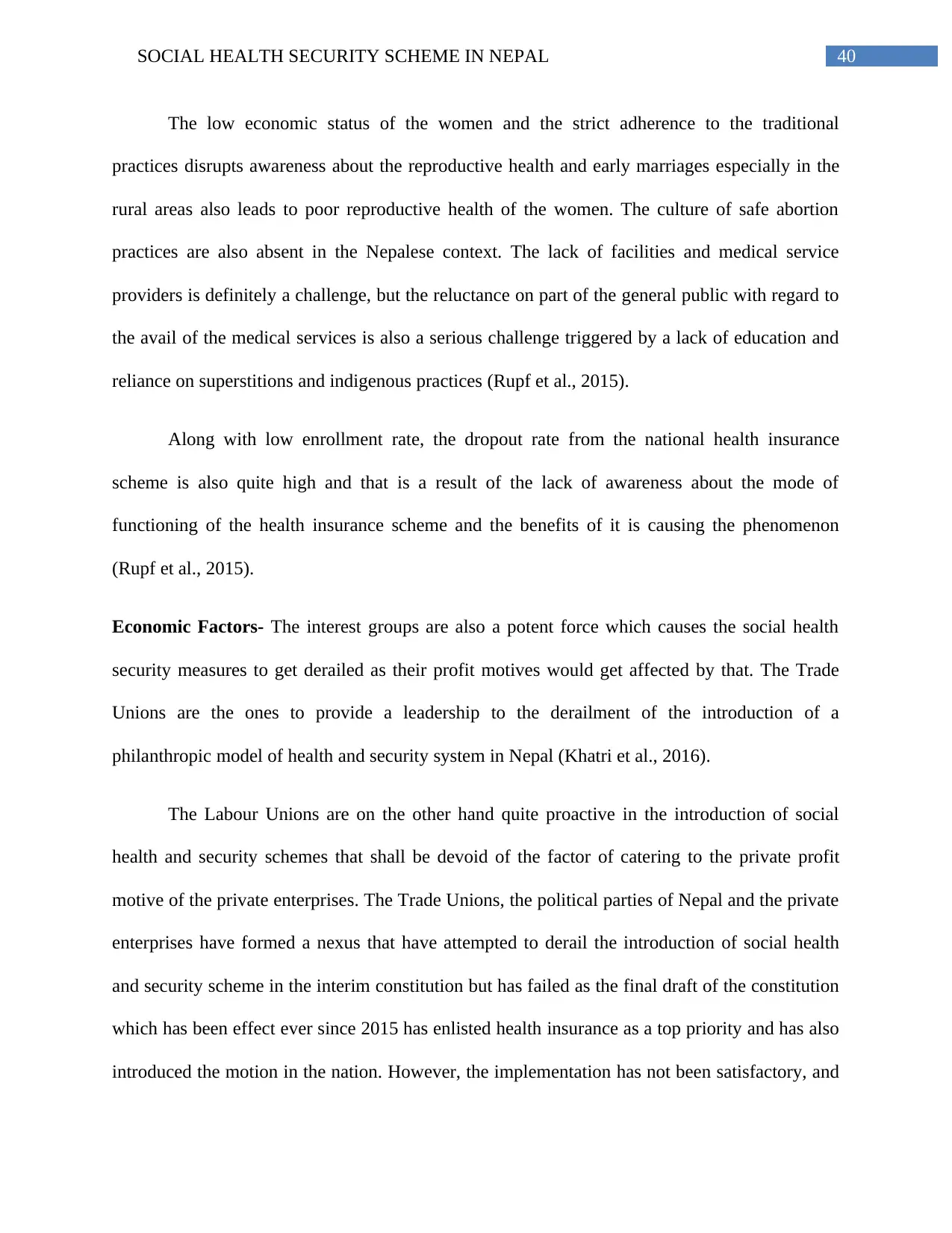
40SOCIAL HEALTH SECURITY SCHEME IN NEPAL
The low economic status of the women and the strict adherence to the traditional
practices disrupts awareness about the reproductive health and early marriages especially in the
rural areas also leads to poor reproductive health of the women. The culture of safe abortion
practices are also absent in the Nepalese context. The lack of facilities and medical service
providers is definitely a challenge, but the reluctance on part of the general public with regard to
the avail of the medical services is also a serious challenge triggered by a lack of education and
reliance on superstitions and indigenous practices (Rupf et al., 2015).
Along with low enrollment rate, the dropout rate from the national health insurance
scheme is also quite high and that is a result of the lack of awareness about the mode of
functioning of the health insurance scheme and the benefits of it is causing the phenomenon
(Rupf et al., 2015).
Economic Factors- The interest groups are also a potent force which causes the social health
security measures to get derailed as their profit motives would get affected by that. The Trade
Unions are the ones to provide a leadership to the derailment of the introduction of a
philanthropic model of health and security system in Nepal (Khatri et al., 2016).
The Labour Unions are on the other hand quite proactive in the introduction of social
health and security schemes that shall be devoid of the factor of catering to the private profit
motive of the private enterprises. The Trade Unions, the political parties of Nepal and the private
enterprises have formed a nexus that have attempted to derail the introduction of social health
and security scheme in the interim constitution but has failed as the final draft of the constitution
which has been effect ever since 2015 has enlisted health insurance as a top priority and has also
introduced the motion in the nation. However, the implementation has not been satisfactory, and
The low economic status of the women and the strict adherence to the traditional
practices disrupts awareness about the reproductive health and early marriages especially in the
rural areas also leads to poor reproductive health of the women. The culture of safe abortion
practices are also absent in the Nepalese context. The lack of facilities and medical service
providers is definitely a challenge, but the reluctance on part of the general public with regard to
the avail of the medical services is also a serious challenge triggered by a lack of education and
reliance on superstitions and indigenous practices (Rupf et al., 2015).
Along with low enrollment rate, the dropout rate from the national health insurance
scheme is also quite high and that is a result of the lack of awareness about the mode of
functioning of the health insurance scheme and the benefits of it is causing the phenomenon
(Rupf et al., 2015).
Economic Factors- The interest groups are also a potent force which causes the social health
security measures to get derailed as their profit motives would get affected by that. The Trade
Unions are the ones to provide a leadership to the derailment of the introduction of a
philanthropic model of health and security system in Nepal (Khatri et al., 2016).
The Labour Unions are on the other hand quite proactive in the introduction of social
health and security schemes that shall be devoid of the factor of catering to the private profit
motive of the private enterprises. The Trade Unions, the political parties of Nepal and the private
enterprises have formed a nexus that have attempted to derail the introduction of social health
and security scheme in the interim constitution but has failed as the final draft of the constitution
which has been effect ever since 2015 has enlisted health insurance as a top priority and has also
introduced the motion in the nation. However, the implementation has not been satisfactory, and
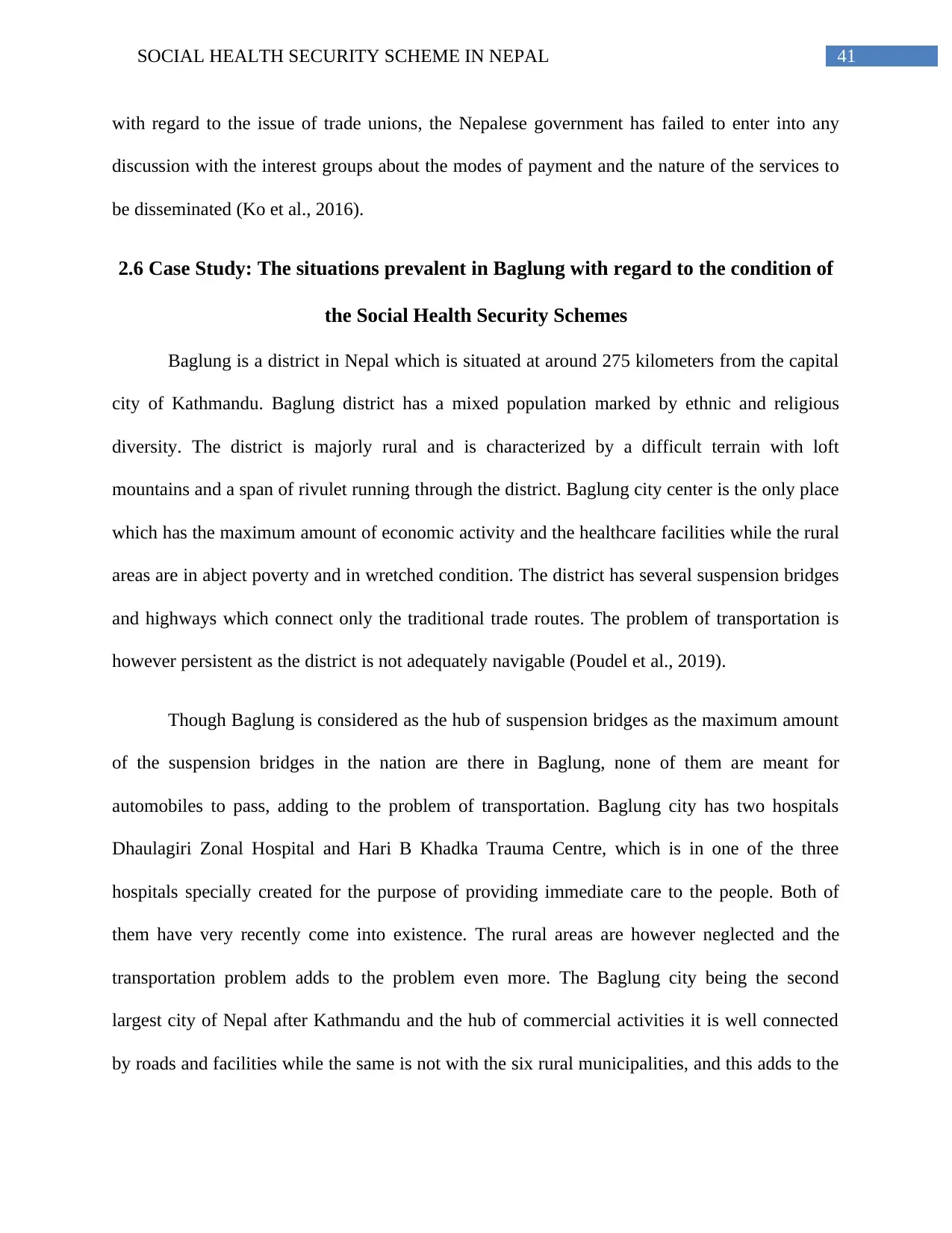
41SOCIAL HEALTH SECURITY SCHEME IN NEPAL
with regard to the issue of trade unions, the Nepalese government has failed to enter into any
discussion with the interest groups about the modes of payment and the nature of the services to
be disseminated (Ko et al., 2016).
2.6 Case Study: The situations prevalent in Baglung with regard to the condition of
the Social Health Security Schemes
Baglung is a district in Nepal which is situated at around 275 kilometers from the capital
city of Kathmandu. Baglung district has a mixed population marked by ethnic and religious
diversity. The district is majorly rural and is characterized by a difficult terrain with loft
mountains and a span of rivulet running through the district. Baglung city center is the only place
which has the maximum amount of economic activity and the healthcare facilities while the rural
areas are in abject poverty and in wretched condition. The district has several suspension bridges
and highways which connect only the traditional trade routes. The problem of transportation is
however persistent as the district is not adequately navigable (Poudel et al., 2019).
Though Baglung is considered as the hub of suspension bridges as the maximum amount
of the suspension bridges in the nation are there in Baglung, none of them are meant for
automobiles to pass, adding to the problem of transportation. Baglung city has two hospitals
Dhaulagiri Zonal Hospital and Hari B Khadka Trauma Centre, which is in one of the three
hospitals specially created for the purpose of providing immediate care to the people. Both of
them have very recently come into existence. The rural areas are however neglected and the
transportation problem adds to the problem even more. The Baglung city being the second
largest city of Nepal after Kathmandu and the hub of commercial activities it is well connected
by roads and facilities while the same is not with the six rural municipalities, and this adds to the
with regard to the issue of trade unions, the Nepalese government has failed to enter into any
discussion with the interest groups about the modes of payment and the nature of the services to
be disseminated (Ko et al., 2016).
2.6 Case Study: The situations prevalent in Baglung with regard to the condition of
the Social Health Security Schemes
Baglung is a district in Nepal which is situated at around 275 kilometers from the capital
city of Kathmandu. Baglung district has a mixed population marked by ethnic and religious
diversity. The district is majorly rural and is characterized by a difficult terrain with loft
mountains and a span of rivulet running through the district. Baglung city center is the only place
which has the maximum amount of economic activity and the healthcare facilities while the rural
areas are in abject poverty and in wretched condition. The district has several suspension bridges
and highways which connect only the traditional trade routes. The problem of transportation is
however persistent as the district is not adequately navigable (Poudel et al., 2019).
Though Baglung is considered as the hub of suspension bridges as the maximum amount
of the suspension bridges in the nation are there in Baglung, none of them are meant for
automobiles to pass, adding to the problem of transportation. Baglung city has two hospitals
Dhaulagiri Zonal Hospital and Hari B Khadka Trauma Centre, which is in one of the three
hospitals specially created for the purpose of providing immediate care to the people. Both of
them have very recently come into existence. The rural areas are however neglected and the
transportation problem adds to the problem even more. The Baglung city being the second
largest city of Nepal after Kathmandu and the hub of commercial activities it is well connected
by roads and facilities while the same is not with the six rural municipalities, and this adds to the
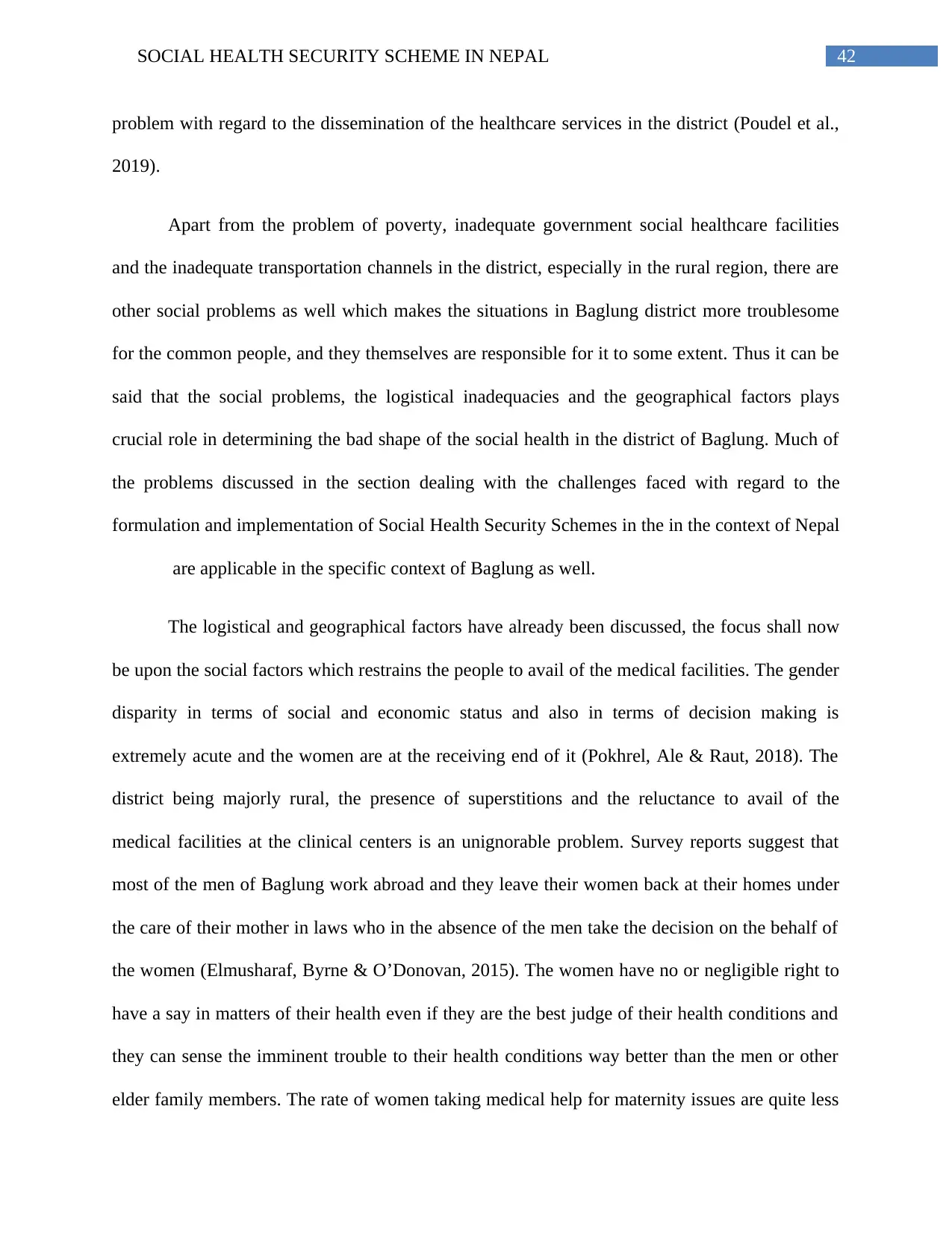
42SOCIAL HEALTH SECURITY SCHEME IN NEPAL
problem with regard to the dissemination of the healthcare services in the district (Poudel et al.,
2019).
Apart from the problem of poverty, inadequate government social healthcare facilities
and the inadequate transportation channels in the district, especially in the rural region, there are
other social problems as well which makes the situations in Baglung district more troublesome
for the common people, and they themselves are responsible for it to some extent. Thus it can be
said that the social problems, the logistical inadequacies and the geographical factors plays
crucial role in determining the bad shape of the social health in the district of Baglung. Much of
the problems discussed in the section dealing with the challenges faced with regard to the
formulation and implementation of Social Health Security Schemes in the in the context of Nepal
are applicable in the specific context of Baglung as well.
The logistical and geographical factors have already been discussed, the focus shall now
be upon the social factors which restrains the people to avail of the medical facilities. The gender
disparity in terms of social and economic status and also in terms of decision making is
extremely acute and the women are at the receiving end of it (Pokhrel, Ale & Raut, 2018). The
district being majorly rural, the presence of superstitions and the reluctance to avail of the
medical facilities at the clinical centers is an unignorable problem. Survey reports suggest that
most of the men of Baglung work abroad and they leave their women back at their homes under
the care of their mother in laws who in the absence of the men take the decision on the behalf of
the women (Elmusharaf, Byrne & O’Donovan, 2015). The women have no or negligible right to
have a say in matters of their health even if they are the best judge of their health conditions and
they can sense the imminent trouble to their health conditions way better than the men or other
elder family members. The rate of women taking medical help for maternity issues are quite less
problem with regard to the dissemination of the healthcare services in the district (Poudel et al.,
2019).
Apart from the problem of poverty, inadequate government social healthcare facilities
and the inadequate transportation channels in the district, especially in the rural region, there are
other social problems as well which makes the situations in Baglung district more troublesome
for the common people, and they themselves are responsible for it to some extent. Thus it can be
said that the social problems, the logistical inadequacies and the geographical factors plays
crucial role in determining the bad shape of the social health in the district of Baglung. Much of
the problems discussed in the section dealing with the challenges faced with regard to the
formulation and implementation of Social Health Security Schemes in the in the context of Nepal
are applicable in the specific context of Baglung as well.
The logistical and geographical factors have already been discussed, the focus shall now
be upon the social factors which restrains the people to avail of the medical facilities. The gender
disparity in terms of social and economic status and also in terms of decision making is
extremely acute and the women are at the receiving end of it (Pokhrel, Ale & Raut, 2018). The
district being majorly rural, the presence of superstitions and the reluctance to avail of the
medical facilities at the clinical centers is an unignorable problem. Survey reports suggest that
most of the men of Baglung work abroad and they leave their women back at their homes under
the care of their mother in laws who in the absence of the men take the decision on the behalf of
the women (Elmusharaf, Byrne & O’Donovan, 2015). The women have no or negligible right to
have a say in matters of their health even if they are the best judge of their health conditions and
they can sense the imminent trouble to their health conditions way better than the men or other
elder family members. The rate of women taking medical help for maternity issues are quite less
Paraphrase This Document
Need a fresh take? Get an instant paraphrase of this document with our AI Paraphraser
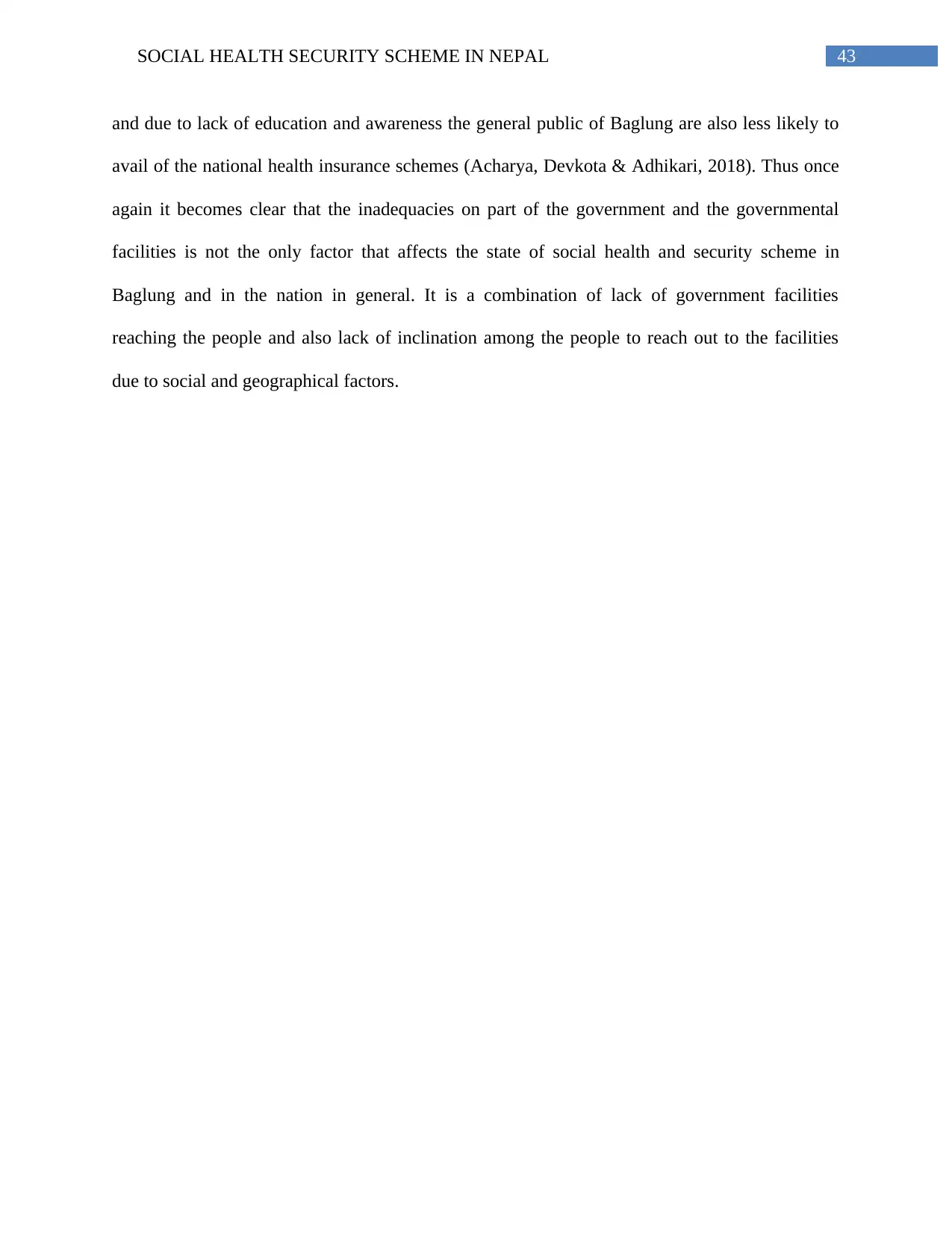
43SOCIAL HEALTH SECURITY SCHEME IN NEPAL
and due to lack of education and awareness the general public of Baglung are also less likely to
avail of the national health insurance schemes (Acharya, Devkota & Adhikari, 2018). Thus once
again it becomes clear that the inadequacies on part of the government and the governmental
facilities is not the only factor that affects the state of social health and security scheme in
Baglung and in the nation in general. It is a combination of lack of government facilities
reaching the people and also lack of inclination among the people to reach out to the facilities
due to social and geographical factors.
and due to lack of education and awareness the general public of Baglung are also less likely to
avail of the national health insurance schemes (Acharya, Devkota & Adhikari, 2018). Thus once
again it becomes clear that the inadequacies on part of the government and the governmental
facilities is not the only factor that affects the state of social health and security scheme in
Baglung and in the nation in general. It is a combination of lack of government facilities
reaching the people and also lack of inclination among the people to reach out to the facilities
due to social and geographical factors.
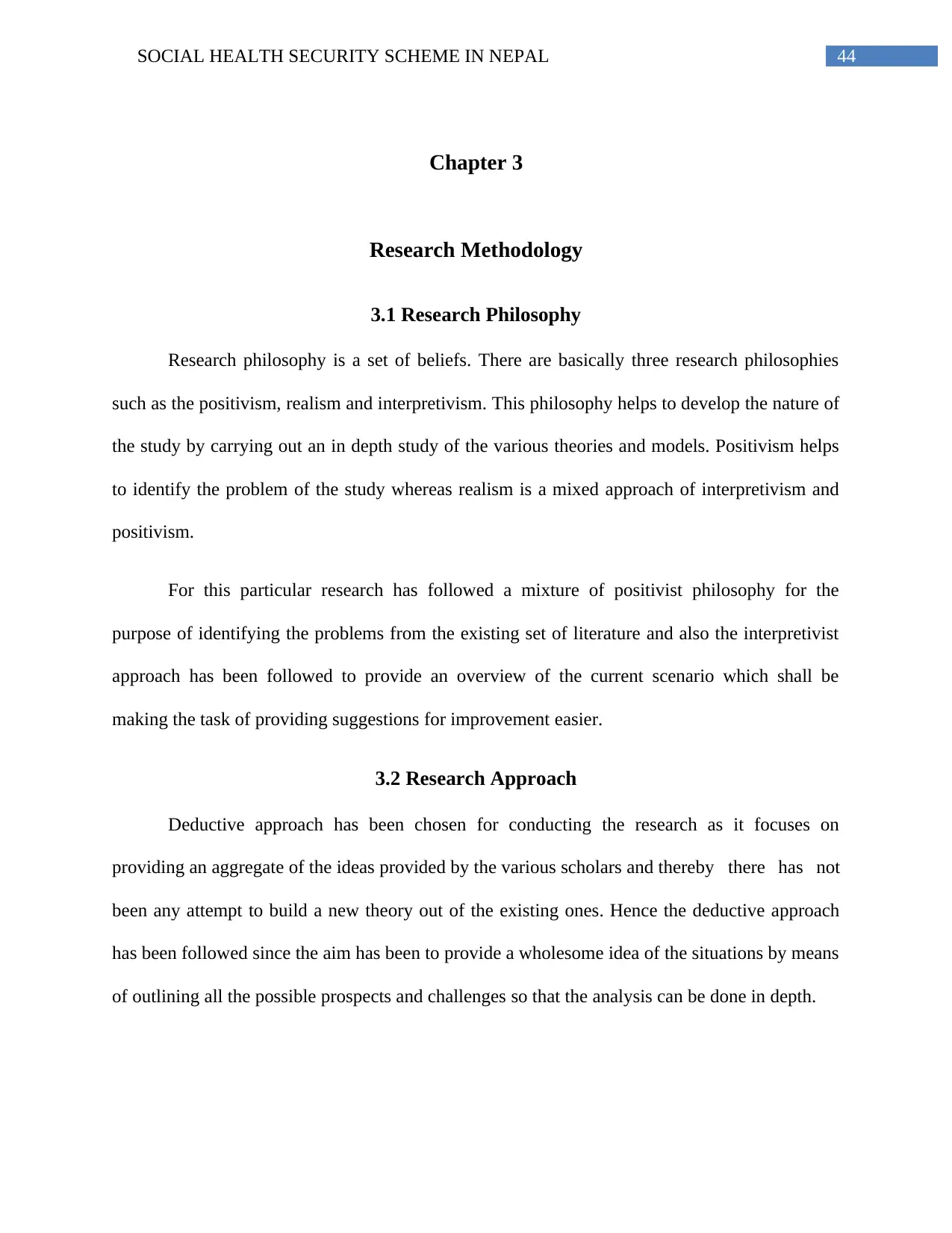
44SOCIAL HEALTH SECURITY SCHEME IN NEPAL
Chapter 3
Research Methodology
3.1 Research Philosophy
Research philosophy is a set of beliefs. There are basically three research philosophies
such as the positivism, realism and interpretivism. This philosophy helps to develop the nature of
the study by carrying out an in depth study of the various theories and models. Positivism helps
to identify the problem of the study whereas realism is a mixed approach of interpretivism and
positivism.
For this particular research has followed a mixture of positivist philosophy for the
purpose of identifying the problems from the existing set of literature and also the interpretivist
approach has been followed to provide an overview of the current scenario which shall be
making the task of providing suggestions for improvement easier.
3.2 Research Approach
Deductive approach has been chosen for conducting the research as it focuses on
providing an aggregate of the ideas provided by the various scholars and thereby there has not
been any attempt to build a new theory out of the existing ones. Hence the deductive approach
has been followed since the aim has been to provide a wholesome idea of the situations by means
of outlining all the possible prospects and challenges so that the analysis can be done in depth.
Chapter 3
Research Methodology
3.1 Research Philosophy
Research philosophy is a set of beliefs. There are basically three research philosophies
such as the positivism, realism and interpretivism. This philosophy helps to develop the nature of
the study by carrying out an in depth study of the various theories and models. Positivism helps
to identify the problem of the study whereas realism is a mixed approach of interpretivism and
positivism.
For this particular research has followed a mixture of positivist philosophy for the
purpose of identifying the problems from the existing set of literature and also the interpretivist
approach has been followed to provide an overview of the current scenario which shall be
making the task of providing suggestions for improvement easier.
3.2 Research Approach
Deductive approach has been chosen for conducting the research as it focuses on
providing an aggregate of the ideas provided by the various scholars and thereby there has not
been any attempt to build a new theory out of the existing ones. Hence the deductive approach
has been followed since the aim has been to provide a wholesome idea of the situations by means
of outlining all the possible prospects and challenges so that the analysis can be done in depth.
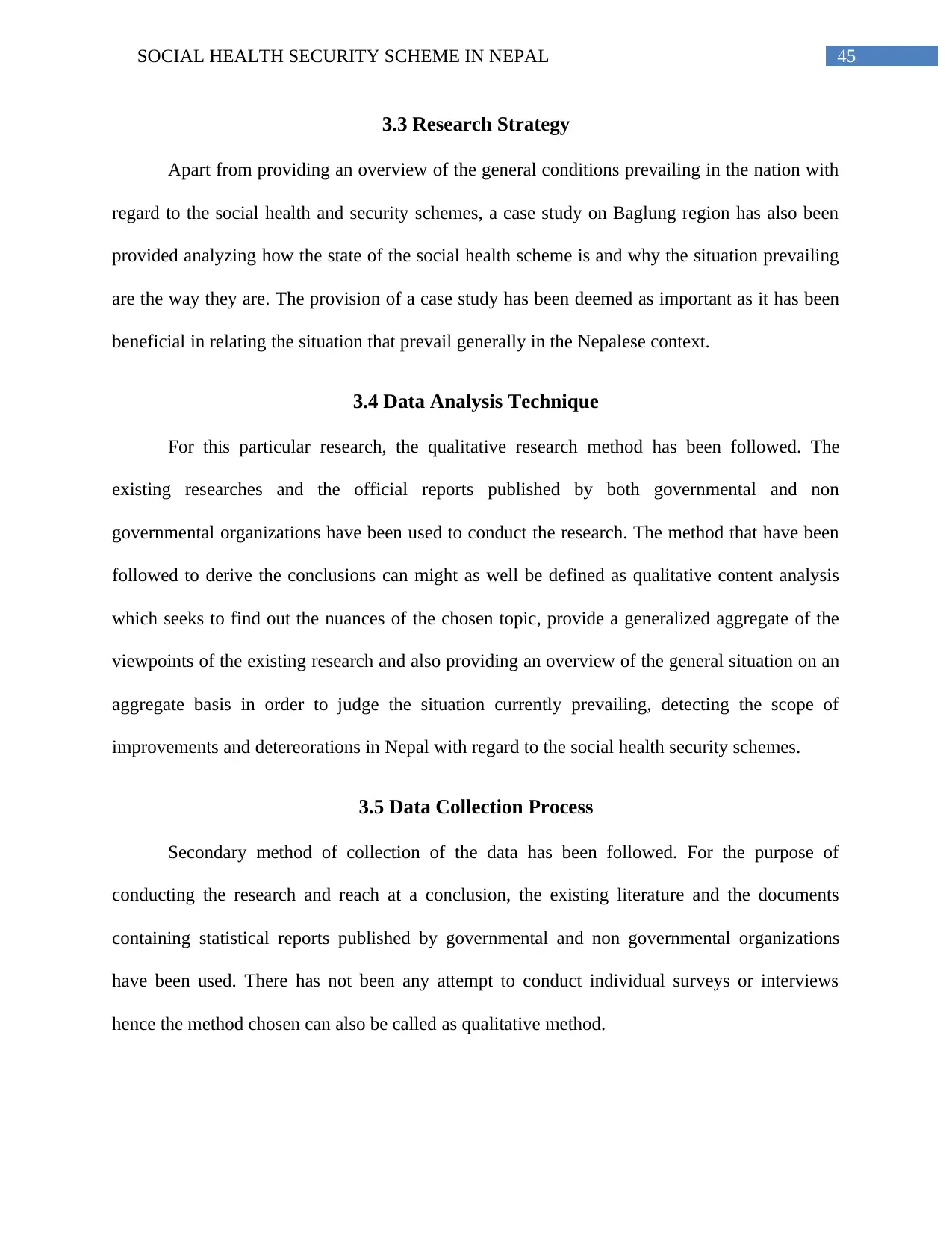
45SOCIAL HEALTH SECURITY SCHEME IN NEPAL
3.3 Research Strategy
Apart from providing an overview of the general conditions prevailing in the nation with
regard to the social health and security schemes, a case study on Baglung region has also been
provided analyzing how the state of the social health scheme is and why the situation prevailing
are the way they are. The provision of a case study has been deemed as important as it has been
beneficial in relating the situation that prevail generally in the Nepalese context.
3.4 Data Analysis Technique
For this particular research, the qualitative research method has been followed. The
existing researches and the official reports published by both governmental and non
governmental organizations have been used to conduct the research. The method that have been
followed to derive the conclusions can might as well be defined as qualitative content analysis
which seeks to find out the nuances of the chosen topic, provide a generalized aggregate of the
viewpoints of the existing research and also providing an overview of the general situation on an
aggregate basis in order to judge the situation currently prevailing, detecting the scope of
improvements and detereorations in Nepal with regard to the social health security schemes.
3.5 Data Collection Process
Secondary method of collection of the data has been followed. For the purpose of
conducting the research and reach at a conclusion, the existing literature and the documents
containing statistical reports published by governmental and non governmental organizations
have been used. There has not been any attempt to conduct individual surveys or interviews
hence the method chosen can also be called as qualitative method.
3.3 Research Strategy
Apart from providing an overview of the general conditions prevailing in the nation with
regard to the social health and security schemes, a case study on Baglung region has also been
provided analyzing how the state of the social health scheme is and why the situation prevailing
are the way they are. The provision of a case study has been deemed as important as it has been
beneficial in relating the situation that prevail generally in the Nepalese context.
3.4 Data Analysis Technique
For this particular research, the qualitative research method has been followed. The
existing researches and the official reports published by both governmental and non
governmental organizations have been used to conduct the research. The method that have been
followed to derive the conclusions can might as well be defined as qualitative content analysis
which seeks to find out the nuances of the chosen topic, provide a generalized aggregate of the
viewpoints of the existing research and also providing an overview of the general situation on an
aggregate basis in order to judge the situation currently prevailing, detecting the scope of
improvements and detereorations in Nepal with regard to the social health security schemes.
3.5 Data Collection Process
Secondary method of collection of the data has been followed. For the purpose of
conducting the research and reach at a conclusion, the existing literature and the documents
containing statistical reports published by governmental and non governmental organizations
have been used. There has not been any attempt to conduct individual surveys or interviews
hence the method chosen can also be called as qualitative method.
Secure Best Marks with AI Grader
Need help grading? Try our AI Grader for instant feedback on your assignments.
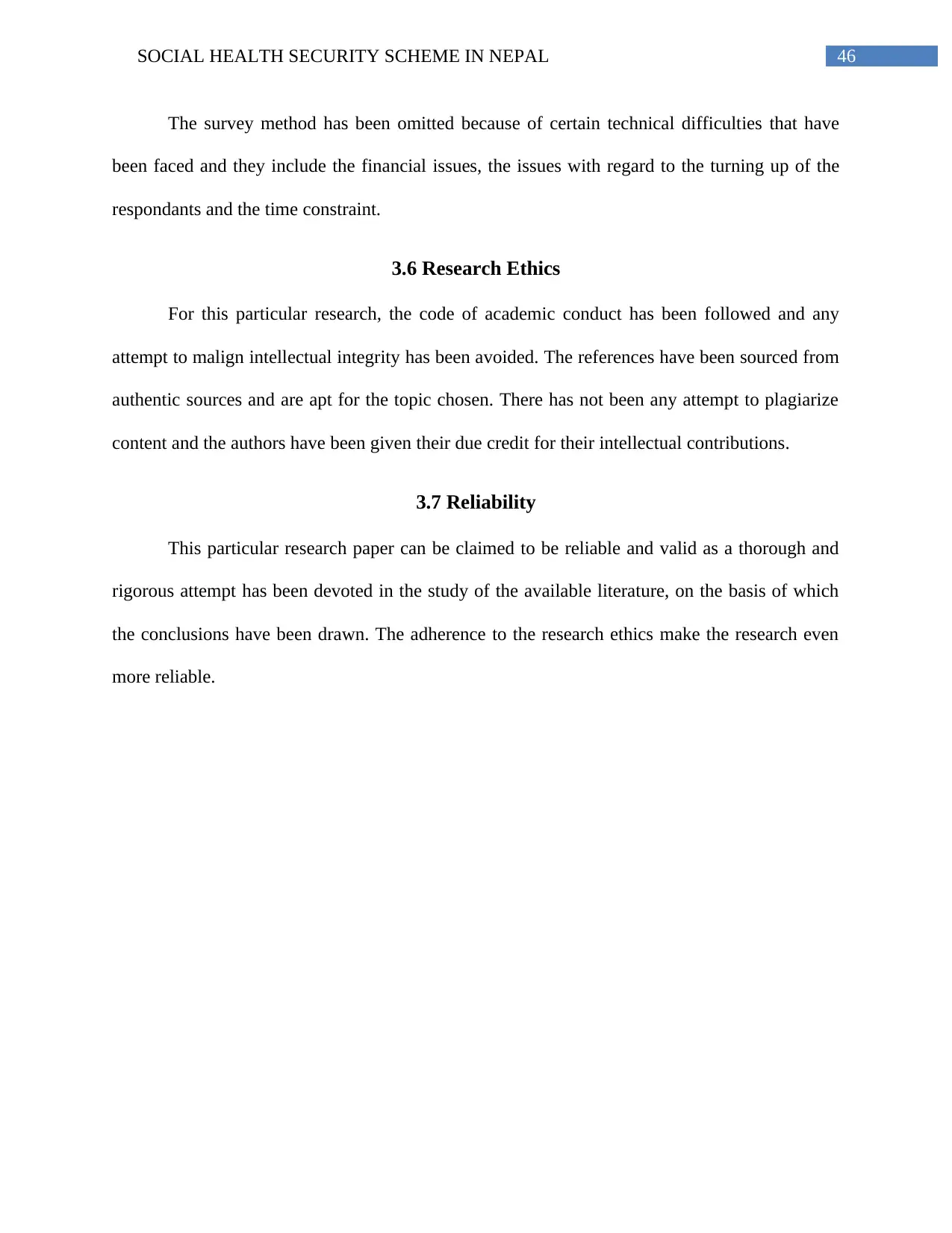
46SOCIAL HEALTH SECURITY SCHEME IN NEPAL
The survey method has been omitted because of certain technical difficulties that have
been faced and they include the financial issues, the issues with regard to the turning up of the
respondants and the time constraint.
3.6 Research Ethics
For this particular research, the code of academic conduct has been followed and any
attempt to malign intellectual integrity has been avoided. The references have been sourced from
authentic sources and are apt for the topic chosen. There has not been any attempt to plagiarize
content and the authors have been given their due credit for their intellectual contributions.
3.7 Reliability
This particular research paper can be claimed to be reliable and valid as a thorough and
rigorous attempt has been devoted in the study of the available literature, on the basis of which
the conclusions have been drawn. The adherence to the research ethics make the research even
more reliable.
The survey method has been omitted because of certain technical difficulties that have
been faced and they include the financial issues, the issues with regard to the turning up of the
respondants and the time constraint.
3.6 Research Ethics
For this particular research, the code of academic conduct has been followed and any
attempt to malign intellectual integrity has been avoided. The references have been sourced from
authentic sources and are apt for the topic chosen. There has not been any attempt to plagiarize
content and the authors have been given their due credit for their intellectual contributions.
3.7 Reliability
This particular research paper can be claimed to be reliable and valid as a thorough and
rigorous attempt has been devoted in the study of the available literature, on the basis of which
the conclusions have been drawn. The adherence to the research ethics make the research even
more reliable.
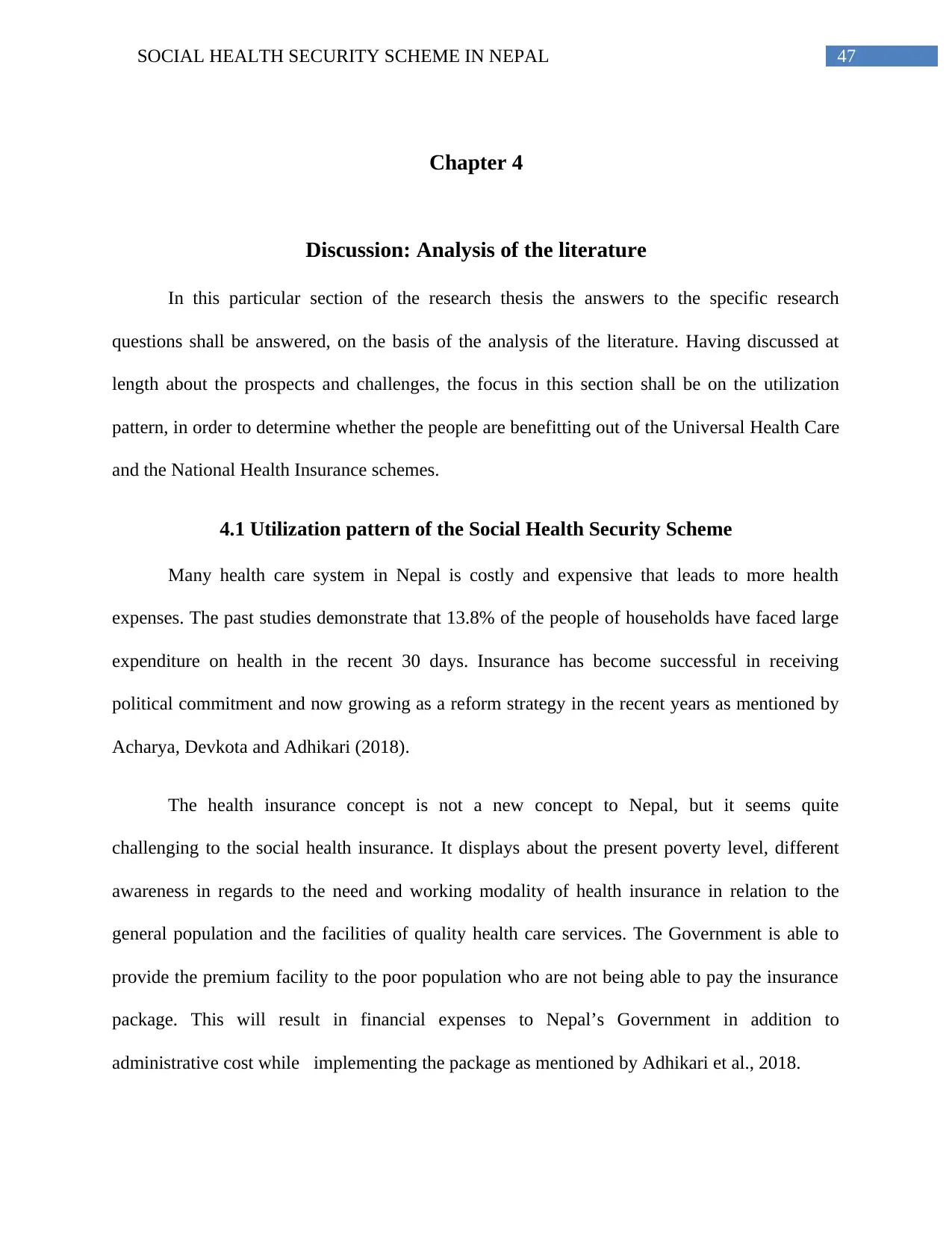
47SOCIAL HEALTH SECURITY SCHEME IN NEPAL
Chapter 4
Discussion: Analysis of the literature
In this particular section of the research thesis the answers to the specific research
questions shall be answered, on the basis of the analysis of the literature. Having discussed at
length about the prospects and challenges, the focus in this section shall be on the utilization
pattern, in order to determine whether the people are benefitting out of the Universal Health Care
and the National Health Insurance schemes.
4.1 Utilization pattern of the Social Health Security Scheme
Many health care system in Nepal is costly and expensive that leads to more health
expenses. The past studies demonstrate that 13.8% of the people of households have faced large
expenditure on health in the recent 30 days. Insurance has become successful in receiving
political commitment and now growing as a reform strategy in the recent years as mentioned by
Acharya, Devkota and Adhikari (2018).
The health insurance concept is not a new concept to Nepal, but it seems quite
challenging to the social health insurance. It displays about the present poverty level, different
awareness in regards to the need and working modality of health insurance in relation to the
general population and the facilities of quality health care services. The Government is able to
provide the premium facility to the poor population who are not being able to pay the insurance
package. This will result in financial expenses to Nepal’s Government in addition to
administrative cost while implementing the package as mentioned by Adhikari et al., 2018.
Chapter 4
Discussion: Analysis of the literature
In this particular section of the research thesis the answers to the specific research
questions shall be answered, on the basis of the analysis of the literature. Having discussed at
length about the prospects and challenges, the focus in this section shall be on the utilization
pattern, in order to determine whether the people are benefitting out of the Universal Health Care
and the National Health Insurance schemes.
4.1 Utilization pattern of the Social Health Security Scheme
Many health care system in Nepal is costly and expensive that leads to more health
expenses. The past studies demonstrate that 13.8% of the people of households have faced large
expenditure on health in the recent 30 days. Insurance has become successful in receiving
political commitment and now growing as a reform strategy in the recent years as mentioned by
Acharya, Devkota and Adhikari (2018).
The health insurance concept is not a new concept to Nepal, but it seems quite
challenging to the social health insurance. It displays about the present poverty level, different
awareness in regards to the need and working modality of health insurance in relation to the
general population and the facilities of quality health care services. The Government is able to
provide the premium facility to the poor population who are not being able to pay the insurance
package. This will result in financial expenses to Nepal’s Government in addition to
administrative cost while implementing the package as mentioned by Adhikari et al., 2018.
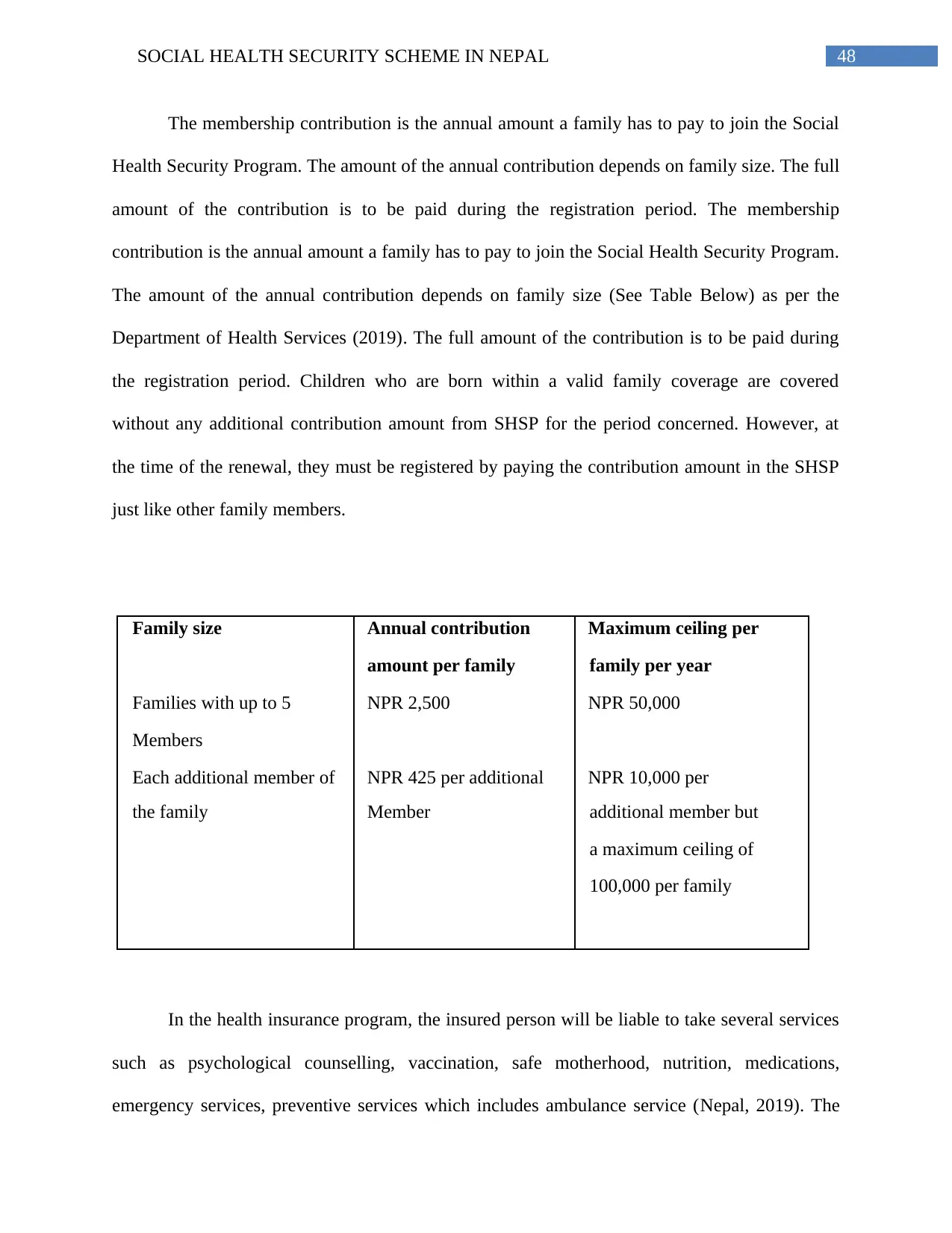
48SOCIAL HEALTH SECURITY SCHEME IN NEPAL
The membership contribution is the annual amount a family has to pay to join the Social
Health Security Program. The amount of the annual contribution depends on family size. The full
amount of the contribution is to be paid during the registration period. The membership
contribution is the annual amount a family has to pay to join the Social Health Security Program.
The amount of the annual contribution depends on family size (See Table Below) as per the
Department of Health Services (2019). The full amount of the contribution is to be paid during
the registration period. Children who are born within a valid family coverage are covered
without any additional contribution amount from SHSP for the period concerned. However, at
the time of the renewal, they must be registered by paying the contribution amount in the SHSP
just like other family members.
Family size Annual contribution Maximum ceiling per
amount per family family per year
Families with up to 5 NPR 2,500 NPR 50,000
Members
Each additional member of NPR 425 per additional NPR 10,000 per
the family Member additional member but
a maximum ceiling of
100,000 per family
In the health insurance program, the insured person will be liable to take several services
such as psychological counselling, vaccination, safe motherhood, nutrition, medications,
emergency services, preventive services which includes ambulance service (Nepal, 2019). The
The membership contribution is the annual amount a family has to pay to join the Social
Health Security Program. The amount of the annual contribution depends on family size. The full
amount of the contribution is to be paid during the registration period. The membership
contribution is the annual amount a family has to pay to join the Social Health Security Program.
The amount of the annual contribution depends on family size (See Table Below) as per the
Department of Health Services (2019). The full amount of the contribution is to be paid during
the registration period. Children who are born within a valid family coverage are covered
without any additional contribution amount from SHSP for the period concerned. However, at
the time of the renewal, they must be registered by paying the contribution amount in the SHSP
just like other family members.
Family size Annual contribution Maximum ceiling per
amount per family family per year
Families with up to 5 NPR 2,500 NPR 50,000
Members
Each additional member of NPR 425 per additional NPR 10,000 per
the family Member additional member but
a maximum ceiling of
100,000 per family
In the health insurance program, the insured person will be liable to take several services
such as psychological counselling, vaccination, safe motherhood, nutrition, medications,
emergency services, preventive services which includes ambulance service (Nepal, 2019). The
Paraphrase This Document
Need a fresh take? Get an instant paraphrase of this document with our AI Paraphraser
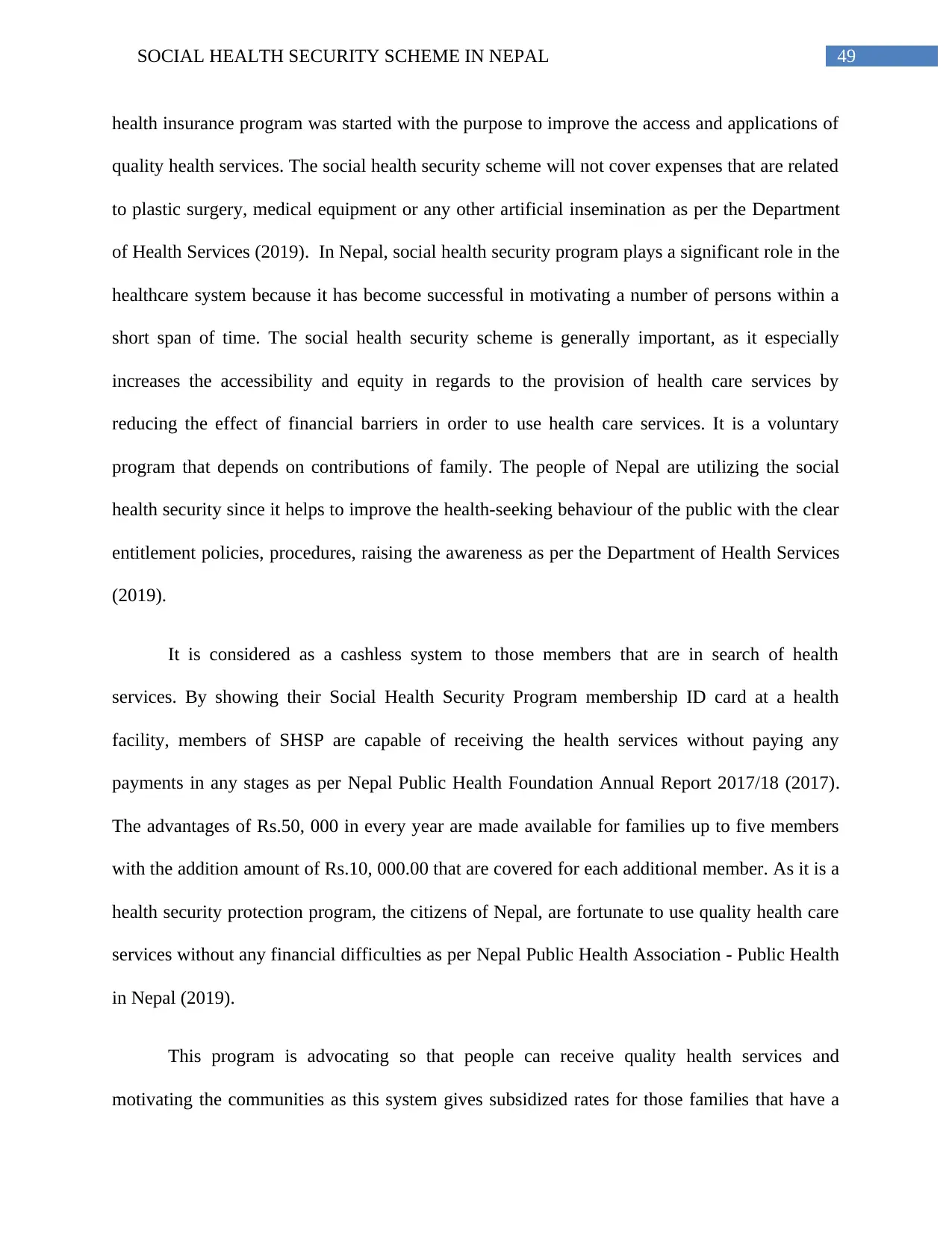
49SOCIAL HEALTH SECURITY SCHEME IN NEPAL
health insurance program was started with the purpose to improve the access and applications of
quality health services. The social health security scheme will not cover expenses that are related
to plastic surgery, medical equipment or any other artificial insemination as per the Department
of Health Services (2019). In Nepal, social health security program plays a significant role in the
healthcare system because it has become successful in motivating a number of persons within a
short span of time. The social health security scheme is generally important, as it especially
increases the accessibility and equity in regards to the provision of health care services by
reducing the effect of financial barriers in order to use health care services. It is a voluntary
program that depends on contributions of family. The people of Nepal are utilizing the social
health security since it helps to improve the health-seeking behaviour of the public with the clear
entitlement policies, procedures, raising the awareness as per the Department of Health Services
(2019).
It is considered as a cashless system to those members that are in search of health
services. By showing their Social Health Security Program membership ID card at a health
facility, members of SHSP are capable of receiving the health services without paying any
payments in any stages as per Nepal Public Health Foundation Annual Report 2017/18 (2017).
The advantages of Rs.50, 000 in every year are made available for families up to five members
with the addition amount of Rs.10, 000.00 that are covered for each additional member. As it is a
health security protection program, the citizens of Nepal, are fortunate to use quality health care
services without any financial difficulties as per Nepal Public Health Association - Public Health
in Nepal (2019).
This program is advocating so that people can receive quality health services and
motivating the communities as this system gives subsidized rates for those families that have a
health insurance program was started with the purpose to improve the access and applications of
quality health services. The social health security scheme will not cover expenses that are related
to plastic surgery, medical equipment or any other artificial insemination as per the Department
of Health Services (2019). In Nepal, social health security program plays a significant role in the
healthcare system because it has become successful in motivating a number of persons within a
short span of time. The social health security scheme is generally important, as it especially
increases the accessibility and equity in regards to the provision of health care services by
reducing the effect of financial barriers in order to use health care services. It is a voluntary
program that depends on contributions of family. The people of Nepal are utilizing the social
health security since it helps to improve the health-seeking behaviour of the public with the clear
entitlement policies, procedures, raising the awareness as per the Department of Health Services
(2019).
It is considered as a cashless system to those members that are in search of health
services. By showing their Social Health Security Program membership ID card at a health
facility, members of SHSP are capable of receiving the health services without paying any
payments in any stages as per Nepal Public Health Foundation Annual Report 2017/18 (2017).
The advantages of Rs.50, 000 in every year are made available for families up to five members
with the addition amount of Rs.10, 000.00 that are covered for each additional member. As it is a
health security protection program, the citizens of Nepal, are fortunate to use quality health care
services without any financial difficulties as per Nepal Public Health Association - Public Health
in Nepal (2019).
This program is advocating so that people can receive quality health services and
motivating the communities as this system gives subsidized rates for those families that have a
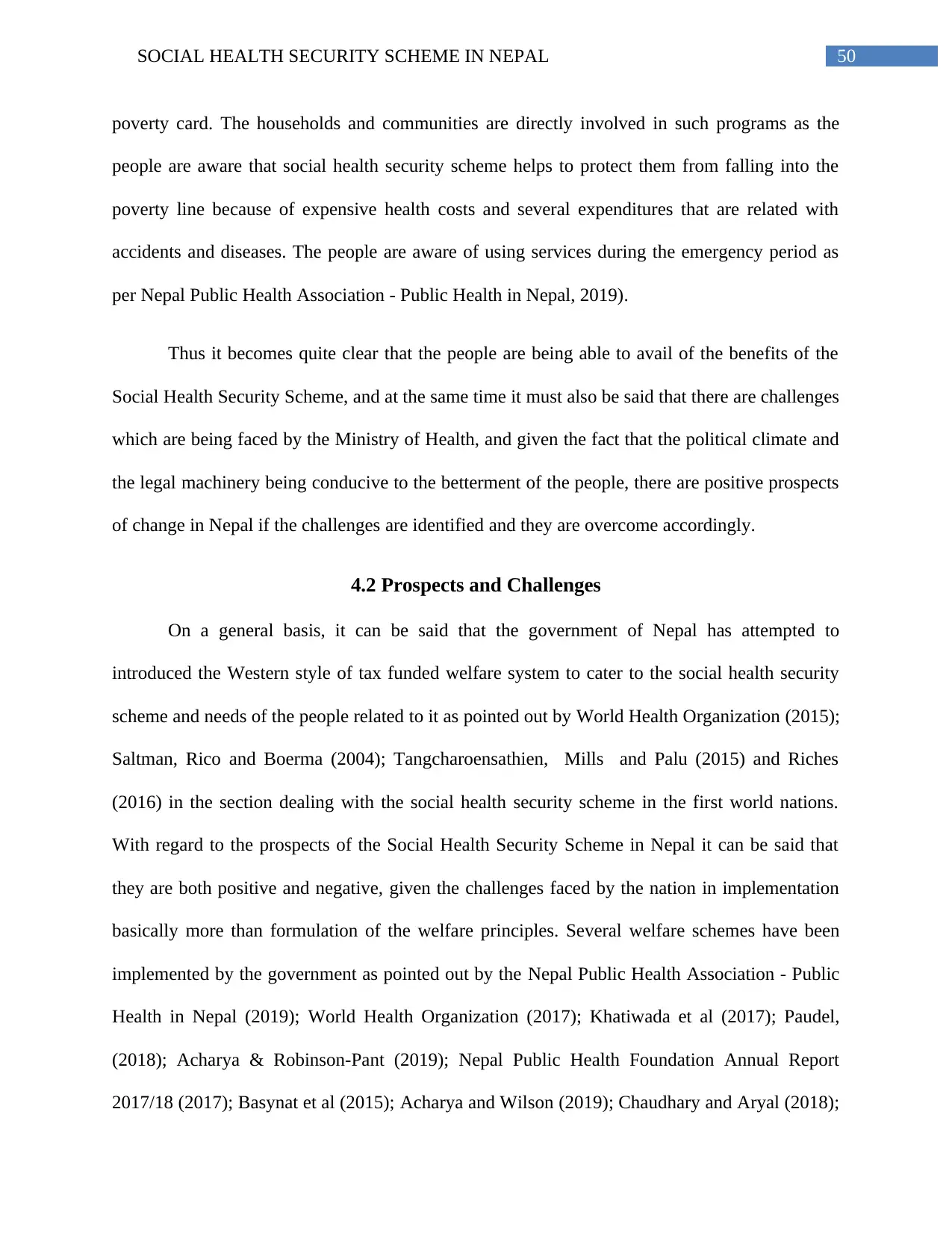
50SOCIAL HEALTH SECURITY SCHEME IN NEPAL
poverty card. The households and communities are directly involved in such programs as the
people are aware that social health security scheme helps to protect them from falling into the
poverty line because of expensive health costs and several expenditures that are related with
accidents and diseases. The people are aware of using services during the emergency period as
per Nepal Public Health Association - Public Health in Nepal, 2019).
Thus it becomes quite clear that the people are being able to avail of the benefits of the
Social Health Security Scheme, and at the same time it must also be said that there are challenges
which are being faced by the Ministry of Health, and given the fact that the political climate and
the legal machinery being conducive to the betterment of the people, there are positive prospects
of change in Nepal if the challenges are identified and they are overcome accordingly.
4.2 Prospects and Challenges
On a general basis, it can be said that the government of Nepal has attempted to
introduced the Western style of tax funded welfare system to cater to the social health security
scheme and needs of the people related to it as pointed out by World Health Organization (2015);
Saltman, Rico and Boerma (2004); Tangcharoensathien, Mills and Palu (2015) and Riches
(2016) in the section dealing with the social health security scheme in the first world nations.
With regard to the prospects of the Social Health Security Scheme in Nepal it can be said that
they are both positive and negative, given the challenges faced by the nation in implementation
basically more than formulation of the welfare principles. Several welfare schemes have been
implemented by the government as pointed out by the Nepal Public Health Association - Public
Health in Nepal (2019); World Health Organization (2017); Khatiwada et al (2017); Paudel,
(2018); Acharya & Robinson-Pant (2019); Nepal Public Health Foundation Annual Report
2017/18 (2017); Basynat et al (2015); Acharya and Wilson (2019); Chaudhary and Aryal (2018);
poverty card. The households and communities are directly involved in such programs as the
people are aware that social health security scheme helps to protect them from falling into the
poverty line because of expensive health costs and several expenditures that are related with
accidents and diseases. The people are aware of using services during the emergency period as
per Nepal Public Health Association - Public Health in Nepal, 2019).
Thus it becomes quite clear that the people are being able to avail of the benefits of the
Social Health Security Scheme, and at the same time it must also be said that there are challenges
which are being faced by the Ministry of Health, and given the fact that the political climate and
the legal machinery being conducive to the betterment of the people, there are positive prospects
of change in Nepal if the challenges are identified and they are overcome accordingly.
4.2 Prospects and Challenges
On a general basis, it can be said that the government of Nepal has attempted to
introduced the Western style of tax funded welfare system to cater to the social health security
scheme and needs of the people related to it as pointed out by World Health Organization (2015);
Saltman, Rico and Boerma (2004); Tangcharoensathien, Mills and Palu (2015) and Riches
(2016) in the section dealing with the social health security scheme in the first world nations.
With regard to the prospects of the Social Health Security Scheme in Nepal it can be said that
they are both positive and negative, given the challenges faced by the nation in implementation
basically more than formulation of the welfare principles. Several welfare schemes have been
implemented by the government as pointed out by the Nepal Public Health Association - Public
Health in Nepal (2019); World Health Organization (2017); Khatiwada et al (2017); Paudel,
(2018); Acharya & Robinson-Pant (2019); Nepal Public Health Foundation Annual Report
2017/18 (2017); Basynat et al (2015); Acharya and Wilson (2019); Chaudhary and Aryal (2018);
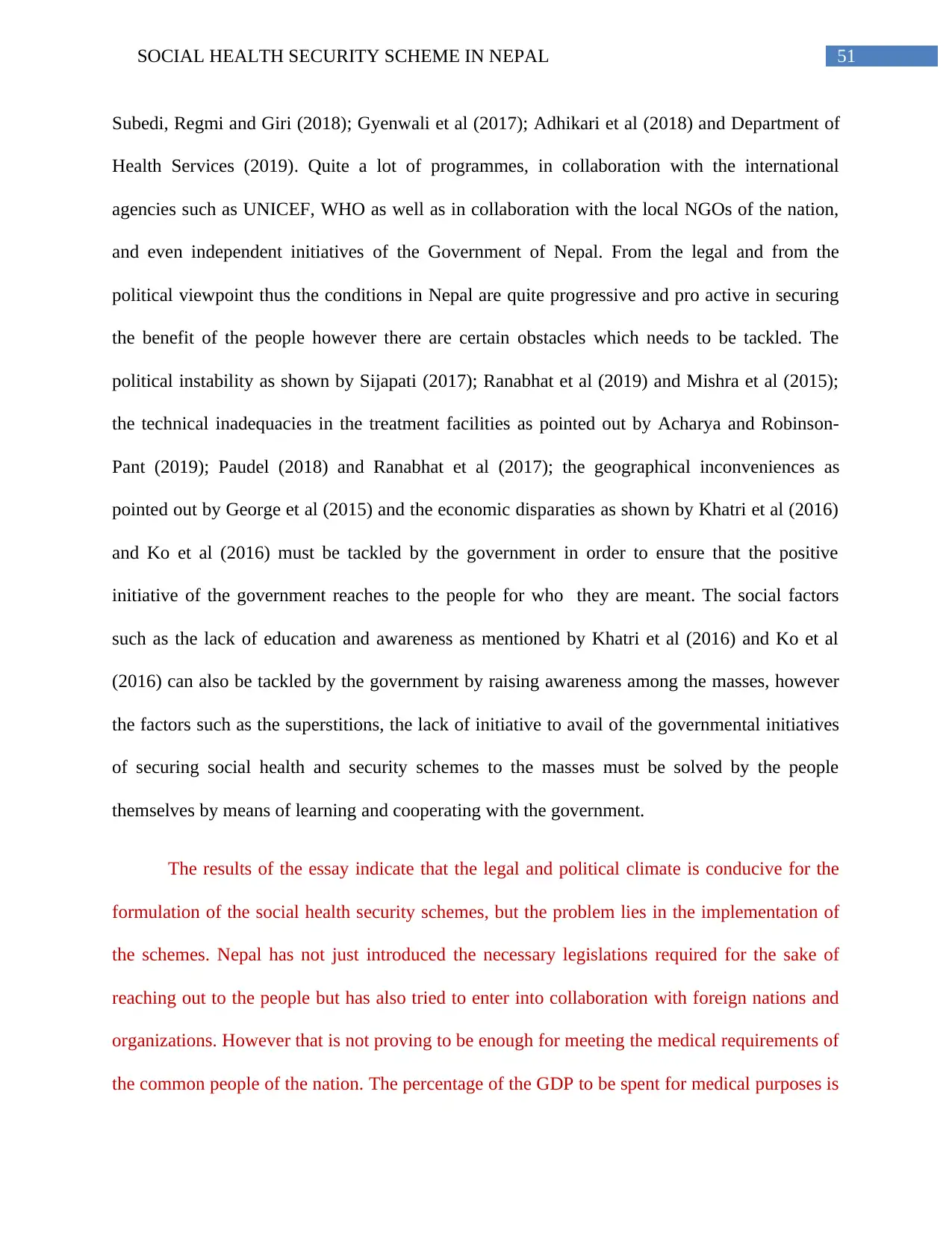
51SOCIAL HEALTH SECURITY SCHEME IN NEPAL
Subedi, Regmi and Giri (2018); Gyenwali et al (2017); Adhikari et al (2018) and Department of
Health Services (2019). Quite a lot of programmes, in collaboration with the international
agencies such as UNICEF, WHO as well as in collaboration with the local NGOs of the nation,
and even independent initiatives of the Government of Nepal. From the legal and from the
political viewpoint thus the conditions in Nepal are quite progressive and pro active in securing
the benefit of the people however there are certain obstacles which needs to be tackled. The
political instability as shown by Sijapati (2017); Ranabhat et al (2019) and Mishra et al (2015);
the technical inadequacies in the treatment facilities as pointed out by Acharya and Robinson-
Pant (2019); Paudel (2018) and Ranabhat et al (2017); the geographical inconveniences as
pointed out by George et al (2015) and the economic disparaties as shown by Khatri et al (2016)
and Ko et al (2016) must be tackled by the government in order to ensure that the positive
initiative of the government reaches to the people for who they are meant. The social factors
such as the lack of education and awareness as mentioned by Khatri et al (2016) and Ko et al
(2016) can also be tackled by the government by raising awareness among the masses, however
the factors such as the superstitions, the lack of initiative to avail of the governmental initiatives
of securing social health and security schemes to the masses must be solved by the people
themselves by means of learning and cooperating with the government.
The results of the essay indicate that the legal and political climate is conducive for the
formulation of the social health security schemes, but the problem lies in the implementation of
the schemes. Nepal has not just introduced the necessary legislations required for the sake of
reaching out to the people but has also tried to enter into collaboration with foreign nations and
organizations. However that is not proving to be enough for meeting the medical requirements of
the common people of the nation. The percentage of the GDP to be spent for medical purposes is
Subedi, Regmi and Giri (2018); Gyenwali et al (2017); Adhikari et al (2018) and Department of
Health Services (2019). Quite a lot of programmes, in collaboration with the international
agencies such as UNICEF, WHO as well as in collaboration with the local NGOs of the nation,
and even independent initiatives of the Government of Nepal. From the legal and from the
political viewpoint thus the conditions in Nepal are quite progressive and pro active in securing
the benefit of the people however there are certain obstacles which needs to be tackled. The
political instability as shown by Sijapati (2017); Ranabhat et al (2019) and Mishra et al (2015);
the technical inadequacies in the treatment facilities as pointed out by Acharya and Robinson-
Pant (2019); Paudel (2018) and Ranabhat et al (2017); the geographical inconveniences as
pointed out by George et al (2015) and the economic disparaties as shown by Khatri et al (2016)
and Ko et al (2016) must be tackled by the government in order to ensure that the positive
initiative of the government reaches to the people for who they are meant. The social factors
such as the lack of education and awareness as mentioned by Khatri et al (2016) and Ko et al
(2016) can also be tackled by the government by raising awareness among the masses, however
the factors such as the superstitions, the lack of initiative to avail of the governmental initiatives
of securing social health and security schemes to the masses must be solved by the people
themselves by means of learning and cooperating with the government.
The results of the essay indicate that the legal and political climate is conducive for the
formulation of the social health security schemes, but the problem lies in the implementation of
the schemes. Nepal has not just introduced the necessary legislations required for the sake of
reaching out to the people but has also tried to enter into collaboration with foreign nations and
organizations. However that is not proving to be enough for meeting the medical requirements of
the common people of the nation. The percentage of the GDP to be spent for medical purposes is
Secure Best Marks with AI Grader
Need help grading? Try our AI Grader for instant feedback on your assignments.
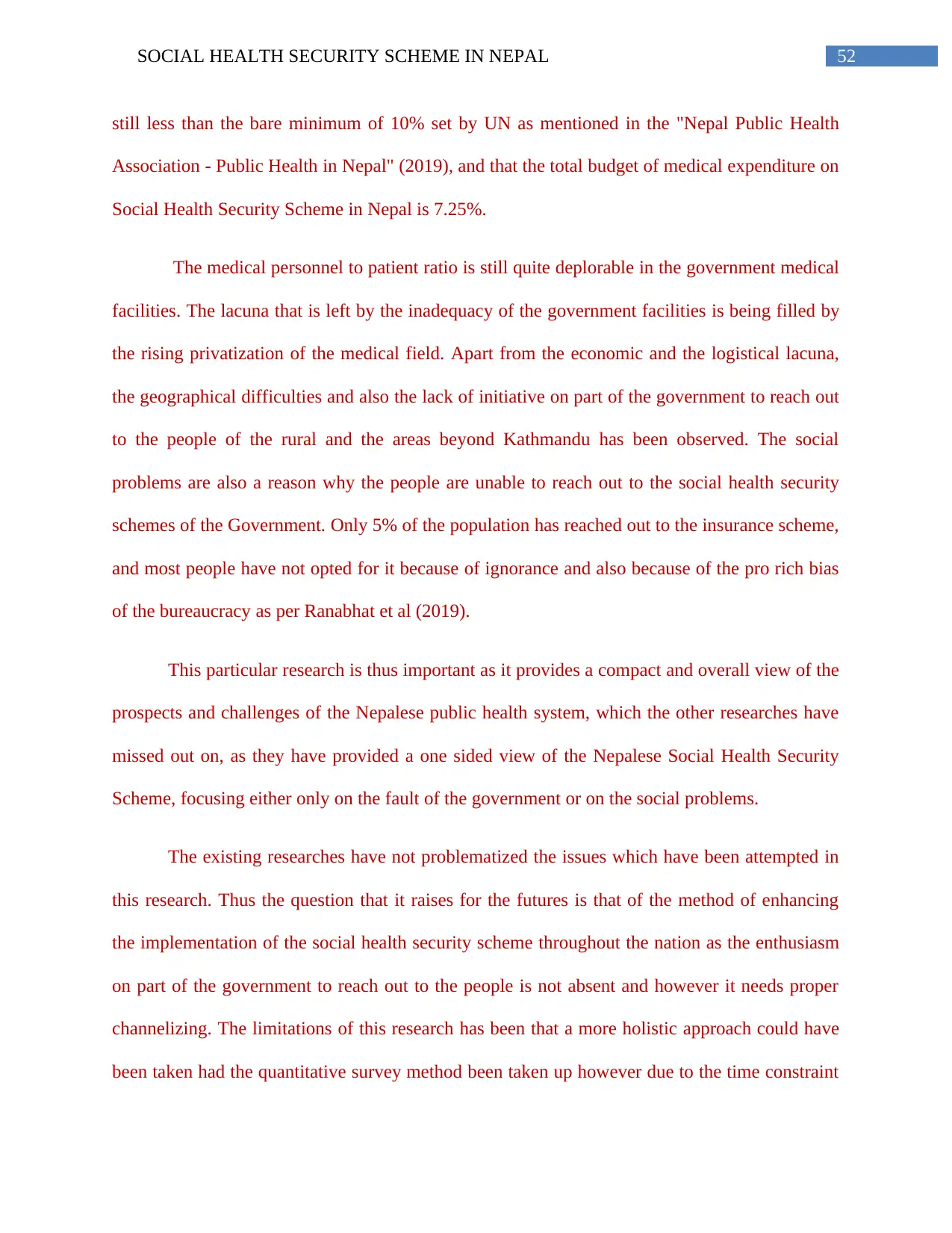
52SOCIAL HEALTH SECURITY SCHEME IN NEPAL
still less than the bare minimum of 10% set by UN as mentioned in the "Nepal Public Health
Association - Public Health in Nepal" (2019), and that the total budget of medical expenditure on
Social Health Security Scheme in Nepal is 7.25%.
The medical personnel to patient ratio is still quite deplorable in the government medical
facilities. The lacuna that is left by the inadequacy of the government facilities is being filled by
the rising privatization of the medical field. Apart from the economic and the logistical lacuna,
the geographical difficulties and also the lack of initiative on part of the government to reach out
to the people of the rural and the areas beyond Kathmandu has been observed. The social
problems are also a reason why the people are unable to reach out to the social health security
schemes of the Government. Only 5% of the population has reached out to the insurance scheme,
and most people have not opted for it because of ignorance and also because of the pro rich bias
of the bureaucracy as per Ranabhat et al (2019).
This particular research is thus important as it provides a compact and overall view of the
prospects and challenges of the Nepalese public health system, which the other researches have
missed out on, as they have provided a one sided view of the Nepalese Social Health Security
Scheme, focusing either only on the fault of the government or on the social problems.
The existing researches have not problematized the issues which have been attempted in
this research. Thus the question that it raises for the futures is that of the method of enhancing
the implementation of the social health security scheme throughout the nation as the enthusiasm
on part of the government to reach out to the people is not absent and however it needs proper
channelizing. The limitations of this research has been that a more holistic approach could have
been taken had the quantitative survey method been taken up however due to the time constraint
still less than the bare minimum of 10% set by UN as mentioned in the "Nepal Public Health
Association - Public Health in Nepal" (2019), and that the total budget of medical expenditure on
Social Health Security Scheme in Nepal is 7.25%.
The medical personnel to patient ratio is still quite deplorable in the government medical
facilities. The lacuna that is left by the inadequacy of the government facilities is being filled by
the rising privatization of the medical field. Apart from the economic and the logistical lacuna,
the geographical difficulties and also the lack of initiative on part of the government to reach out
to the people of the rural and the areas beyond Kathmandu has been observed. The social
problems are also a reason why the people are unable to reach out to the social health security
schemes of the Government. Only 5% of the population has reached out to the insurance scheme,
and most people have not opted for it because of ignorance and also because of the pro rich bias
of the bureaucracy as per Ranabhat et al (2019).
This particular research is thus important as it provides a compact and overall view of the
prospects and challenges of the Nepalese public health system, which the other researches have
missed out on, as they have provided a one sided view of the Nepalese Social Health Security
Scheme, focusing either only on the fault of the government or on the social problems.
The existing researches have not problematized the issues which have been attempted in
this research. Thus the question that it raises for the futures is that of the method of enhancing
the implementation of the social health security scheme throughout the nation as the enthusiasm
on part of the government to reach out to the people is not absent and however it needs proper
channelizing. The limitations of this research has been that a more holistic approach could have
been taken had the quantitative survey method been taken up however due to the time constraint
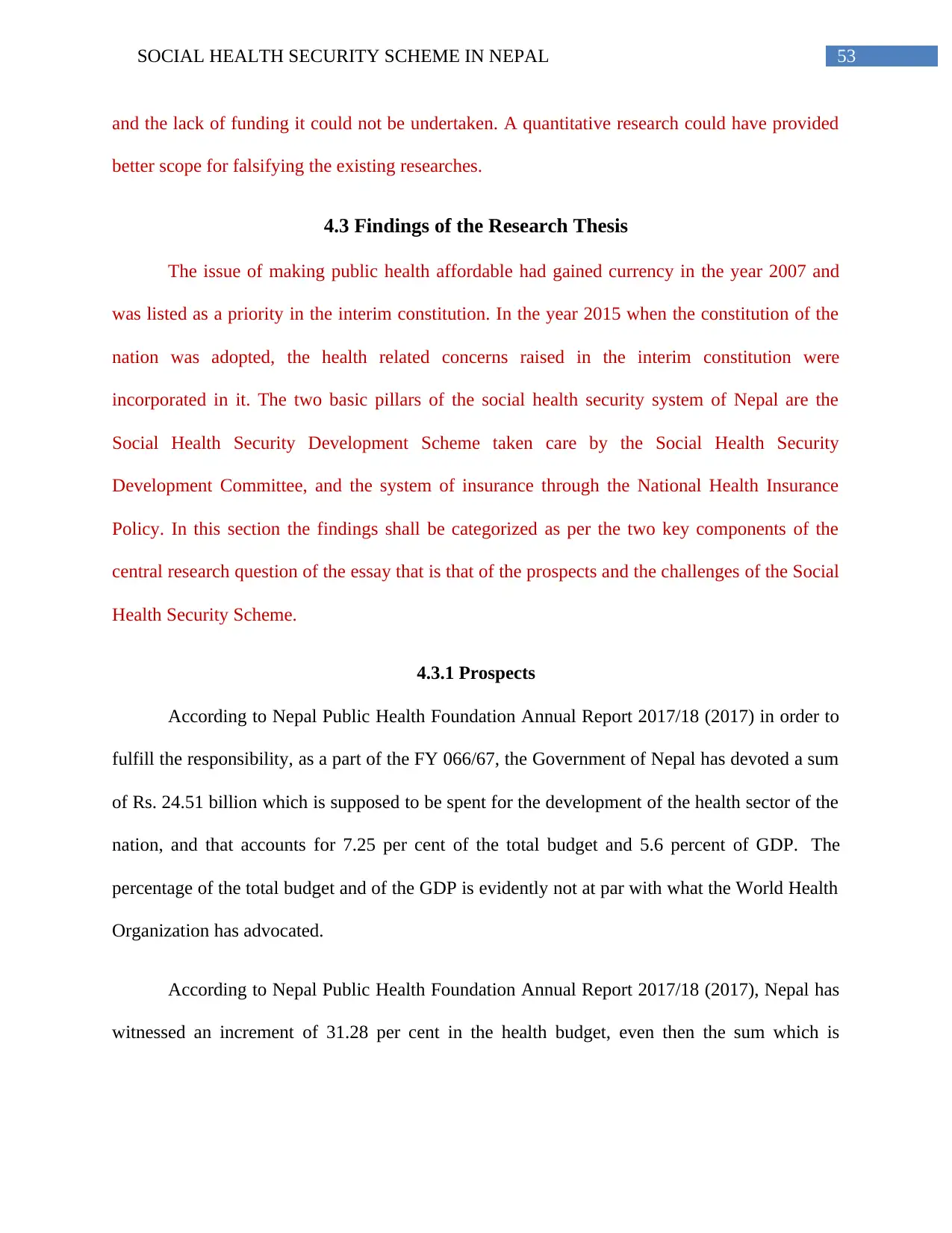
53SOCIAL HEALTH SECURITY SCHEME IN NEPAL
and the lack of funding it could not be undertaken. A quantitative research could have provided
better scope for falsifying the existing researches.
4.3 Findings of the Research Thesis
The issue of making public health affordable had gained currency in the year 2007 and
was listed as a priority in the interim constitution. In the year 2015 when the constitution of the
nation was adopted, the health related concerns raised in the interim constitution were
incorporated in it. The two basic pillars of the social health security system of Nepal are the
Social Health Security Development Scheme taken care by the Social Health Security
Development Committee, and the system of insurance through the National Health Insurance
Policy. In this section the findings shall be categorized as per the two key components of the
central research question of the essay that is that of the prospects and the challenges of the Social
Health Security Scheme.
4.3.1 Prospects
According to Nepal Public Health Foundation Annual Report 2017/18 (2017) in order to
fulfill the responsibility, as a part of the FY 066/67, the Government of Nepal has devoted a sum
of Rs. 24.51 billion which is supposed to be spent for the development of the health sector of the
nation, and that accounts for 7.25 per cent of the total budget and 5.6 percent of GDP. The
percentage of the total budget and of the GDP is evidently not at par with what the World Health
Organization has advocated.
According to Nepal Public Health Foundation Annual Report 2017/18 (2017), Nepal has
witnessed an increment of 31.28 per cent in the health budget, even then the sum which is
and the lack of funding it could not be undertaken. A quantitative research could have provided
better scope for falsifying the existing researches.
4.3 Findings of the Research Thesis
The issue of making public health affordable had gained currency in the year 2007 and
was listed as a priority in the interim constitution. In the year 2015 when the constitution of the
nation was adopted, the health related concerns raised in the interim constitution were
incorporated in it. The two basic pillars of the social health security system of Nepal are the
Social Health Security Development Scheme taken care by the Social Health Security
Development Committee, and the system of insurance through the National Health Insurance
Policy. In this section the findings shall be categorized as per the two key components of the
central research question of the essay that is that of the prospects and the challenges of the Social
Health Security Scheme.
4.3.1 Prospects
According to Nepal Public Health Foundation Annual Report 2017/18 (2017) in order to
fulfill the responsibility, as a part of the FY 066/67, the Government of Nepal has devoted a sum
of Rs. 24.51 billion which is supposed to be spent for the development of the health sector of the
nation, and that accounts for 7.25 per cent of the total budget and 5.6 percent of GDP. The
percentage of the total budget and of the GDP is evidently not at par with what the World Health
Organization has advocated.
According to Nepal Public Health Foundation Annual Report 2017/18 (2017), Nepal has
witnessed an increment of 31.28 per cent in the health budget, even then the sum which is
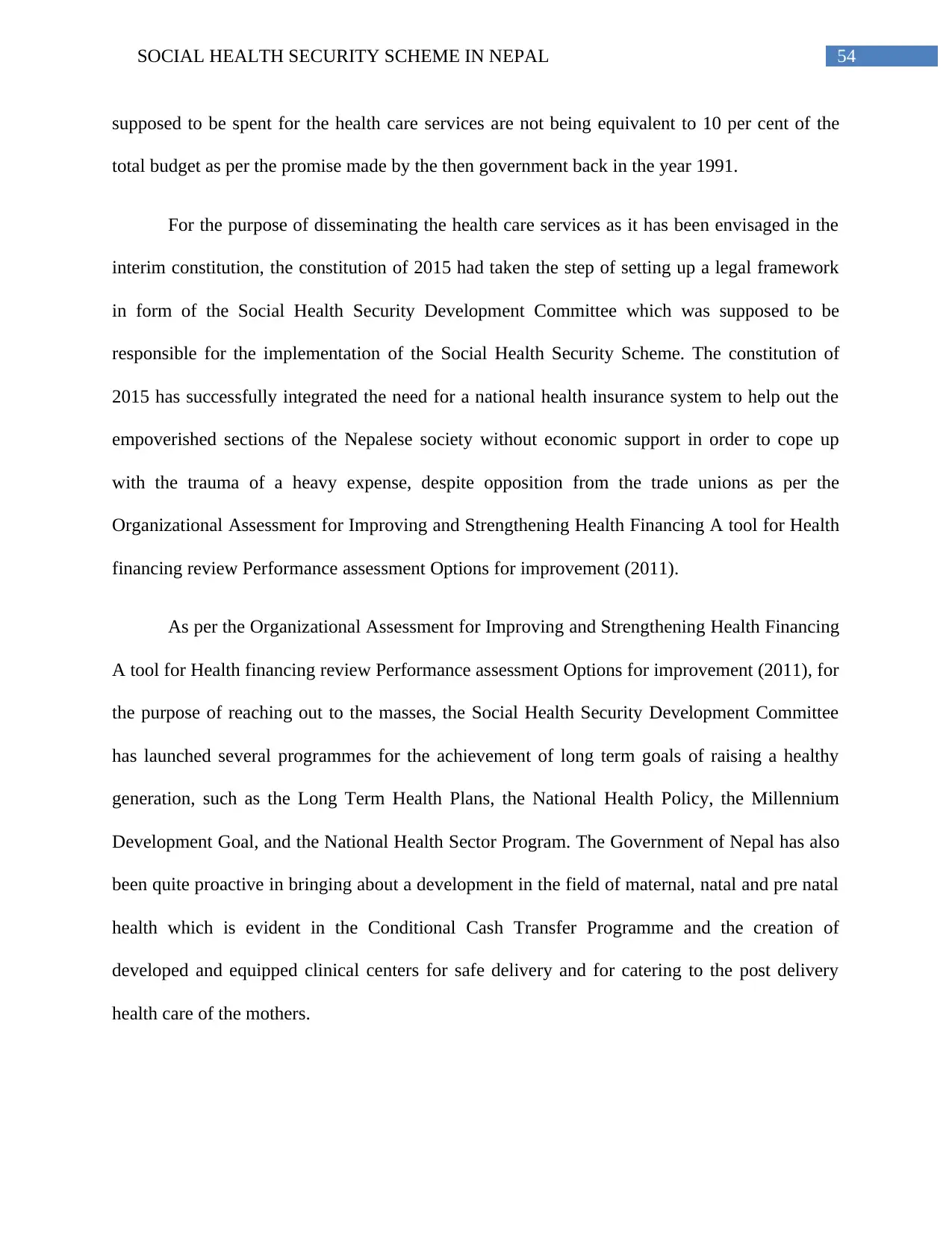
54SOCIAL HEALTH SECURITY SCHEME IN NEPAL
supposed to be spent for the health care services are not being equivalent to 10 per cent of the
total budget as per the promise made by the then government back in the year 1991.
For the purpose of disseminating the health care services as it has been envisaged in the
interim constitution, the constitution of 2015 had taken the step of setting up a legal framework
in form of the Social Health Security Development Committee which was supposed to be
responsible for the implementation of the Social Health Security Scheme. The constitution of
2015 has successfully integrated the need for a national health insurance system to help out the
empoverished sections of the Nepalese society without economic support in order to cope up
with the trauma of a heavy expense, despite opposition from the trade unions as per the
Organizational Assessment for Improving and Strengthening Health Financing A tool for Health
financing review Performance assessment Options for improvement (2011).
As per the Organizational Assessment for Improving and Strengthening Health Financing
A tool for Health financing review Performance assessment Options for improvement (2011), for
the purpose of reaching out to the masses, the Social Health Security Development Committee
has launched several programmes for the achievement of long term goals of raising a healthy
generation, such as the Long Term Health Plans, the National Health Policy, the Millennium
Development Goal, and the National Health Sector Program. The Government of Nepal has also
been quite proactive in bringing about a development in the field of maternal, natal and pre natal
health which is evident in the Conditional Cash Transfer Programme and the creation of
developed and equipped clinical centers for safe delivery and for catering to the post delivery
health care of the mothers.
supposed to be spent for the health care services are not being equivalent to 10 per cent of the
total budget as per the promise made by the then government back in the year 1991.
For the purpose of disseminating the health care services as it has been envisaged in the
interim constitution, the constitution of 2015 had taken the step of setting up a legal framework
in form of the Social Health Security Development Committee which was supposed to be
responsible for the implementation of the Social Health Security Scheme. The constitution of
2015 has successfully integrated the need for a national health insurance system to help out the
empoverished sections of the Nepalese society without economic support in order to cope up
with the trauma of a heavy expense, despite opposition from the trade unions as per the
Organizational Assessment for Improving and Strengthening Health Financing A tool for Health
financing review Performance assessment Options for improvement (2011).
As per the Organizational Assessment for Improving and Strengthening Health Financing
A tool for Health financing review Performance assessment Options for improvement (2011), for
the purpose of reaching out to the masses, the Social Health Security Development Committee
has launched several programmes for the achievement of long term goals of raising a healthy
generation, such as the Long Term Health Plans, the National Health Policy, the Millennium
Development Goal, and the National Health Sector Program. The Government of Nepal has also
been quite proactive in bringing about a development in the field of maternal, natal and pre natal
health which is evident in the Conditional Cash Transfer Programme and the creation of
developed and equipped clinical centers for safe delivery and for catering to the post delivery
health care of the mothers.
Paraphrase This Document
Need a fresh take? Get an instant paraphrase of this document with our AI Paraphraser
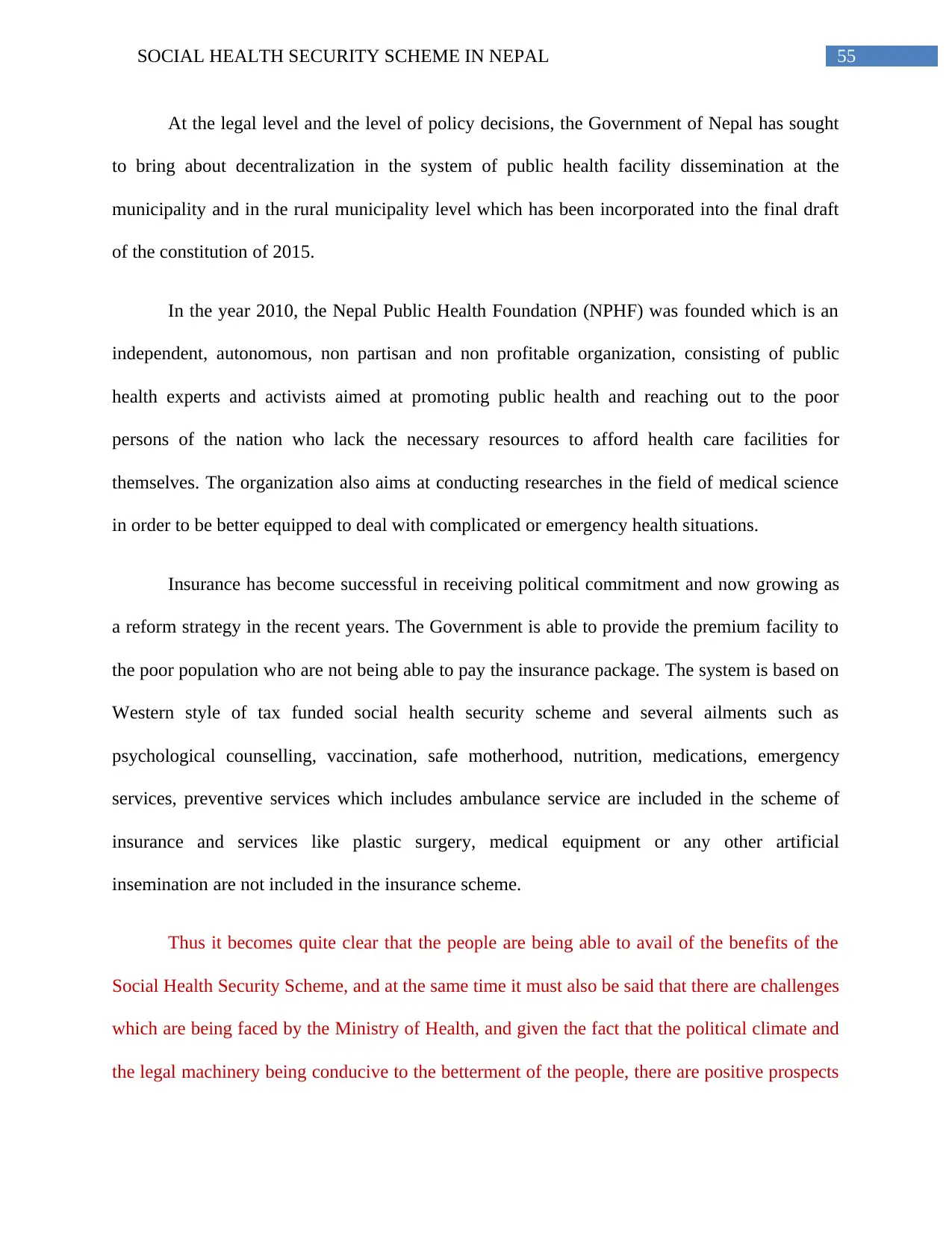
55SOCIAL HEALTH SECURITY SCHEME IN NEPAL
At the legal level and the level of policy decisions, the Government of Nepal has sought
to bring about decentralization in the system of public health facility dissemination at the
municipality and in the rural municipality level which has been incorporated into the final draft
of the constitution of 2015.
In the year 2010, the Nepal Public Health Foundation (NPHF) was founded which is an
independent, autonomous, non partisan and non profitable organization, consisting of public
health experts and activists aimed at promoting public health and reaching out to the poor
persons of the nation who lack the necessary resources to afford health care facilities for
themselves. The organization also aims at conducting researches in the field of medical science
in order to be better equipped to deal with complicated or emergency health situations.
Insurance has become successful in receiving political commitment and now growing as
a reform strategy in the recent years. The Government is able to provide the premium facility to
the poor population who are not being able to pay the insurance package. The system is based on
Western style of tax funded social health security scheme and several ailments such as
psychological counselling, vaccination, safe motherhood, nutrition, medications, emergency
services, preventive services which includes ambulance service are included in the scheme of
insurance and services like plastic surgery, medical equipment or any other artificial
insemination are not included in the insurance scheme.
Thus it becomes quite clear that the people are being able to avail of the benefits of the
Social Health Security Scheme, and at the same time it must also be said that there are challenges
which are being faced by the Ministry of Health, and given the fact that the political climate and
the legal machinery being conducive to the betterment of the people, there are positive prospects
At the legal level and the level of policy decisions, the Government of Nepal has sought
to bring about decentralization in the system of public health facility dissemination at the
municipality and in the rural municipality level which has been incorporated into the final draft
of the constitution of 2015.
In the year 2010, the Nepal Public Health Foundation (NPHF) was founded which is an
independent, autonomous, non partisan and non profitable organization, consisting of public
health experts and activists aimed at promoting public health and reaching out to the poor
persons of the nation who lack the necessary resources to afford health care facilities for
themselves. The organization also aims at conducting researches in the field of medical science
in order to be better equipped to deal with complicated or emergency health situations.
Insurance has become successful in receiving political commitment and now growing as
a reform strategy in the recent years. The Government is able to provide the premium facility to
the poor population who are not being able to pay the insurance package. The system is based on
Western style of tax funded social health security scheme and several ailments such as
psychological counselling, vaccination, safe motherhood, nutrition, medications, emergency
services, preventive services which includes ambulance service are included in the scheme of
insurance and services like plastic surgery, medical equipment or any other artificial
insemination are not included in the insurance scheme.
Thus it becomes quite clear that the people are being able to avail of the benefits of the
Social Health Security Scheme, and at the same time it must also be said that there are challenges
which are being faced by the Ministry of Health, and given the fact that the political climate and
the legal machinery being conducive to the betterment of the people, there are positive prospects
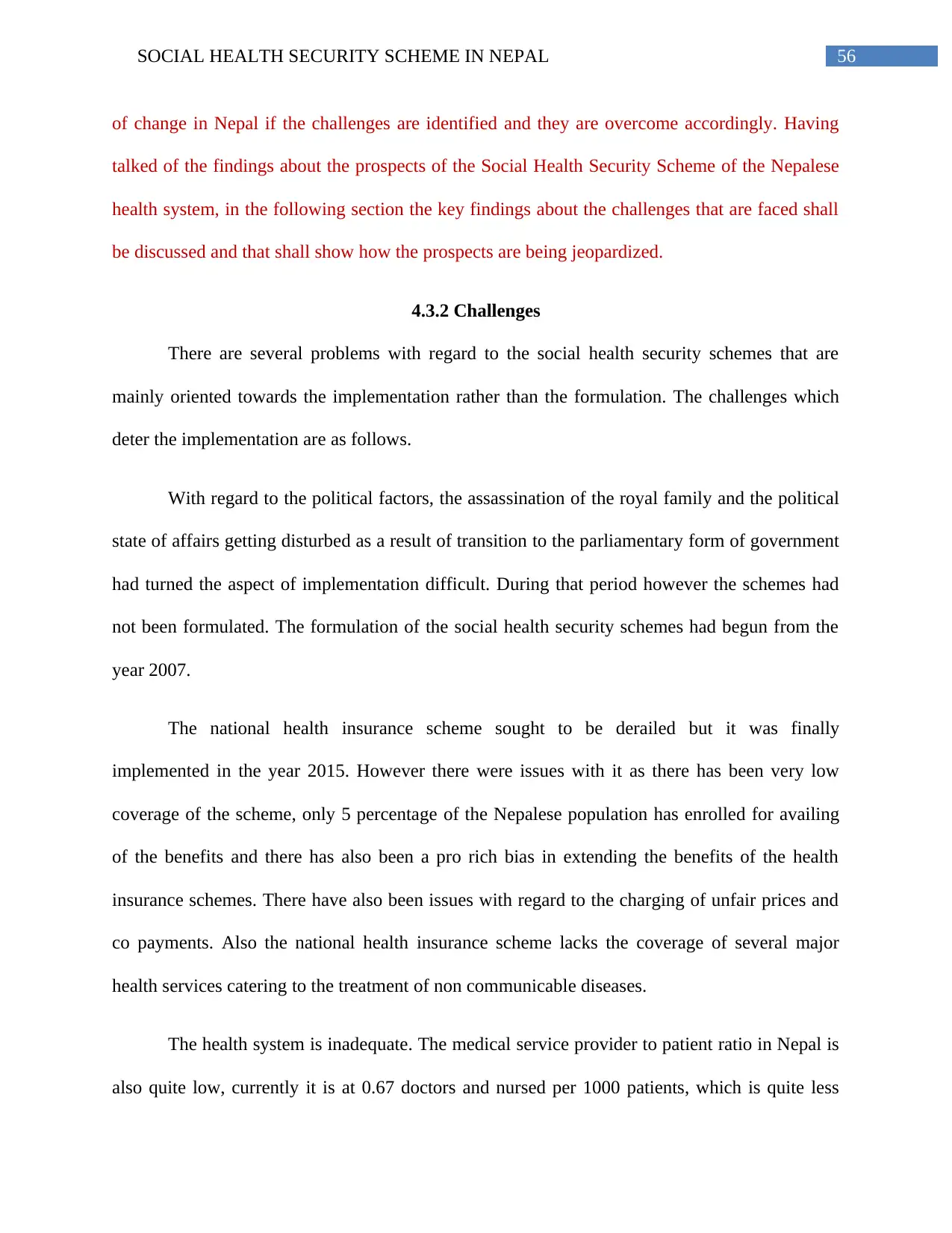
56SOCIAL HEALTH SECURITY SCHEME IN NEPAL
of change in Nepal if the challenges are identified and they are overcome accordingly. Having
talked of the findings about the prospects of the Social Health Security Scheme of the Nepalese
health system, in the following section the key findings about the challenges that are faced shall
be discussed and that shall show how the prospects are being jeopardized.
4.3.2 Challenges
There are several problems with regard to the social health security schemes that are
mainly oriented towards the implementation rather than the formulation. The challenges which
deter the implementation are as follows.
With regard to the political factors, the assassination of the royal family and the political
state of affairs getting disturbed as a result of transition to the parliamentary form of government
had turned the aspect of implementation difficult. During that period however the schemes had
not been formulated. The formulation of the social health security schemes had begun from the
year 2007.
The national health insurance scheme sought to be derailed but it was finally
implemented in the year 2015. However there were issues with it as there has been very low
coverage of the scheme, only 5 percentage of the Nepalese population has enrolled for availing
of the benefits and there has also been a pro rich bias in extending the benefits of the health
insurance schemes. There have also been issues with regard to the charging of unfair prices and
co payments. Also the national health insurance scheme lacks the coverage of several major
health services catering to the treatment of non communicable diseases.
The health system is inadequate. The medical service provider to patient ratio in Nepal is
also quite low, currently it is at 0.67 doctors and nursed per 1000 patients, which is quite less
of change in Nepal if the challenges are identified and they are overcome accordingly. Having
talked of the findings about the prospects of the Social Health Security Scheme of the Nepalese
health system, in the following section the key findings about the challenges that are faced shall
be discussed and that shall show how the prospects are being jeopardized.
4.3.2 Challenges
There are several problems with regard to the social health security schemes that are
mainly oriented towards the implementation rather than the formulation. The challenges which
deter the implementation are as follows.
With regard to the political factors, the assassination of the royal family and the political
state of affairs getting disturbed as a result of transition to the parliamentary form of government
had turned the aspect of implementation difficult. During that period however the schemes had
not been formulated. The formulation of the social health security schemes had begun from the
year 2007.
The national health insurance scheme sought to be derailed but it was finally
implemented in the year 2015. However there were issues with it as there has been very low
coverage of the scheme, only 5 percentage of the Nepalese population has enrolled for availing
of the benefits and there has also been a pro rich bias in extending the benefits of the health
insurance schemes. There have also been issues with regard to the charging of unfair prices and
co payments. Also the national health insurance scheme lacks the coverage of several major
health services catering to the treatment of non communicable diseases.
The health system is inadequate. The medical service provider to patient ratio in Nepal is
also quite low, currently it is at 0.67 doctors and nursed per 1000 patients, which is quite less
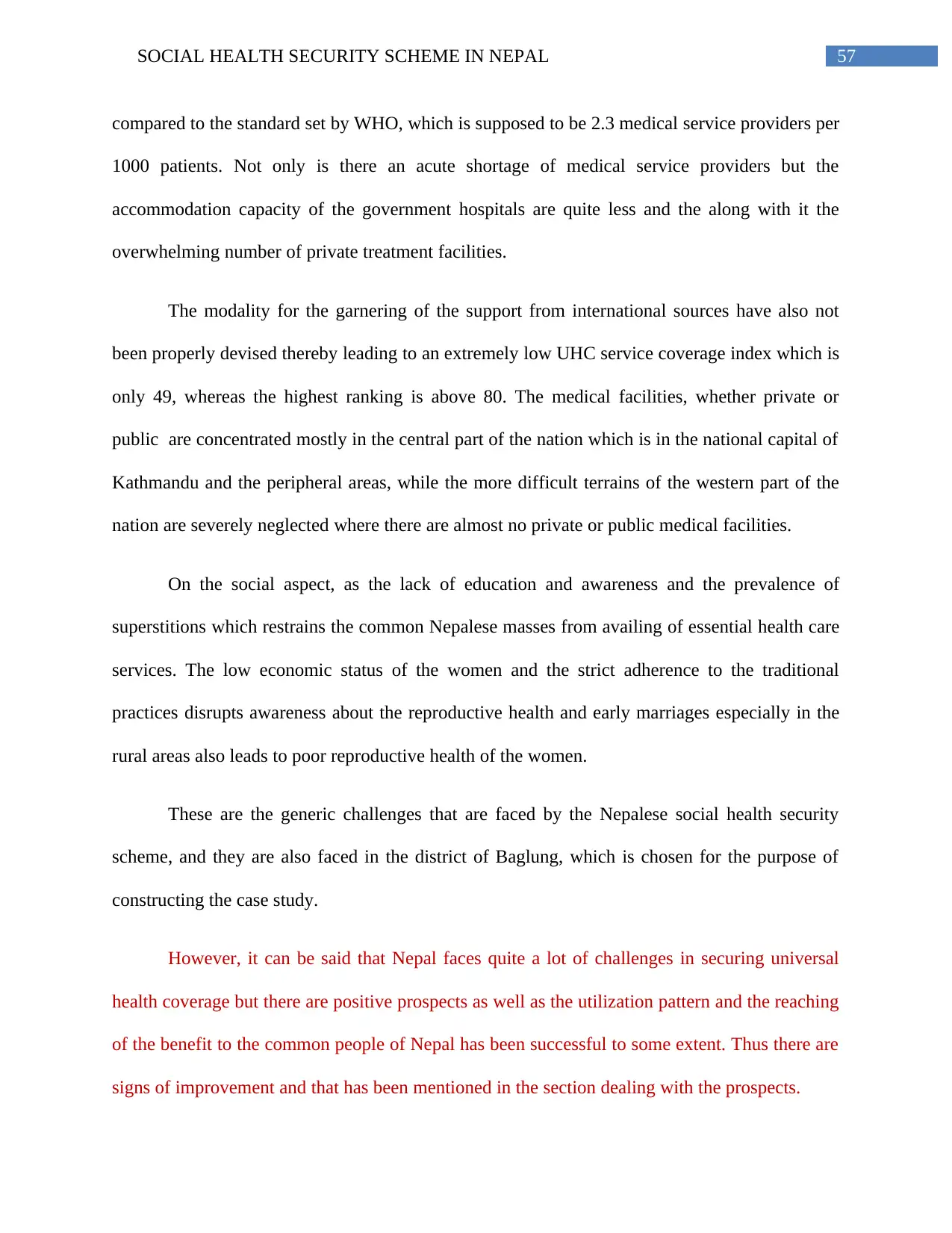
57SOCIAL HEALTH SECURITY SCHEME IN NEPAL
compared to the standard set by WHO, which is supposed to be 2.3 medical service providers per
1000 patients. Not only is there an acute shortage of medical service providers but the
accommodation capacity of the government hospitals are quite less and the along with it the
overwhelming number of private treatment facilities.
The modality for the garnering of the support from international sources have also not
been properly devised thereby leading to an extremely low UHC service coverage index which is
only 49, whereas the highest ranking is above 80. The medical facilities, whether private or
public are concentrated mostly in the central part of the nation which is in the national capital of
Kathmandu and the peripheral areas, while the more difficult terrains of the western part of the
nation are severely neglected where there are almost no private or public medical facilities.
On the social aspect, as the lack of education and awareness and the prevalence of
superstitions which restrains the common Nepalese masses from availing of essential health care
services. The low economic status of the women and the strict adherence to the traditional
practices disrupts awareness about the reproductive health and early marriages especially in the
rural areas also leads to poor reproductive health of the women.
These are the generic challenges that are faced by the Nepalese social health security
scheme, and they are also faced in the district of Baglung, which is chosen for the purpose of
constructing the case study.
However, it can be said that Nepal faces quite a lot of challenges in securing universal
health coverage but there are positive prospects as well as the utilization pattern and the reaching
of the benefit to the common people of Nepal has been successful to some extent. Thus there are
signs of improvement and that has been mentioned in the section dealing with the prospects.
compared to the standard set by WHO, which is supposed to be 2.3 medical service providers per
1000 patients. Not only is there an acute shortage of medical service providers but the
accommodation capacity of the government hospitals are quite less and the along with it the
overwhelming number of private treatment facilities.
The modality for the garnering of the support from international sources have also not
been properly devised thereby leading to an extremely low UHC service coverage index which is
only 49, whereas the highest ranking is above 80. The medical facilities, whether private or
public are concentrated mostly in the central part of the nation which is in the national capital of
Kathmandu and the peripheral areas, while the more difficult terrains of the western part of the
nation are severely neglected where there are almost no private or public medical facilities.
On the social aspect, as the lack of education and awareness and the prevalence of
superstitions which restrains the common Nepalese masses from availing of essential health care
services. The low economic status of the women and the strict adherence to the traditional
practices disrupts awareness about the reproductive health and early marriages especially in the
rural areas also leads to poor reproductive health of the women.
These are the generic challenges that are faced by the Nepalese social health security
scheme, and they are also faced in the district of Baglung, which is chosen for the purpose of
constructing the case study.
However, it can be said that Nepal faces quite a lot of challenges in securing universal
health coverage but there are positive prospects as well as the utilization pattern and the reaching
of the benefit to the common people of Nepal has been successful to some extent. Thus there are
signs of improvement and that has been mentioned in the section dealing with the prospects.
Secure Best Marks with AI Grader
Need help grading? Try our AI Grader for instant feedback on your assignments.
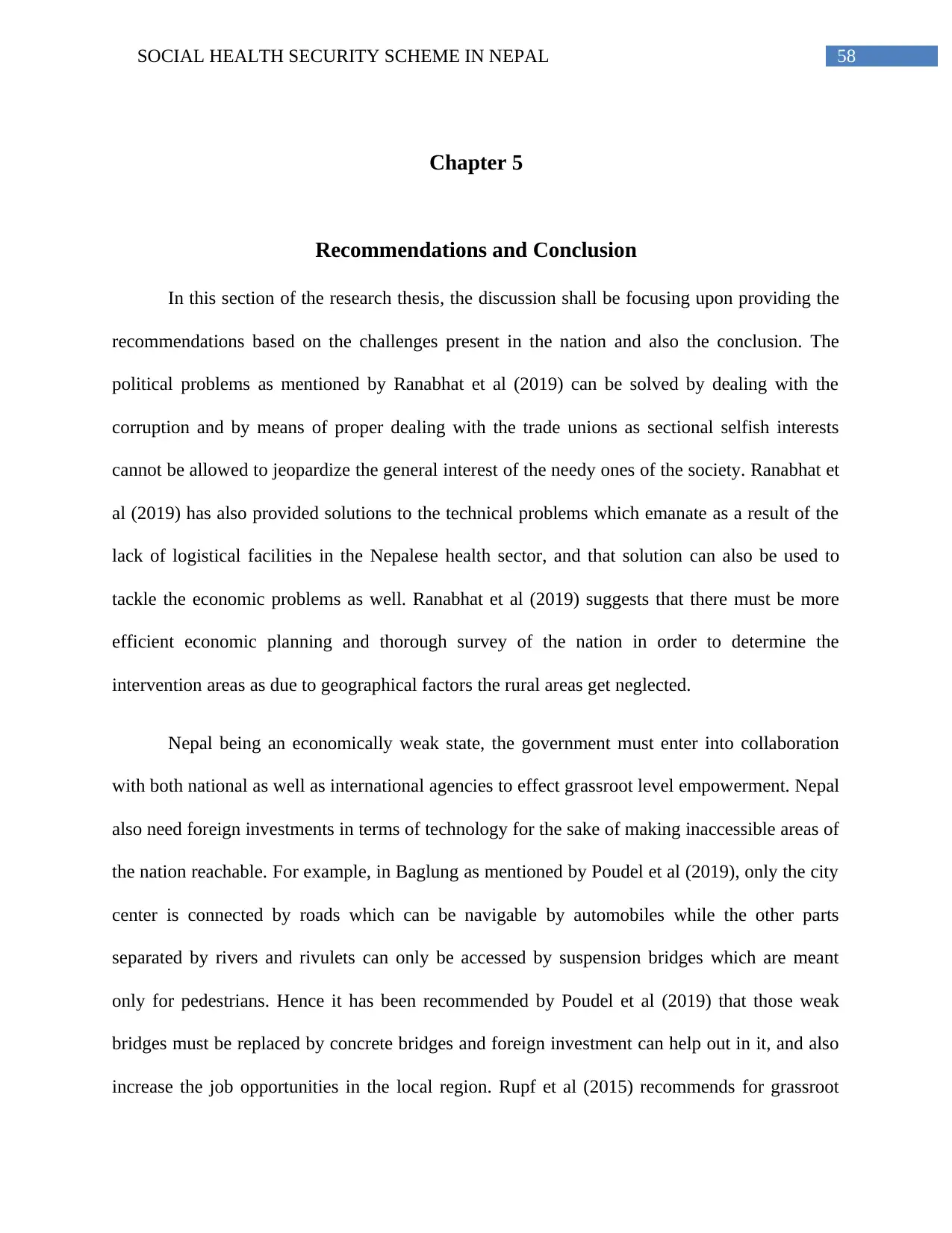
58SOCIAL HEALTH SECURITY SCHEME IN NEPAL
Chapter 5
Recommendations and Conclusion
In this section of the research thesis, the discussion shall be focusing upon providing the
recommendations based on the challenges present in the nation and also the conclusion. The
political problems as mentioned by Ranabhat et al (2019) can be solved by dealing with the
corruption and by means of proper dealing with the trade unions as sectional selfish interests
cannot be allowed to jeopardize the general interest of the needy ones of the society. Ranabhat et
al (2019) has also provided solutions to the technical problems which emanate as a result of the
lack of logistical facilities in the Nepalese health sector, and that solution can also be used to
tackle the economic problems as well. Ranabhat et al (2019) suggests that there must be more
efficient economic planning and thorough survey of the nation in order to determine the
intervention areas as due to geographical factors the rural areas get neglected.
Nepal being an economically weak state, the government must enter into collaboration
with both national as well as international agencies to effect grassroot level empowerment. Nepal
also need foreign investments in terms of technology for the sake of making inaccessible areas of
the nation reachable. For example, in Baglung as mentioned by Poudel et al (2019), only the city
center is connected by roads which can be navigable by automobiles while the other parts
separated by rivers and rivulets can only be accessed by suspension bridges which are meant
only for pedestrians. Hence it has been recommended by Poudel et al (2019) that those weak
bridges must be replaced by concrete bridges and foreign investment can help out in it, and also
increase the job opportunities in the local region. Rupf et al (2015) recommends for grassroot
Chapter 5
Recommendations and Conclusion
In this section of the research thesis, the discussion shall be focusing upon providing the
recommendations based on the challenges present in the nation and also the conclusion. The
political problems as mentioned by Ranabhat et al (2019) can be solved by dealing with the
corruption and by means of proper dealing with the trade unions as sectional selfish interests
cannot be allowed to jeopardize the general interest of the needy ones of the society. Ranabhat et
al (2019) has also provided solutions to the technical problems which emanate as a result of the
lack of logistical facilities in the Nepalese health sector, and that solution can also be used to
tackle the economic problems as well. Ranabhat et al (2019) suggests that there must be more
efficient economic planning and thorough survey of the nation in order to determine the
intervention areas as due to geographical factors the rural areas get neglected.
Nepal being an economically weak state, the government must enter into collaboration
with both national as well as international agencies to effect grassroot level empowerment. Nepal
also need foreign investments in terms of technology for the sake of making inaccessible areas of
the nation reachable. For example, in Baglung as mentioned by Poudel et al (2019), only the city
center is connected by roads which can be navigable by automobiles while the other parts
separated by rivers and rivulets can only be accessed by suspension bridges which are meant
only for pedestrians. Hence it has been recommended by Poudel et al (2019) that those weak
bridges must be replaced by concrete bridges and foreign investment can help out in it, and also
increase the job opportunities in the local region. Rupf et al (2015) recommends for grassroot
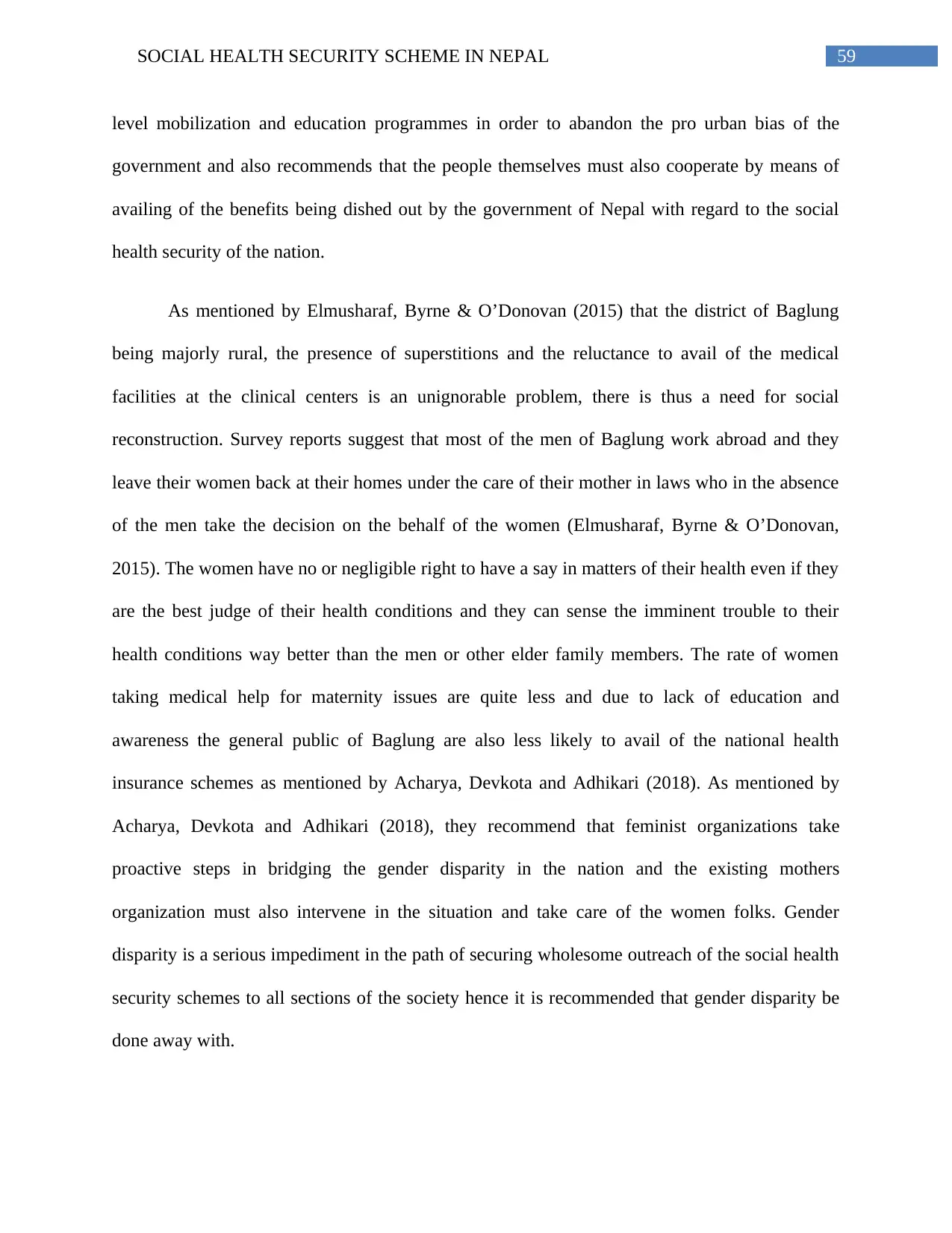
59SOCIAL HEALTH SECURITY SCHEME IN NEPAL
level mobilization and education programmes in order to abandon the pro urban bias of the
government and also recommends that the people themselves must also cooperate by means of
availing of the benefits being dished out by the government of Nepal with regard to the social
health security of the nation.
As mentioned by Elmusharaf, Byrne & O’Donovan (2015) that the district of Baglung
being majorly rural, the presence of superstitions and the reluctance to avail of the medical
facilities at the clinical centers is an unignorable problem, there is thus a need for social
reconstruction. Survey reports suggest that most of the men of Baglung work abroad and they
leave their women back at their homes under the care of their mother in laws who in the absence
of the men take the decision on the behalf of the women (Elmusharaf, Byrne & O’Donovan,
2015). The women have no or negligible right to have a say in matters of their health even if they
are the best judge of their health conditions and they can sense the imminent trouble to their
health conditions way better than the men or other elder family members. The rate of women
taking medical help for maternity issues are quite less and due to lack of education and
awareness the general public of Baglung are also less likely to avail of the national health
insurance schemes as mentioned by Acharya, Devkota and Adhikari (2018). As mentioned by
Acharya, Devkota and Adhikari (2018), they recommend that feminist organizations take
proactive steps in bridging the gender disparity in the nation and the existing mothers
organization must also intervene in the situation and take care of the women folks. Gender
disparity is a serious impediment in the path of securing wholesome outreach of the social health
security schemes to all sections of the society hence it is recommended that gender disparity be
done away with.
level mobilization and education programmes in order to abandon the pro urban bias of the
government and also recommends that the people themselves must also cooperate by means of
availing of the benefits being dished out by the government of Nepal with regard to the social
health security of the nation.
As mentioned by Elmusharaf, Byrne & O’Donovan (2015) that the district of Baglung
being majorly rural, the presence of superstitions and the reluctance to avail of the medical
facilities at the clinical centers is an unignorable problem, there is thus a need for social
reconstruction. Survey reports suggest that most of the men of Baglung work abroad and they
leave their women back at their homes under the care of their mother in laws who in the absence
of the men take the decision on the behalf of the women (Elmusharaf, Byrne & O’Donovan,
2015). The women have no or negligible right to have a say in matters of their health even if they
are the best judge of their health conditions and they can sense the imminent trouble to their
health conditions way better than the men or other elder family members. The rate of women
taking medical help for maternity issues are quite less and due to lack of education and
awareness the general public of Baglung are also less likely to avail of the national health
insurance schemes as mentioned by Acharya, Devkota and Adhikari (2018). As mentioned by
Acharya, Devkota and Adhikari (2018), they recommend that feminist organizations take
proactive steps in bridging the gender disparity in the nation and the existing mothers
organization must also intervene in the situation and take care of the women folks. Gender
disparity is a serious impediment in the path of securing wholesome outreach of the social health
security schemes to all sections of the society hence it is recommended that gender disparity be
done away with.
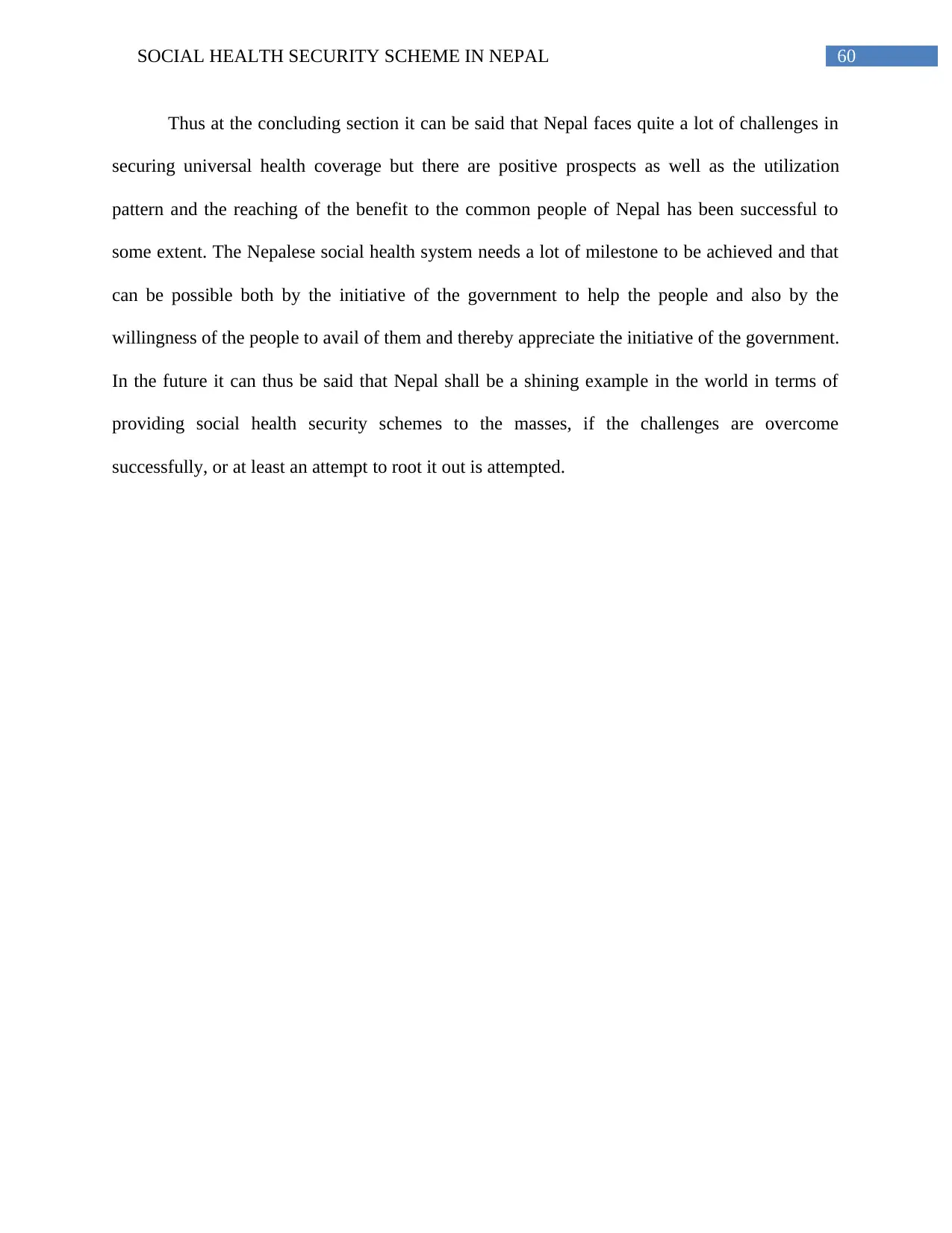
60SOCIAL HEALTH SECURITY SCHEME IN NEPAL
Thus at the concluding section it can be said that Nepal faces quite a lot of challenges in
securing universal health coverage but there are positive prospects as well as the utilization
pattern and the reaching of the benefit to the common people of Nepal has been successful to
some extent. The Nepalese social health system needs a lot of milestone to be achieved and that
can be possible both by the initiative of the government to help the people and also by the
willingness of the people to avail of them and thereby appreciate the initiative of the government.
In the future it can thus be said that Nepal shall be a shining example in the world in terms of
providing social health security schemes to the masses, if the challenges are overcome
successfully, or at least an attempt to root it out is attempted.
Thus at the concluding section it can be said that Nepal faces quite a lot of challenges in
securing universal health coverage but there are positive prospects as well as the utilization
pattern and the reaching of the benefit to the common people of Nepal has been successful to
some extent. The Nepalese social health system needs a lot of milestone to be achieved and that
can be possible both by the initiative of the government to help the people and also by the
willingness of the people to avail of them and thereby appreciate the initiative of the government.
In the future it can thus be said that Nepal shall be a shining example in the world in terms of
providing social health security schemes to the masses, if the challenges are overcome
successfully, or at least an attempt to root it out is attempted.
Paraphrase This Document
Need a fresh take? Get an instant paraphrase of this document with our AI Paraphraser
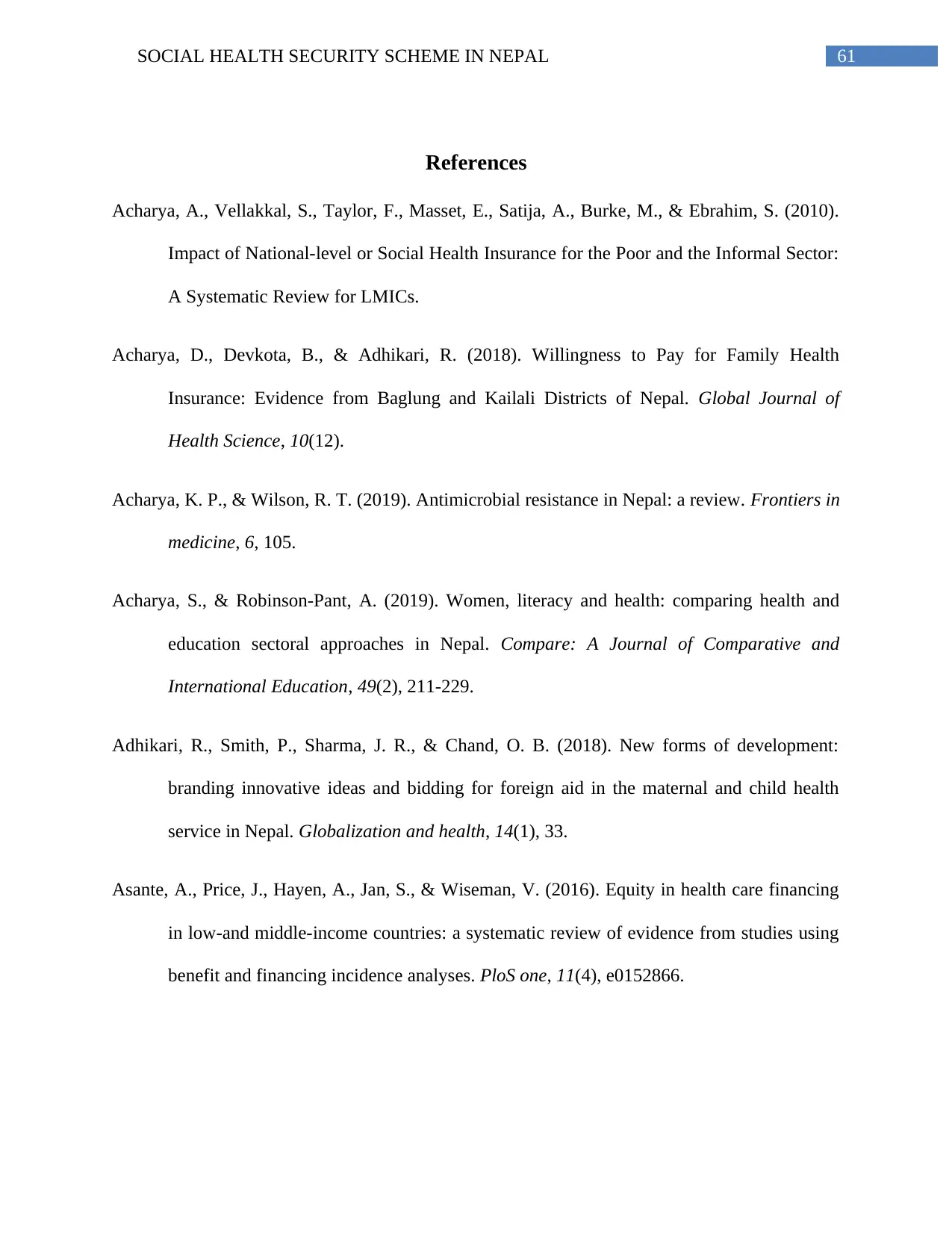
61SOCIAL HEALTH SECURITY SCHEME IN NEPAL
References
Acharya, A., Vellakkal, S., Taylor, F., Masset, E., Satija, A., Burke, M., & Ebrahim, S. (2010).
Impact of National-level or Social Health Insurance for the Poor and the Informal Sector:
A Systematic Review for LMICs.
Acharya, D., Devkota, B., & Adhikari, R. (2018). Willingness to Pay for Family Health
Insurance: Evidence from Baglung and Kailali Districts of Nepal. Global Journal of
Health Science, 10(12).
Acharya, K. P., & Wilson, R. T. (2019). Antimicrobial resistance in Nepal: a review. Frontiers in
medicine, 6, 105.
Acharya, S., & Robinson-Pant, A. (2019). Women, literacy and health: comparing health and
education sectoral approaches in Nepal. Compare: A Journal of Comparative and
International Education, 49(2), 211-229.
Adhikari, R., Smith, P., Sharma, J. R., & Chand, O. B. (2018). New forms of development:
branding innovative ideas and bidding for foreign aid in the maternal and child health
service in Nepal. Globalization and health, 14(1), 33.
Asante, A., Price, J., Hayen, A., Jan, S., & Wiseman, V. (2016). Equity in health care financing
in low-and middle-income countries: a systematic review of evidence from studies using
benefit and financing incidence analyses. PloS one, 11(4), e0152866.
References
Acharya, A., Vellakkal, S., Taylor, F., Masset, E., Satija, A., Burke, M., & Ebrahim, S. (2010).
Impact of National-level or Social Health Insurance for the Poor and the Informal Sector:
A Systematic Review for LMICs.
Acharya, D., Devkota, B., & Adhikari, R. (2018). Willingness to Pay for Family Health
Insurance: Evidence from Baglung and Kailali Districts of Nepal. Global Journal of
Health Science, 10(12).
Acharya, K. P., & Wilson, R. T. (2019). Antimicrobial resistance in Nepal: a review. Frontiers in
medicine, 6, 105.
Acharya, S., & Robinson-Pant, A. (2019). Women, literacy and health: comparing health and
education sectoral approaches in Nepal. Compare: A Journal of Comparative and
International Education, 49(2), 211-229.
Adhikari, R., Smith, P., Sharma, J. R., & Chand, O. B. (2018). New forms of development:
branding innovative ideas and bidding for foreign aid in the maternal and child health
service in Nepal. Globalization and health, 14(1), 33.
Asante, A., Price, J., Hayen, A., Jan, S., & Wiseman, V. (2016). Equity in health care financing
in low-and middle-income countries: a systematic review of evidence from studies using
benefit and financing incidence analyses. PloS one, 11(4), e0152866.
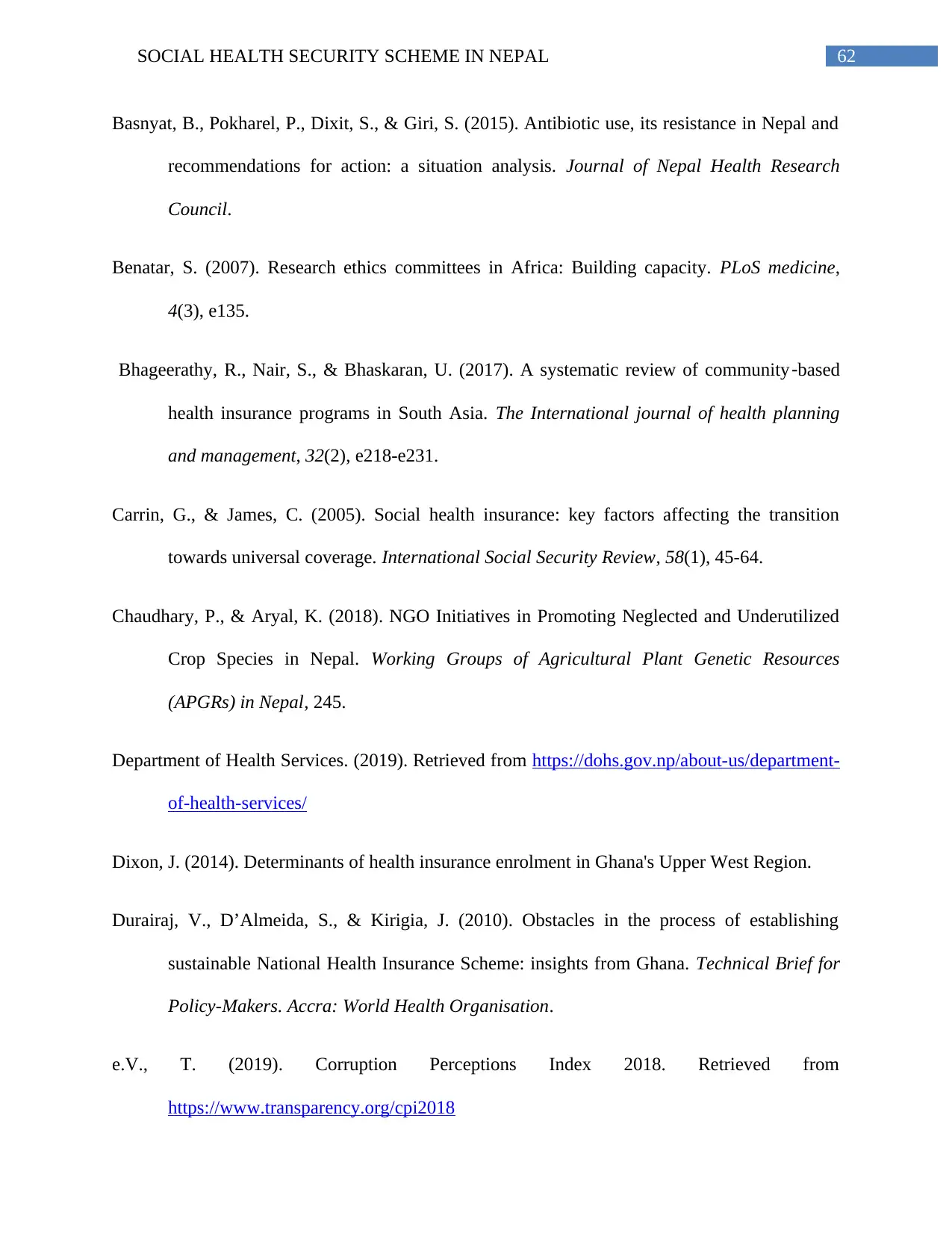
62SOCIAL HEALTH SECURITY SCHEME IN NEPAL
Basnyat, B., Pokharel, P., Dixit, S., & Giri, S. (2015). Antibiotic use, its resistance in Nepal and
recommendations for action: a situation analysis. Journal of Nepal Health Research
Council.
Benatar, S. (2007). Research ethics committees in Africa: Building capacity. PLoS medicine,
4(3), e135.
Bhageerathy, R., Nair, S., & Bhaskaran, U. (2017). A systematic review of community‐based
health insurance programs in South Asia. The International journal of health planning
and management, 32(2), e218-e231.
Carrin, G., & James, C. (2005). Social health insurance: key factors affecting the transition
towards universal coverage. International Social Security Review, 58(1), 45-64.
Chaudhary, P., & Aryal, K. (2018). NGO Initiatives in Promoting Neglected and Underutilized
Crop Species in Nepal. Working Groups of Agricultural Plant Genetic Resources
(APGRs) in Nepal, 245.
Department of Health Services. (2019). Retrieved from https://dohs.gov.np/about-us/department-
of-health-services/
Dixon, J. (2014). Determinants of health insurance enrolment in Ghana's Upper West Region.
Durairaj, V., D’Almeida, S., & Kirigia, J. (2010). Obstacles in the process of establishing
sustainable National Health Insurance Scheme: insights from Ghana. Technical Brief for
Policy-Makers. Accra: World Health Organisation.
e.V., T. (2019). Corruption Perceptions Index 2018. Retrieved from
https://www.transparency.org/cpi2018
Basnyat, B., Pokharel, P., Dixit, S., & Giri, S. (2015). Antibiotic use, its resistance in Nepal and
recommendations for action: a situation analysis. Journal of Nepal Health Research
Council.
Benatar, S. (2007). Research ethics committees in Africa: Building capacity. PLoS medicine,
4(3), e135.
Bhageerathy, R., Nair, S., & Bhaskaran, U. (2017). A systematic review of community‐based
health insurance programs in South Asia. The International journal of health planning
and management, 32(2), e218-e231.
Carrin, G., & James, C. (2005). Social health insurance: key factors affecting the transition
towards universal coverage. International Social Security Review, 58(1), 45-64.
Chaudhary, P., & Aryal, K. (2018). NGO Initiatives in Promoting Neglected and Underutilized
Crop Species in Nepal. Working Groups of Agricultural Plant Genetic Resources
(APGRs) in Nepal, 245.
Department of Health Services. (2019). Retrieved from https://dohs.gov.np/about-us/department-
of-health-services/
Dixon, J. (2014). Determinants of health insurance enrolment in Ghana's Upper West Region.
Durairaj, V., D’Almeida, S., & Kirigia, J. (2010). Obstacles in the process of establishing
sustainable National Health Insurance Scheme: insights from Ghana. Technical Brief for
Policy-Makers. Accra: World Health Organisation.
e.V., T. (2019). Corruption Perceptions Index 2018. Retrieved from
https://www.transparency.org/cpi2018
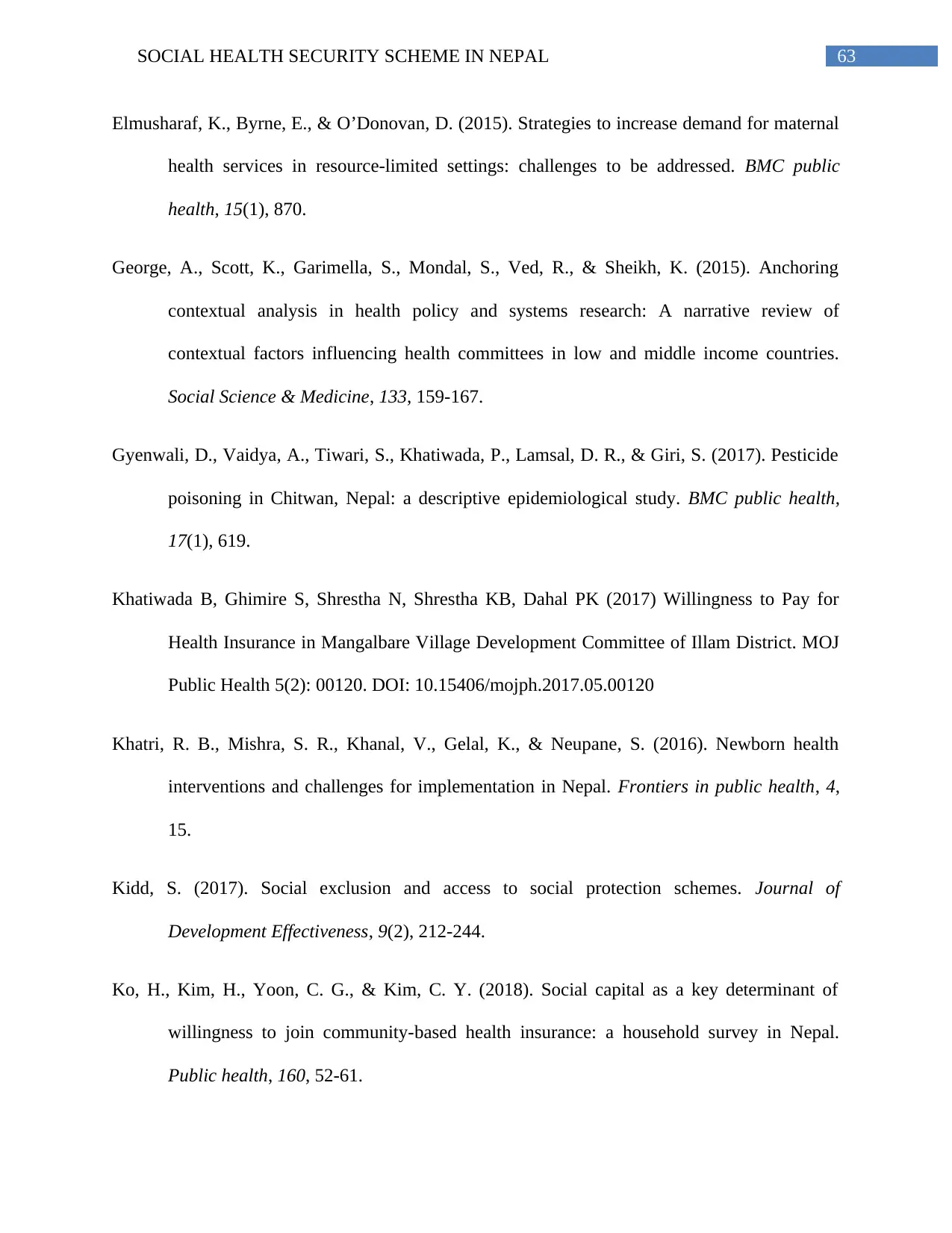
63SOCIAL HEALTH SECURITY SCHEME IN NEPAL
Elmusharaf, K., Byrne, E., & O’Donovan, D. (2015). Strategies to increase demand for maternal
health services in resource-limited settings: challenges to be addressed. BMC public
health, 15(1), 870.
George, A., Scott, K., Garimella, S., Mondal, S., Ved, R., & Sheikh, K. (2015). Anchoring
contextual analysis in health policy and systems research: A narrative review of
contextual factors influencing health committees in low and middle income countries.
Social Science & Medicine, 133, 159-167.
Gyenwali, D., Vaidya, A., Tiwari, S., Khatiwada, P., Lamsal, D. R., & Giri, S. (2017). Pesticide
poisoning in Chitwan, Nepal: a descriptive epidemiological study. BMC public health,
17(1), 619.
Khatiwada B, Ghimire S, Shrestha N, Shrestha KB, Dahal PK (2017) Willingness to Pay for
Health Insurance in Mangalbare Village Development Committee of Illam District. MOJ
Public Health 5(2): 00120. DOI: 10.15406/mojph.2017.05.00120
Khatri, R. B., Mishra, S. R., Khanal, V., Gelal, K., & Neupane, S. (2016). Newborn health
interventions and challenges for implementation in Nepal. Frontiers in public health, 4,
15.
Kidd, S. (2017). Social exclusion and access to social protection schemes. Journal of
Development Effectiveness, 9(2), 212-244.
Ko, H., Kim, H., Yoon, C. G., & Kim, C. Y. (2018). Social capital as a key determinant of
willingness to join community-based health insurance: a household survey in Nepal.
Public health, 160, 52-61.
Elmusharaf, K., Byrne, E., & O’Donovan, D. (2015). Strategies to increase demand for maternal
health services in resource-limited settings: challenges to be addressed. BMC public
health, 15(1), 870.
George, A., Scott, K., Garimella, S., Mondal, S., Ved, R., & Sheikh, K. (2015). Anchoring
contextual analysis in health policy and systems research: A narrative review of
contextual factors influencing health committees in low and middle income countries.
Social Science & Medicine, 133, 159-167.
Gyenwali, D., Vaidya, A., Tiwari, S., Khatiwada, P., Lamsal, D. R., & Giri, S. (2017). Pesticide
poisoning in Chitwan, Nepal: a descriptive epidemiological study. BMC public health,
17(1), 619.
Khatiwada B, Ghimire S, Shrestha N, Shrestha KB, Dahal PK (2017) Willingness to Pay for
Health Insurance in Mangalbare Village Development Committee of Illam District. MOJ
Public Health 5(2): 00120. DOI: 10.15406/mojph.2017.05.00120
Khatri, R. B., Mishra, S. R., Khanal, V., Gelal, K., & Neupane, S. (2016). Newborn health
interventions and challenges for implementation in Nepal. Frontiers in public health, 4,
15.
Kidd, S. (2017). Social exclusion and access to social protection schemes. Journal of
Development Effectiveness, 9(2), 212-244.
Ko, H., Kim, H., Yoon, C. G., & Kim, C. Y. (2018). Social capital as a key determinant of
willingness to join community-based health insurance: a household survey in Nepal.
Public health, 160, 52-61.
Secure Best Marks with AI Grader
Need help grading? Try our AI Grader for instant feedback on your assignments.
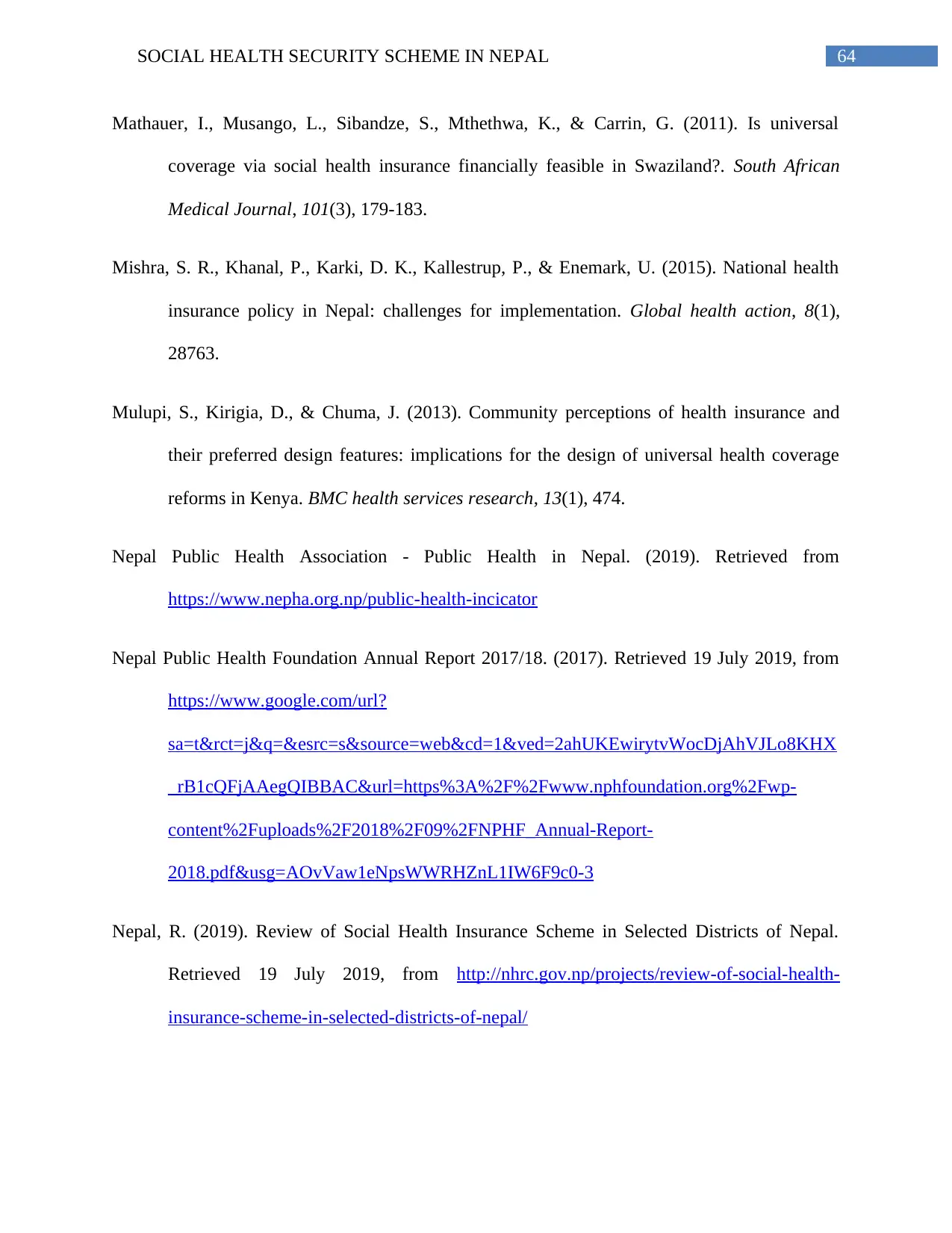
64SOCIAL HEALTH SECURITY SCHEME IN NEPAL
Mathauer, I., Musango, L., Sibandze, S., Mthethwa, K., & Carrin, G. (2011). Is universal
coverage via social health insurance financially feasible in Swaziland?. South African
Medical Journal, 101(3), 179-183.
Mishra, S. R., Khanal, P., Karki, D. K., Kallestrup, P., & Enemark, U. (2015). National health
insurance policy in Nepal: challenges for implementation. Global health action, 8(1),
28763.
Mulupi, S., Kirigia, D., & Chuma, J. (2013). Community perceptions of health insurance and
their preferred design features: implications for the design of universal health coverage
reforms in Kenya. BMC health services research, 13(1), 474.
Nepal Public Health Association - Public Health in Nepal. (2019). Retrieved from
https://www.nepha.org.np/public-health-incicator
Nepal Public Health Foundation Annual Report 2017/18. (2017). Retrieved 19 July 2019, from
https://www.google.com/url?
sa=t&rct=j&q=&esrc=s&source=web&cd=1&ved=2ahUKEwirytvWocDjAhVJLo8KHX
_rB1cQFjAAegQIBBAC&url=https%3A%2F%2Fwww.nphfoundation.org%2Fwp-
content%2Fuploads%2F2018%2F09%2FNPHF_Annual-Report-
2018.pdf&usg=AOvVaw1eNpsWWRHZnL1IW6F9c0-3
Nepal, R. (2019). Review of Social Health Insurance Scheme in Selected Districts of Nepal.
Retrieved 19 July 2019, from http://nhrc.gov.np/projects/review-of-social-health-
insurance-scheme-in-selected-districts-of-nepal/
Mathauer, I., Musango, L., Sibandze, S., Mthethwa, K., & Carrin, G. (2011). Is universal
coverage via social health insurance financially feasible in Swaziland?. South African
Medical Journal, 101(3), 179-183.
Mishra, S. R., Khanal, P., Karki, D. K., Kallestrup, P., & Enemark, U. (2015). National health
insurance policy in Nepal: challenges for implementation. Global health action, 8(1),
28763.
Mulupi, S., Kirigia, D., & Chuma, J. (2013). Community perceptions of health insurance and
their preferred design features: implications for the design of universal health coverage
reforms in Kenya. BMC health services research, 13(1), 474.
Nepal Public Health Association - Public Health in Nepal. (2019). Retrieved from
https://www.nepha.org.np/public-health-incicator
Nepal Public Health Foundation Annual Report 2017/18. (2017). Retrieved 19 July 2019, from
https://www.google.com/url?
sa=t&rct=j&q=&esrc=s&source=web&cd=1&ved=2ahUKEwirytvWocDjAhVJLo8KHX
_rB1cQFjAAegQIBBAC&url=https%3A%2F%2Fwww.nphfoundation.org%2Fwp-
content%2Fuploads%2F2018%2F09%2FNPHF_Annual-Report-
2018.pdf&usg=AOvVaw1eNpsWWRHZnL1IW6F9c0-3
Nepal, R. (2019). Review of Social Health Insurance Scheme in Selected Districts of Nepal.
Retrieved 19 July 2019, from http://nhrc.gov.np/projects/review-of-social-health-
insurance-scheme-in-selected-districts-of-nepal/
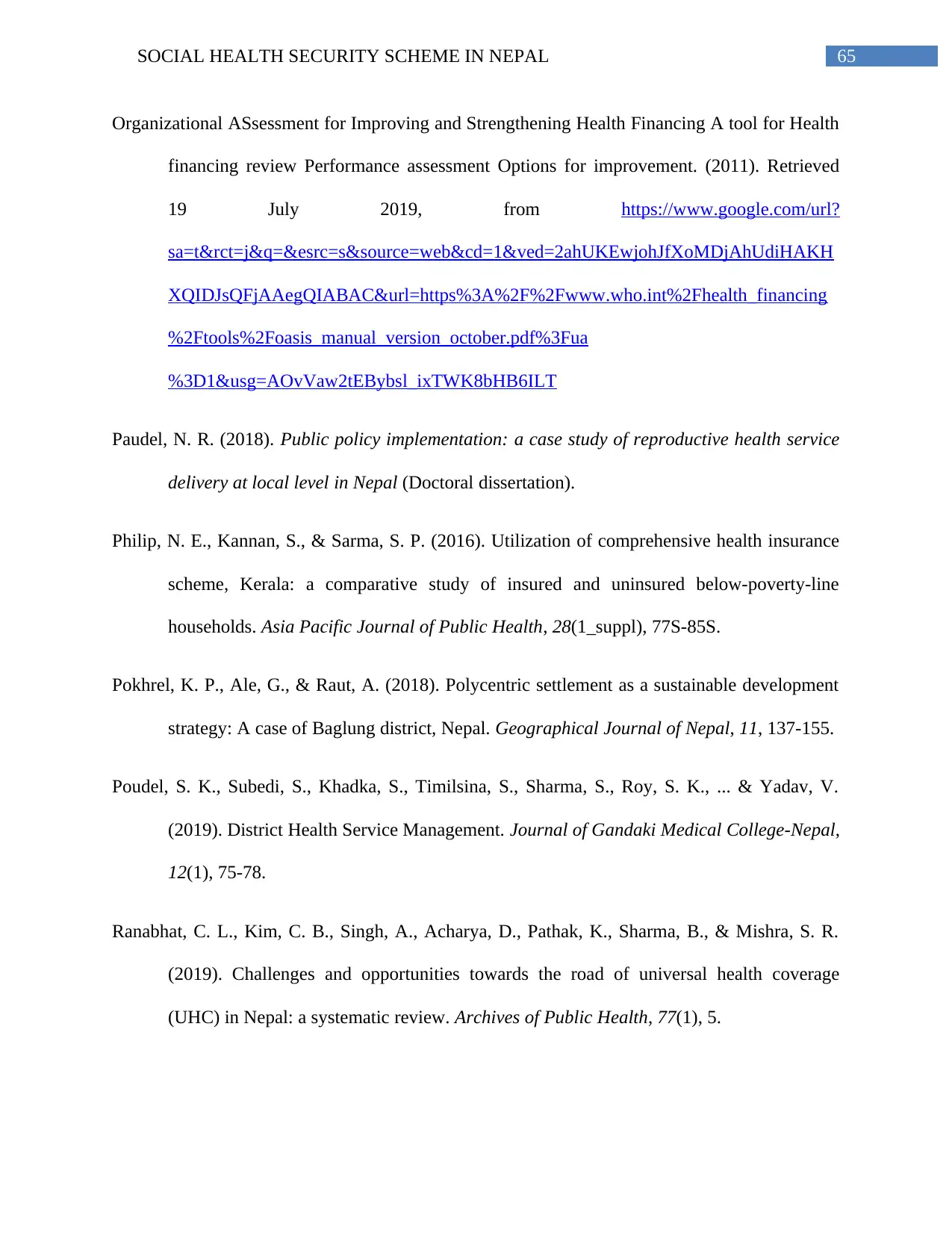
65SOCIAL HEALTH SECURITY SCHEME IN NEPAL
Organizational ASsessment for Improving and Strengthening Health Financing A tool for Health
financing review Performance assessment Options for improvement. (2011). Retrieved
19 July 2019, from https://www.google.com/url?
sa=t&rct=j&q=&esrc=s&source=web&cd=1&ved=2ahUKEwjohJfXoMDjAhUdiHAKH
XQIDJsQFjAAegQIABAC&url=https%3A%2F%2Fwww.who.int%2Fhealth_financing
%2Ftools%2Foasis_manual_version_october.pdf%3Fua
%3D1&usg=AOvVaw2tEBybsl_ixTWK8bHB6ILT
Paudel, N. R. (2018). Public policy implementation: a case study of reproductive health service
delivery at local level in Nepal (Doctoral dissertation).
Philip, N. E., Kannan, S., & Sarma, S. P. (2016). Utilization of comprehensive health insurance
scheme, Kerala: a comparative study of insured and uninsured below-poverty-line
households. Asia Pacific Journal of Public Health, 28(1_suppl), 77S-85S.
Pokhrel, K. P., Ale, G., & Raut, A. (2018). Polycentric settlement as a sustainable development
strategy: A case of Baglung district, Nepal. Geographical Journal of Nepal, 11, 137-155.
Poudel, S. K., Subedi, S., Khadka, S., Timilsina, S., Sharma, S., Roy, S. K., ... & Yadav, V.
(2019). District Health Service Management. Journal of Gandaki Medical College-Nepal,
12(1), 75-78.
Ranabhat, C. L., Kim, C. B., Singh, A., Acharya, D., Pathak, K., Sharma, B., & Mishra, S. R.
(2019). Challenges and opportunities towards the road of universal health coverage
(UHC) in Nepal: a systematic review. Archives of Public Health, 77(1), 5.
Organizational ASsessment for Improving and Strengthening Health Financing A tool for Health
financing review Performance assessment Options for improvement. (2011). Retrieved
19 July 2019, from https://www.google.com/url?
sa=t&rct=j&q=&esrc=s&source=web&cd=1&ved=2ahUKEwjohJfXoMDjAhUdiHAKH
XQIDJsQFjAAegQIABAC&url=https%3A%2F%2Fwww.who.int%2Fhealth_financing
%2Ftools%2Foasis_manual_version_october.pdf%3Fua
%3D1&usg=AOvVaw2tEBybsl_ixTWK8bHB6ILT
Paudel, N. R. (2018). Public policy implementation: a case study of reproductive health service
delivery at local level in Nepal (Doctoral dissertation).
Philip, N. E., Kannan, S., & Sarma, S. P. (2016). Utilization of comprehensive health insurance
scheme, Kerala: a comparative study of insured and uninsured below-poverty-line
households. Asia Pacific Journal of Public Health, 28(1_suppl), 77S-85S.
Pokhrel, K. P., Ale, G., & Raut, A. (2018). Polycentric settlement as a sustainable development
strategy: A case of Baglung district, Nepal. Geographical Journal of Nepal, 11, 137-155.
Poudel, S. K., Subedi, S., Khadka, S., Timilsina, S., Sharma, S., Roy, S. K., ... & Yadav, V.
(2019). District Health Service Management. Journal of Gandaki Medical College-Nepal,
12(1), 75-78.
Ranabhat, C. L., Kim, C. B., Singh, A., Acharya, D., Pathak, K., Sharma, B., & Mishra, S. R.
(2019). Challenges and opportunities towards the road of universal health coverage
(UHC) in Nepal: a systematic review. Archives of Public Health, 77(1), 5.
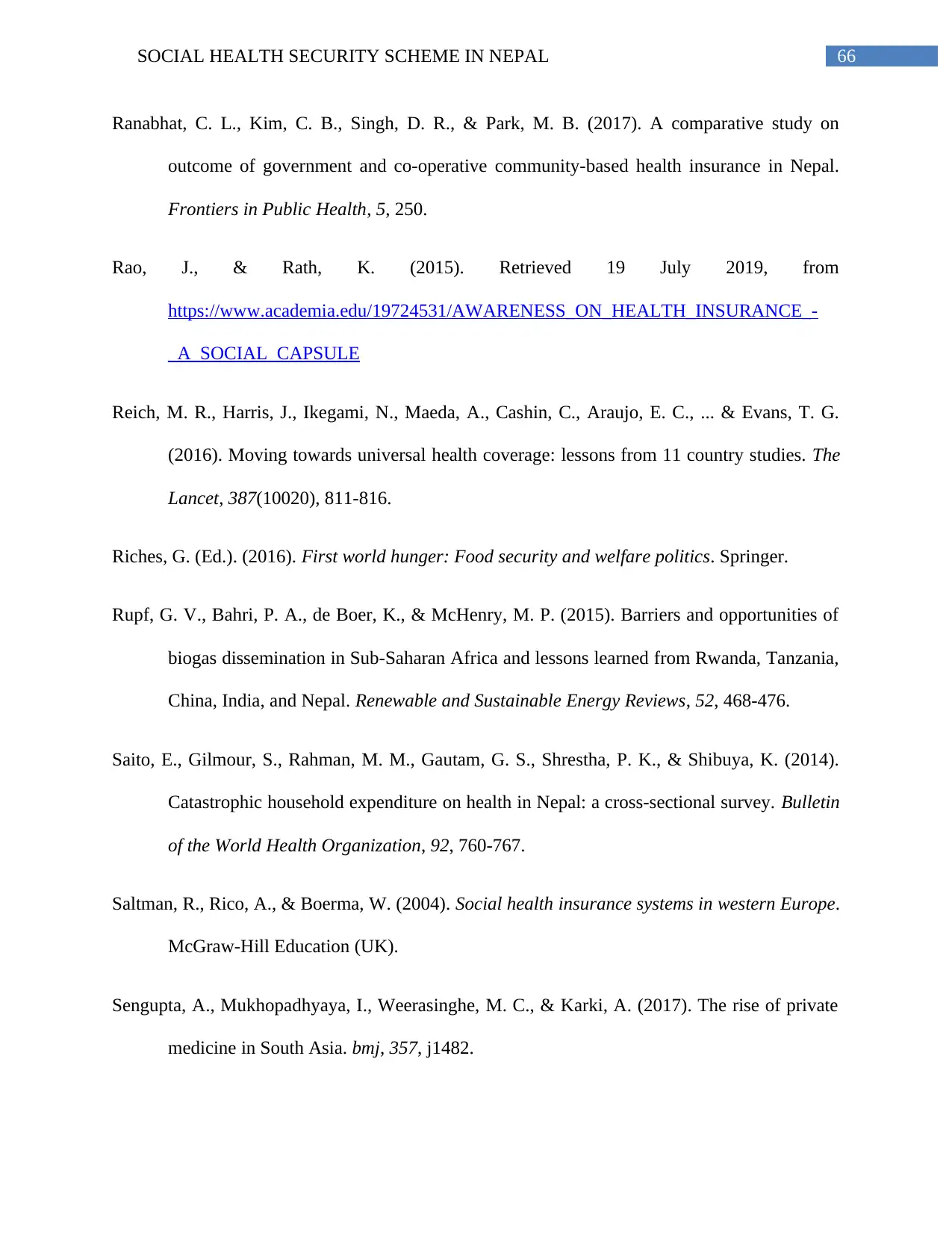
66SOCIAL HEALTH SECURITY SCHEME IN NEPAL
Ranabhat, C. L., Kim, C. B., Singh, D. R., & Park, M. B. (2017). A comparative study on
outcome of government and co-operative community-based health insurance in Nepal.
Frontiers in Public Health, 5, 250.
Rao, J., & Rath, K. (2015). Retrieved 19 July 2019, from
https://www.academia.edu/19724531/AWARENESS_ON_HEALTH_INSURANCE_-
_A_SOCIAL_CAPSULE
Reich, M. R., Harris, J., Ikegami, N., Maeda, A., Cashin, C., Araujo, E. C., ... & Evans, T. G.
(2016). Moving towards universal health coverage: lessons from 11 country studies. The
Lancet, 387(10020), 811-816.
Riches, G. (Ed.). (2016). First world hunger: Food security and welfare politics. Springer.
Rupf, G. V., Bahri, P. A., de Boer, K., & McHenry, M. P. (2015). Barriers and opportunities of
biogas dissemination in Sub-Saharan Africa and lessons learned from Rwanda, Tanzania,
China, India, and Nepal. Renewable and Sustainable Energy Reviews, 52, 468-476.
Saito, E., Gilmour, S., Rahman, M. M., Gautam, G. S., Shrestha, P. K., & Shibuya, K. (2014).
Catastrophic household expenditure on health in Nepal: a cross-sectional survey. Bulletin
of the World Health Organization, 92, 760-767.
Saltman, R., Rico, A., & Boerma, W. (2004). Social health insurance systems in western Europe.
McGraw-Hill Education (UK).
Sengupta, A., Mukhopadhyaya, I., Weerasinghe, M. C., & Karki, A. (2017). The rise of private
medicine in South Asia. bmj, 357, j1482.
Ranabhat, C. L., Kim, C. B., Singh, D. R., & Park, M. B. (2017). A comparative study on
outcome of government and co-operative community-based health insurance in Nepal.
Frontiers in Public Health, 5, 250.
Rao, J., & Rath, K. (2015). Retrieved 19 July 2019, from
https://www.academia.edu/19724531/AWARENESS_ON_HEALTH_INSURANCE_-
_A_SOCIAL_CAPSULE
Reich, M. R., Harris, J., Ikegami, N., Maeda, A., Cashin, C., Araujo, E. C., ... & Evans, T. G.
(2016). Moving towards universal health coverage: lessons from 11 country studies. The
Lancet, 387(10020), 811-816.
Riches, G. (Ed.). (2016). First world hunger: Food security and welfare politics. Springer.
Rupf, G. V., Bahri, P. A., de Boer, K., & McHenry, M. P. (2015). Barriers and opportunities of
biogas dissemination in Sub-Saharan Africa and lessons learned from Rwanda, Tanzania,
China, India, and Nepal. Renewable and Sustainable Energy Reviews, 52, 468-476.
Saito, E., Gilmour, S., Rahman, M. M., Gautam, G. S., Shrestha, P. K., & Shibuya, K. (2014).
Catastrophic household expenditure on health in Nepal: a cross-sectional survey. Bulletin
of the World Health Organization, 92, 760-767.
Saltman, R., Rico, A., & Boerma, W. (2004). Social health insurance systems in western Europe.
McGraw-Hill Education (UK).
Sengupta, A., Mukhopadhyaya, I., Weerasinghe, M. C., & Karki, A. (2017). The rise of private
medicine in South Asia. bmj, 357, j1482.
Paraphrase This Document
Need a fresh take? Get an instant paraphrase of this document with our AI Paraphraser
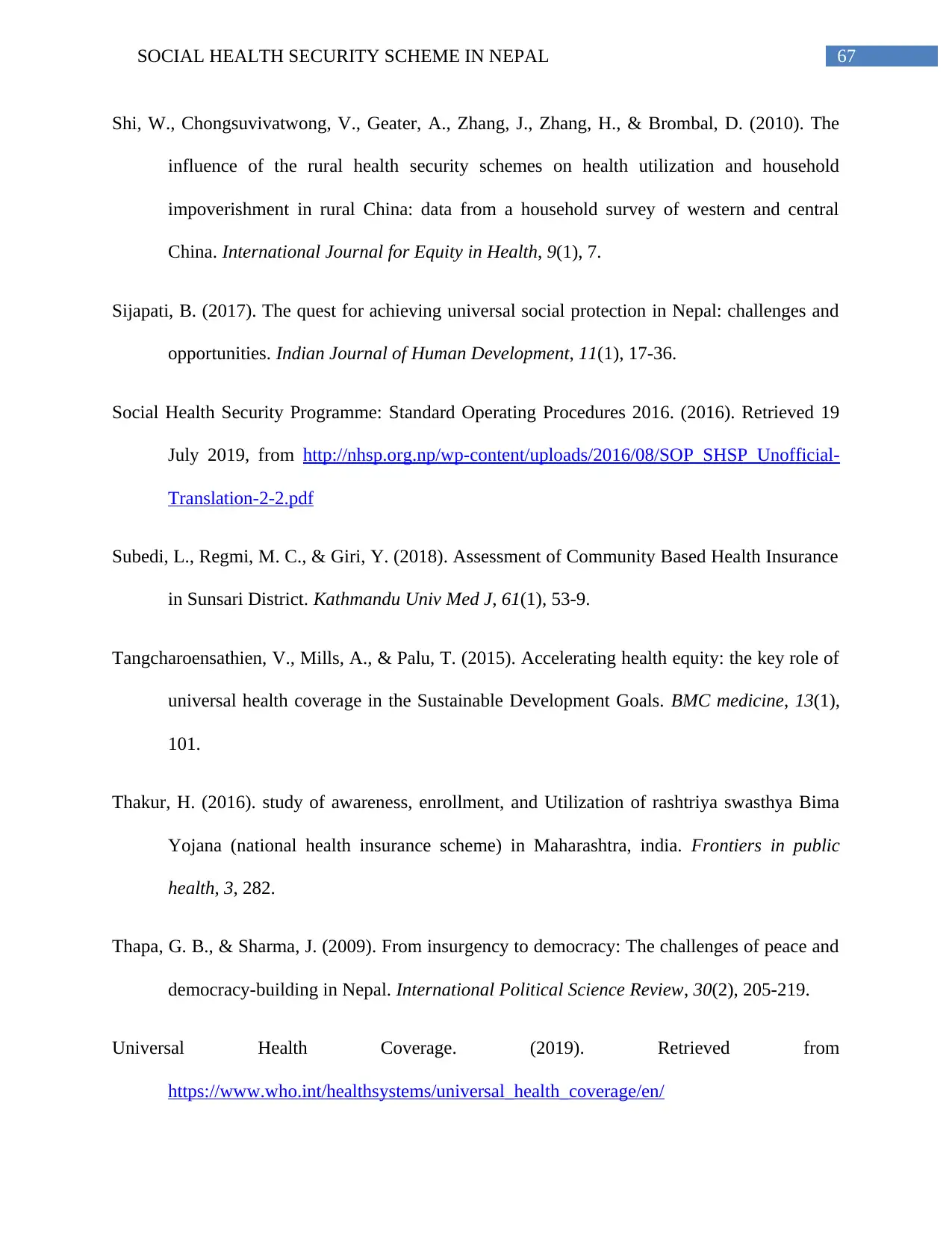
67SOCIAL HEALTH SECURITY SCHEME IN NEPAL
Shi, W., Chongsuvivatwong, V., Geater, A., Zhang, J., Zhang, H., & Brombal, D. (2010). The
influence of the rural health security schemes on health utilization and household
impoverishment in rural China: data from a household survey of western and central
China. International Journal for Equity in Health, 9(1), 7.
Sijapati, B. (2017). The quest for achieving universal social protection in Nepal: challenges and
opportunities. Indian Journal of Human Development, 11(1), 17-36.
Social Health Security Programme: Standard Operating Procedures 2016. (2016). Retrieved 19
July 2019, from http://nhsp.org.np/wp-content/uploads/2016/08/SOP_SHSP_Unofficial-
Translation-2-2.pdf
Subedi, L., Regmi, M. C., & Giri, Y. (2018). Assessment of Community Based Health Insurance
in Sunsari District. Kathmandu Univ Med J, 61(1), 53-9.
Tangcharoensathien, V., Mills, A., & Palu, T. (2015). Accelerating health equity: the key role of
universal health coverage in the Sustainable Development Goals. BMC medicine, 13(1),
101.
Thakur, H. (2016). study of awareness, enrollment, and Utilization of rashtriya swasthya Bima
Yojana (national health insurance scheme) in Maharashtra, india. Frontiers in public
health, 3, 282.
Thapa, G. B., & Sharma, J. (2009). From insurgency to democracy: The challenges of peace and
democracy-building in Nepal. International Political Science Review, 30(2), 205-219.
Universal Health Coverage. (2019). Retrieved from
https://www.who.int/healthsystems/universal_health_coverage/en/
Shi, W., Chongsuvivatwong, V., Geater, A., Zhang, J., Zhang, H., & Brombal, D. (2010). The
influence of the rural health security schemes on health utilization and household
impoverishment in rural China: data from a household survey of western and central
China. International Journal for Equity in Health, 9(1), 7.
Sijapati, B. (2017). The quest for achieving universal social protection in Nepal: challenges and
opportunities. Indian Journal of Human Development, 11(1), 17-36.
Social Health Security Programme: Standard Operating Procedures 2016. (2016). Retrieved 19
July 2019, from http://nhsp.org.np/wp-content/uploads/2016/08/SOP_SHSP_Unofficial-
Translation-2-2.pdf
Subedi, L., Regmi, M. C., & Giri, Y. (2018). Assessment of Community Based Health Insurance
in Sunsari District. Kathmandu Univ Med J, 61(1), 53-9.
Tangcharoensathien, V., Mills, A., & Palu, T. (2015). Accelerating health equity: the key role of
universal health coverage in the Sustainable Development Goals. BMC medicine, 13(1),
101.
Thakur, H. (2016). study of awareness, enrollment, and Utilization of rashtriya swasthya Bima
Yojana (national health insurance scheme) in Maharashtra, india. Frontiers in public
health, 3, 282.
Thapa, G. B., & Sharma, J. (2009). From insurgency to democracy: The challenges of peace and
democracy-building in Nepal. International Political Science Review, 30(2), 205-219.
Universal Health Coverage. (2019). Retrieved from
https://www.who.int/healthsystems/universal_health_coverage/en/
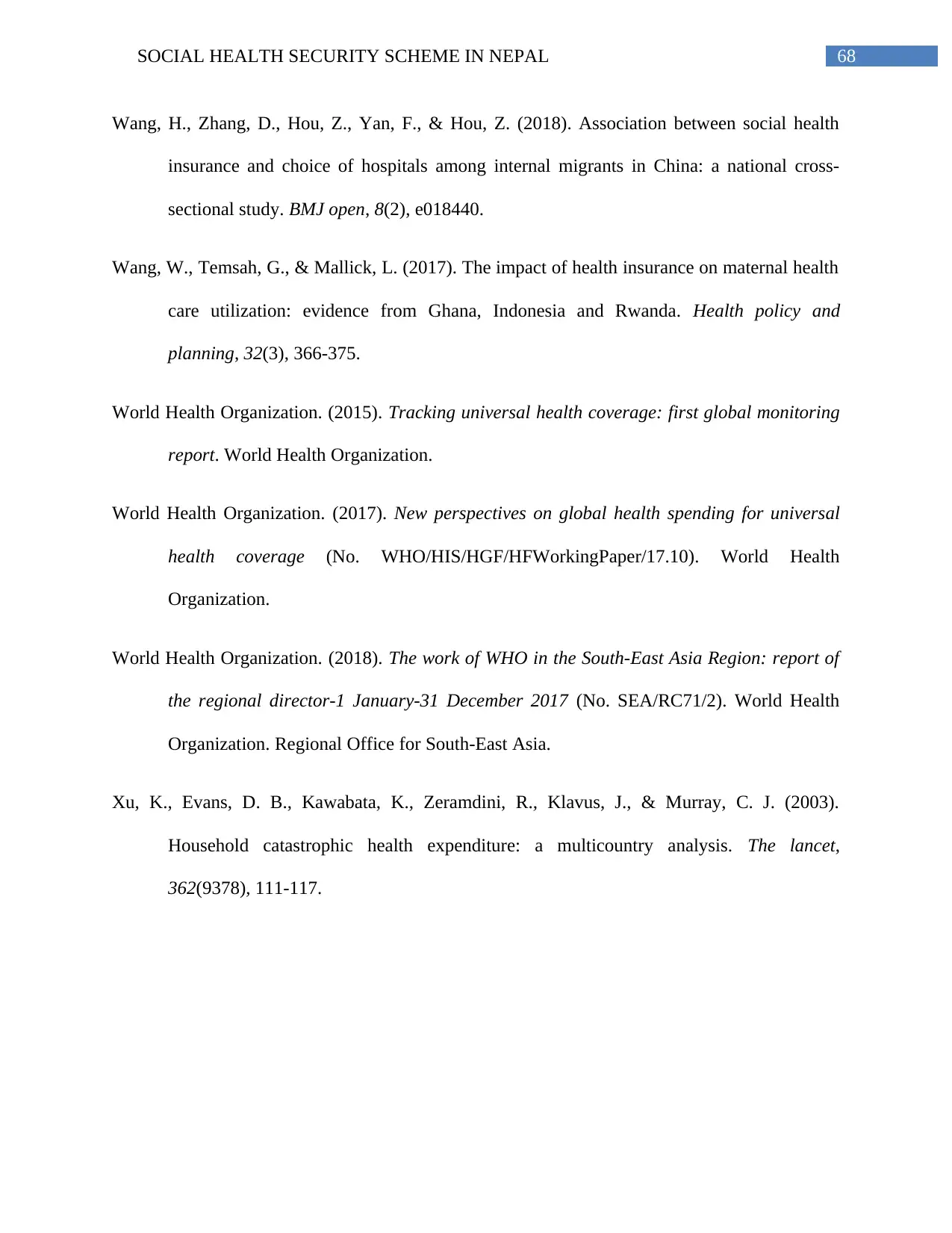
68SOCIAL HEALTH SECURITY SCHEME IN NEPAL
Wang, H., Zhang, D., Hou, Z., Yan, F., & Hou, Z. (2018). Association between social health
insurance and choice of hospitals among internal migrants in China: a national cross-
sectional study. BMJ open, 8(2), e018440.
Wang, W., Temsah, G., & Mallick, L. (2017). The impact of health insurance on maternal health
care utilization: evidence from Ghana, Indonesia and Rwanda. Health policy and
planning, 32(3), 366-375.
World Health Organization. (2015). Tracking universal health coverage: first global monitoring
report. World Health Organization.
World Health Organization. (2017). New perspectives on global health spending for universal
health coverage (No. WHO/HIS/HGF/HFWorkingPaper/17.10). World Health
Organization.
World Health Organization. (2018). The work of WHO in the South-East Asia Region: report of
the regional director-1 January-31 December 2017 (No. SEA/RC71/2). World Health
Organization. Regional Office for South-East Asia.
Xu, K., Evans, D. B., Kawabata, K., Zeramdini, R., Klavus, J., & Murray, C. J. (2003).
Household catastrophic health expenditure: a multicountry analysis. The lancet,
362(9378), 111-117.
Wang, H., Zhang, D., Hou, Z., Yan, F., & Hou, Z. (2018). Association between social health
insurance and choice of hospitals among internal migrants in China: a national cross-
sectional study. BMJ open, 8(2), e018440.
Wang, W., Temsah, G., & Mallick, L. (2017). The impact of health insurance on maternal health
care utilization: evidence from Ghana, Indonesia and Rwanda. Health policy and
planning, 32(3), 366-375.
World Health Organization. (2015). Tracking universal health coverage: first global monitoring
report. World Health Organization.
World Health Organization. (2017). New perspectives on global health spending for universal
health coverage (No. WHO/HIS/HGF/HFWorkingPaper/17.10). World Health
Organization.
World Health Organization. (2018). The work of WHO in the South-East Asia Region: report of
the regional director-1 January-31 December 2017 (No. SEA/RC71/2). World Health
Organization. Regional Office for South-East Asia.
Xu, K., Evans, D. B., Kawabata, K., Zeramdini, R., Klavus, J., & Murray, C. J. (2003).
Household catastrophic health expenditure: a multicountry analysis. The lancet,
362(9378), 111-117.
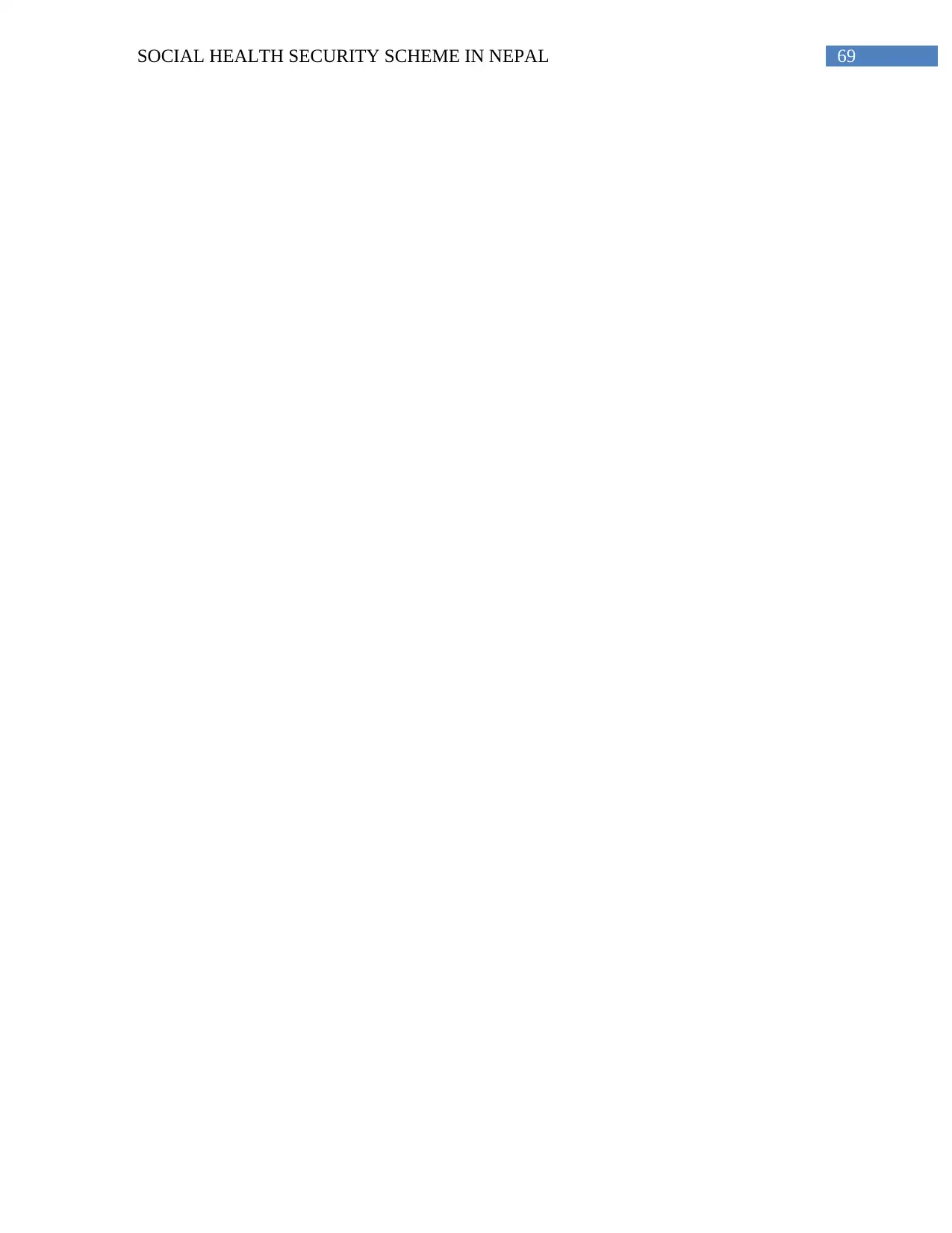
69SOCIAL HEALTH SECURITY SCHEME IN NEPAL
1 out of 70
Related Documents
Your All-in-One AI-Powered Toolkit for Academic Success.
+13062052269
info@desklib.com
Available 24*7 on WhatsApp / Email
![[object Object]](/_next/static/media/star-bottom.7253800d.svg)
Unlock your academic potential
© 2024 | Zucol Services PVT LTD | All rights reserved.





